Early Los Angeles City Views (1925 +)
| Historical Photos of Early Los Angeles |
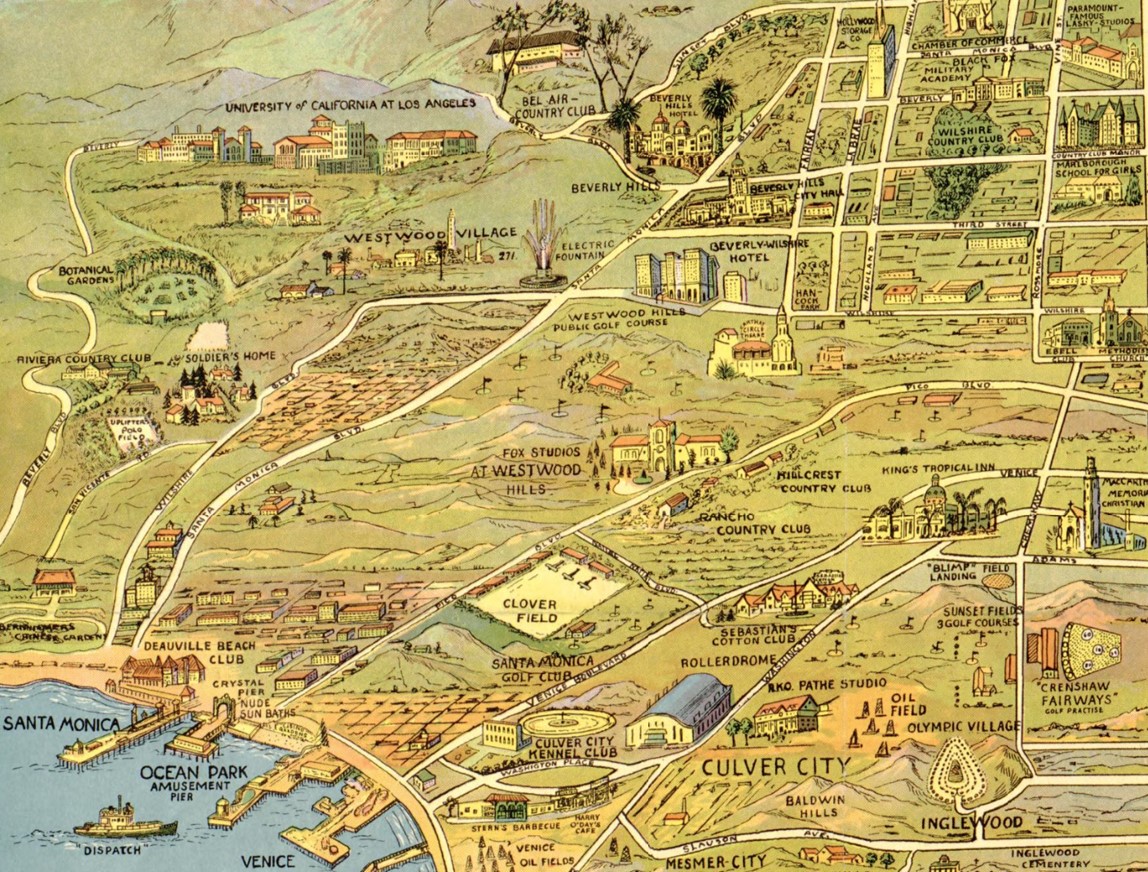 |
|
| (1932)* - Map Highlighting Key Points of Interest in Early Los Angeles' Westside, including Westwood, Beverly Hills, Santa Monica, Culver City, and Venice. Source: Library of Congress. |
Historical Notes In 1932, while affluent new residential developments like Westwood Village were emerging, the westside still had a mix of older modest neighborhoods, active oil drilling operations, and some remaining agricultural/rural pockets amid rapid urbanization and industrial growth. |
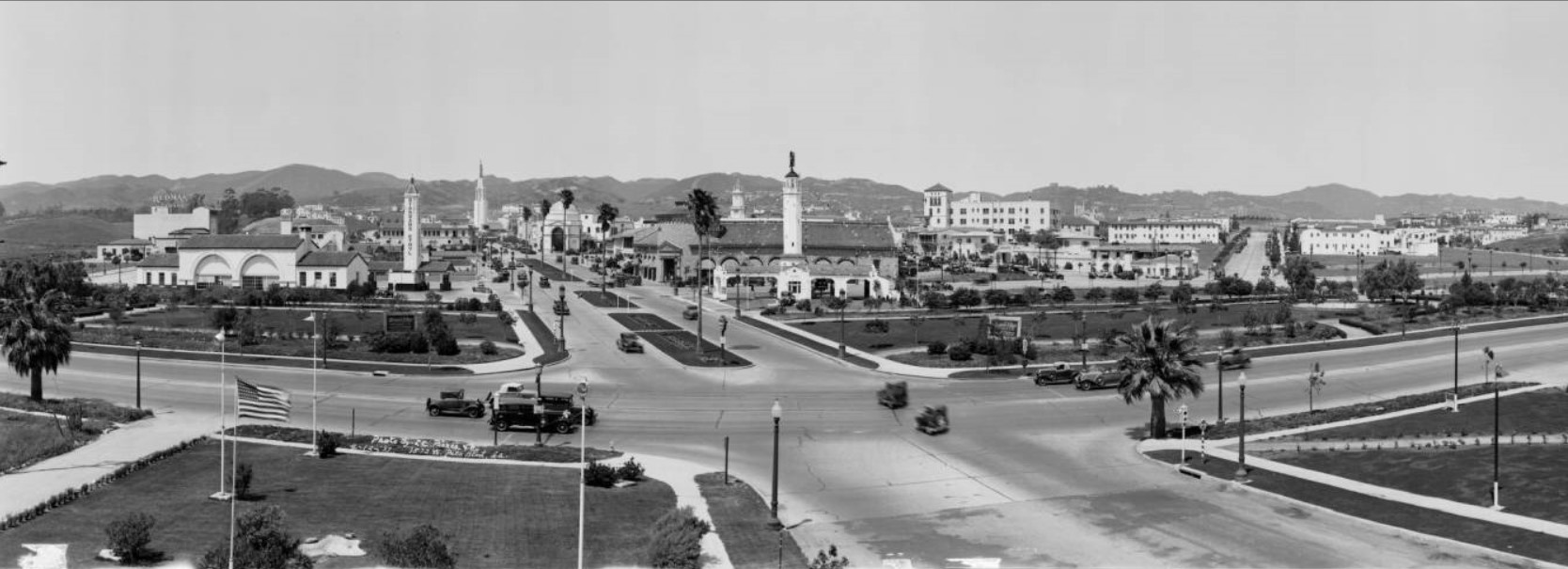 |
|
| (1932)* - Panoramic view of Westwood facing north at the intersection of Wilshire and Westwood. Wilshire runs the width of the image, in the foreground. Westwood, with palm trees planted in the dividers, goes into the distance, past a variety of stores, including a Ralphs, gas stations, and Janss Dome. |
Historical Notes 1932 marked the initial establishment of Westwood Village as a planned community centered on Westwood Boulevard, with the Janss Investment Corp. building as an early iconic landmark amidst the ongoing construction and development surrounding UCLA's new campus. |
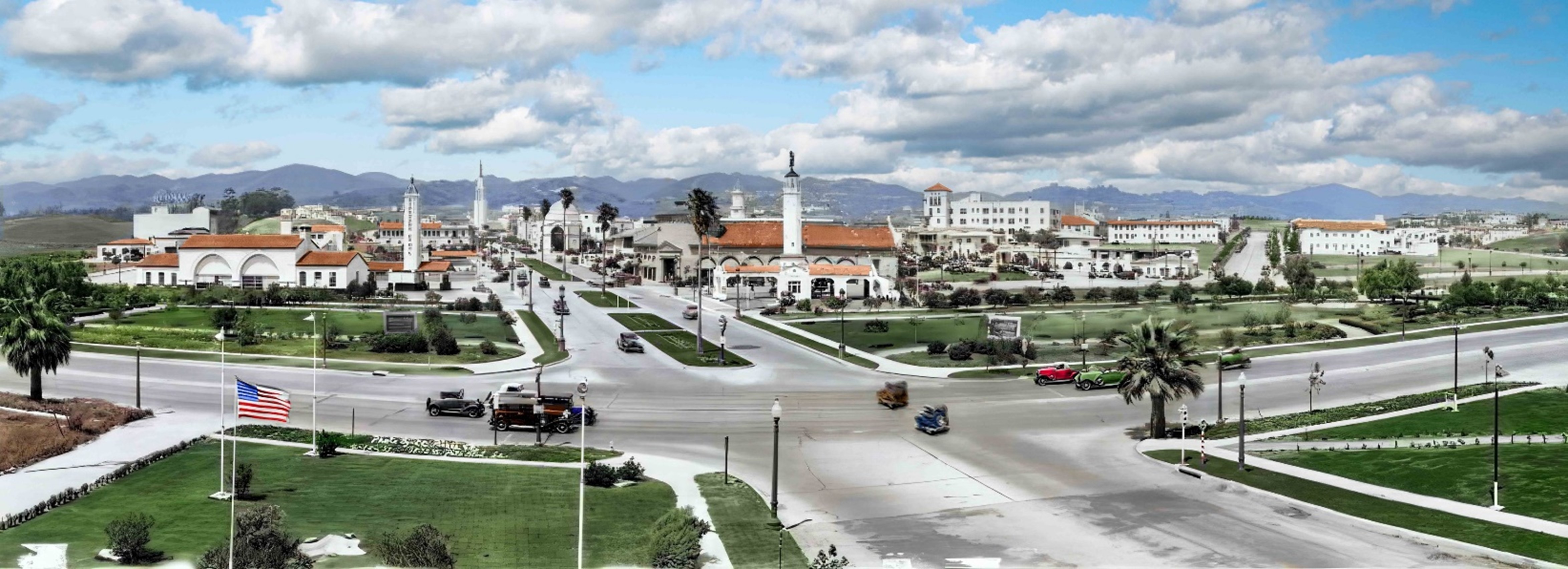 |
|
| (1932)* - Panoramic view of Westwood facing north at the intersection of Wilshire and Westwood. Wilshire runs the width of the image, in the foreground. Westwood, with palm trees planted in the dividers, goes into the distance, past a variety of stores, including a Ralphs, gas stations, and Janss Dome. Image enhancement and colorization by Richard Holoff. |
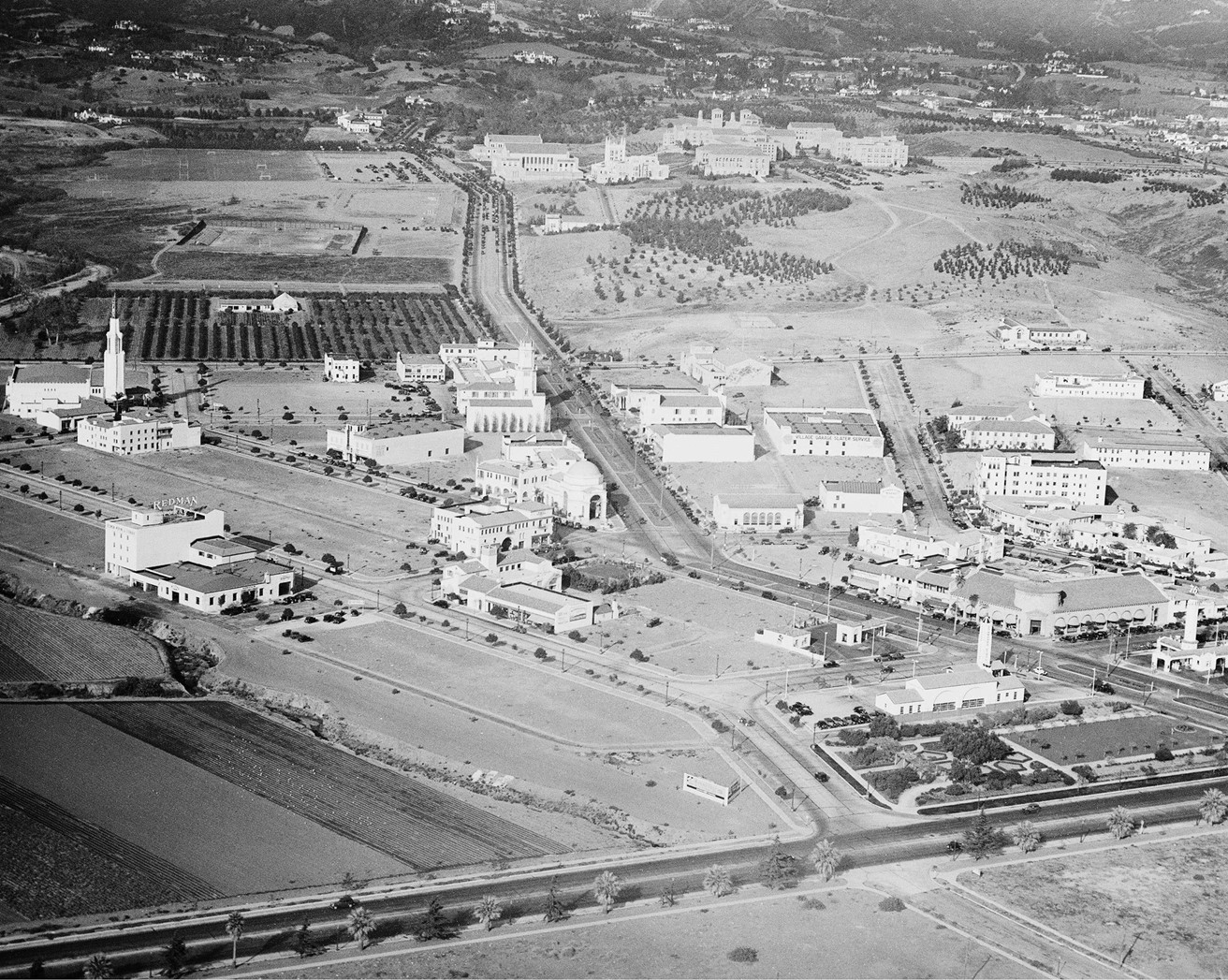 |
|
| (ca. 1933)* - Aerial view of Westwood and the UCLA campus. |
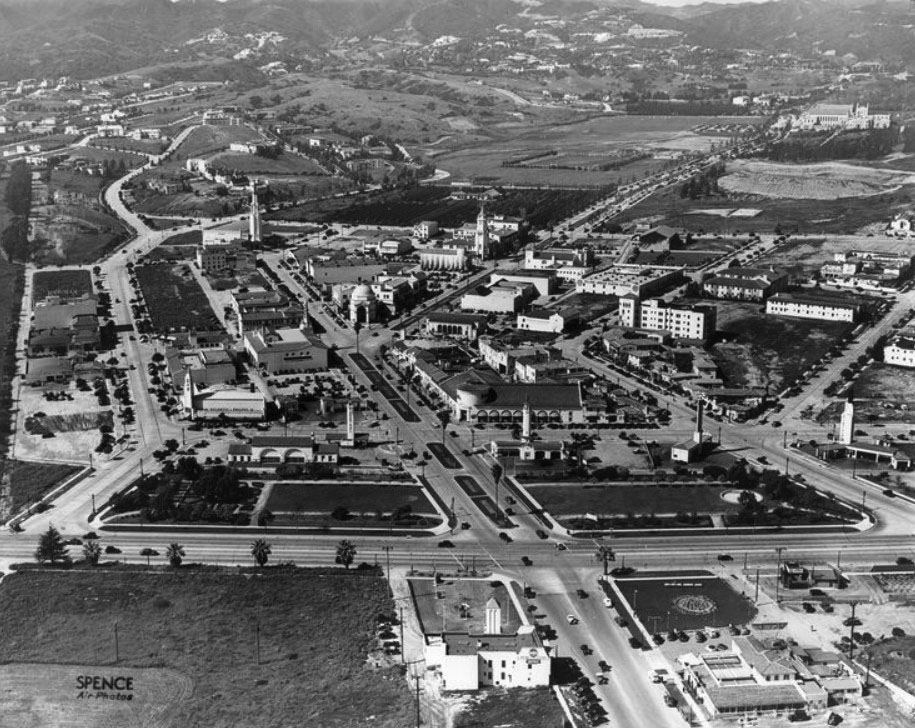 |
|
| (ca. 1936)* – Aerial view looking north showing Westwood Village with the intersection of Westwood and Wilshire boulevards seen in the foreground. |
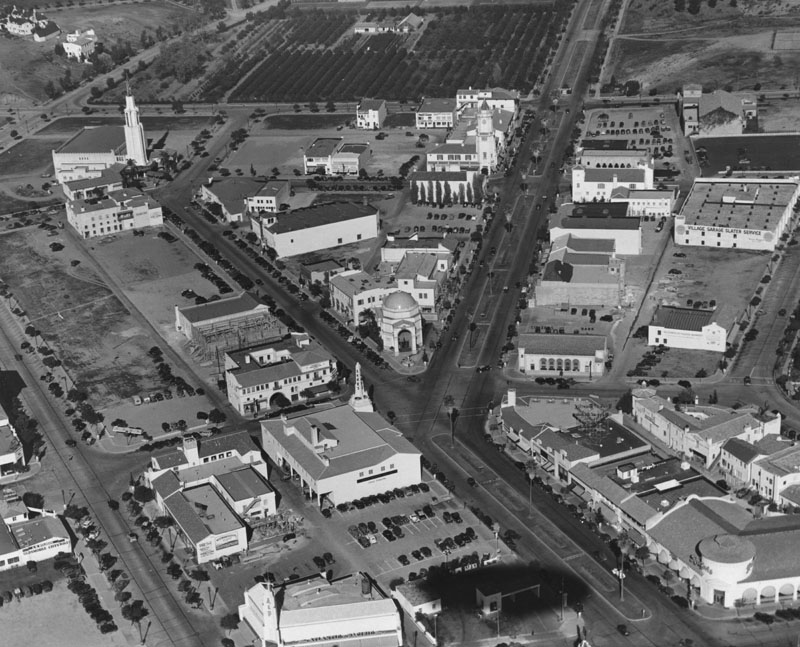 |
|
| (1936)* - Aerial view of Westwood Village from a blimp (note the shadow in the foreground). The Fox Theater is on the upper left, Ralphs lower right. At upper center is the Holmby Building with its clock tower. At center of photo, where Westwood Boulevard intersects Broxton Avenue, sits the Janss Dome Building, built in 1929. |
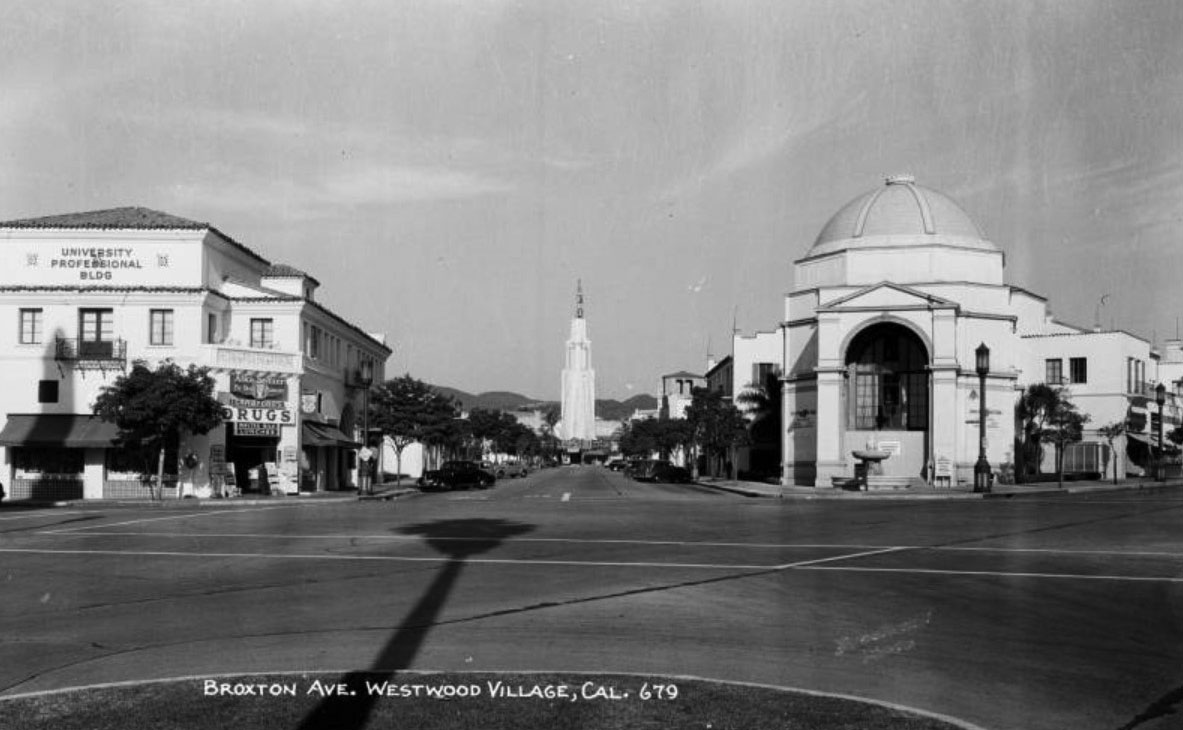 |
|
| (1930s)* – Postcard street view looking northwest showing the buildings at the intersection of Westwood Boulevard, Kinross Avenue, and Broxton Avenue in Westwood Village. At right is the Janss Dome building; at center in distance is the Fox Theater spire and marquee, and the University Professional Building with Crawford's Drug store. Signs on the drug store read "malted milk lunches" and "Alka-Seltzer - be wise alkalize." |
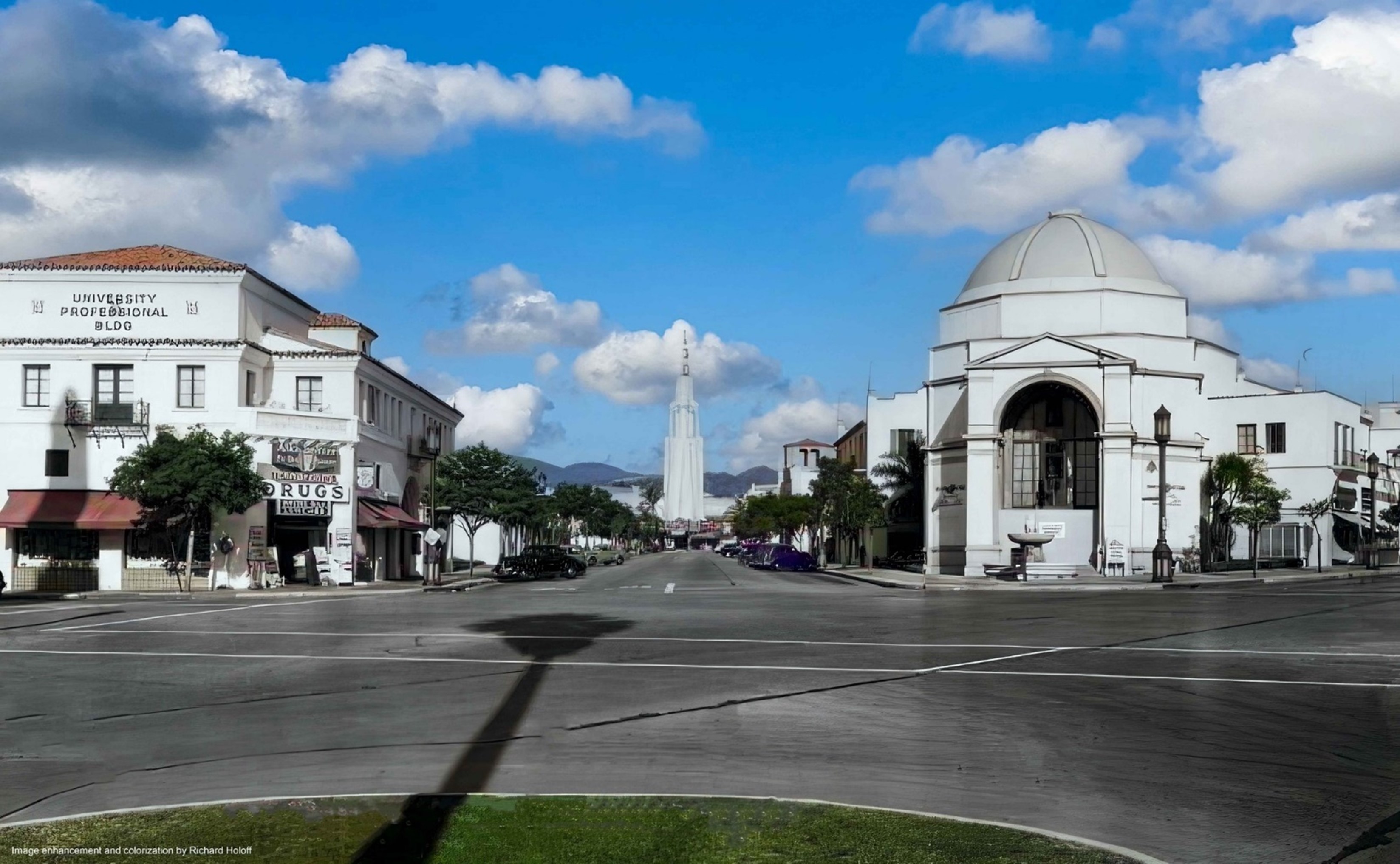 |
|
| (1930s)* – Postcard street view looking northwest showing the buildings at the intersection of Westwood Boulevard, Kinross Avenue, and Broxton Avenue in Westwood Village. At right is the Janss Dome building; at center in distance is the Fox Theater spire and marquee, and the University Professional Building with Crawford's Drug store. Signs on the drug store read "malted milk lunches" and "Alka-Seltzer - be wise alkalize." Image enhancement and colorization by Richard Holoff. |
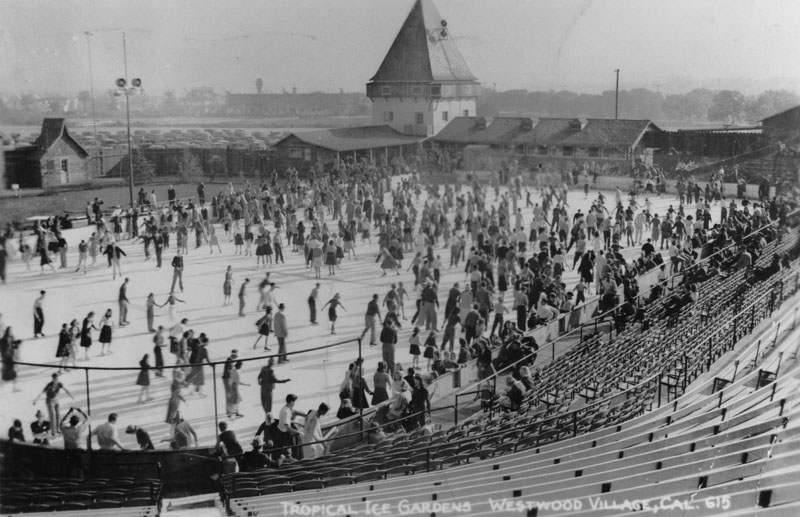 |
|
| (1939)^ - Postcard photo of Tropical Ice Gardens, an outdoor ice skating rink in Westwood, where on April 9, 1939 Harry Burnett skated. He was a Yale Puppeteer with Turnabout Theatre in Los Angeles. |
Historical Notes The Tropical Ice Gardens in Westwood Village opened in November 1938. It had a seating capacity for 10,000 spectators and could accommodate 2,000 ice skaters on its year-round outdoor rink. There were conflicting reports that Norwegian ice champion Sonja Henie had acquired the arena sometime in the 1940s and renamed it Sonja Henie's Ice Palace, but her actual affiliation with the establishment remains uncertain. The building sustained considerable damage due to a fire in May 1939, but re-opened shortly after. It was torn down in 1949 to accommodate expansion of UCLA. |
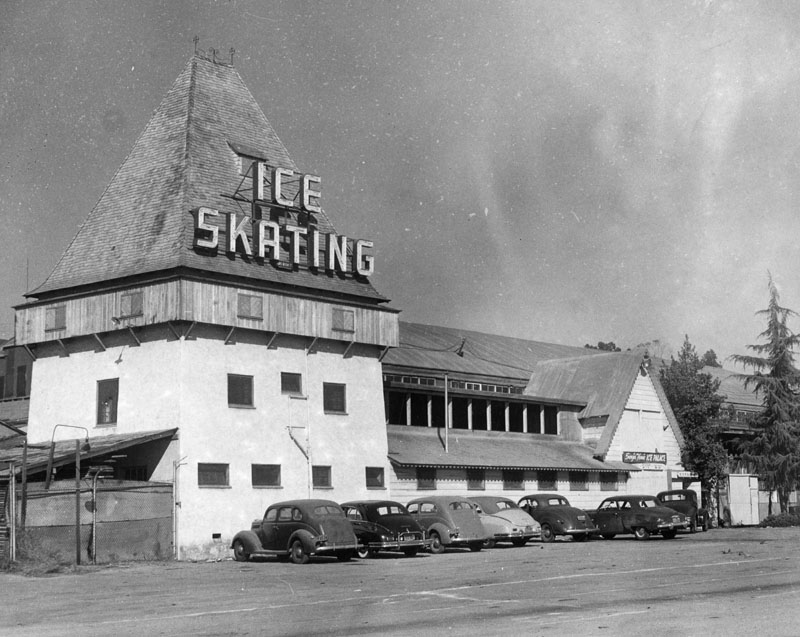 |
|
| (1949)^ - Exterior view of the Tropical Ice Gardens in Westwood Village. |
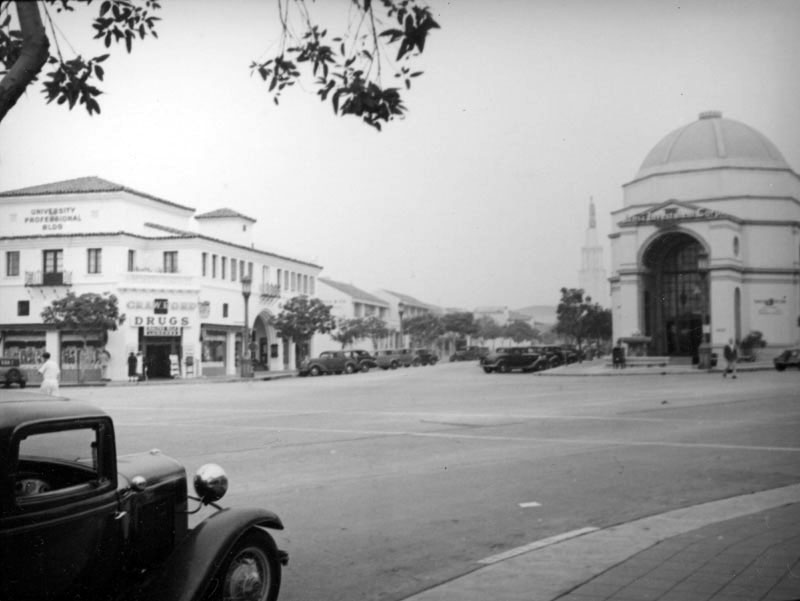 |
|
| (ca. 1940)^ - View of Westwood Boulevard, Westwood Village, showing Crawford Drugs and the Janss Investment Company--the developers of Westwood. |
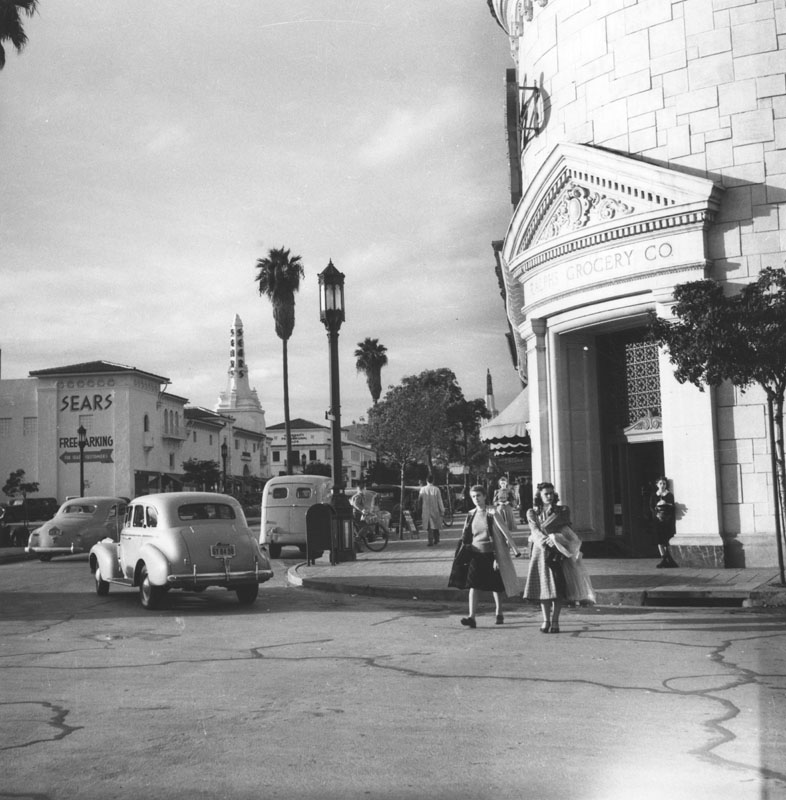 |
|
| (ca. 1940)^ - Two women are seen walking down Lindbrook Drive (foreground) where it meets Westwood Boulevard (left) right outside of a Ralph's supermarket in Westwood Village. Designed by architect Russell Collins and built in 1929, the market is identified by the words "Ralphs Grocery Co.," seen over the doorway. Various businesses, including Sears, are visible in the background, |
Historical Notes Click HERE to see more Early Views of Westwood and UCLA |
* * * * * |
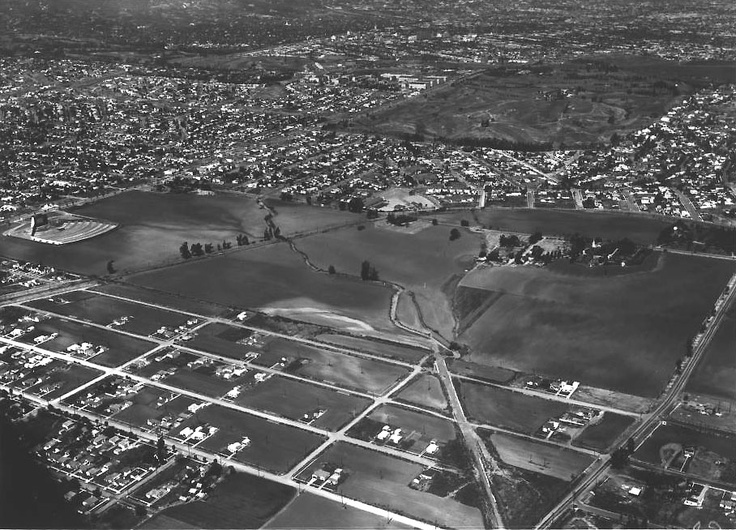 |
|
| (1941)****- An aerial view of Westwood and Rancho Park, taken on May 11, 1941. The Pico Drive-In is located at the left center of the picture. |
* * * * * |
Beverly Hills
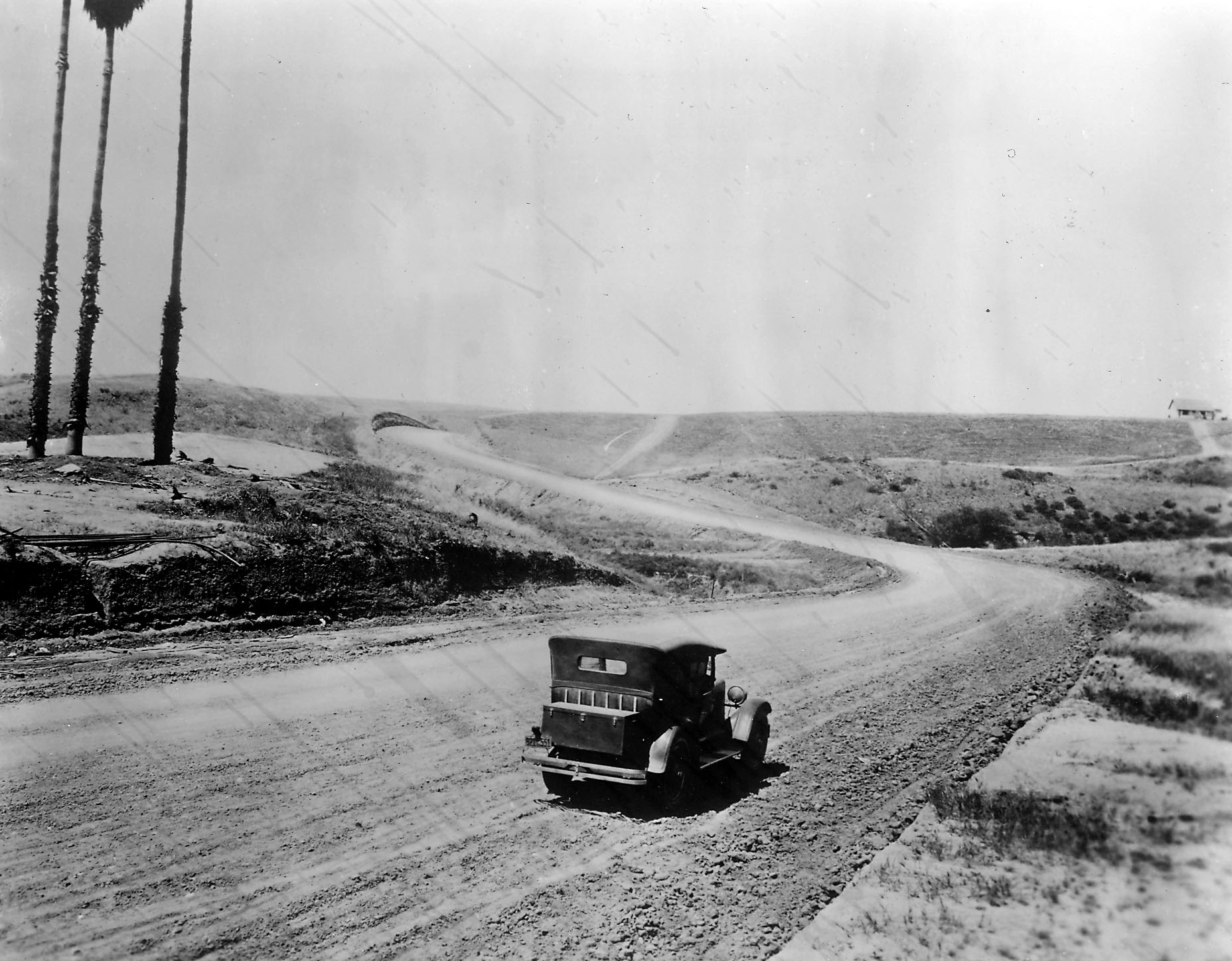 |
|
| (ca. 1925)* - View of Sunset Blvd. and Crescent Drive in Beverly Hills. Early model car is seen on an unpaved Sunset. |
Historical Notes Sunset Boulevard stretches from Figueroa Street in Downtown Los Angeles to the Pacific Coast Highway at the Pacific Ocean in the Pacific Palisades. Approximately 22 miles in length, the famous boulevard roughly mimics the arc of the mountains that form the northern boundary of the Los Angeles Basin, following the path of a 1780s cattle trail from the Pueblo de Los Angeles to the ocean. The portion of Sunset Boulevard that passes through Beverly Hills was once named Beverly Boulevard. |
.jpg) |
|
| (1925)* - A view of Beverly Hills Heights, a development by Frank Meline, shown at the start of the subdivision. A man stands near a parked automobile on a wide, unpaved S. Beverly Drive near what is today Olympic Boulevard. |
Historical Notes At the time of this photo 10th Street (now Olympic Boulevard) had not yet been cut through to the west. It was originally named 10th Street, but was renamed Olympic Boulevard for the 1932 Summer Olympics, as that was the occasion of the tenth modern event. |
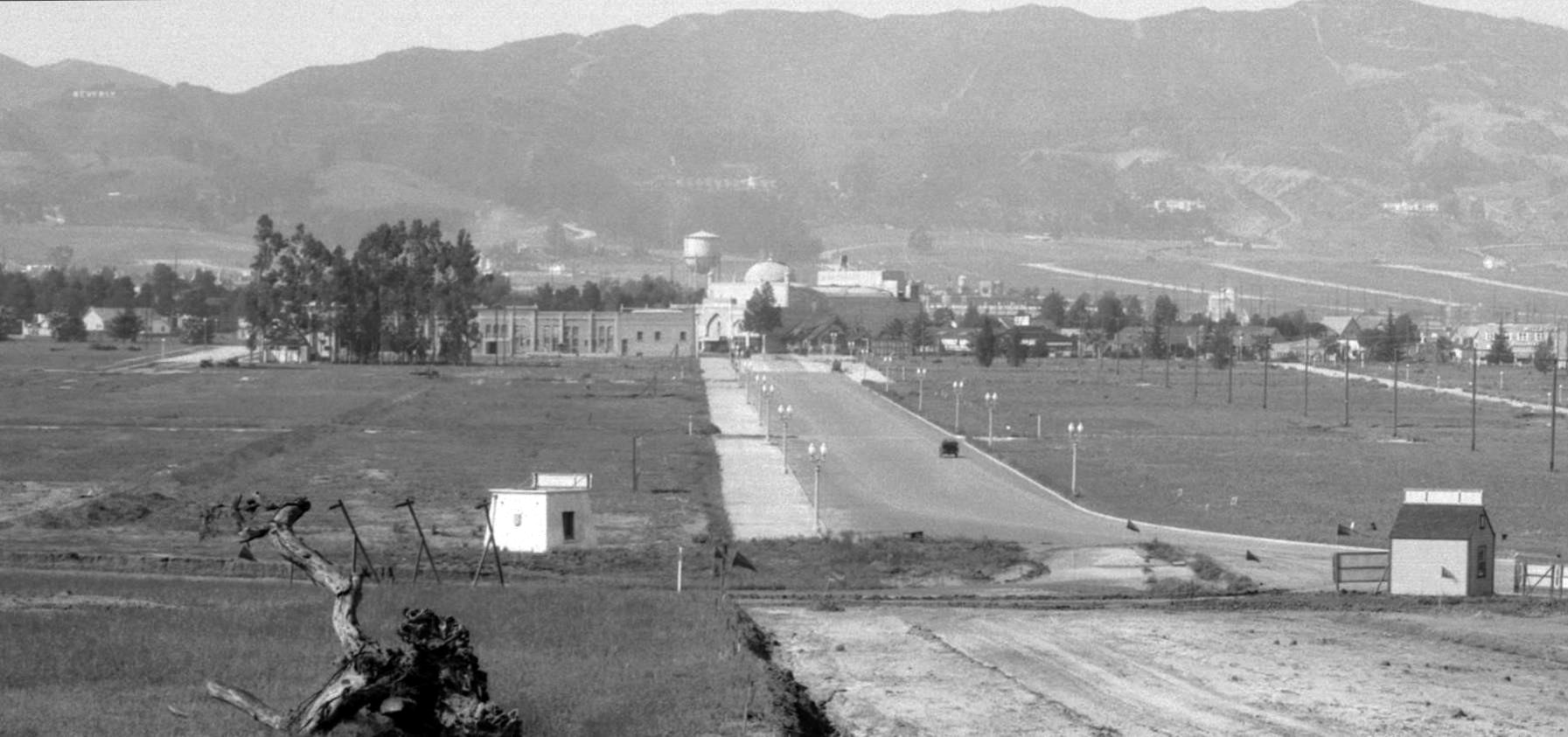 |
|
| (1925)*– Panoramic view of a completely undeveloped South Beverly Drive looking north to the Beverly Theater at Wilshire Boulevard. |
Historical Notes There are still giant eucalyptus trees that once lined the boundaries of the Beverly Hills Speedway to the north behind the Walter McCarty retail development. Those trees would soon be cut down to make way for Charleville Blvd. To the left you can see El Camino Drive is beginning to make its way south and in the upper left hand corner of the photo you will find the "Beverly Crest" real estate sign on the mountain, very much like its sister sign, "Hollywoodland" only a handful of miles away. The area from where the photo was taken was known as Beverly Heights. |
 |
|
| (1926)* - Honorary Mayor Will Rogers demonstrates the city's brand new Elgin Street Sweeper in front of Beverly Hills’ original City Hall at the terminus of N Crescent Drive and Burton Way. |
Historical Notes William Penn Adair "Will" Rogers, in addition to being a cowboy, vaudeville performer, humorist, newspaper columnist, social commentator, and stage and motion picture actor, was the honorary Mayor of Beverly Hills (1926 – 1928). After the city was incorporated it was run by an appointed city manager. The "mayor's office" was merely a ceremonial one that enabled Will to make more jokes about do-nothing politicians such as himself. |
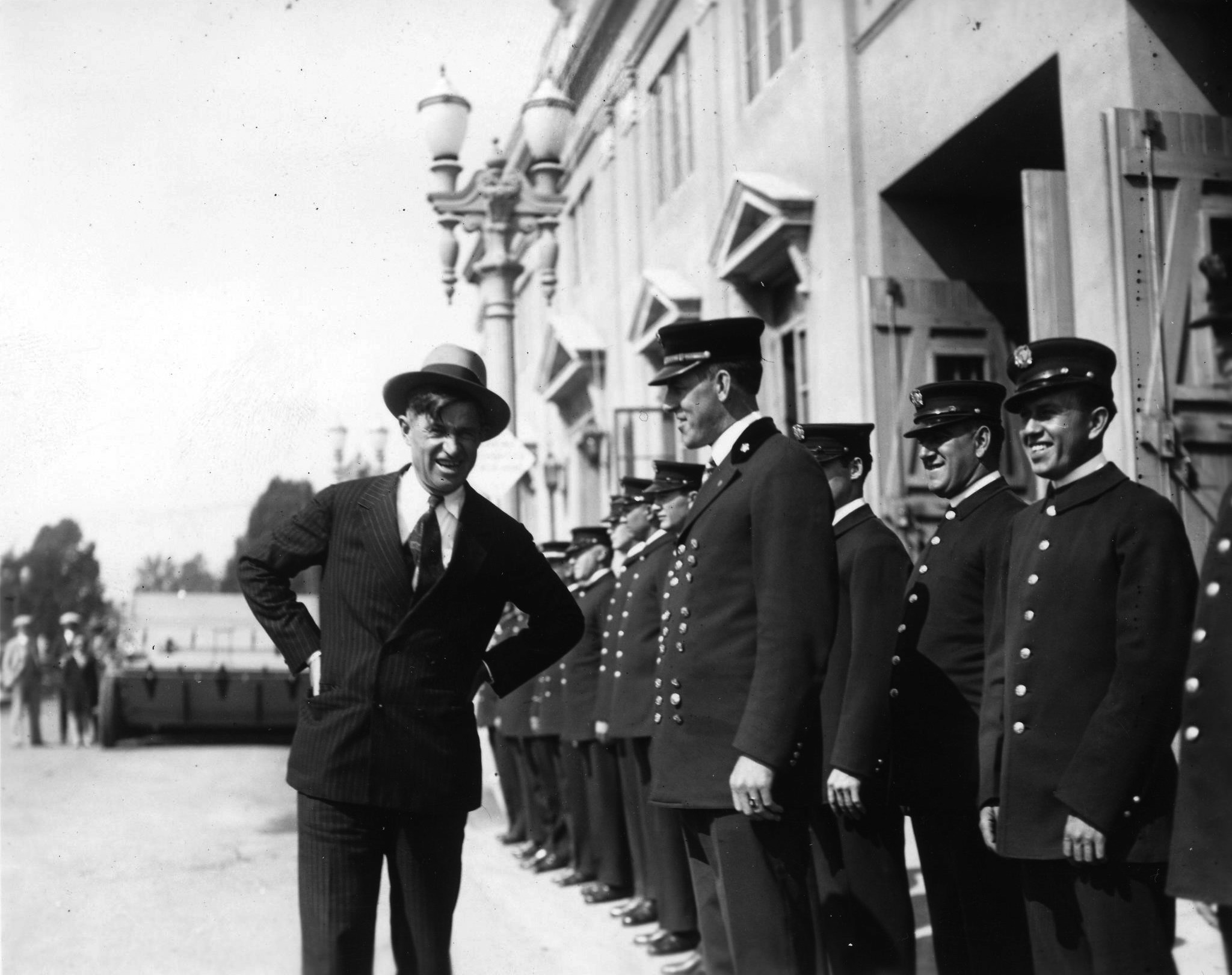 |
|
| (ca. 1928)* – View showing Honorary Mayor Will Rogers and the Beverly Hills Fire Department standing outside the city's first City Hall and fire station. |
Historical Notes The first City Hall building faced south at the end of Crescent Drive, right before Santa Monica Boulevard. It was demolished when the new City Hall was erected in 1932 and its demise made way for South Santa Monica Boulevard to the east and west and Crescent Drive to go all the way through to the South. |
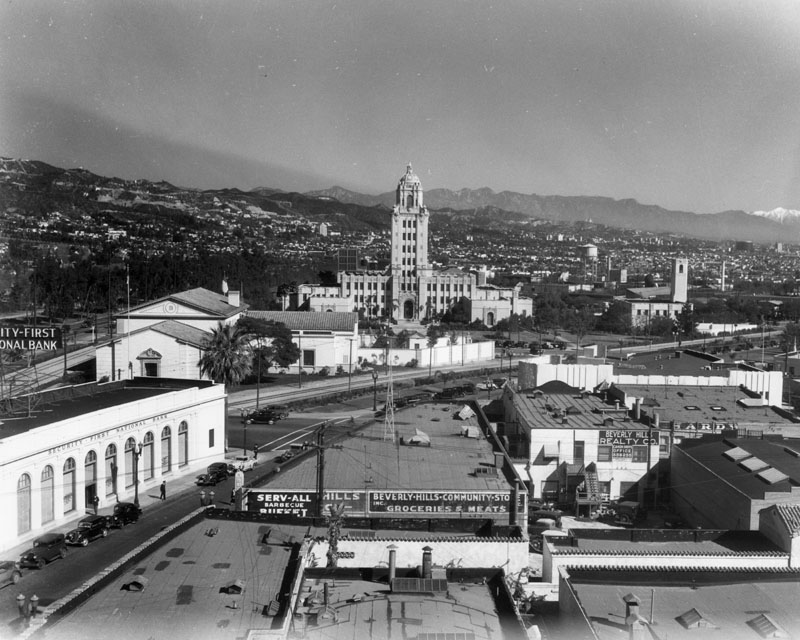 |
|
| (ca. 1935)^ - Looking northeast from the Beverly Hills business district showing Beverly Hills City Hall (built in 1932) and the Beverly Hills Civic Center. The Pacific Electric streetcar tracks of the Beverly Hills line that run down Santa Monica Boulevard are seen in the center. Between the tracks and City Hall is the Beverly Hills Post Office. In the far distance (upper-right) you can make out the snow-capped San Gabriel Mountains. |
Historical Notes In 1930, land was purchased from the Pacific Electric to build the new city hall. Construction lasted from 1931 to 1932. The building was designed by architects William J. Gage and Harry G. Koerner in the Spanish Revival architectural style (though sometimes also characterized Churrigueresque). When the city hall opened in 1932, it was called by The Los Angeles Times the "largest and most expensive City Hall of any municipality its size in the country." |
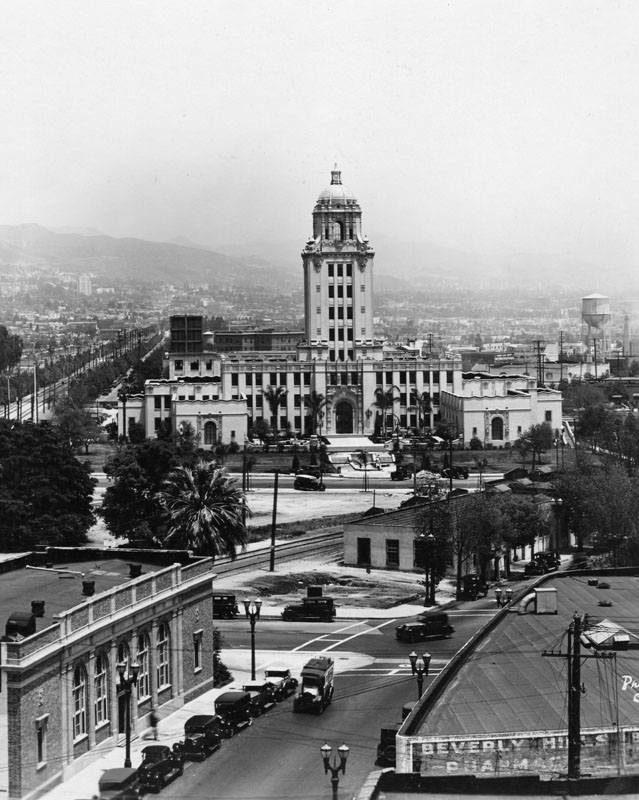 |
|
| (1933)^ - Panoramic view of Beverly Hills City Hall and surrounding area, looking east. City Hall was built in 1932 on Crescent Drive at Santa Monica Blvd. |
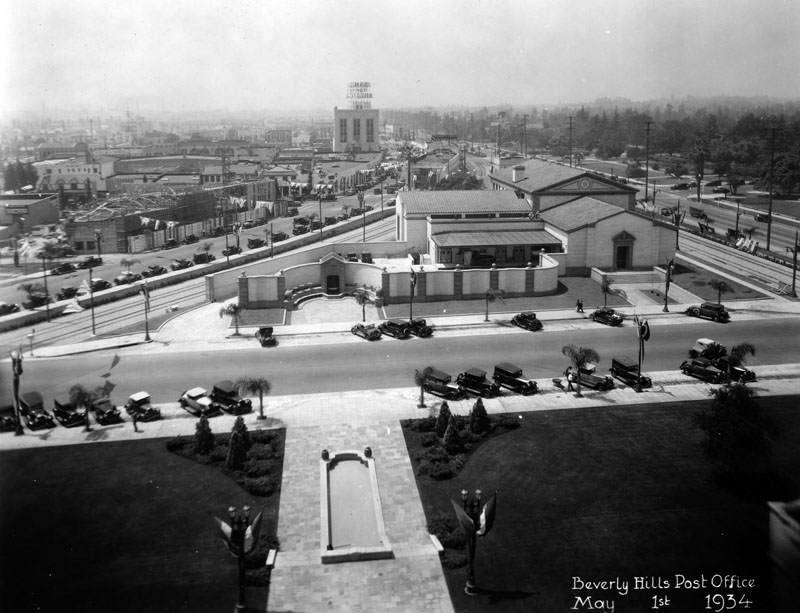 |
|
| (1934)^ - View looking west showing the Beverly Hills Post Office located at 325 N. Maple Drive between Canon Drive and Santa Monica Boulevard as seen from the front of City Hall. This was the location of Beverly Hills' 1st Train Station. |
Historical Notes Architects Ralph C. Flewellin and Allison and Allison built the Beverly Hills Post Office in 1932-1933 in the Italian Renaissance Revival style, with building in terra cotta and brick. |
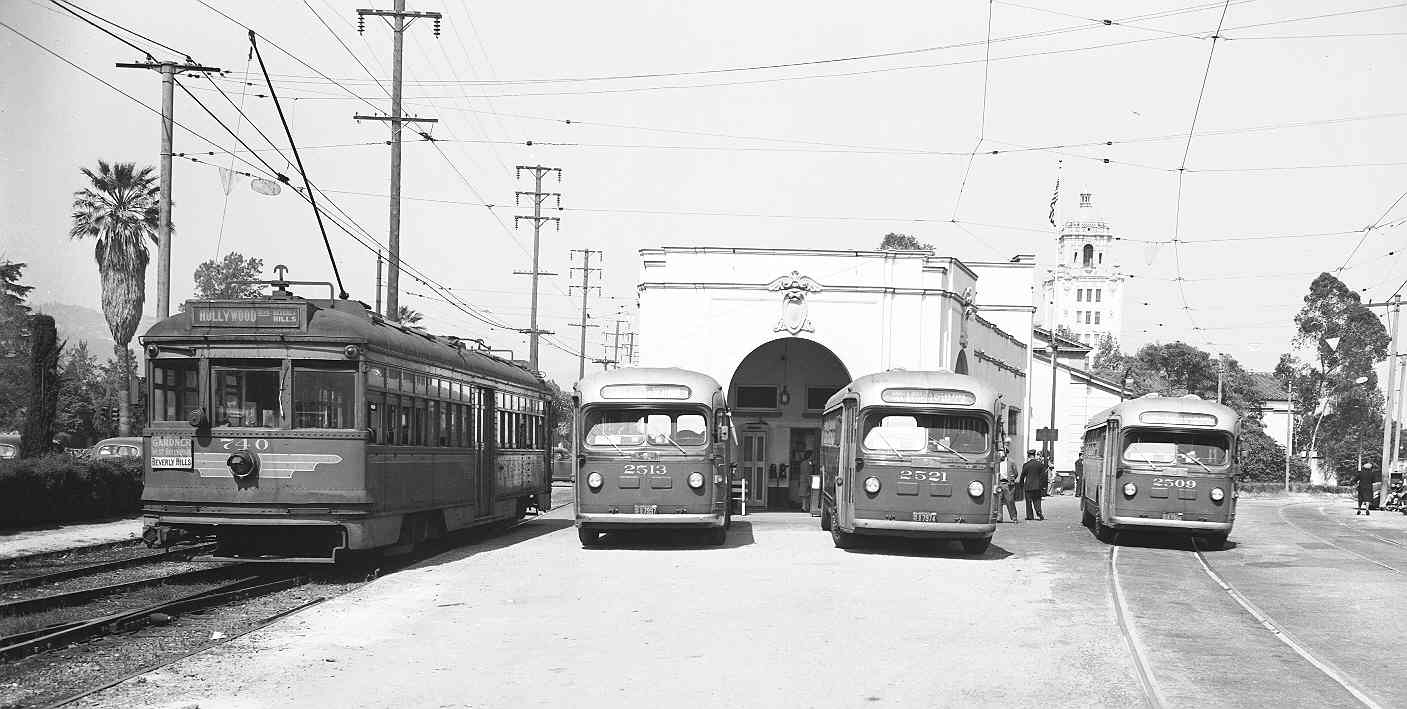 |
|
| (ca. 1943)#^ - View of the Beverly Hills Pacific Electric Station looking east showing a streetcar and three buses all lined up. City Hall can be seen in the background. |
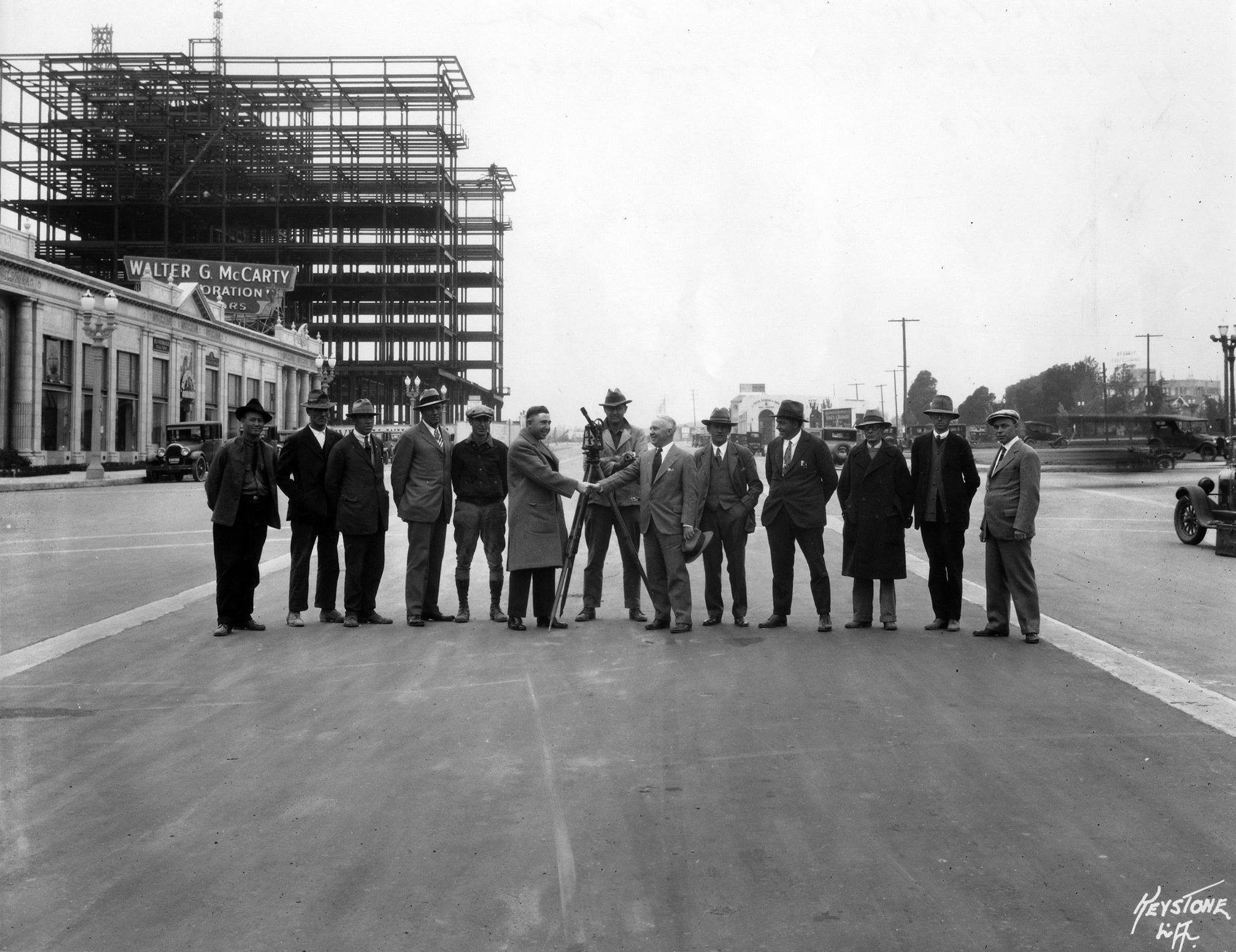 |
|
| (ca. 1927)* – View looking west on Wilshire Boulevard showing a group of men, including Walter G. McCarty, surveying the street and posing for the camera. The Beverly Wilshire Hotel is under construction as part of McCarty's developing landscape that once included the Beverly Hills Speedway tract of land. In the distance, the white building with the arched front doorway would soon become the Brown Derby Restaurant. |
Historical Notes The Beverly Wilshire Hotel was constructed by real estate developer Walter G. McCarty on the site of the former Beverly Hills Speedway. It was completed in 1928 (when the city had fewer than 18,000 residents), and was then known as the "Beverly Wilshire Apartment Hotel". |
 |
|
| (1938)* - Aerial view looking southeast over the intersection of Wilshire Boulevard and Rodeo Drive showing the historic Beverly Wilshire Hotel. Note all the empty land south of the hotel. Photo: Marc Wanamaker/Bison Archives |
Historical Notes Originally named the "Beverly Wilshire Apartment Hotel” when opened (1928), it was renamed the Beverly Wilshire Hotel by its new owners in the 1940s when it was renovated with a ballroom to accommodate the popular big bands of the day. An Olympic-sized swimming pool was built and championship tennis courts were added, with tennis champion Pancho Gonzalez as tennis director. The hotel changed hands in 1958 and again in 1961, when it was purchased by a group of investors headed by Hernando Courtright. The singer Elvis Presley and later the actor Warren Beatty lived several years in the hotel. It was also the home of John Lennon, when he was separated for several months from his wife Yoko Ono. The American socialite and Woolworth department store heiress Barbara Hutton spent her last years in near poverty and poor health in the hotel and died there in May 1979. Acquired by Regent International Hotels in 1985, the 395-room luxury hotel has been managed by the Four Seasons Hotel since 1992. |
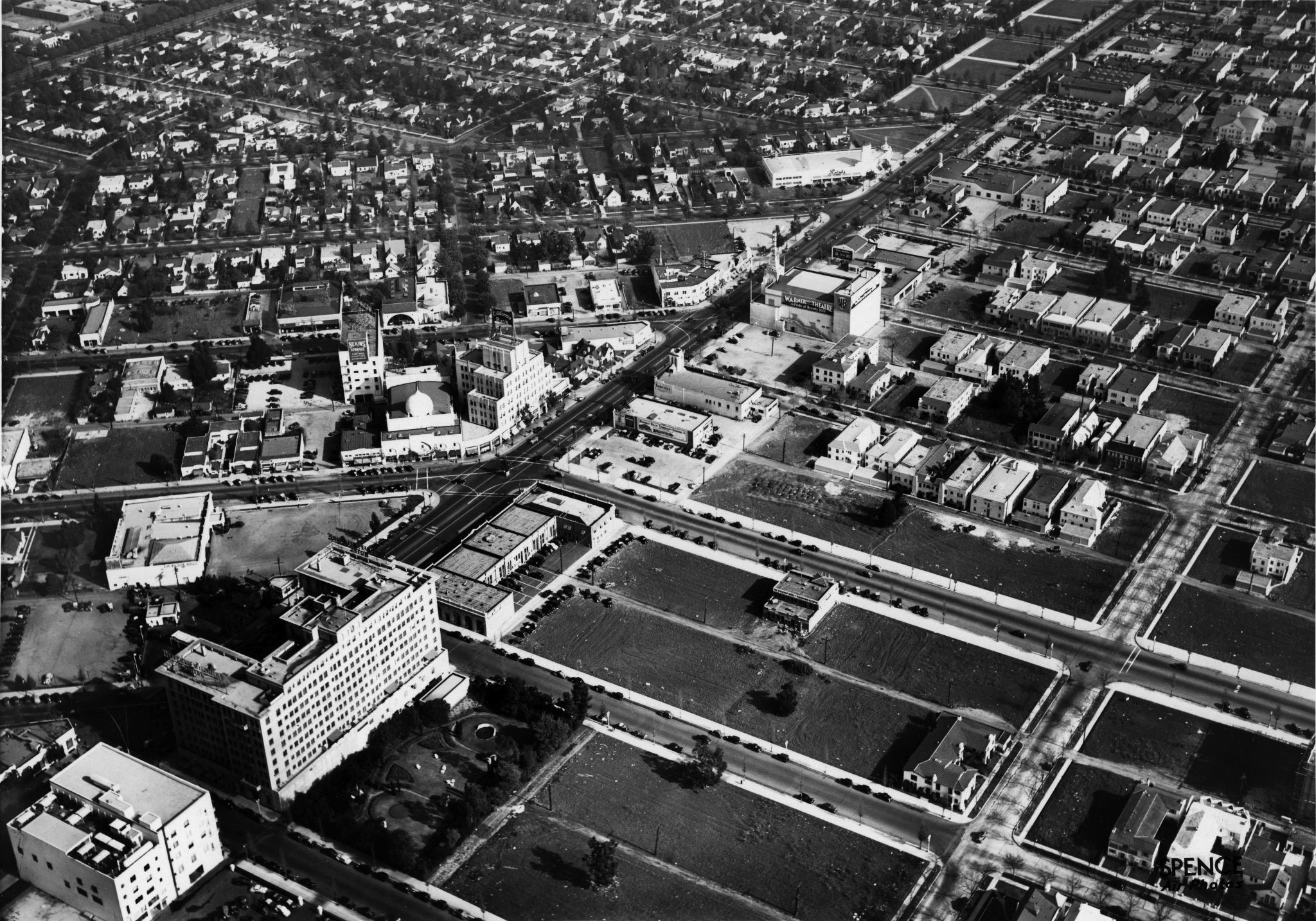 |
|
| (1937)* – Aerial view of Beverly Hills looking northeast. The intersection of Wilshire Boulevard and Beverly Drive is at center-left where the Moorish-style Beverly Theater stands at the corner. The Beverly Wilshire Hotel is seen at lower-left. |
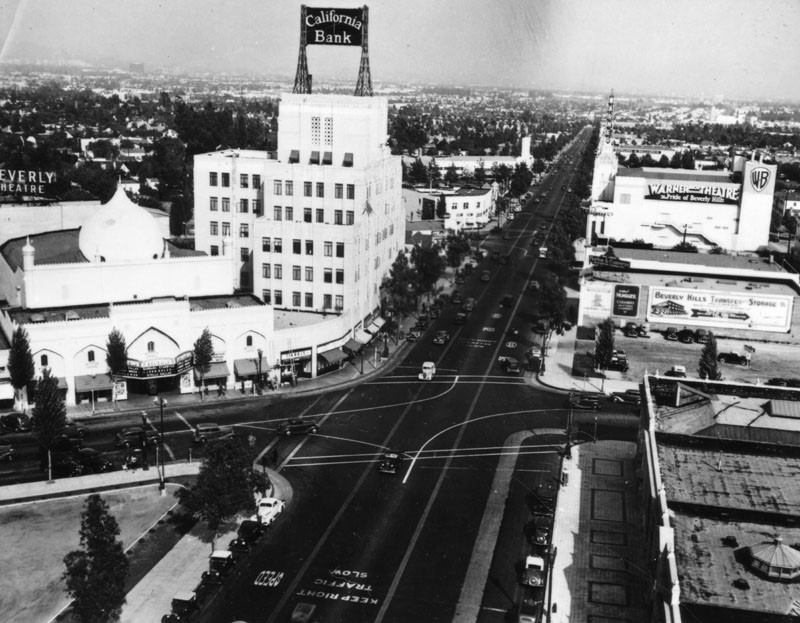 |
|
| (1930s)^ – View looking east on Wilshire Boulevard at Beverly Drive in Beverly Hills. Seen are, left to right, the Beverly Theater, the California Bank Building, and the Warner Theatre. |
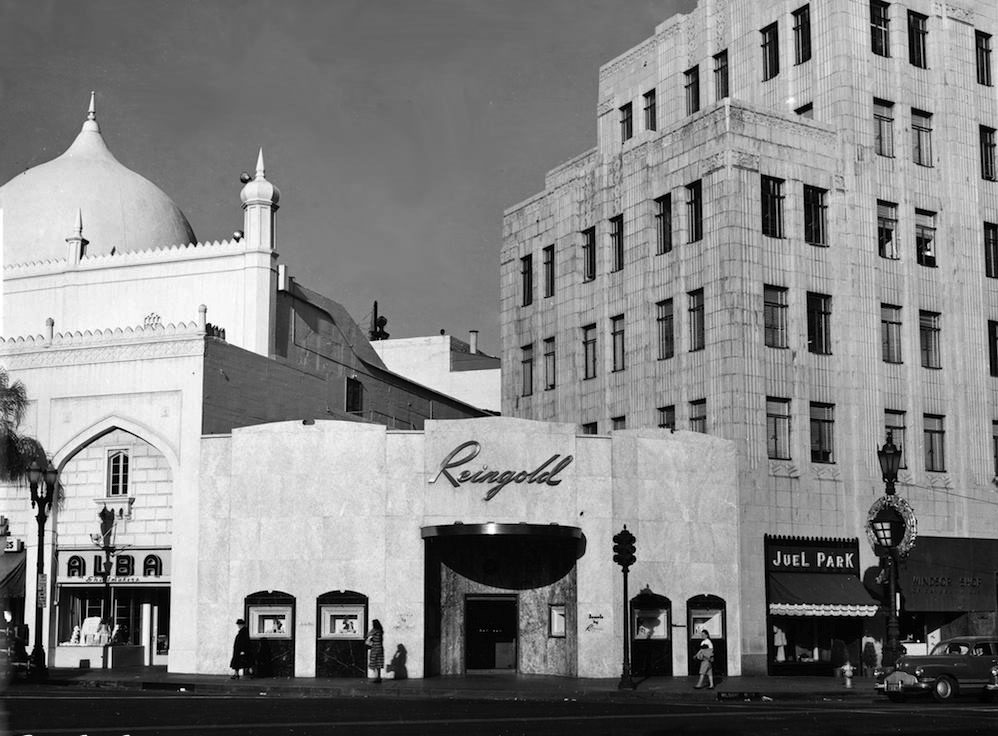 |
|
| (1951)* – Close-up view showing the northeast corner of Wilshire Boulevard and N. Beverly Drive showing three buildings with uniquely distinctive architectural styles: the Mughal Revival Beverly Theatre, the Mesoamerican Revival California Bank Building, and the Hollywood Regency style structure connecting them that became Reingold Jewelers. Photo: Marc Wanamaker |
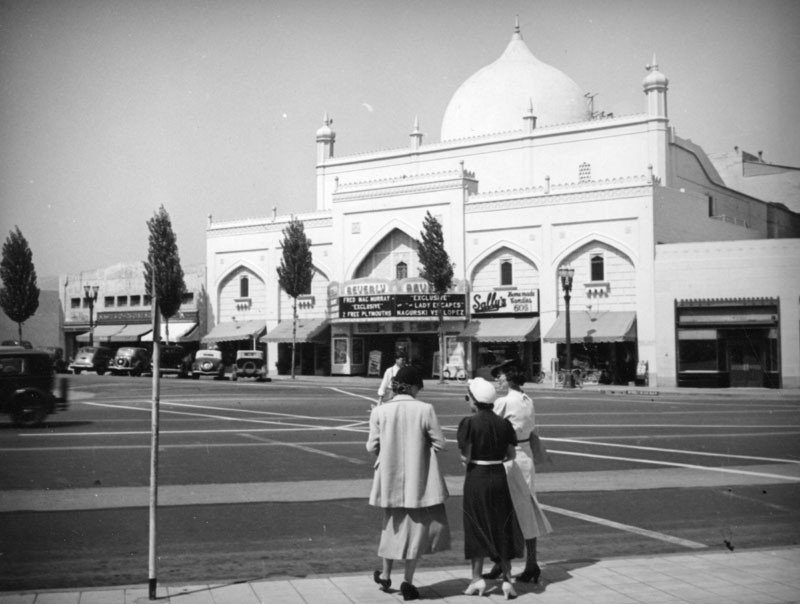 |
|
| (ca. 1940)^ - Three women stand on a street corner opposite the Beverly Theater in Beverly Hills. The marquee includes "Fred MacMurray Exclusive." |
Historical Notes Designed by L.A. Smith, this was the first vaudeville and movie theater to be built in Beverly Hills. |
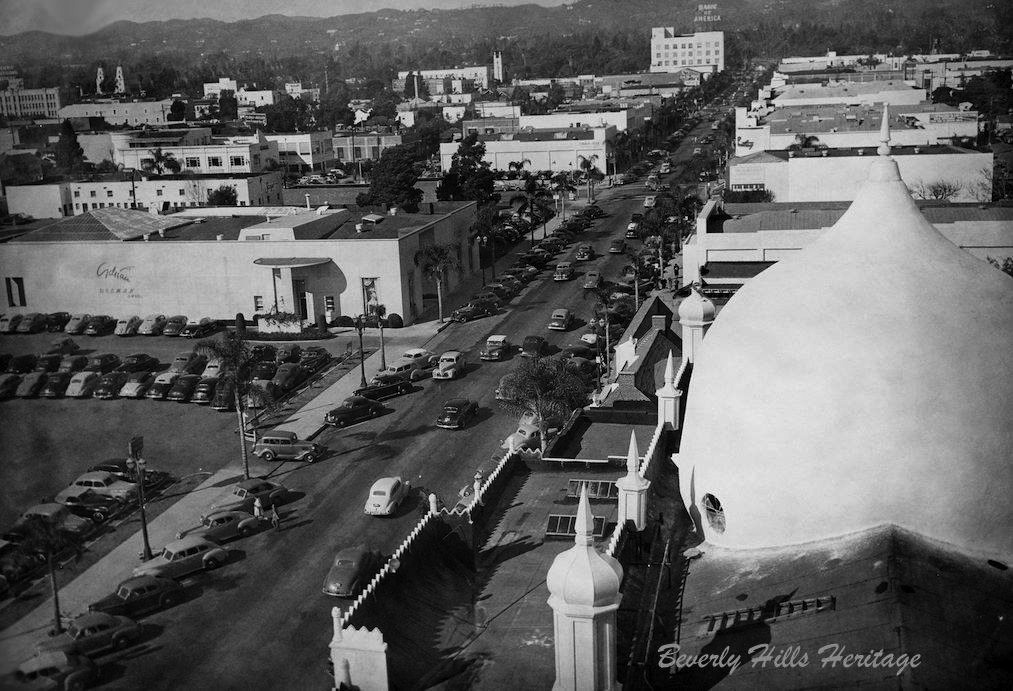 |
|
| (1945)* - A bird's-eye view from the California Bank Building (Sterling Plaza) of north Beverly Drive with the Beverly Theater directly below. |
Historical Notes The first building on the west side of the road (left) began as the Victor Hugo Restaurant. It was next occupied by the salon of Adrian (as pictured), the movie costumer and designer of couture gowns for the discerning (and very wealthy) woman. It later became a Lane Bryant store. The building was eventually razed. The parking lot is where the Chase Bank building (originally Bank of America) now stands. The Adrian lot is the site of an office building where MGM is headquartered. |
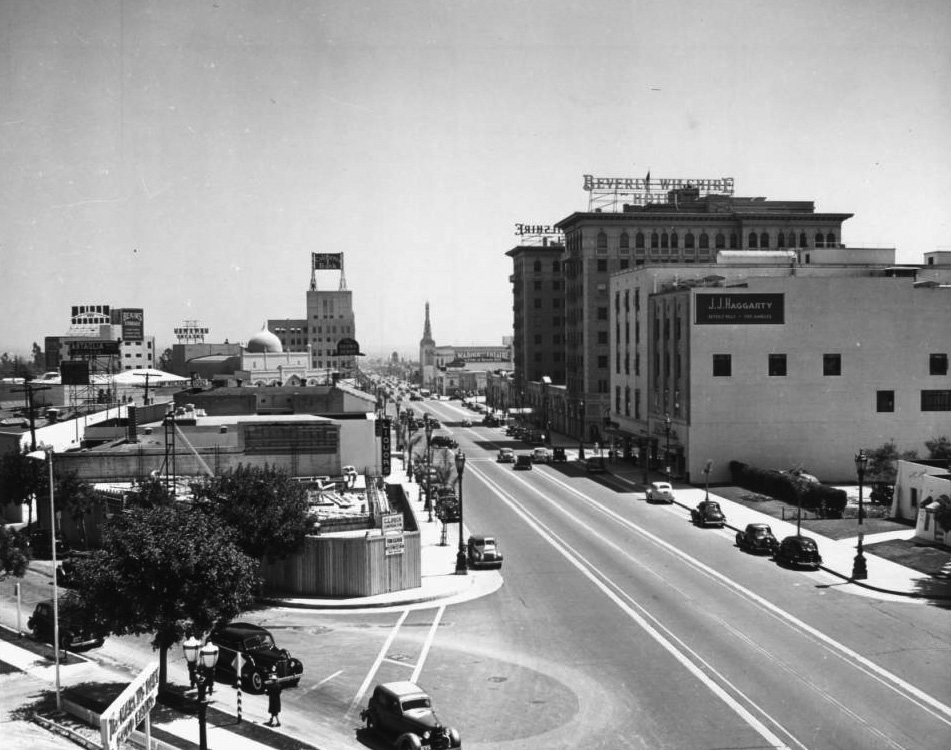 |
|
| (ca. 1936)^ – View looking east on Wilshire Boulevard and Dayton Drive. From right to left can be seen: J.J. Haggarty, Beverly Wilshire Hotel, California Bank, the dome of the Beverly Theater and the top hat sign of the famous Brown Derby Restaurant. |
Brown Derby (Beverly Hills)
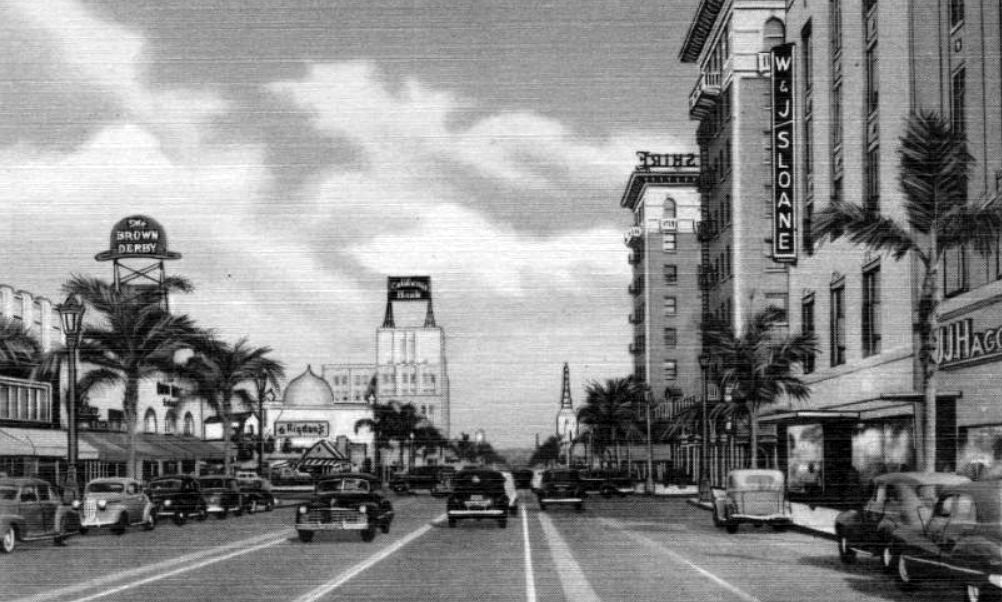 |
|
| (ca. 1940)##^* – Postcard view looking east on Wilshire Boulevard in Beverly Hills. The Brown Derby Restaurant is on the left (sign above the palm trees) with the Beverly Theater and California Bank in the distance. On the right can be seen the Beverly-Wilshire Hotel, W & J Sloane and J. J. Haggarty's Department Stores. |
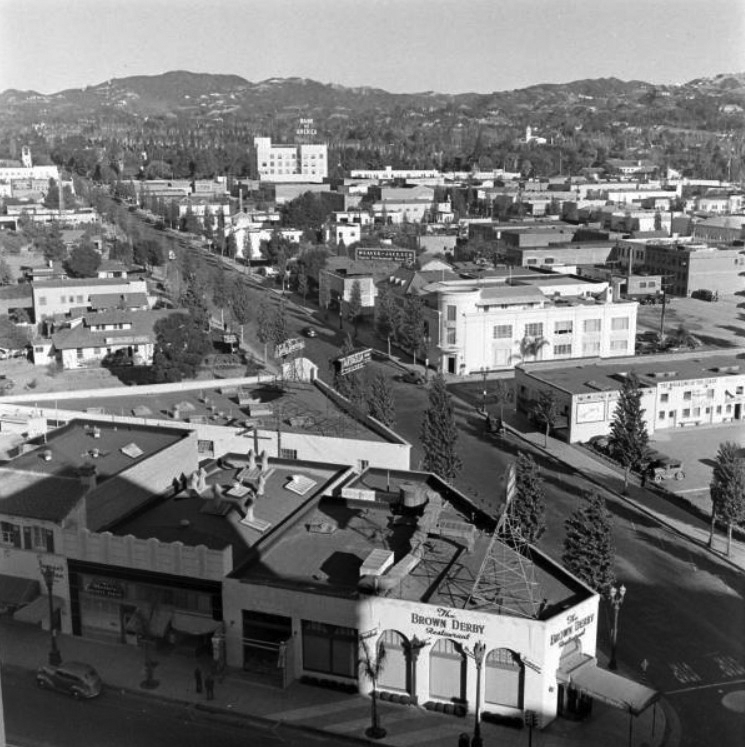 |
|
| (1940s)+# – View showing the Brown Derby Restaurant on the corner of Wilshire and Rodeo Drive as seen from the Beverly-Wilshire Hotel. Today, Louis Vuitton sits on this corner. |
Historical Notes The Original Brown Derby on Wilshire and the Hollywood Brown Derby on Vine Street got most of the attention but there were two others. This one opened in 1931 at 9537 Wilshire at the corner of Rodeo Drive in Beverly Hills. Apparently it was busiest on Thursday nights because that was the traditional maid’s night off. |
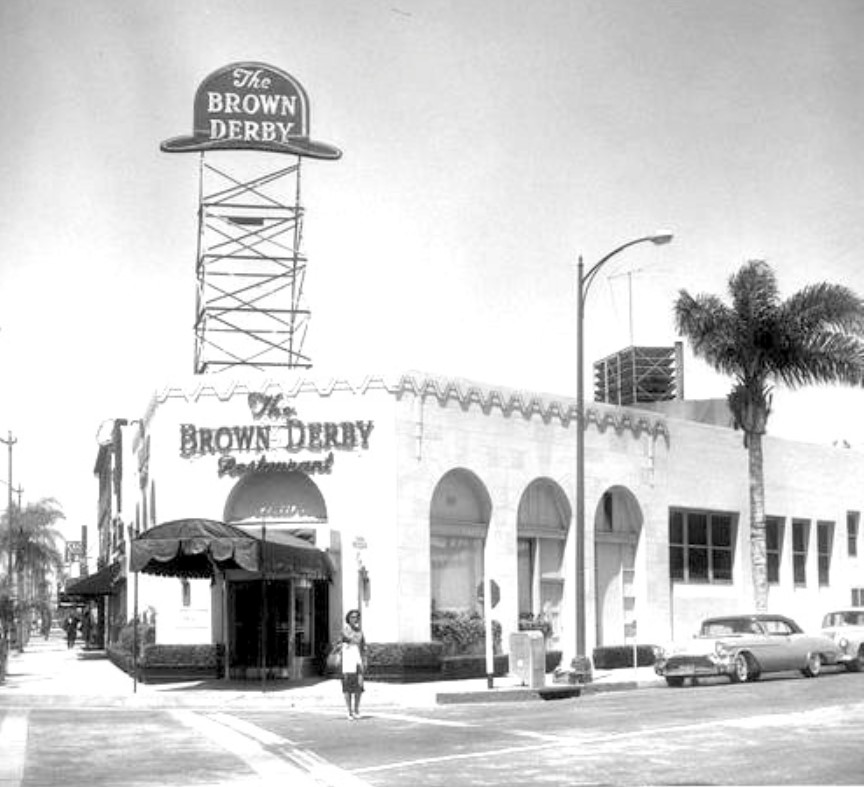 |
|
| (1950s)* – View showing a woman crossing the street on Rodeo Drive with the The Brown Derby Restaurant behind her. Wilshire Boulevard is out of view on the left. |
Then and Now
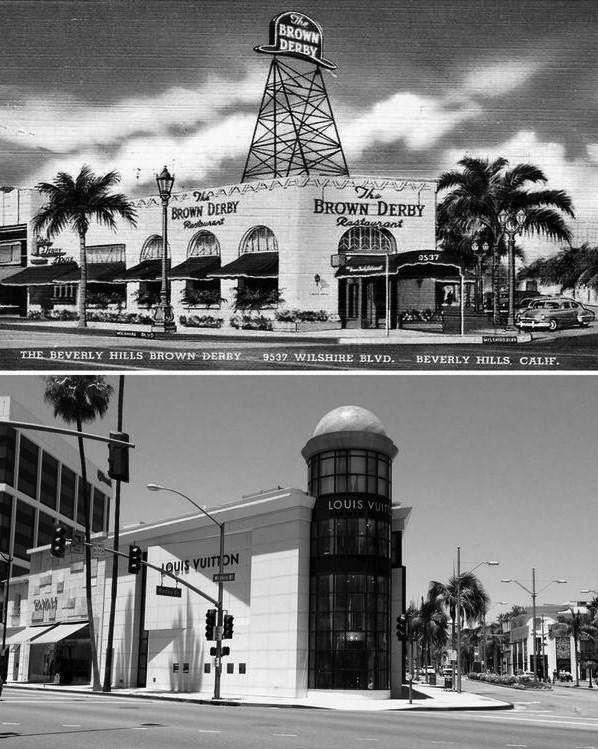 |
|
| (2014)* - The Brown Derby is gone, but the Louis Vuitton building gives a subtle nod to the past with its brown, hat-like dome. Location: 9537 Wilshire Bouelvard, Beverly Hills |
* * * * * |
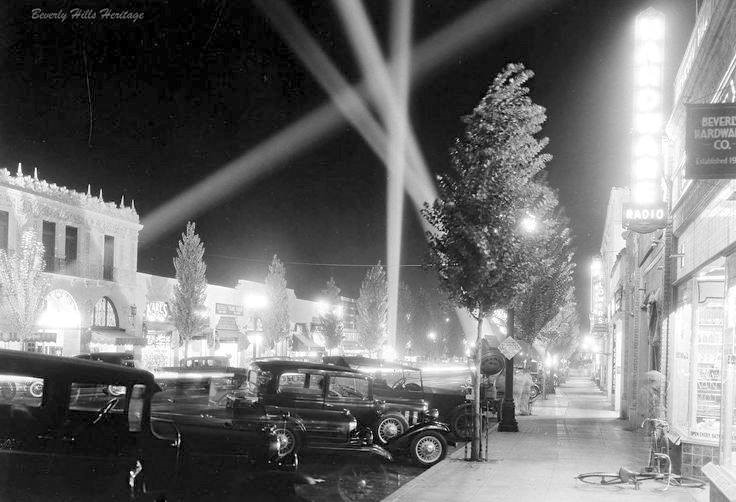 |
|
| (1929)* – Night view of north Beverly Drive showing four spot lights for what appears to be a new store opening which was so typical of the 20s and 30.. At lower right there is a bike casually dropped in the doorway of a hardware store (Beverly Hardware Co.). |
 |
|
| (ca. 1939)^ – Birds-eye view of Beverly Hills looking northwest from the intersection of Wilshire Boulevard and Doheny Drive. Beverly Hills City Hall can be seen in the distance (upper center-left). |
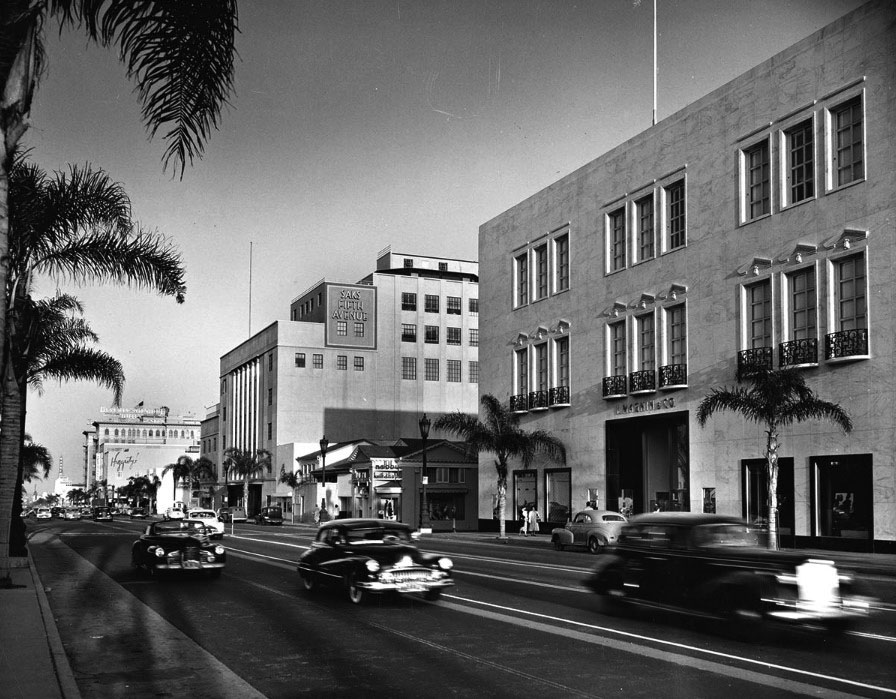 |
|
| (1940s)* - View looking east on Wilshire Boulevard in Beverly Hills showing I. Magnin at right and Saks Fifth Avenue at center-left. In front of Saks Fifth Avenue is an attractive little building housing Nobby Knit Shops. In the background is Haggarty's, the Beverly Wilshire Hotel, a Bank of America and the Warner Beverly Hills Theater. |
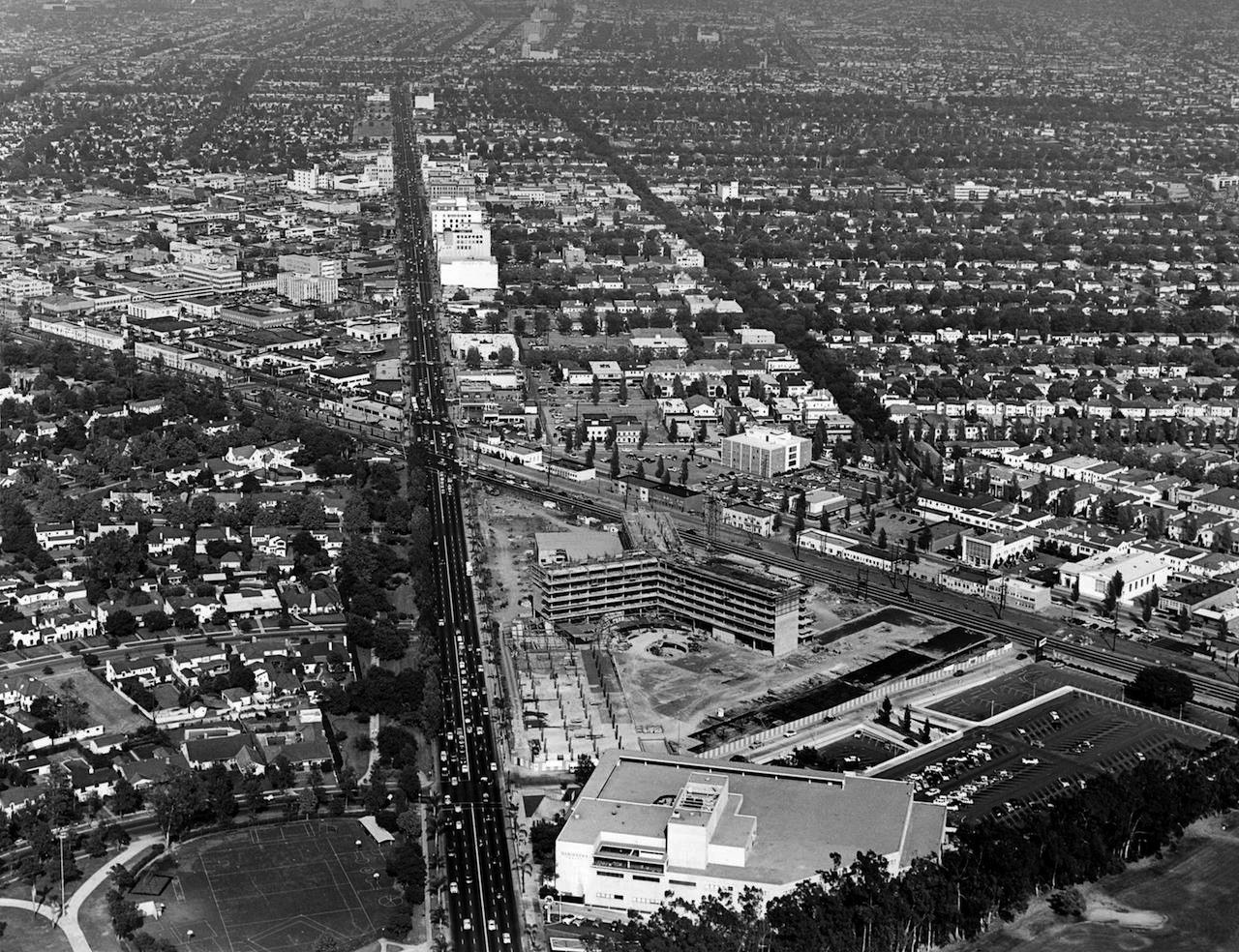 |
|
| (1954)* – Aerial view looking east on Wilshire Boulevard where it intersect Santa Monica Boulevard showing the construction of the Beverly Hilton Hotel and the surrounding Beverly Hills area. |
Historical Notes Conrad Hilton opened the Beverly Hilton in 1954. Architect Welton Becket designed the hotel as a showpiece with 582 rooms. Since 1961, the hotel's International Ballroom has hosted the Golden Globe Award ceremony, presented annually by the Hollywood Foreign Press Association. |
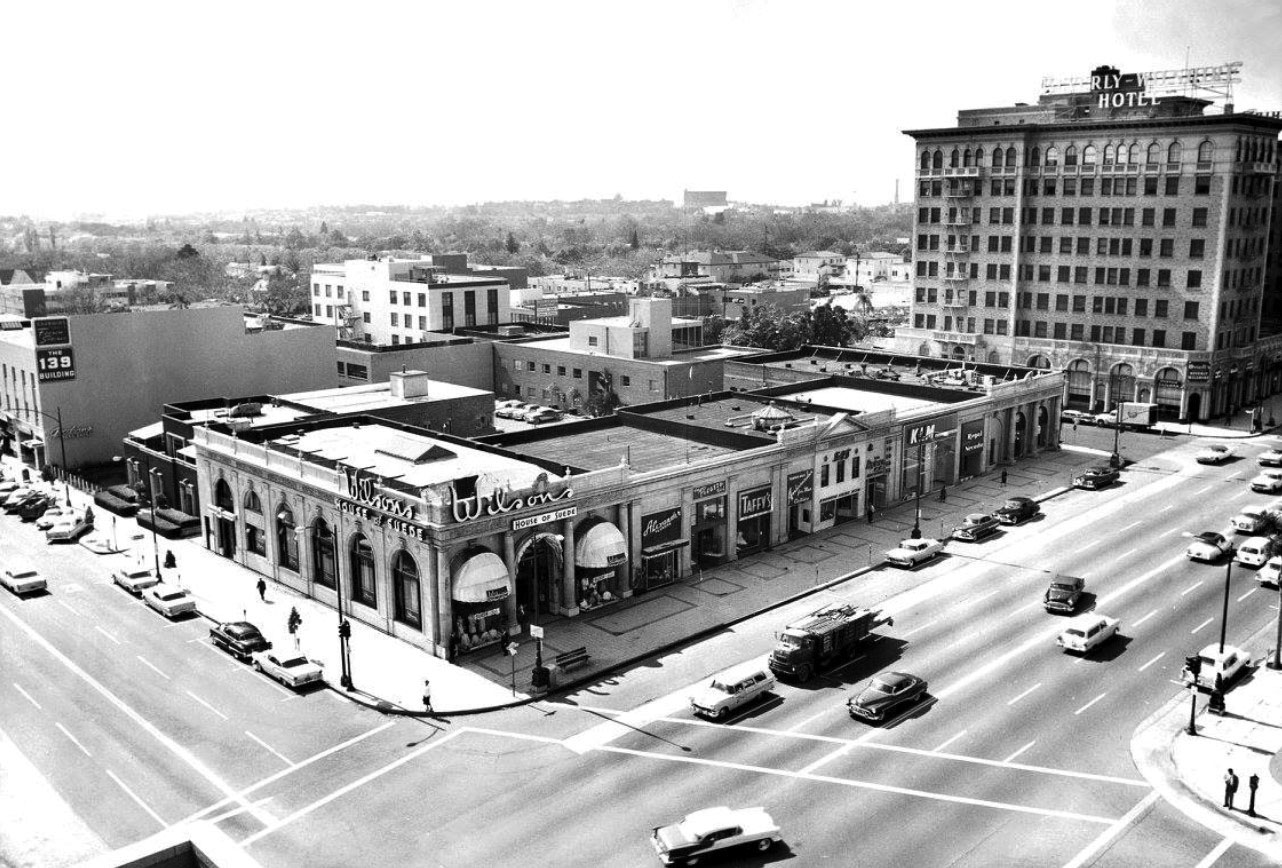 |
|
| (1957)* – View of Wilshire Boulevard showing the side of the Beverly Wilshire Hotel and Wilson's House of Suede anchoring the line of stores to the east of the hotel on the corner of El Camino. |
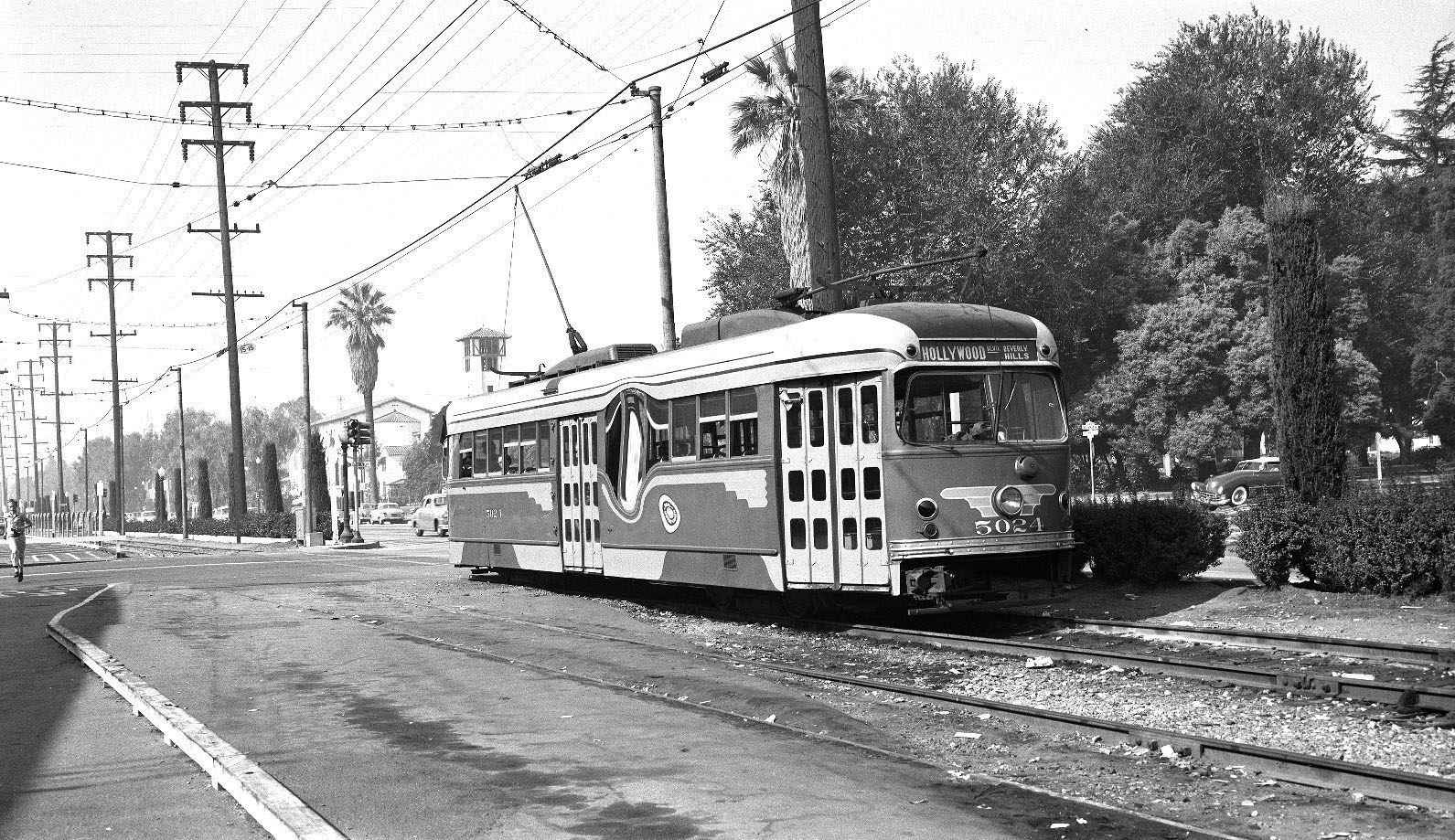 |
|
| (1950s)* - View looking west near the intersection of Beverly Drive and Santa Monica Boulevard showing a streetcar heading east toward Hollywood. Sign on streetcar reads: HOLLYWOOD - BEVERLY HILLS |
Historical Notes The Pacific Electric streetcar lines ran along Santa Monica Boulevard through Beverly Hills until 1965. |
Click HERE to see more Early Views of Beverly Hills |
* * * * * |
Downtown LA
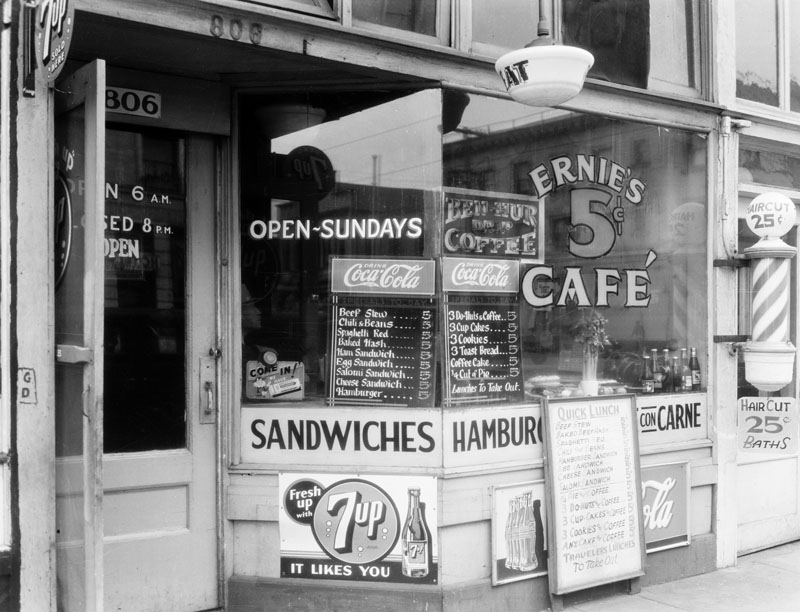 |
|
| (1939)^ - Ernie's 5¢ Café, located at 806 E. 5th Street in DTLA, where a person could get a meal for a nickel. After lunch you could always get a haircut nextdoor for only 25¢. |
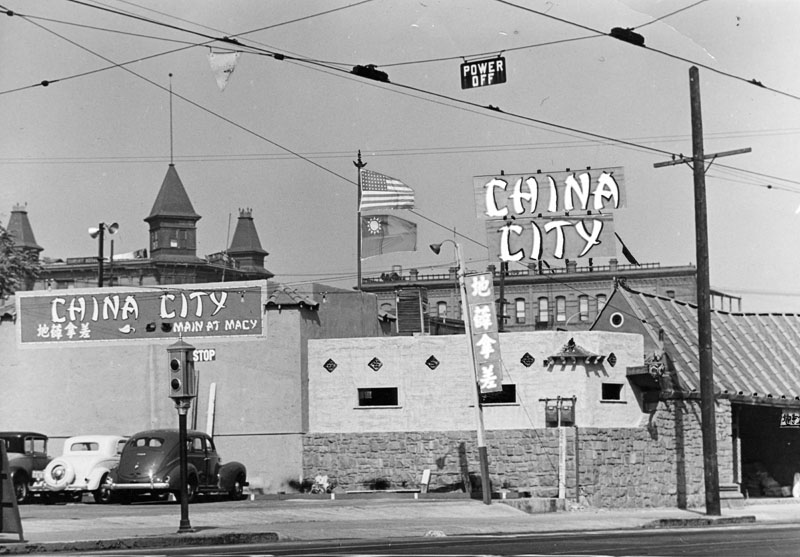 |
|
| (1940s)^ - China City, a Chinese settlement between Spring and Main and between Macy and Ord Streets. Main Street was the main entrance to China City. Note the old-style traffic signal and the "POWER OFF" sign on the overhead lines. |
* * * * * |
Court Flight
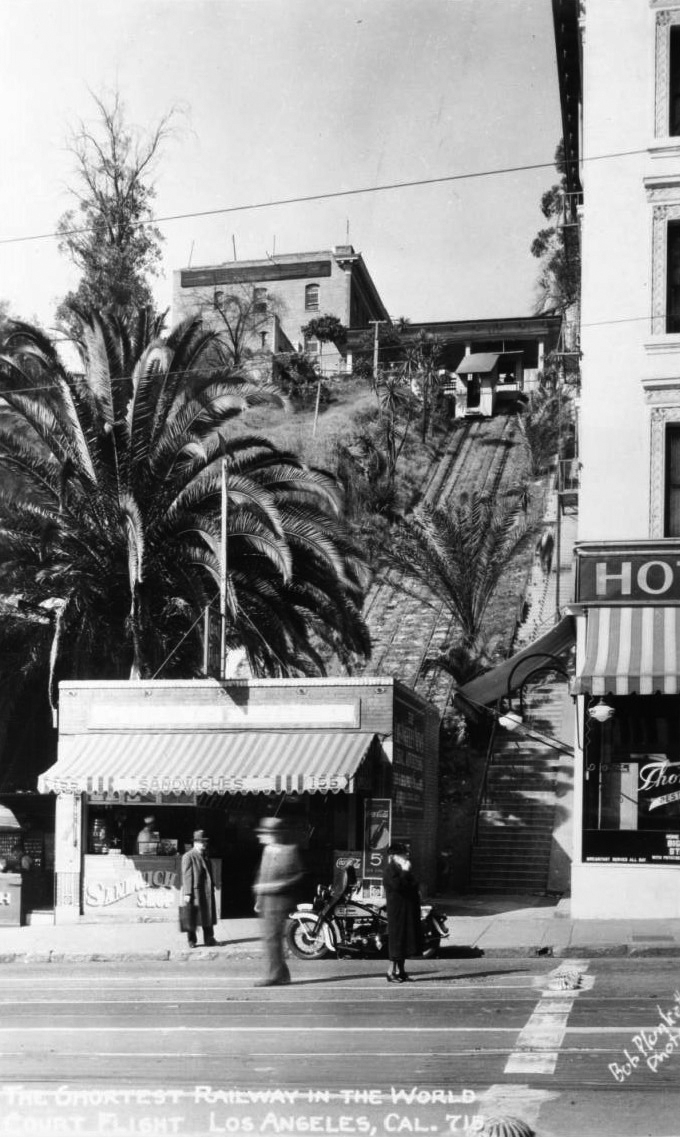 |
|
| (ca. 1930)* - View of Court Flight, "The Shortest Railway in the World", showing a sandwich shop at its base at 155 Broadway. |
Historical Notes From 1905 to 1943, Court Flight climbed the eastern slope of Bunker Hill, a few blocks north of the better-known Angels Flight. The incline was about 200 feet long and rose roughly 100 feet, beginning on Broadway between First and Temple. It sat directly across from the LA County Courthouse and the Hall of Records, making it a convenient shortcut for both residents and government workers. |
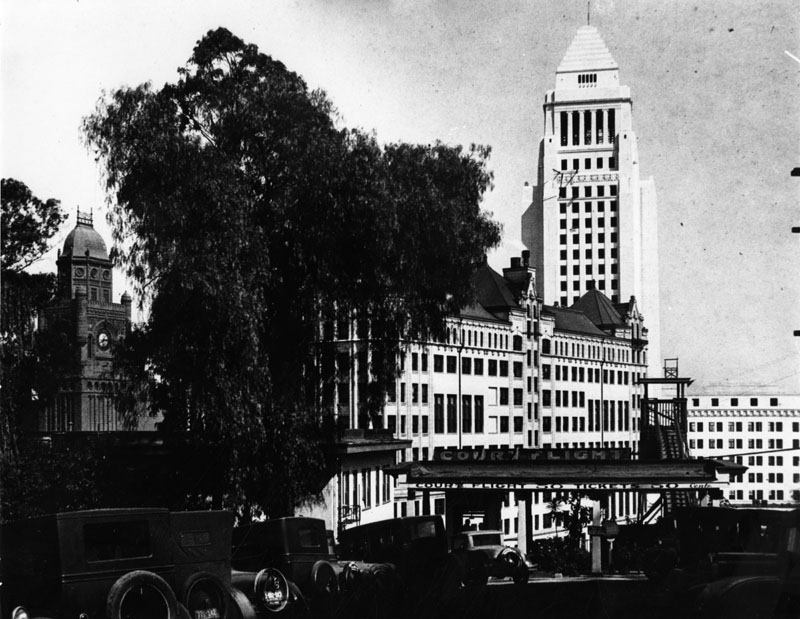 |
|
| (ca. 1935)* - View of parking area and upper entrance to Court Flight cable railway, leading to the Hall of Records, County Courthouse and City Hall below. Next to the railway on the north is New Hotel Broadway. |
Historical Notes Court Flight originally served the people living on Bunker Hill, but by the 1930s the neighborhood was changing. Many of the estimated 1,000 daily riders were now government employees who parked cheaply on the hill and used the incline to reach the growing Civic Center below. As downtown developed, Court Flight became more of a commuter link than a neighborhood necessity. |
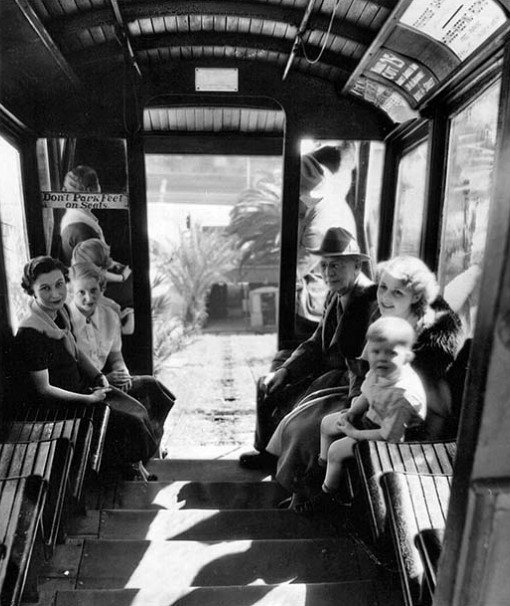 |
|
| (1935)* - Riders inside a car on the Court Flight Incline Railroad in downtown Los Angeles. |
Historical Notes A 1935 Los Angeles Times profile described the long routine of operator Sam Vandegrift, who had run Court Flight for nearly three decades. Through the rise of silent films, the careers of Babe Ruth and Christy Mathewson, and sweeping changes in the city, he remained behind the controls of the two 14-passenger wooden cars. After Sam’s death, his widow, Annie Vandegrift, continued the operation, but by 1942 daily ridership had fallen to fewer than 300. She petitioned the city for permission to shut the line down. |
.jpg) |
|
| (ca. 1943)* - Looking down the rails of the Court Flight Cable Railway, showing the Hotel Broadway, located next door on the left at 205 So. Broadway. |
Historical Notes World War II brought the incline’s final decline. With ridership low and trained operators hard to find during wartime, Court Flight could no longer remain profitable. In early 1943 Annie Vandegrift closed the railway after 39 years of continuous service. It never operated again. |
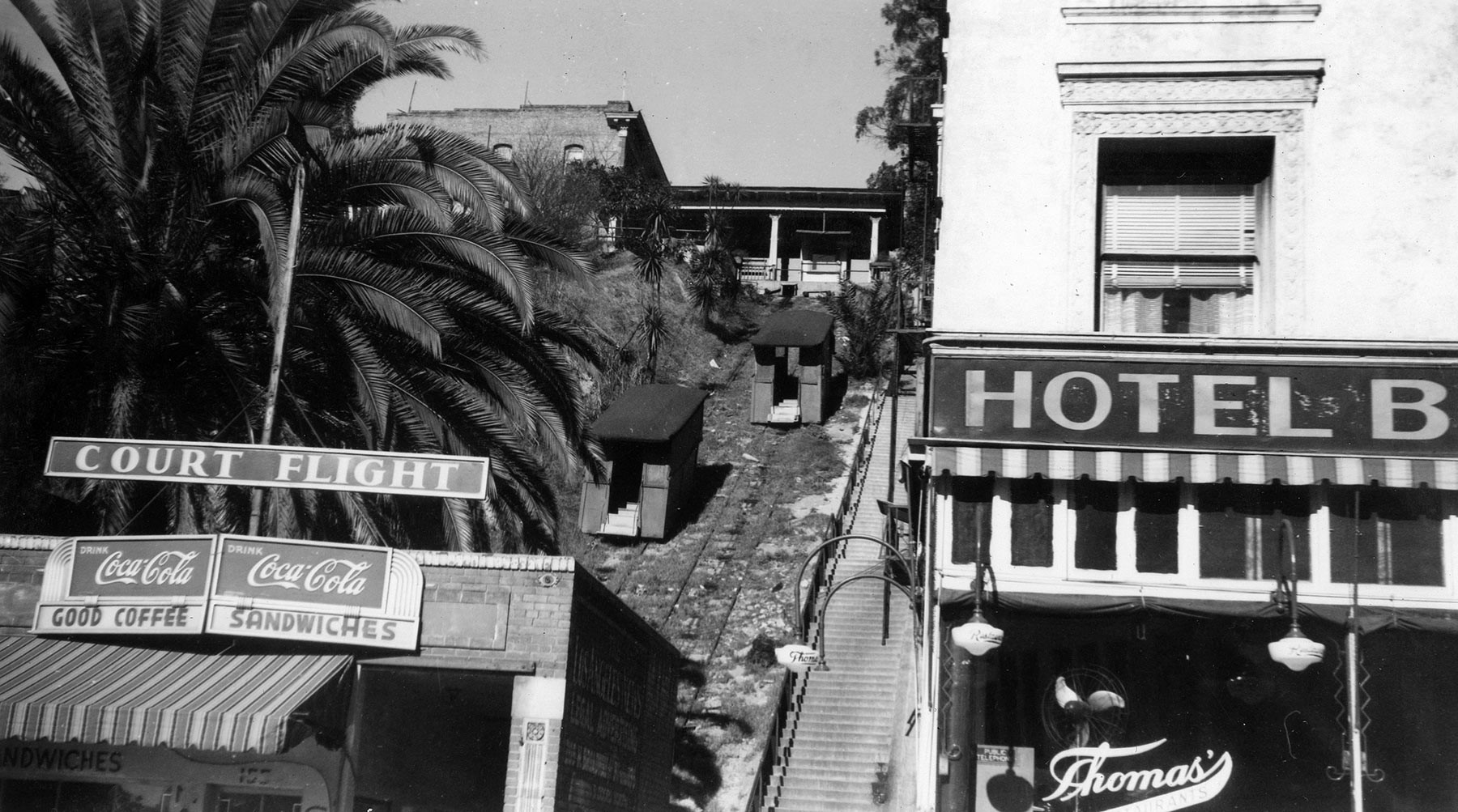 |
|
| (1943)* – One of the last images of Court Flight before it was destroyed by fire. |
Historical Notes Although already closed, the structure remained in place until October 19, 1943, when a fire swept through the site and destroyed the cars, track, and machinery. After the fire, nothing of Court Flight was rebuilt. |
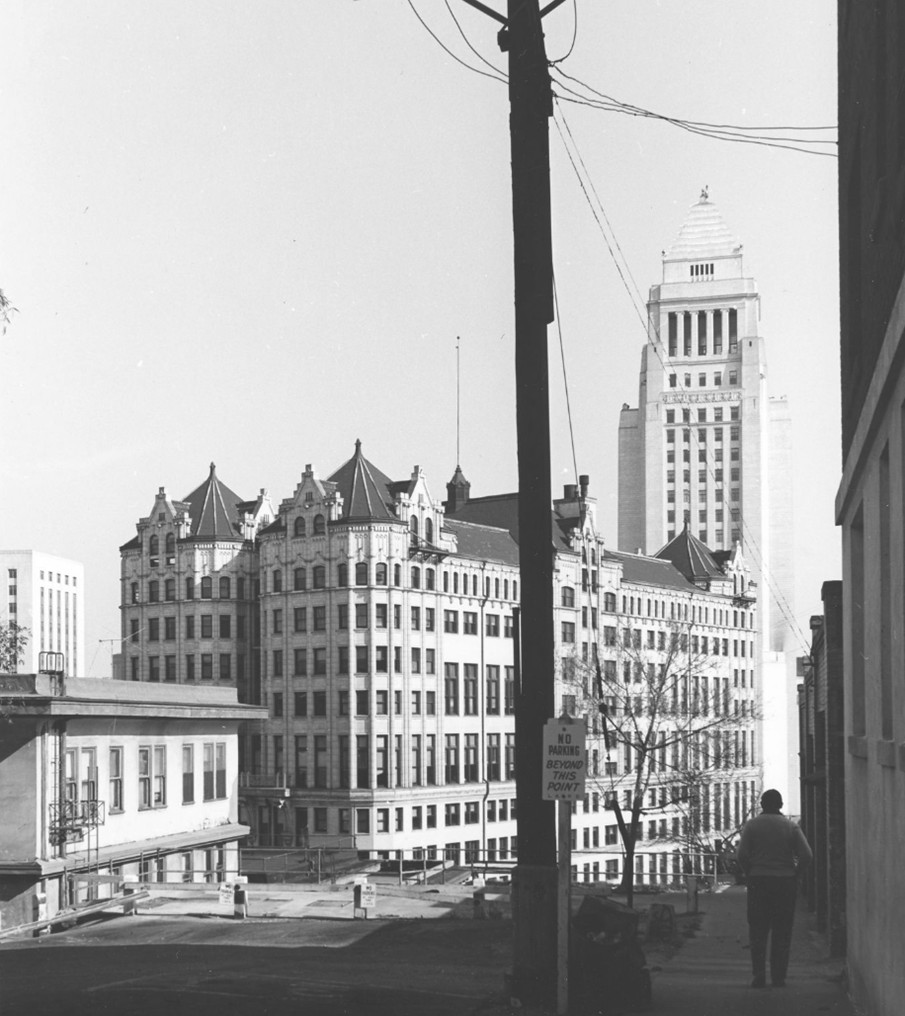 |
|
| (1953)* - View of the Civic Center from the former top of Court Flight, with the Hall of Records in the foreground and City Hall rising behind it. Photo by Arnold Hylen. |
Historical Notes A decade after the incline’s disappearance, the surrounding landscape had begun to change. The Court Flight right-of-way was cleared, and the top landing once used by riders now overlooked an expanding Civic Center. Photos from this period show only the view that Court Flight once offered, with no physical trace of the railway left. |
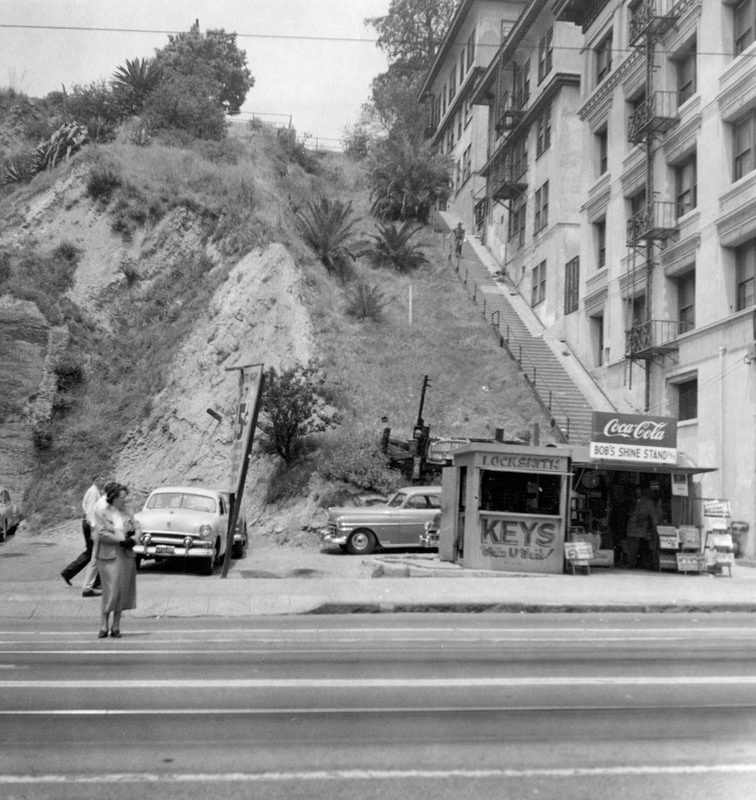 |
|
| (1954)* – About eleven years after Court Flight’s closing. |
Historical Notes By the mid-1950s, the area once occupied by Court Flight was fully absorbed into the Civic Center street grid and ongoing redevelopment projects. The incline was gone, and only photographs and memories preserved its place in Los Angeles history. Click HERE to see more Early Views of Court Flight. |
* * * * * |
Bunker Hill (Before and After)
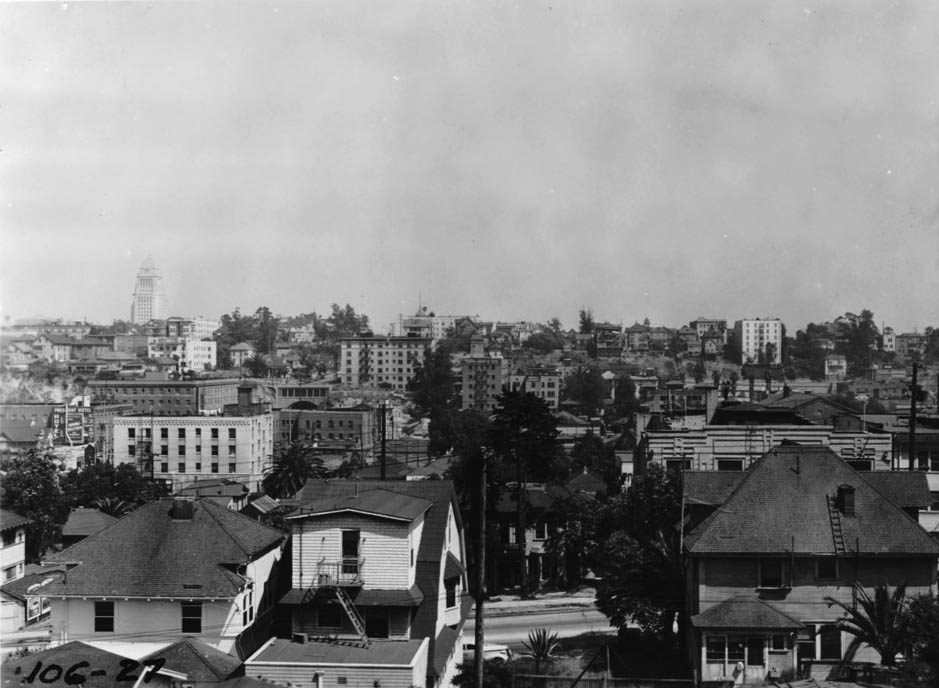 |
|
| (1937)*# - View looking east toward Bunker Hill with City Hall in the distance. Beaudry runs horizontally in the foreground. You can just make out the 2nd Street Tunnel at center-left. |
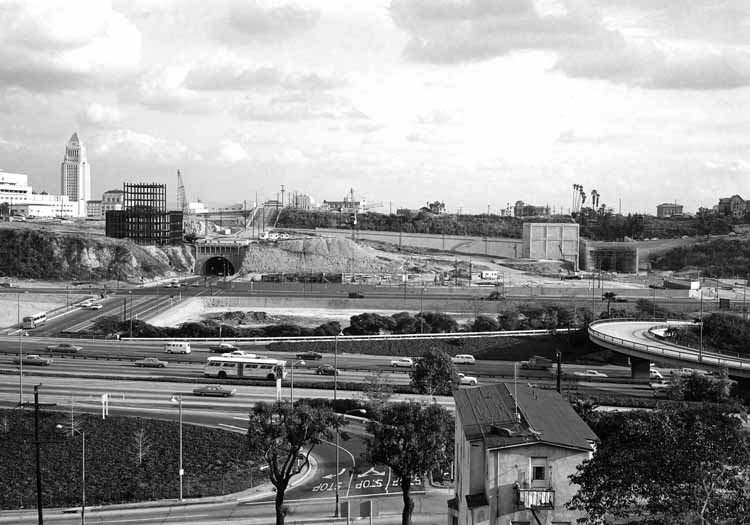 |
|
| (1968)**^* - View looking east toward Bunker Hill from about the same spot as previous photo but 31 years later. 2nd Street Tunnel is clearly visible and the Harbor Freeway now runs across the bottom of photo. |
Before and After
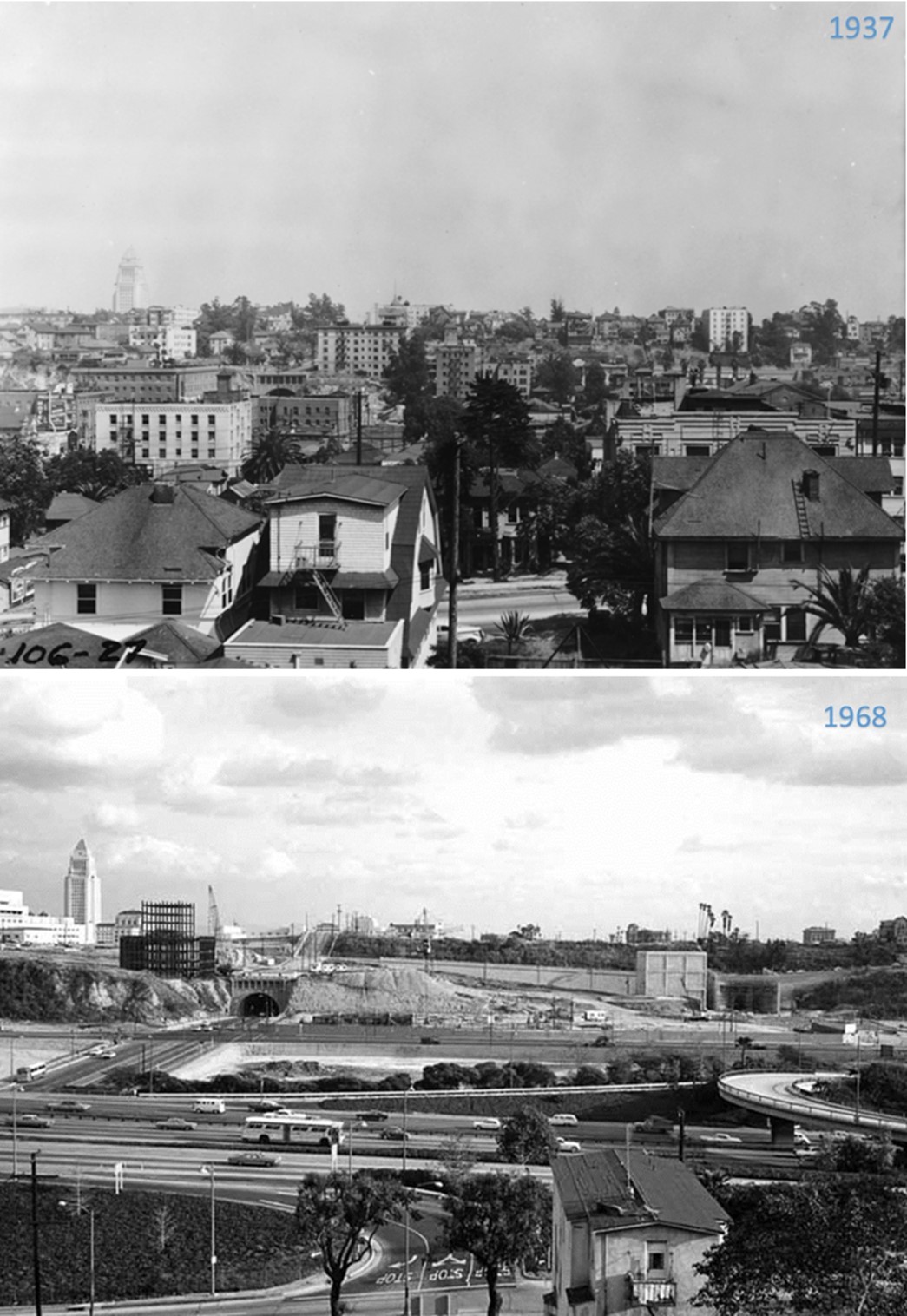 |
|
| (1937 vs 1968) - Before and After the demolition of Bunker Hill. View is looking east with Beaudry running horizontally in the foreground. The 2nd Street Tunnel can be seen at center-left. |
Historical Notes Click HERE to see more Early Views of Bunker Hill |
* * * * * |
Wilshire Boulevard (near La Brea Ave)
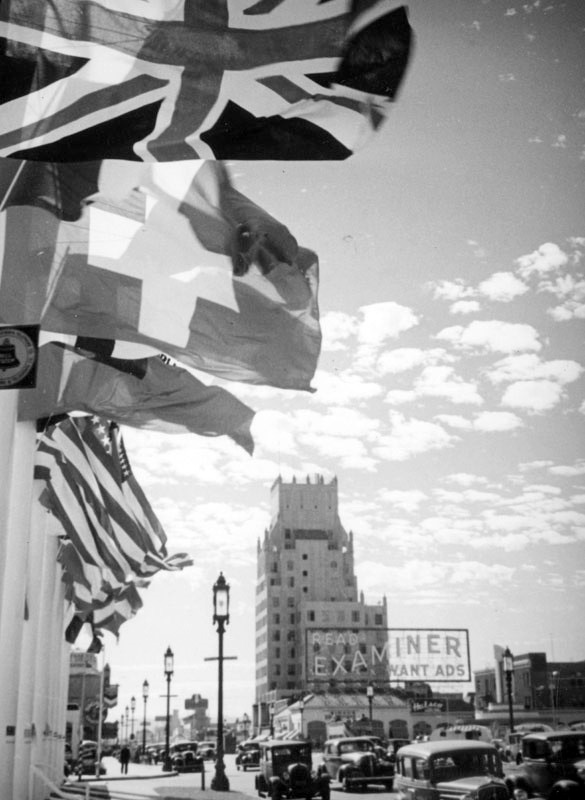 |
|
| (1937)^ – View looking west on Wilshire Boulevard toward La Brea from in front of the Four Star Theatre. Also visible in this picture are the E. Clem Wilson Building, a neon sign for the Examiner want ads and, just to the right of the sign, a Simon's Drive In (5171 Wilshire Boulevard). "Wilshire Special" streetlights line both sides of the boulevard. |
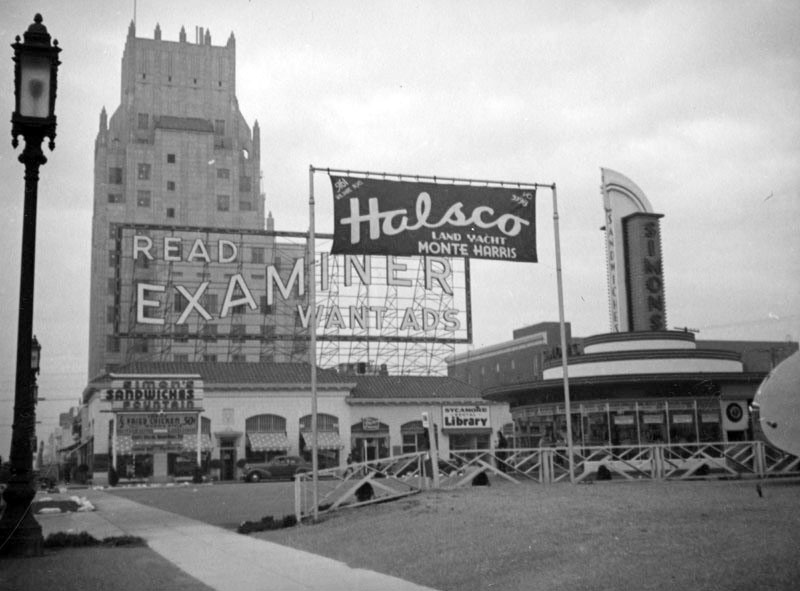 |
|
| (ca. 1939)^ - View showing the Simon’s drive-in restaurant, located at 5171 Wilshire Boulevard, with a sign for Halsco out front on the lawn. Nearby are a sign which encourages passers-by to “Read Examiner Want Ads,” the offices for Mutual of Omaha in the E. Clem Wilson Building (upper left, later Samsung), located at 5217 Wilshire Boulevard, and two Wilshire Lanterns (left). |
Historical Notes At one time Simon's Drive-Ins dominated the Southern California drive-in restaurant craze. The Simon brothers had operated a chain of successful dairy lunch counters in downtown Los Angeles, and in 1935 decided to capitalize on the growing car culture of Los Angeles by opening auto friendly locations in the emerging commercial centers of Wilshire Boulevard, Sunset and Ventura Boulevards. #^* Click HERE to see more Early Views of LA Drive-in Restaurants. |
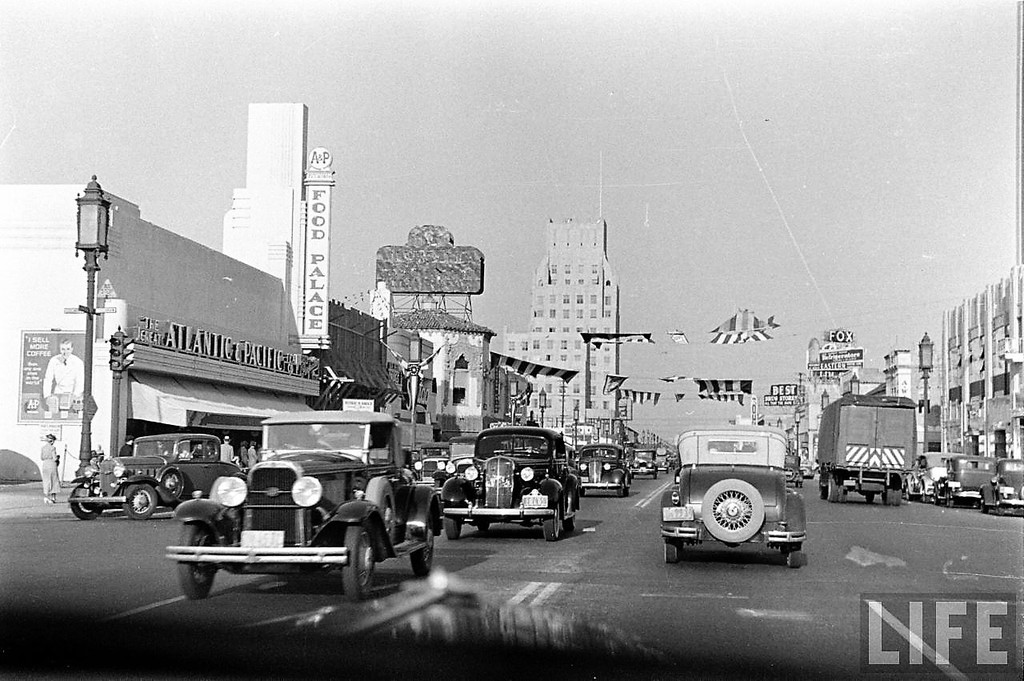 |
|
| (ca. 1939)*#^ – Dashboard view looking east on Wilshire Boulevard toward La Brea Avenue. On the left is an A&P Market (A&P Food Palace). In the distance is the E. Clem Wilson Building (NE corner of La Brea and Wilshire) and across the street (SE corner) the large Fox Ritz Theatre sign. This A&P later became Roman Foods and is currently occupied by a Staples Store. |
Historical Notes The A&P stores evolved from the Great Atlantic and Pacific (A&P) Tea Company, founded in the 1800s in New York by George Hartford and George Gilman. In 1912, John Hartford, son of the co-founder, came up with the idea of expanding and forming the A&P Econonmy Store chain which would rely on a business model that included standarization of layout and elmination of credit accounts and delivery. The format was wildly successful, and the chain had grown from 585 stores in 1913 to more than 4500 stores by 1920, and to over 15,000 stores all over the east coast and Midwest by 1930. In the early 1930s, the first California stores were opened, adding some credibility to the company name. By the 1960s, A&P stores were stale, sales were flat, and the midwestern and west coast divisions were struggling. A well-publicized corporate reorganization in 1968 and 1969 did little to stem the decline, and the next two decades were defined by declining sales, closing stores, and failed format changes. Among the stores closed were the entire Southern California operation, in 1969, which eliminated A&P as a contender in the fastest-growing market in the country.^ |
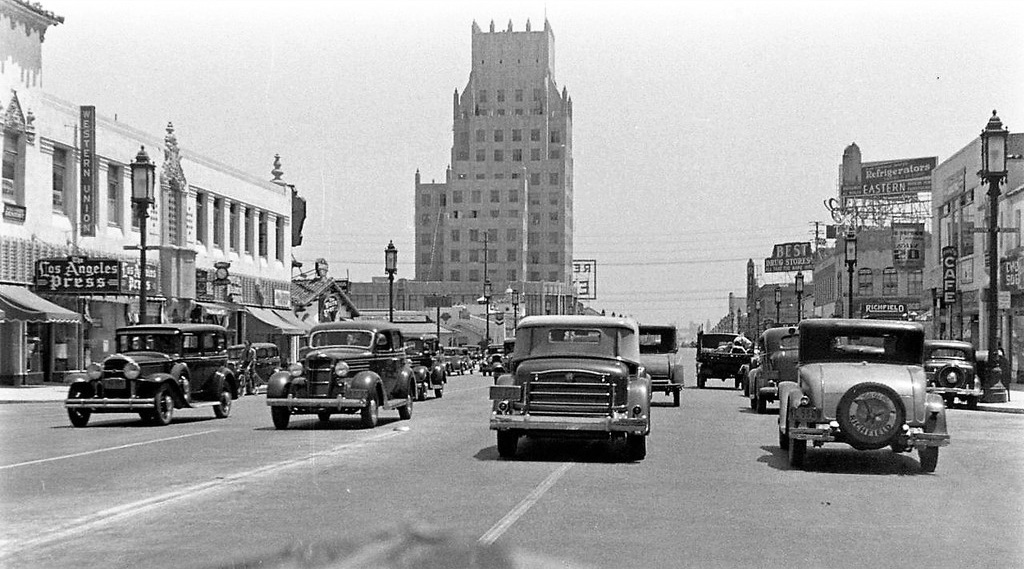 |
|
| (ca. 1939))*#^ – Moving closer toward La Brea on Wilshire Boulevard with the E. Clem Wilson Building seen on the NE corner. |
.jpg) |
|
| (ca. 1940)*# – View looking east along Wilshire Boulevard with the E. Clem Wilson Building at La Brea and Wilshire in the background. The Dominguez-Wilshire Building is on the right. Sontag Drug Store is on the left. |
 |
|
| (1939)^ - View looking west from the corner of Wilshire Boulevard and Cloverdale Avenue. The Art Deco building housing a Sontag Drug Store is seen on the corner. A&P Food Palace is seen futhrer west. |
Historical Notes Built in 1935, this Art Deco structure has stood the test of time. It was originally the Sontag Drug Store, one of the largest drug stores in America at the time. It was also one of the first to allow customers to browse and choose their own products rather than requesting them from a clerk behind a counter. The building still stands, housing “Wilshire Beauty” and looking much like it did more than seven decades ago.***# Click HERE to see contemporary view. |
* * * * * |
Wilshire Boulevard (near Lafayette Park)
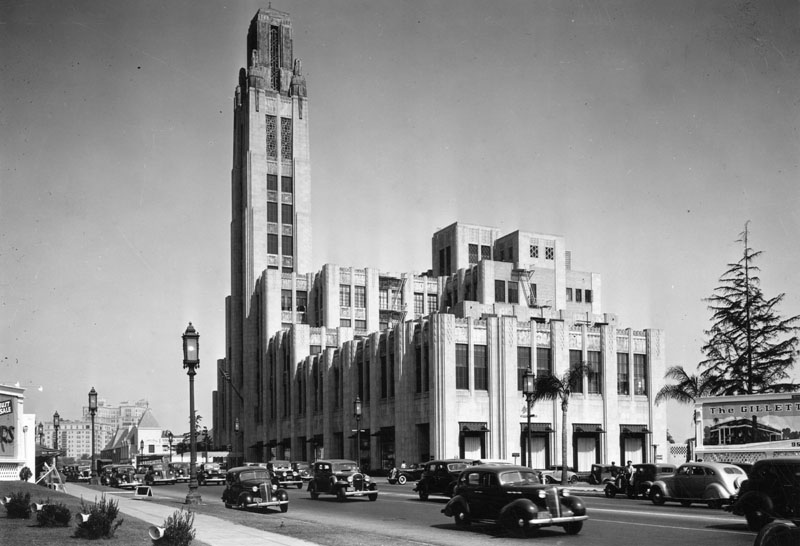 |
|
| (ca. 1939)^ - View looking East on Wilshire Boulevard. Bullock's Wilshire stands across the street (South side). Cars are seen traveling east and west on Wilshire Blvd. James Webb, Engraving and Stationery store, is present in the background on the left. |
Historical Notes The Bullock's Wishire Building was completed in 1929 as a luxury department store for owner John G. Bullock (owner of the more mainstream Bullock's in Downtown Los Angeles). The exterior is notable for its 241-foot tower whose top is sheathed in copper, tarnished green. At one time, the tower peak had a light that could be seen for miles around. Bullock's Wilshire's innovation was that it was one of the first department stores in Los Angeles to cater to the burgeoning automobile culture. It was located in a then-mostly residential district, its objective to attract shoppers who wanted a closer place to shop than Downtown Los Angeles. In 1968, the Bullock's Wilshire Building, located at 3050 Wilshire Boulevard, was designated Los Angeles Historic Cultural Monument No. 56 (Click HERE to see complete listing).^* |
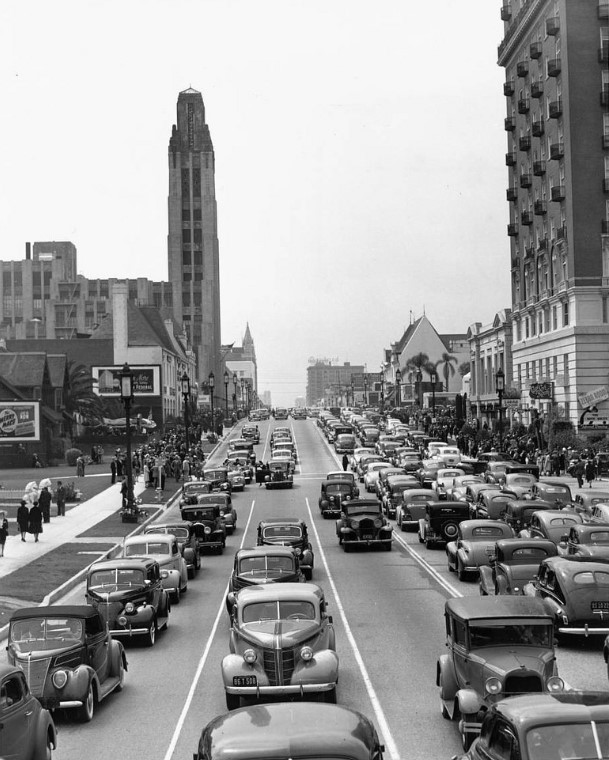 |
|
| (1939)^^ - View looking west down Wilshire Boulevard from South Commonwealth Avenue with the Town House Hotel and apartments on the right. There is a great array of cars and crowds. Bullock's Wilshire Tower is on the left. Photo by Dick Whittington |
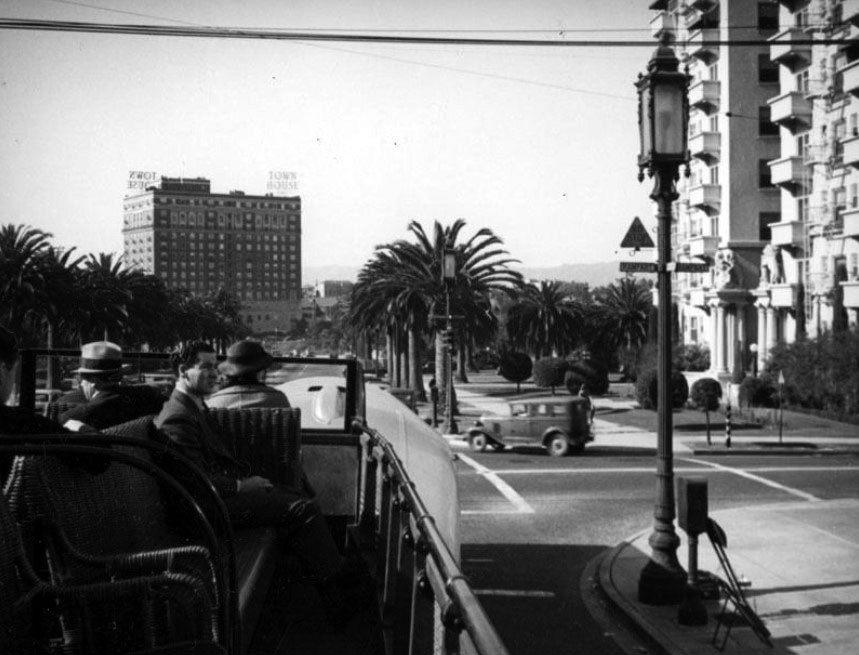 |
|
| (ca. 1938)^ – Double-decker westbound at Wilshire Boulevard and Rampart. Lafayette Park is straight ahead and to the right and the Town House Hotel can be seen in the distance. Photo by Herman J. Schultheis |
Historical Notes Wilshire has an interesting distinction, it was the only street that was banned by the City of Los Angeles from having street rail on it. The elites of early 20th century Los Angeles who built their mansions in the area were the region's first "NIMFYs" (Not in My Front Yard). The clanging bells and masses who rode streetcars were not welcomed on Wilshire, but buses were. #* |
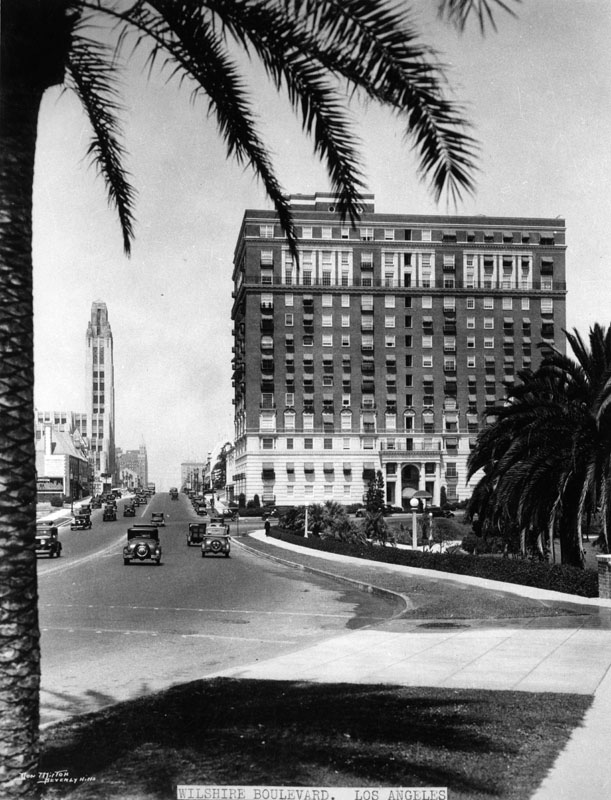 |
|
| (ca. 1935)^ - View of Wilshire Blvd. looking west at Lafayette Park toward the Town House Hotel, also known as Sheraton Town House and Sheraton West, at right, and Bullock's Wilshire department store at left. |
Historical Notes Designed by Norman W. Alpaugh, in Mediterranean Revival, Art Deco, and other revival styles, the Town House was once among the most luxurious hotels in Southern California. It is located on Wilshire Boulevard, adjacent to Lafayette Park in the Westlake district.^* |
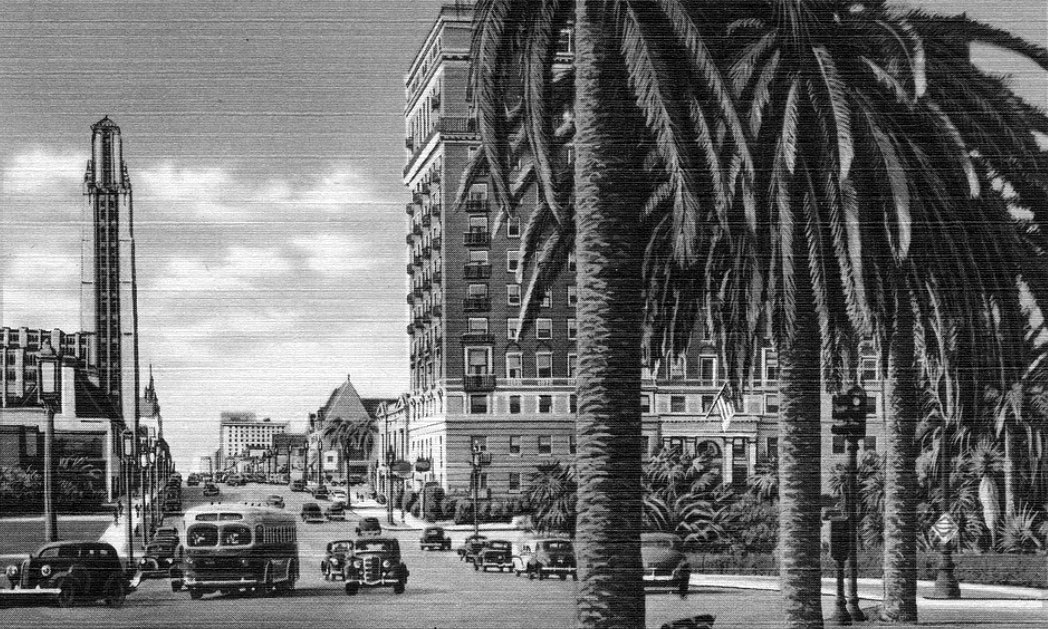 |
|
| (ca. 1939)##* – Postcard view looking west on Wilshire Boulevard as seen from Lafayette Park (previously Sunset Park). |
Historical Notes Clara R. Shatto donated 35 acres of land that now makes up Lafayette Park to the City of Los Angeles in 1899. The land consisted of tar seeps and oil wells and Shatto requested that it be developed into a park. Shatto was the wife of George Shatto, then-owner of Santa Catalina Island. Canary Island palm trees and jacaranda were planted in the area of what became known as Sunset Park. Local groups requested that the name be changed to commemorate Marquis de Lafayette, a military officer of the American Revolutionary War. The name was officially changed in 1918. A statue of him was erected in 1937, close to the Wilshire Boulevard entrance.^* |
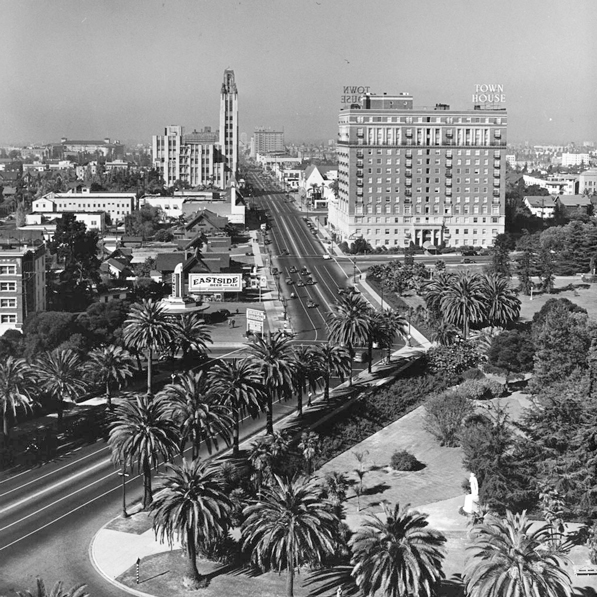 |
|
| (1940)*# - Aerial view of Wilshire Boulevard facing west from Lafayette Park past the Town House, the Bullock's Wilshire tower, towards the Gaylord Apartments and the Ambassador Hotel at Wilshire Boulevard and Kenmore Avenue. |
Historical Notes Lafayette Park's vicinity has seen the construction of numerous architecturally significant buildings. Several are listed in the National Register of Historic Places: the Sheraton Town-House, Felipe de Neve Branch Library, and Bullock's Wilshire, all built in 1929.^* |
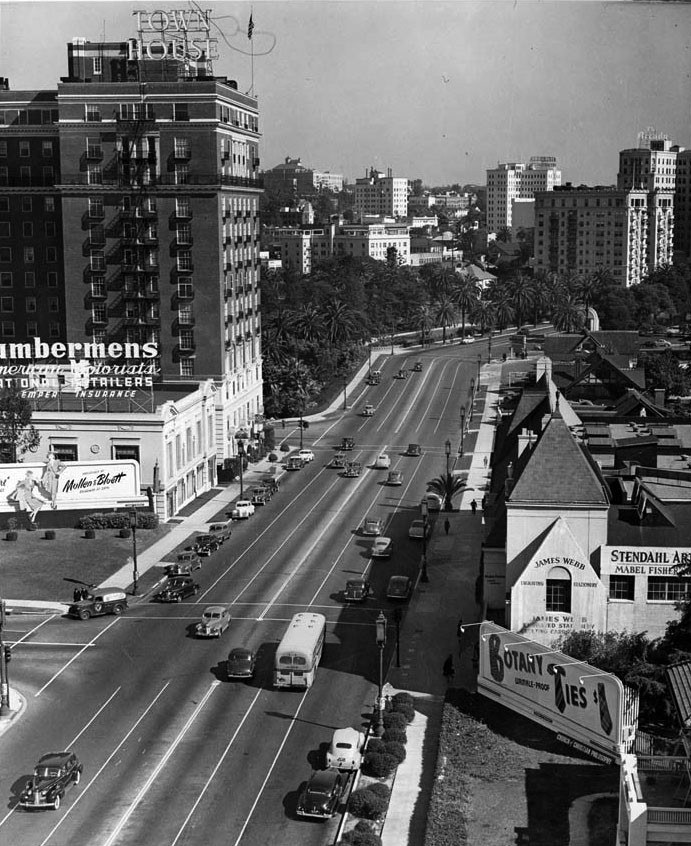 |
|
| (1946)**^* – View looking northeast on Wilshire Boulevard toward Lafayette Park. The Town House at 2959-2973 Wilshire Blvd. is seen across the street from the park (upper-left). The Bryson Apartments building stands on the other side of the park (upper-right). |
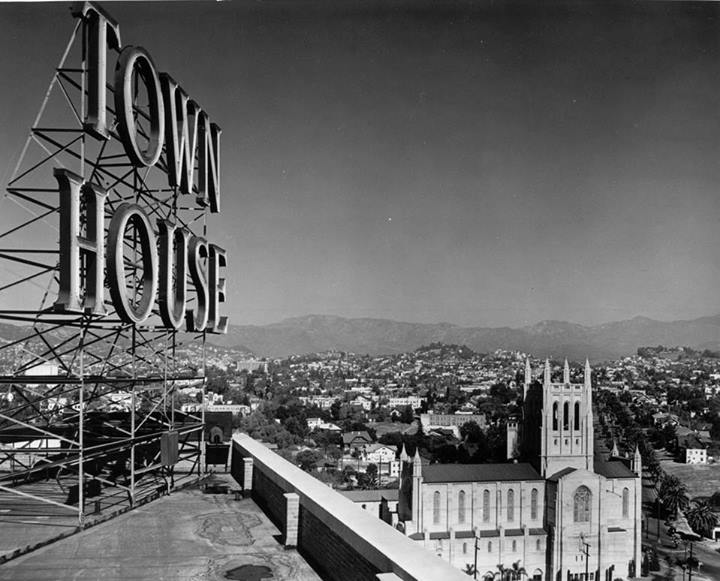 |
|
| (ca. 1940s)* - View from the roof of the Town House looking north toward the Hollywood Hills. The First Congregational Church, 540 S. Commonwealth, is seen at the lower-right. Photo: Vintage Los Angeles. |
Historical Notes From the 1960s through the 1980s, the area around Lafayette Park became less desirable and more dangerous. The building was operated for many years as a Sheraton hotel under the name "The Sheraton-Town House" and "The Sheraton-West". It was later converted for use as low-income housing. In 1997, the Town House was listed on the National Register of Historic Places, and in 1994 it was designated as Los Angeles Historic-Cultural Monument No. 576 (Click HERE to see complete listing). |
 |
|
| (1940s)^* - View of Wilshire Boulevard facing east as seen from the top of the Sheraton Town House. Lafayette Park is on the left. Simon's Drive-in Restaurant is across the street on the right, southwest corner of Wilshire and Hoover Street. |
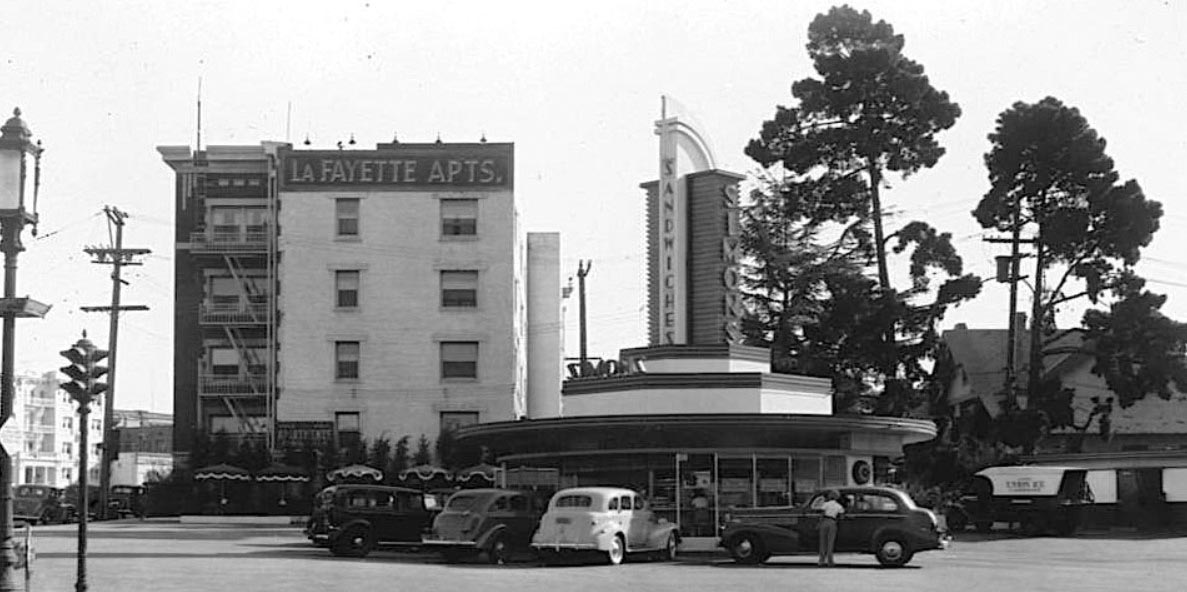 |
|
| (1939)^ – Panoramic view looking south from Wilshire Boulevard showing Simon's Drive-in Restaurant with the La Fayette Apartments behind it. Simon’s was located on the SW corner of Wilshire Boulevard and Hoover Street. In the 1950s it would become a Stan's Drive-in. |
Historical Notes At one time Simon's Drive-Ins dominated the Southern California drive-in restaurant craze. The Simon brothers had operated a chain of successful dairy lunch counters in downtown Los Angeles, and in 1935 decided to capitalize on the growing car culture of Los Angeles by opening auto friendly locations in the emerging commercial centers of Wilshire Boulevard, Sunset and Ventura Boulevards. Click HERE to see more Early Views of Simon's Drive-ins. |
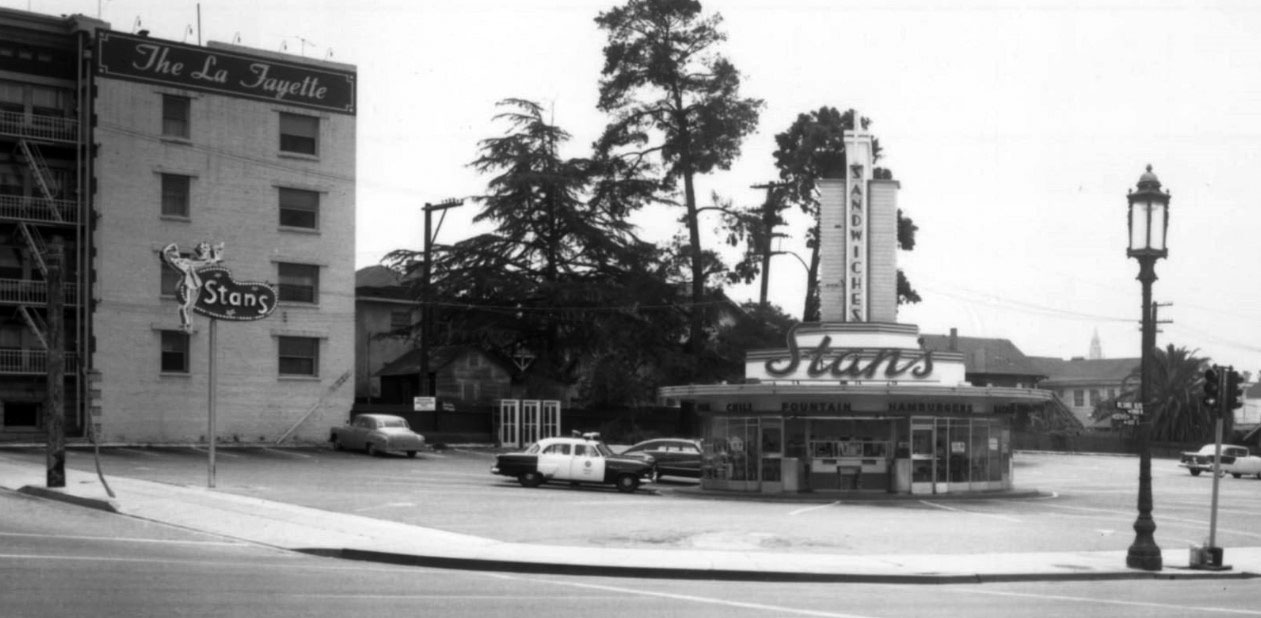 |
|
| (ca. 1956)*# - Stan's Drive-in (formerly a Simon’s), SW corner of Wilshire Boulevard and Hoover, with the La Fayette Apartments seen at left. |
Historical Notes Stan's was a chain of drive-in's with at least a dozen LA locations in the late 1950's and 60's. Many of the original Carpenter’s and Simon’s drive-ins were converted into a Stan’s. Click HERE to see more Early LA Drive-in Restaurants. |
* * * * * |
Hollywood
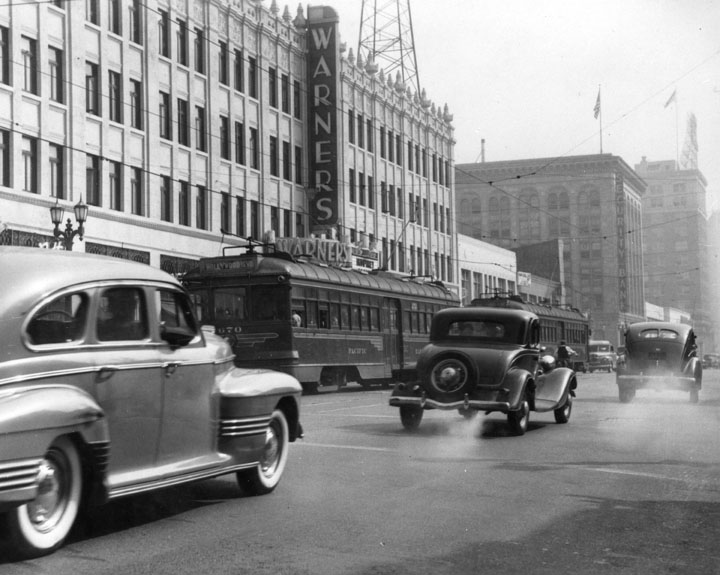 |
|
| (1940)^ - BEFORE SMOG CHECKS - Three cars are driving east from Wilcox on Hollywood Blvd., while on the opposite side two streetcars are coming west past Warners movie theater. |
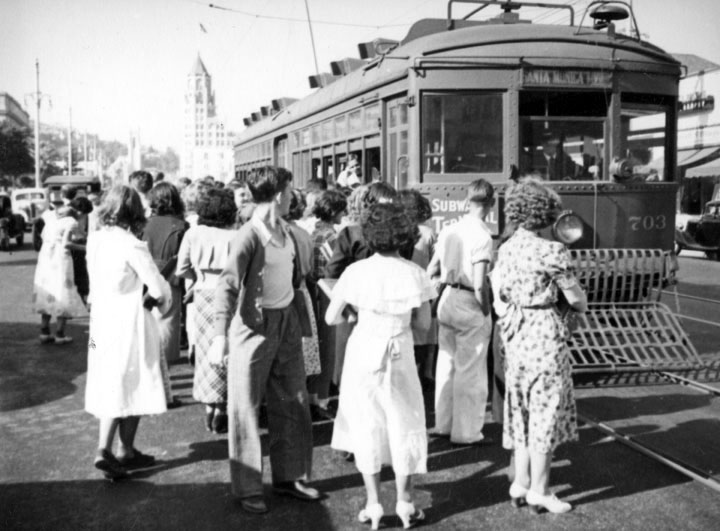 |
|
| (ca. 1940s)^ - A group of people boarding the Pacific Electric Railway car in Hollywood for the Subway Terminal Building via Santa Monica Boulevard circa the 1940s. |
.jpg) |
|
| (ca. 1940)^ - Panoramic view of Hollywood looking northwest toward the Cahuenga Pass. The Hollywood Freeway and Cahuenga Pass are visible at the top of the photo, with the San Fernando Valley far off in the distance. |
Historical Notes The cluster of buildings in the middle portion of this urban jungle are: KNX and CBS Radio Playhouse (short, windowless building mid-photo); Plaza Hotel; Broadway-Hollywood; Hotel Knickerbocker - which are all along the left side of Vine St.; and the Taft Building - across the street on the right side of Vine Street. The three large white buildings running in an east/west direction along Sunset Blvd. are: CBS Television (long horizontal windows on lower right); the famous Hollywood Palladium (semi-domed white roof, lower middle); and NBC Studios (white building with three long, vertical windows) located on the corner of Sunset and Vine.^ By 1940, Los Angeles' population (which includes Hollywood and the San Fernando Valley) was 1,504,277.^* |
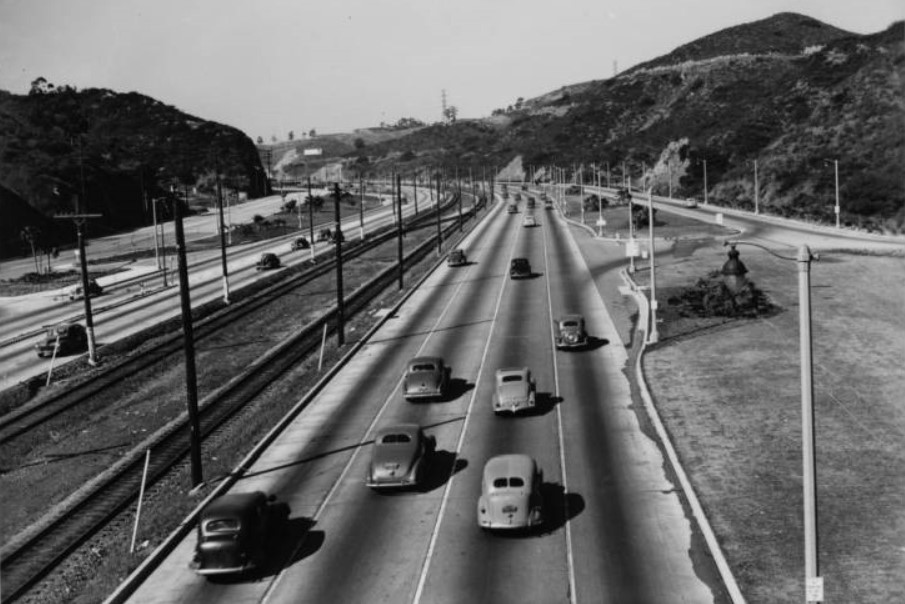 |
|
| (1943)*# - View of Cahuenga Pass with light traffic on February 16, 1943. |
Historical Notes The first segment of the Hollywood Freeway built was a one and a half mile stretch through the Cahuenga Pass. That segment opened on June 15, 1940. It was then known as the "Cahuenga Pass Freeway." Pacific Electric Railway trolleys ran down the center of this freeway until 1952.^* |
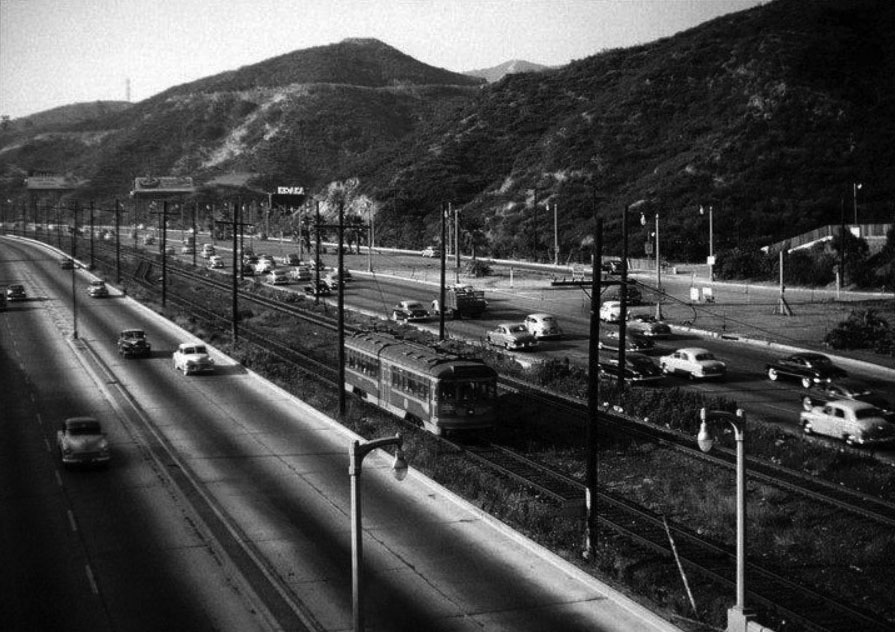 |
|
| (ca. 1950)* - A Pacific Red Car returning from the San Fernando Valley travels along the Cahuenga Pass toward Hollywood. Photo: Vintage Los Angeles. |
Click HERE to see more in Early Views of Hollywood (1920 +) |
* * * * * |
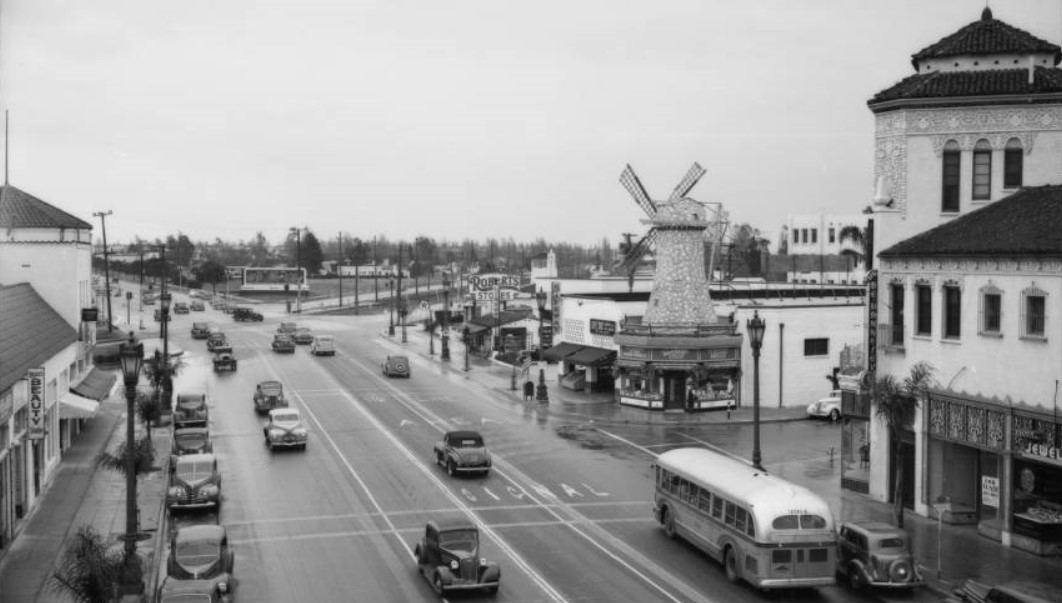 |
|
| (1940)^^ - View looking west toward the intersection of Wilshire Boulevard and South San Vicente Boulevard. |
Historical Notes The Van de Kamp’s Restaurant at Wilshire and San Vicente shaped like a Dutch windmill was one of the last examples of vernacular LA architecture. |
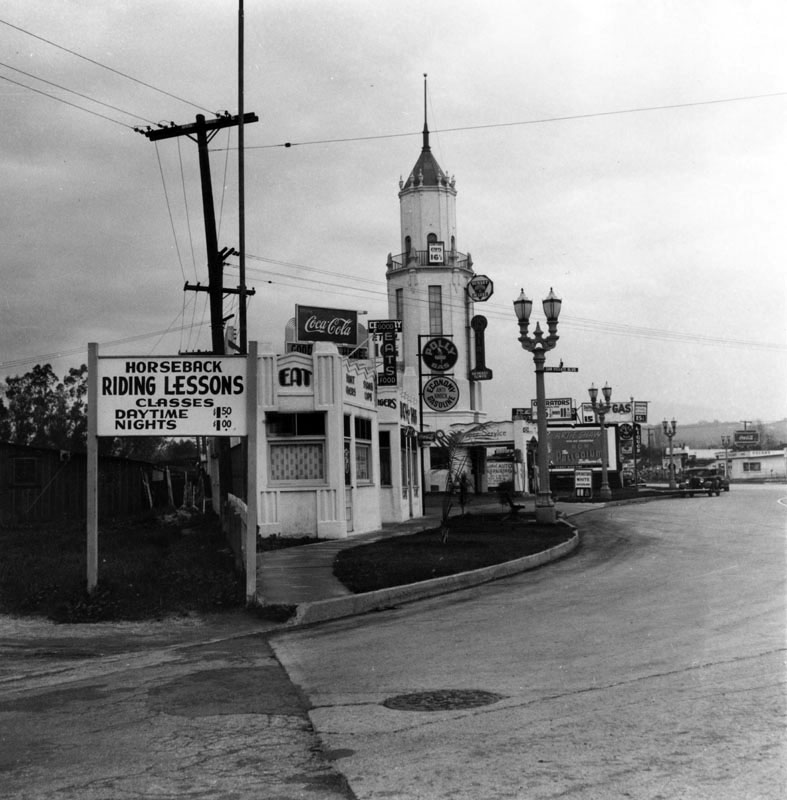 |
|
| (ca. 1940)^ - View of a section of San Vicente Boulevard, showing some Art Deco buildings. In the background is the Beverly Tower, which is a service station, next to that, in the center of the image, is a little eatery. A painted wooden sign on the left advertises horseback riding lessons. |
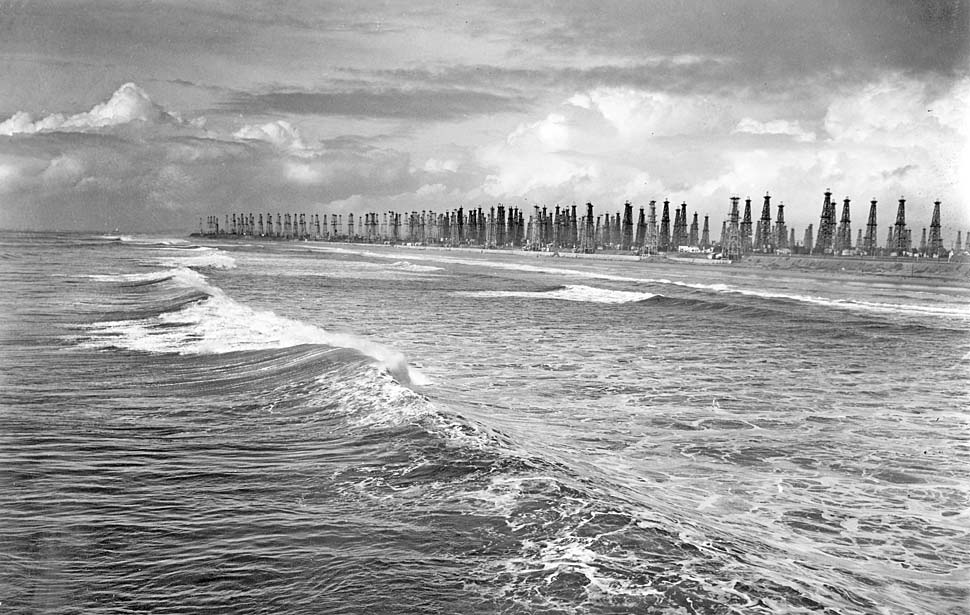 |
|
| (1940)^^ - The Huntington Beach coastline was a forest of oil derricks in 1940. Oil discoveries in Huntington Beach, Long Beach and Santa Fe Springs in 1920 and 1921 drove massive drilling. |
Historical Notes Ever since the legendary oil tycoon Edward L. Doheny and his partner, Charles A. Canfield, struck oil northwest of downtown Los Angeles in 1892, extracting petroleum from the land beneath Southern California has been a major part of the Southern California economy and its landscape. That included the beach areas as well.^^^* |
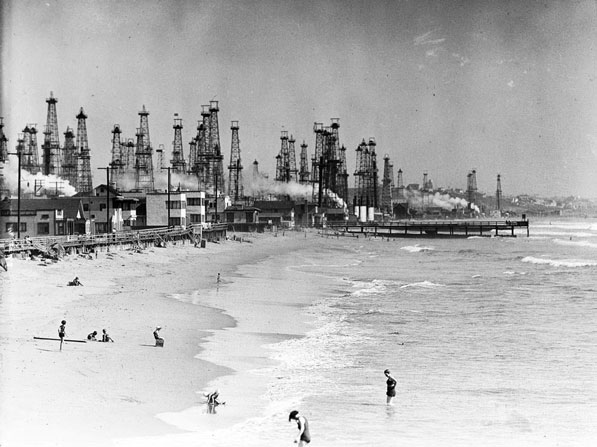 |
|
| (ca. 1930s)*# - People frolic along the Playa del Rey beach, the skyline dominated by oil derricks. |
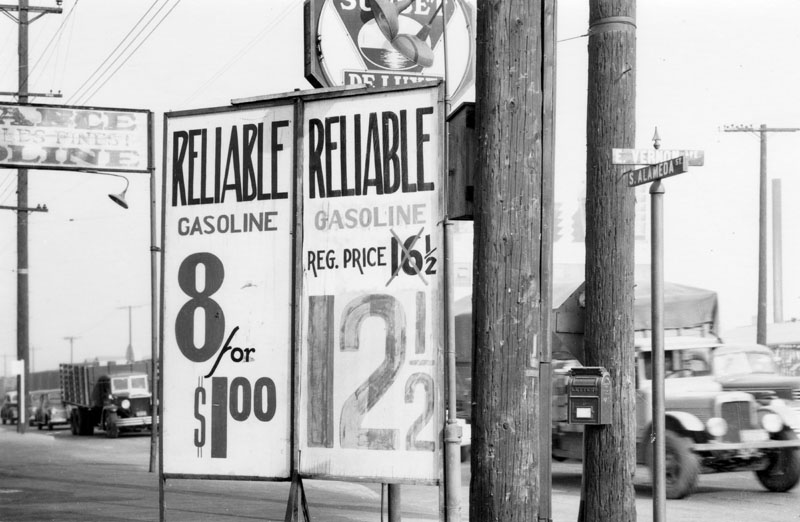 |
|
| (1941)^ - Postcard view shows gas prices advertised at the service station. 8 Gallons for $1 with full service! Click HERE to see more Early Views of LA Gas Stations. |
Santa Monica and Beverly Glen Blvds.
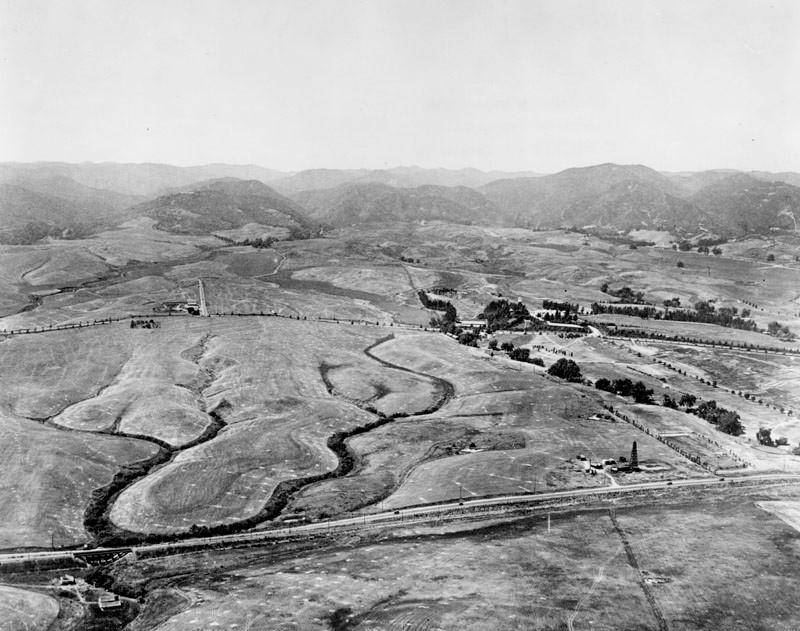 |
|
| (1922)^ - Aerial view of Westwood and surrounding area looking north. Santa Monica Boulevard runs horizontally at bottom of photo while a tree-lined Wilshire Boulevard runs from left to right at center. Beverly Glen, not yet constructed here, will run from lower-left, under Santa Monica Boulevard bridge, up north to the Wolfskill ranch house (seen at center-left) on Wilshire Boulevard. |
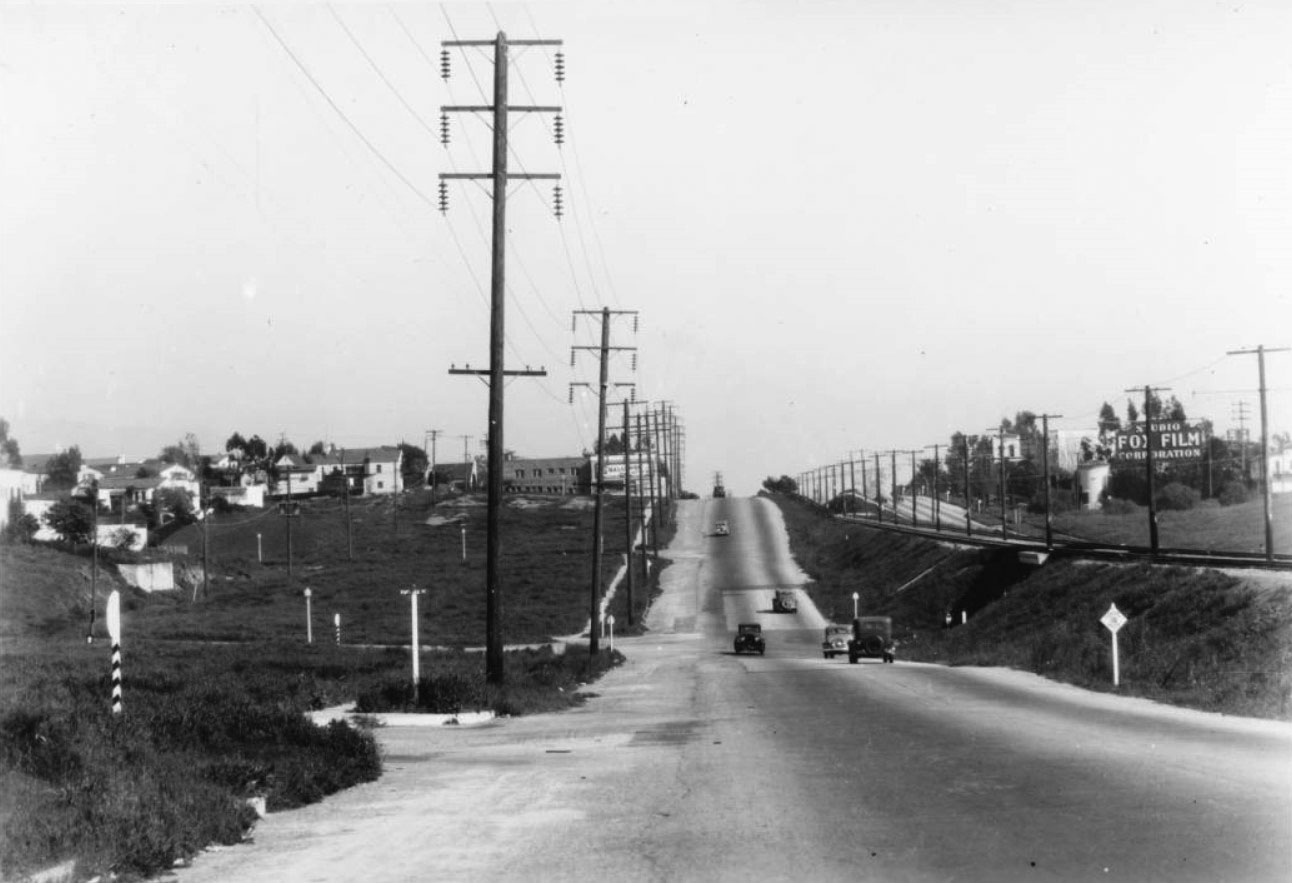 |
|
| (1935)*# – View of Big Santa Monica Boulevard looking east from Pandora Avenue before widening and paving. This eastward view of Big Santa Monica Boulevard shows the intersection with and the railroad bridge over South Beverly Glen Boulevard. The "Fox Films" sign is placed on Little Santa Monica Boulevard at about Fox Hills Drive. |
Then and Now
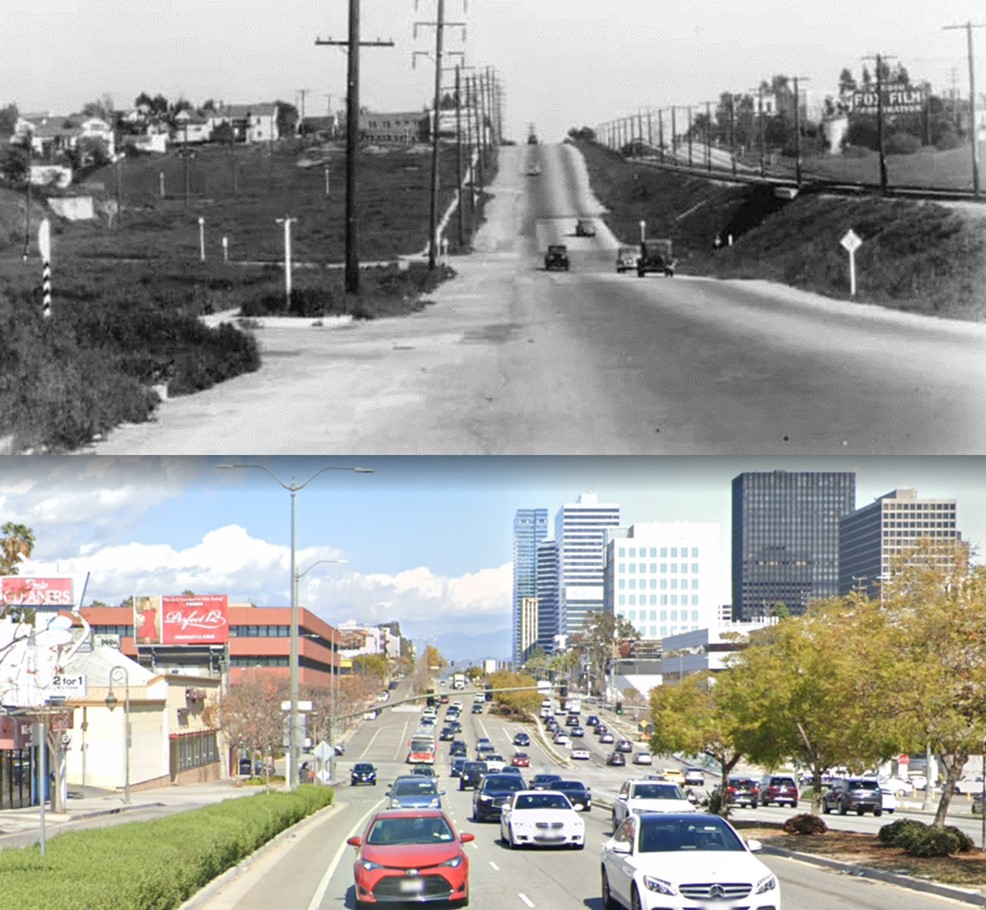 |
|
| (1935 vs. 2021) - Looking East on Santa Monica Blvd toward Beverly Glen. |
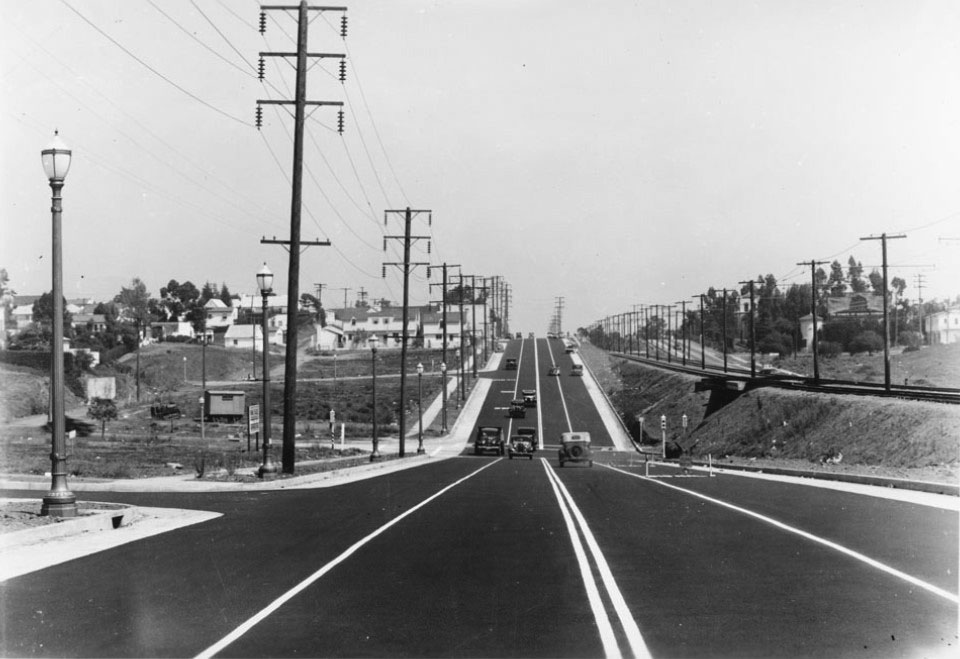 |
|
| (1937)*# - View of Santa Monica Boulevard looking east from Pandora Avenue after widening and paving. Pacific Electric tracks are on the right between Big Santa Monica and Little Santa Monica. |
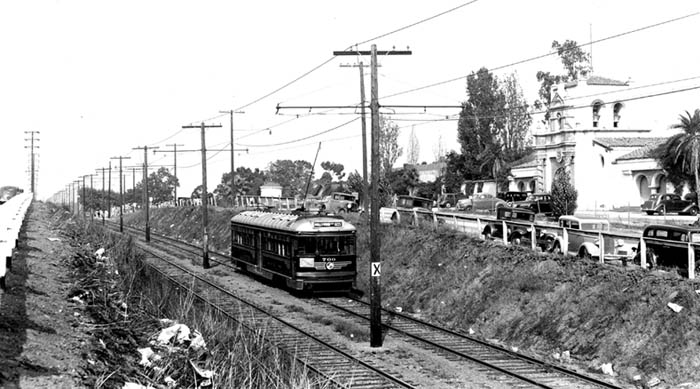 |
|
| (1941)**#* - Inbound Pacific Electric train is passing the 20th Century Fox "ranch" in 1941. This site is just west of the Beverly Hills city limit. Santa Monica Boulevard is on the left of photo and "Little" Santa Monica is on the right. |
Historical Notes In the 1930s the Santa Monica via Beverly Hills line had the highest patronage of any inter-city or suburban line of the Pacific Electric Railway. Yet it was converted to bus operation in 1941, unlike the various PE suburban lines that survived World War II.**#* The 20th Century Fox Studio was formerly Tom Mix's ranch. |
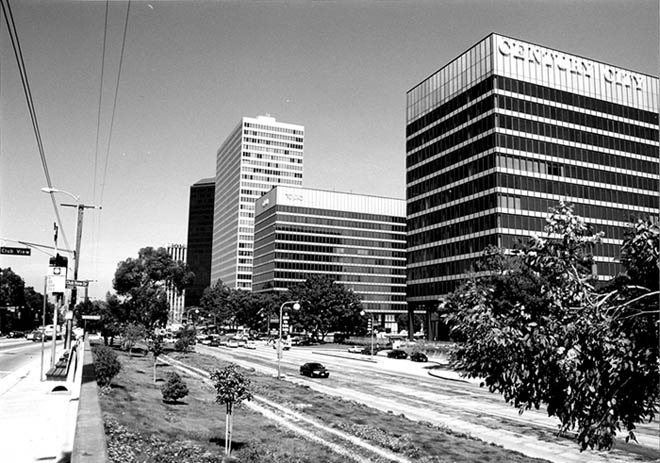 |
|
| (1999)**#* - Same view as previous photo but 58 years later. Century City's 9 million square feet of office space was built on the "ranch" site in the late '60s |
Historical Notes Once a backlot of 20th Century Fox, which still has its headquarters just to the southwest, the Fox studio commissioned a master-plan development from Welton Becket Associates, which was unveiled at a major press event on the "western" backlot in 1957. In 1961, after Fox suffered a string of expensive flops, culminating with the financial strain put on the studio by the very expensive production of Cleopatra, the film studio sold about 180 acres to developer William Zeckendorf and Aluminum Co. of America, also known as Alcoa. The new owners conceived Century City as "a city within a city." In 1963, the first building, Century City Gateway West, was complete, followed the next year by Minoru Yamasaki's Century Plaza Hotel.^* |
Then and Now (1941 vs. 1999)
 |
 |
|
* * * * * |
Downtown LA
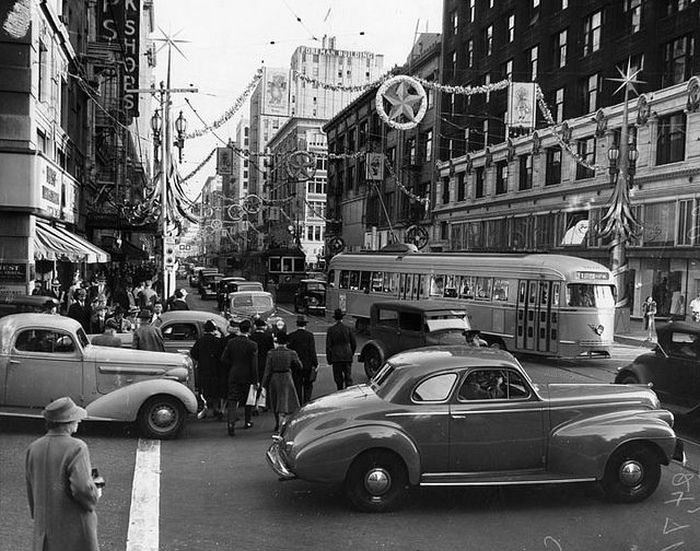 |
|
| (1940)^ - View of the intersection of Grand Avenue (foreground) and Seventh Street, which has been decorated for the Christmas season. Pedestrians, cars and Yellow Cars fill up Seventh Street, one of the most prominent streets in downtown. A police officer is seen talking to the driver of a coupe stopped within the busy intersection. |
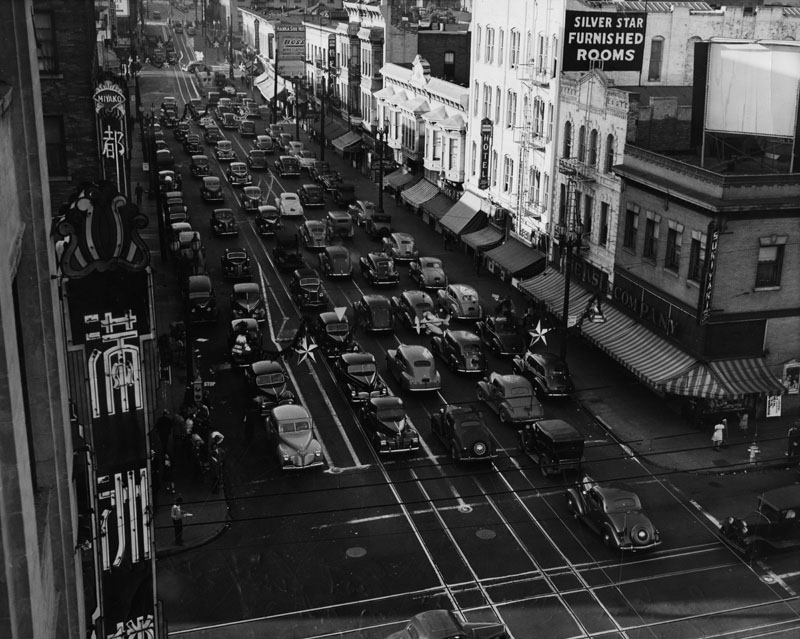 |
|
| (1941)^ - View of East 1st Street in Little Tokyo. Businesses such as: Sukiyaki, the Nelson Hotel, Chop Suey Cafe, Nanka Shu Hotel, Hori Bros. and the Rainier Cafe are visible throughout the image. Automobile traffic has clogged the street, on which a Pacific Electric streetcar is shown traveling in the background. Photo dated: December 8, 1941. |
Historical Notes The photo above was taken one day after Imperial Japan's attack on Pearl Harbor. On February 19, 1942, President Franklin D. Roosevelt authorized the internment of Japanese Americans with Executive Order 9066. Shortly thereafter, the Little Tokyo area was emptied.^* |
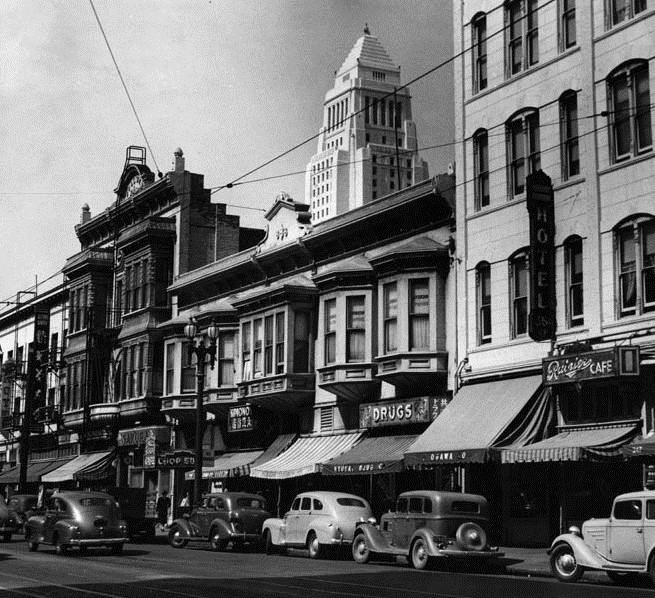 |
|
| (1942)^ - View of the north side of East 1st Street, which will soon be empty as Mayor Bowron reported the evacuation plan for Little Tokyo residents. City Hall hovers in the background and some businesses, such as the Nelson Hotel, Chop Suey Cafe, Nanka Shu Hotel, Hori Bros. and the Rainier Cafe, are visible on the street, which reveals various cars and some Pacific Electric streetcar tracks. Photograph dated March 21, 1942. |
Historical Notes The full caption for this photograph reads: Los Angeles, California. Street scene in "Little Tokyo" near the Los Angeles Civic Center, prior to evacuation of residents of Japanese ancestry. Evacuees will be assigned to War Relocation Authority centers for the duration. |
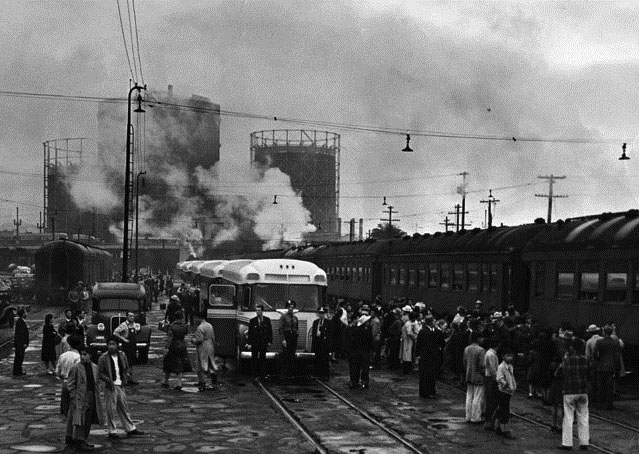 |
|
| (1942)^ - View showing Japanese men, women and children boarding trains and buses as they started their journey at the old Santa Fe station to Manzanar Internment Camp in Owens Valley. |
Historical Notes The Japanese American internment during World War II affected about 110,000 people of Japanese heritage who lived on the Pacific coast of the United States. The U.S. government ordered the internment in 1942, shortly after Imperial Japan's attack on Pearl Harbor. The internment of Japanese Americans was applied unequally as a geographic matter: all who lived on the West Coast were interned, while in Hawaii, where 150,000-plus Japanese Americans comprised over one-third of the population, only 1,200 to 1,800 were interned. Sixty-two percent of the internees were American citizens.^* |
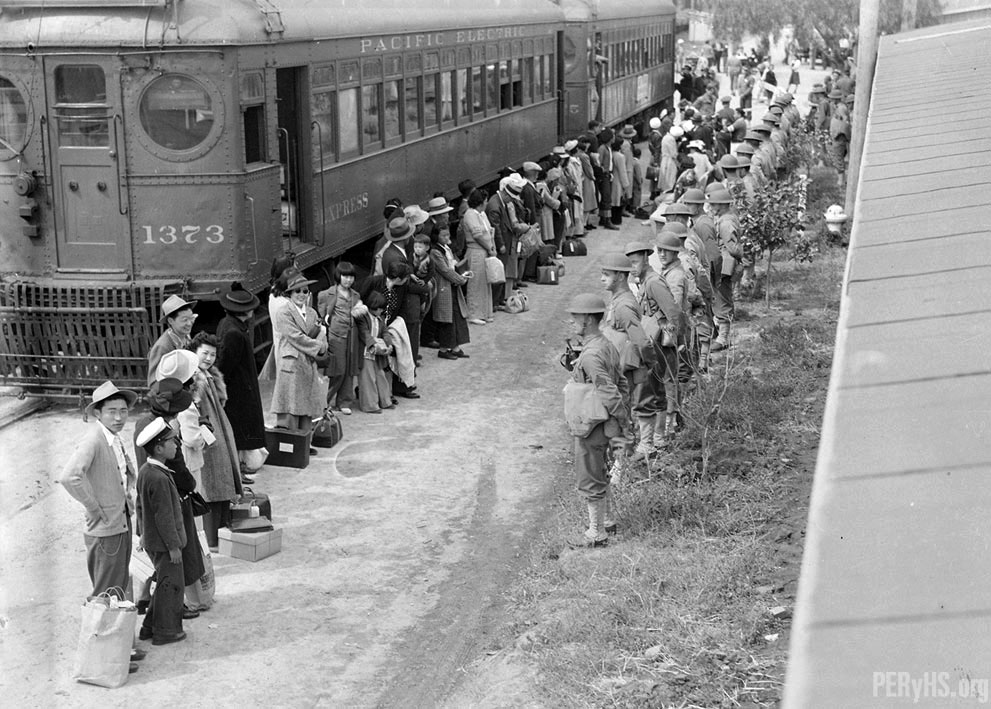 |
|
| (ca. 1942)*#^ - Japanese Americans arrive at the Internment staging center at the Santa Anita Park racetrack. |
Historical Notes In 1988, Congress passed and President Ronald Reagan signed legislation that apologized for the internment on behalf of the U.S. government. The legislation said that government actions were based on "race prejudice, war hysteria, and a failure of political leadership". The U.S. government eventually disbursed more than $1.6 billion in reparations to Japanese Americans who had been interned and their heirs.^* |
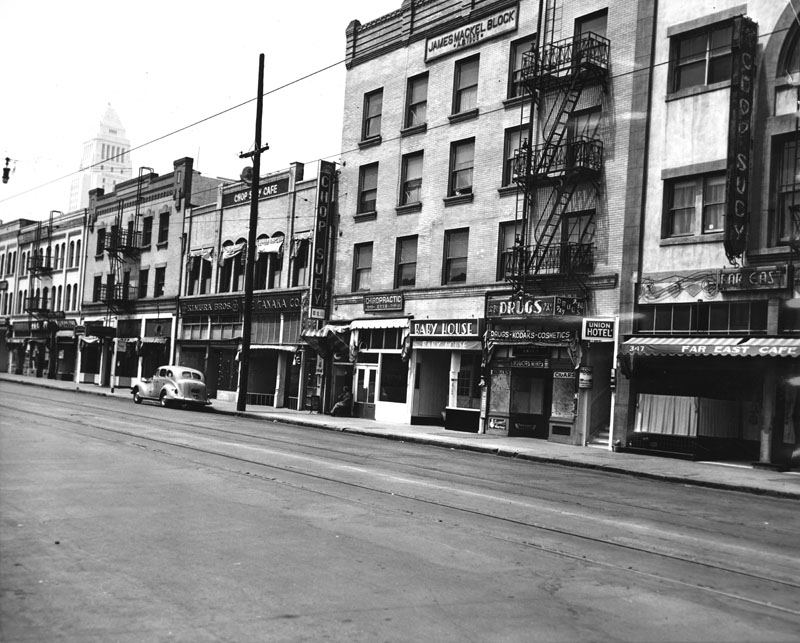 |
|
| (1942)^ - Vacant and deserted business houses along 1st Street after the evacuation of Japanese people during World War II. |
Historical Notes For a brief time, the area became known as Bronzeville as African Americans and also Native Americans moved into the vacated properties and opened up nightclubs and restaurants. After the internment ended, the Bronzeville residents mainly moved to other areas. After the war, due to lack of housing in Little Tokyo, Japanese Americans returning from the camps moved into areas surrounding the downtown, into apartments and boarding houses. Notably, Boyle Heights, just east of Little Tokyo, had a large Japanese American population in the 1950s (as it had before the internment) until the arrival of Mexican and Latino immigrants replaced most of them.^* |
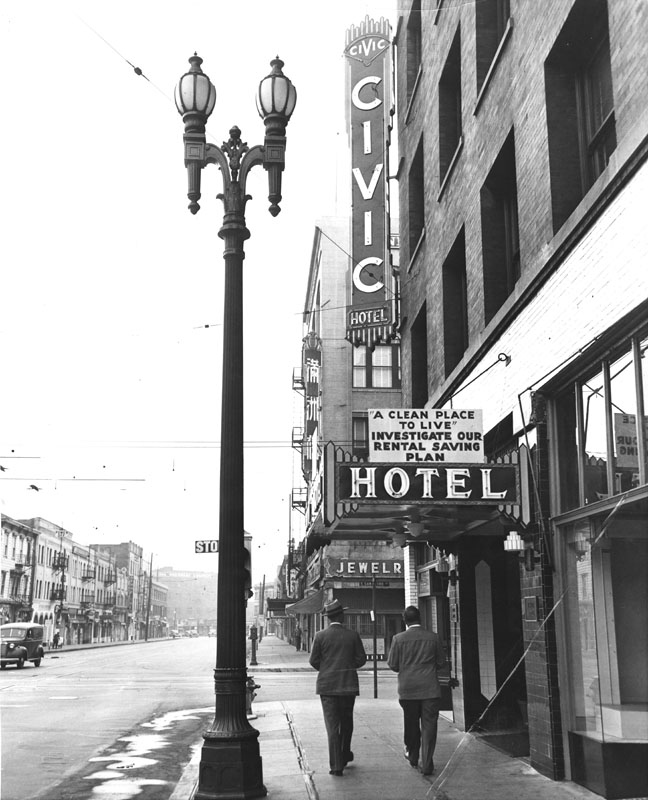 |
|
| (1942)^ - View of the once busy life of Little Tokyo is contrasted by this scene of a quiet street corner at 1st and San Pedro streets on June 17, 1942, following the Japanese evacuation. In the foreground is the newly-named Civic Hotel, formerly the Miyako Hotel, once a "reputed center of Japanese intrigue in Southern California." |
Historical Notes In the late 1970s, a redevelopment movement started in Little Tokyo as Japanese corporations expanded overseas operations and many of them set up their US headquarters in the Los Angeles area. Several new shopping plazas and hotels opened, along with branches of some major Japanese banks. Although this redevelopment resulted in many new buildings and shopping centers, there are still some of the original Little Tokyo buildings and restaurants, especially along First Street.^* |
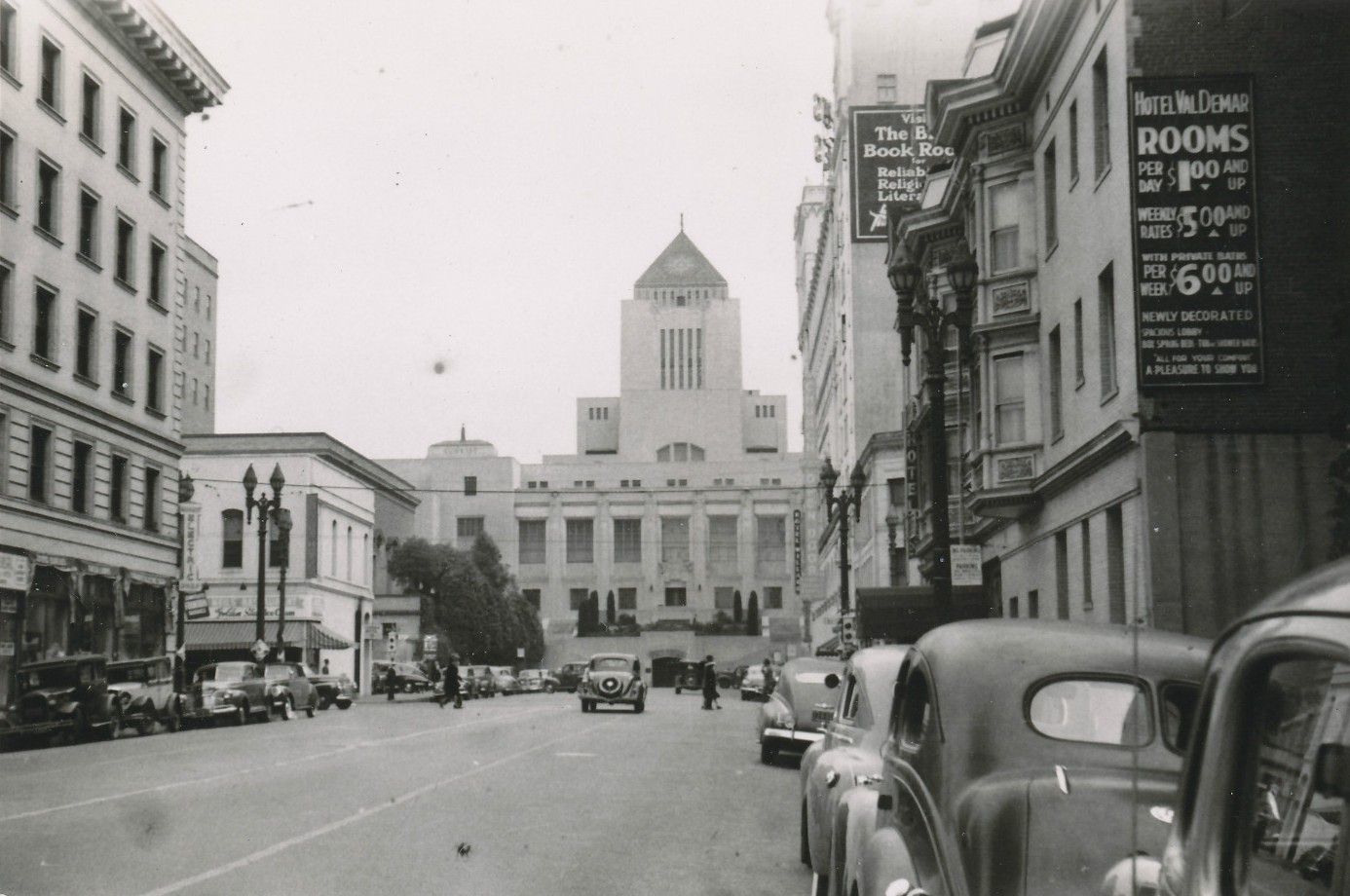 |
|
| (1943)**^ - View looking north up the 500 block of S. Hope Street towards the rear of the Central Library. The sign on the upper right indicates that rooms rates at the Hotel Val Demar are: $1 per day or $5 per week. North of the hotel is the Bible Institute (Church of the Open Door). |
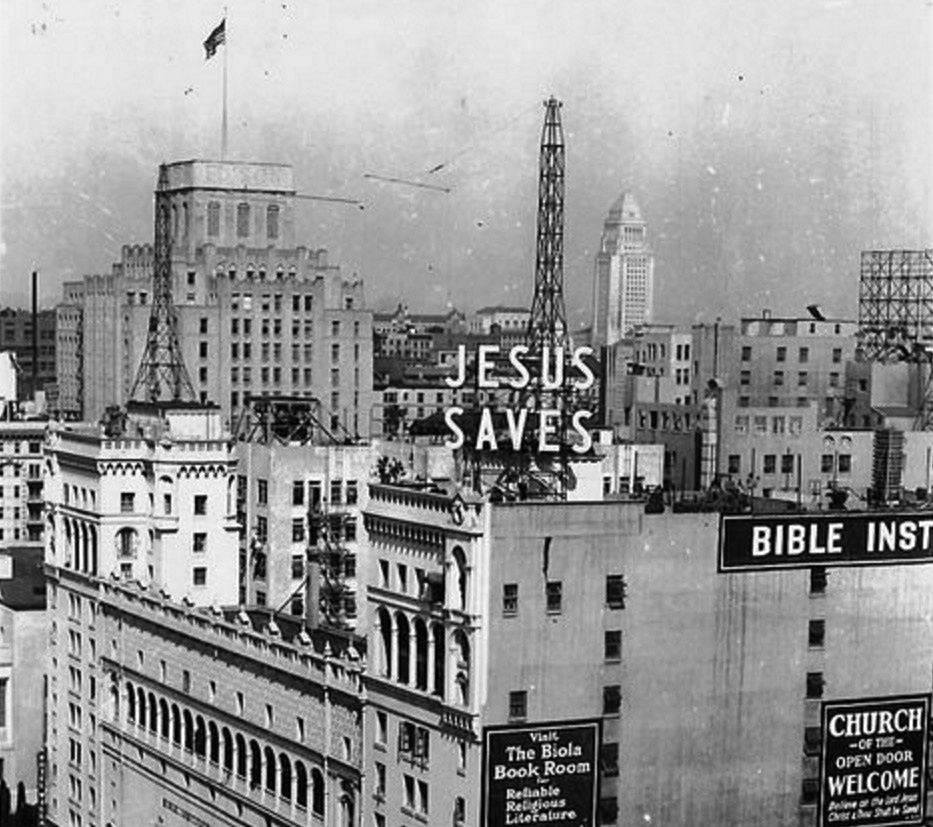 |
|
| (1940s)##+ – Rooftop view looking northeast showing the Bible Institute from the corner of Hope and 6th streets. In the distance can be seen the Edison Building (top left) and City Hall (top center-right). Note the two radio towers on top of the Bible Institute building. |
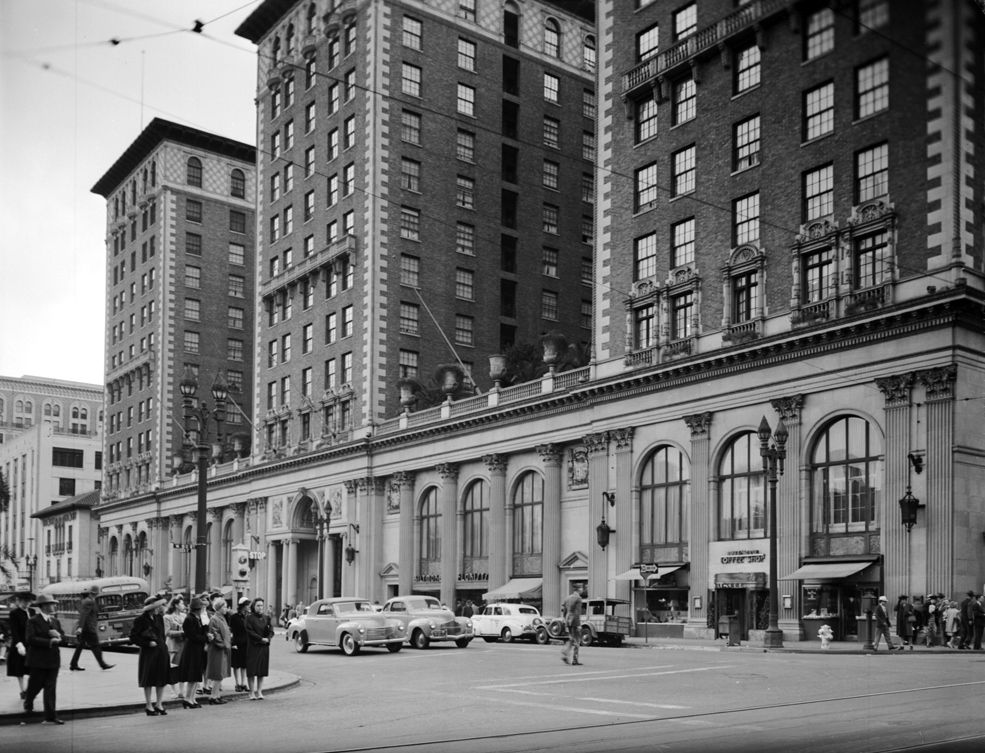 |
|
| (1943)*# - View of the Biltmore Hotel from the corner of Olive and 5th Streets. A man is seen crossing the street toward the hotel while other pedestrians are waiting for the light to change. Notice that the top of the streetlights are blacked-out (during WWII). Click HERE to see more in Early L.A. Streetlights. |
Historical Notes Upon its grand opening in 1923, the Los Angeles Biltmore was the largest hotel west of Chicago, Illinois in the United States. In 1969 the Biltmore Hotel was designated a Los Angeles Historic-Cultural Monument No. 60 by the City of Los Angeles. Click HERE to see the LA Historic-Cultural Monument List. As of 2009, the Los Angeles Biltmore is operated as part of the Millennium & Copthorne Hotels chain as the Millennium Biltmore Hotel. From its original 1500 guestrooms it now has 683, due to room reorganization.^* |
* * * * * |
Main, Spring, and 9th Street Intersection
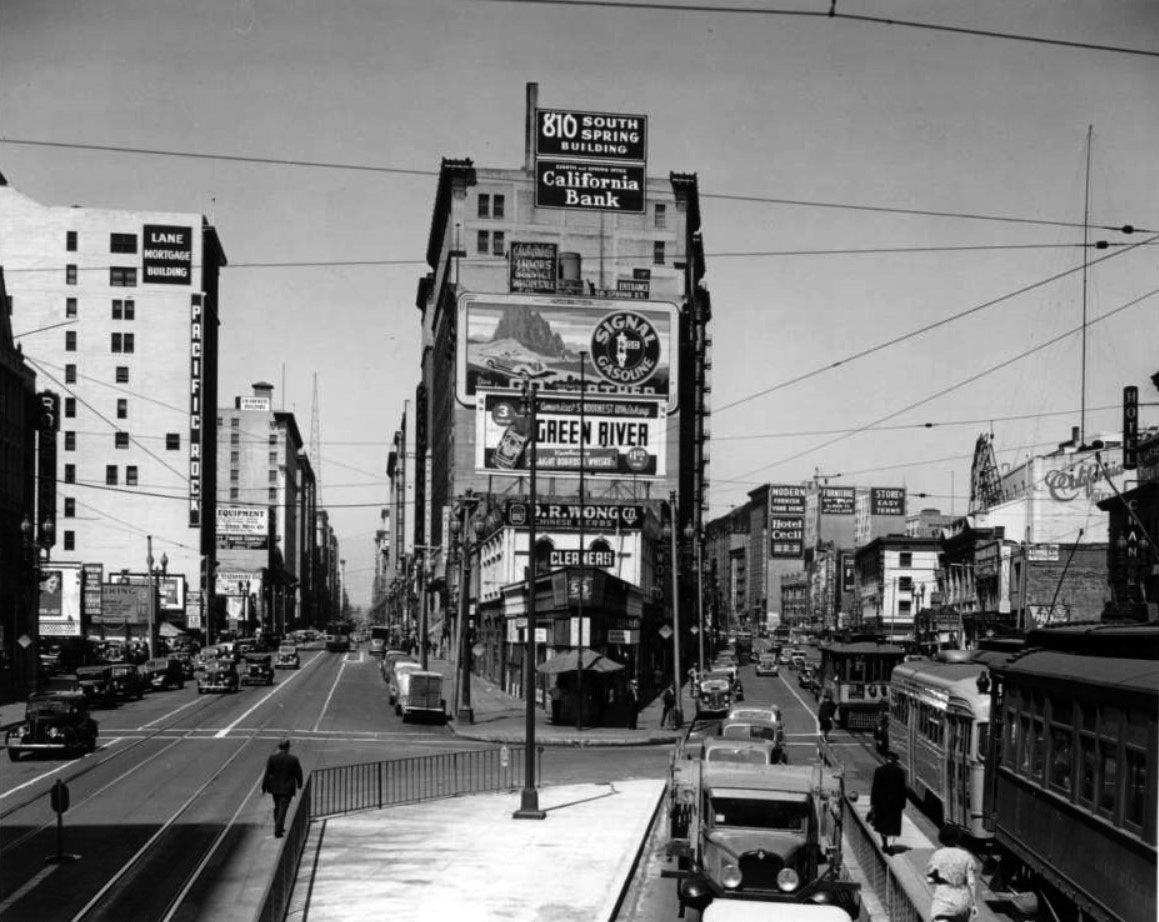 |
|
| (1938)^^ - Looking north at the point at which Main Street and Spring Street separate as LARy trolley cars and cars clutter the street. Note the island on the right. It enabled passengers to board the streetcars more safely. |
Historical Notes The Los Angeles Railway (LARy), was a system of streetcars in Los Angeles between 1895 and 1945. It operated on 3 foot, 6 inch (1,067 mm) narrow-gauge tracks and connected the city center to neighborhoods in about a six-mile radius of downtown. There were about 642 miles of track at its peak in 1924. The system was informally known as the “Yellow Cars,” similar to the Pacific Electric Railway’s “Red Cars” which served more outlying areas. |
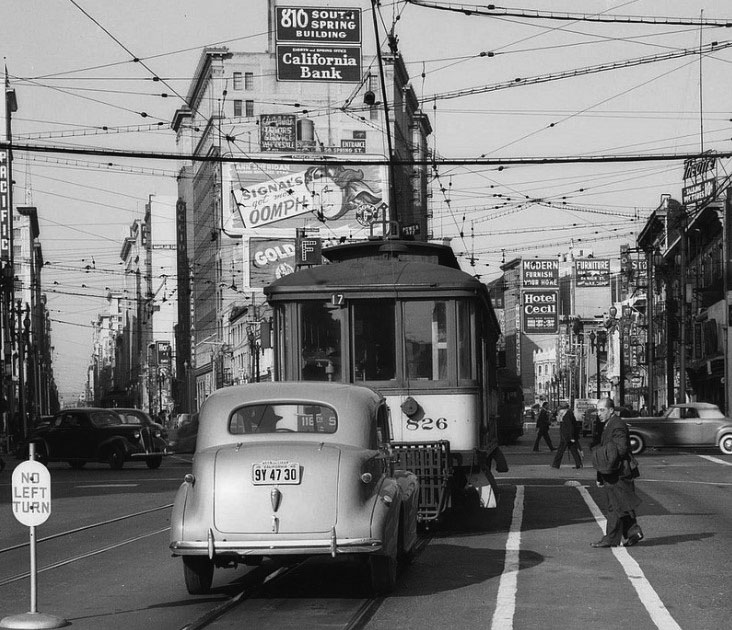 |
|
| (1939)* – View looking north on Main Street at 9th and Spring Streets. The 810 South Spring Building is straight ahead with the Hotel Cecil on the right. In the foreground can be seen a car closely following a streetcar as several pedestrians are in the middle of the intersection. |
Historical Notes In the background is Signal's "oomph" billboard with the lady herself, Ann Sheridan. Note how crowded the sky is with wires here. |
.jpg) |
|
| (1939)^^ - Main Street looking north at Ninth Street. Signs for 810 South Spring Street, Hotel Hampshire, Hotel Cecil, Hotel Chandler can be seen. |
Historical Notes This intersection had so much potential to become an iconic public space in LA, just as Latham Square is in Oakland, or Times Square is in Manhattan. But….that never materialized. |
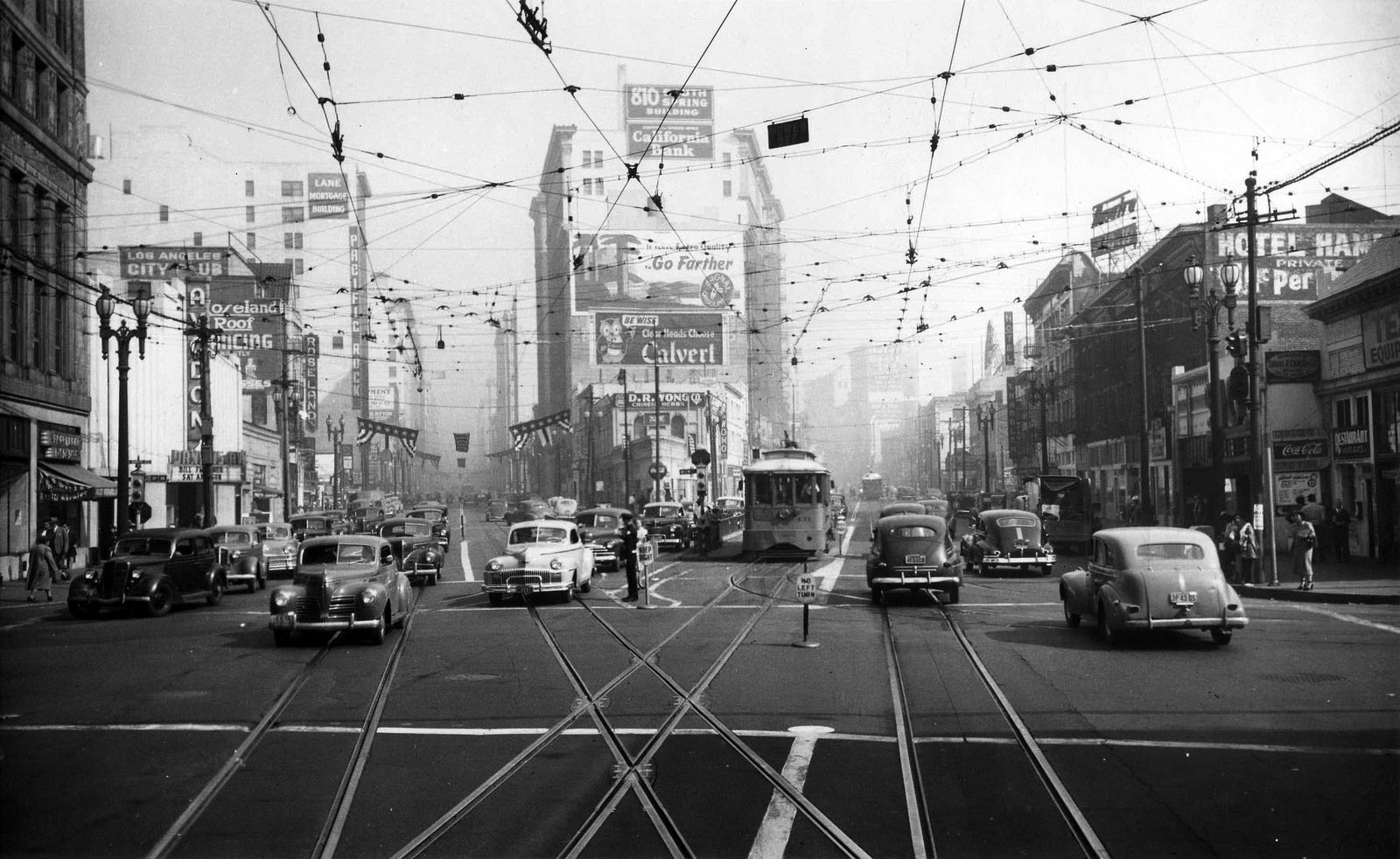 |
|
| (1948)**^ - Intersection of Main, Spring, and 9th streets looking north in downtown Los Angeles. A traffic officer can be seen standing in the middle of the busy intersection. |
Historical Notes Once considered the "Times Square" of Los Angeles, the junction of Main, Spring, and 9th streets was one of the most photographed intersections in Downtown LA. Click HERE to see more Early Views of the Main, Spring, and 9th Streets Intersection. |
Main and 7th Street
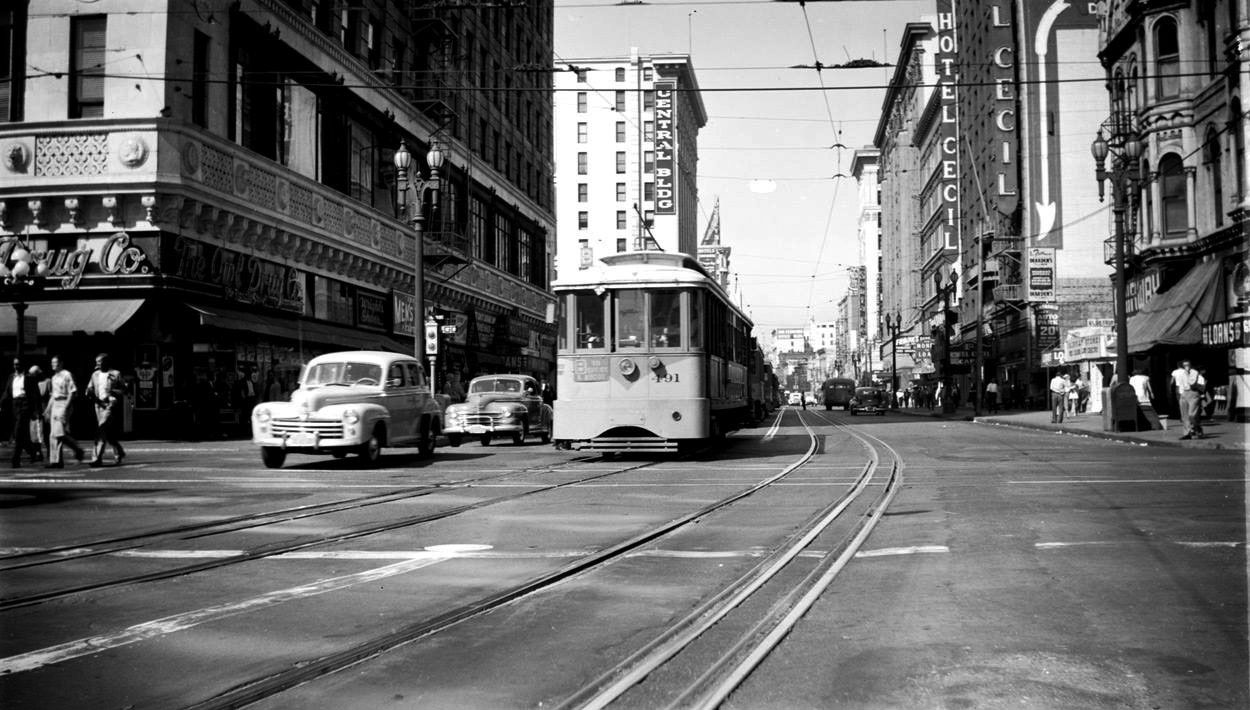 |
|
| (1948)* – View looking north on Main Street from 7th Street with the Hotel Cecil (640 S. Main St.) seen on the right. |
Rainy Days in Early LA
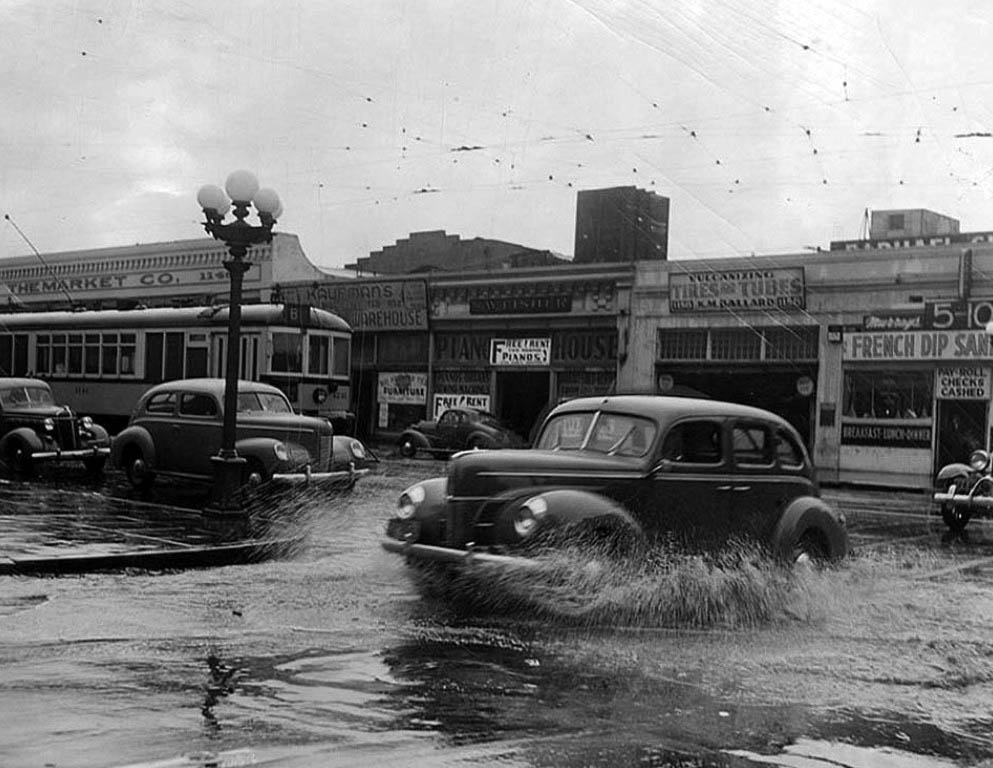 |
|
| (1940)^ - View showing a car driving through the water in the intersection of 12th and Main Streets on December 16, 1940. |
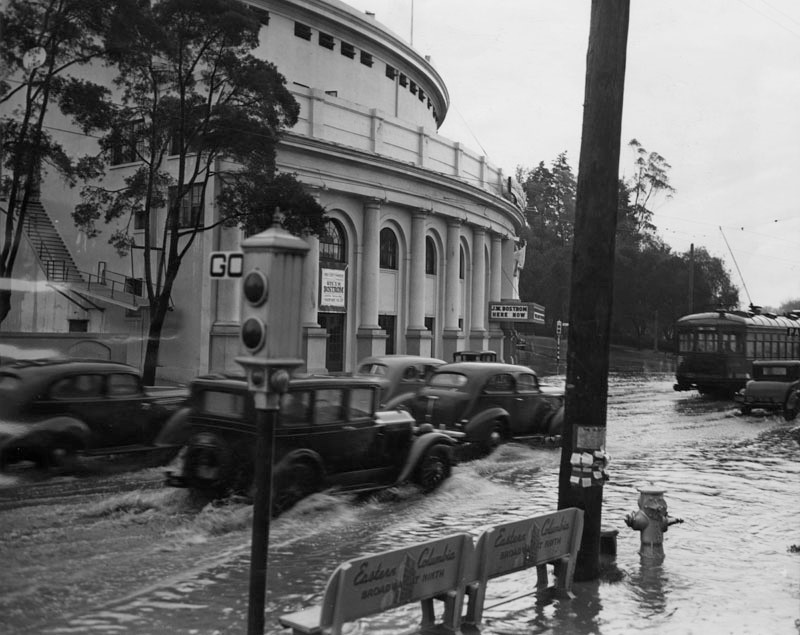 |
|
| (1940)^ - Cars are shown sloshing through the flooded street in front of Angelus Temple in Echo Park on February 1, 1940. Streets in a number of parts of the city were flooded. |
Historical Notes Click HERE to see more images of Flooding in Early Los Angeles (1925+). |
* * * * * |
Echo Park
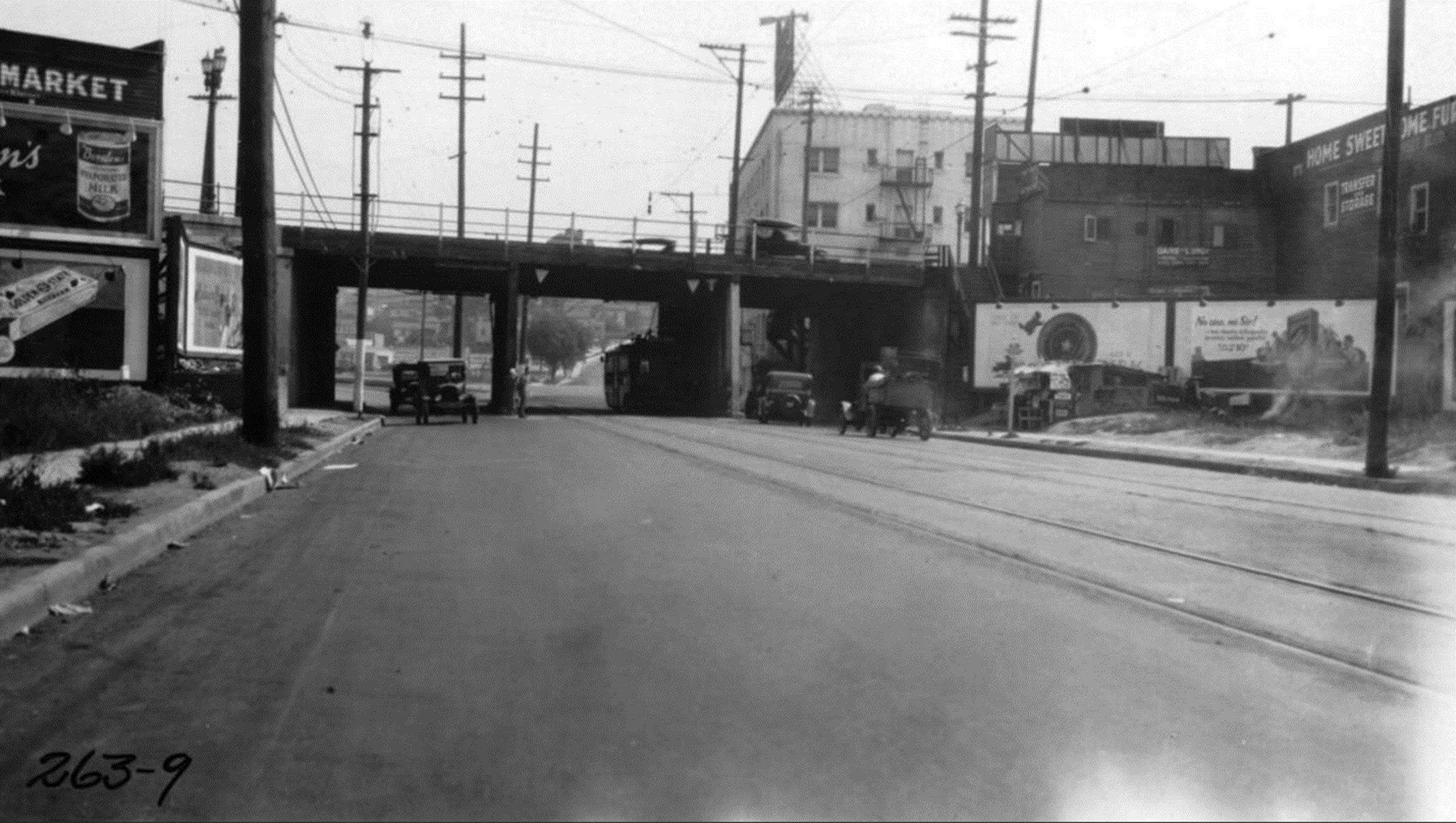 |
|
| (1925)* – A view of the Sunset Boulevard viaduct over Glendale Boulevard, with a streetcar visible passing beneath the overpass. |
Historical Notes The Pacific Electric Red Car line along Glendale Boulevard in Echo Park was a vital part of Los Angeles’s early 20th-century transportation network. Originally developed by L.C. Brand in 1902 as the Los Angeles & Glendale Electric Railway, it was soon acquired by Henry E. Huntington’s Los Angeles Inter-Urban Railway in 1904 and integrated into the larger Pacific Electric Railway, renowned for its Red Cars. The Glendale-Burbank Line connected downtown Los Angeles to the growing suburbs of Glendale and Burbank, featuring a private right-of-way through the scenic Ivanhoe Hills and crossing the Los Angeles River on notable structures like the Fletcher Viaduct, which was replaced by a steel bridge in 1928, standing 60 feet above Fletcher Drive. |
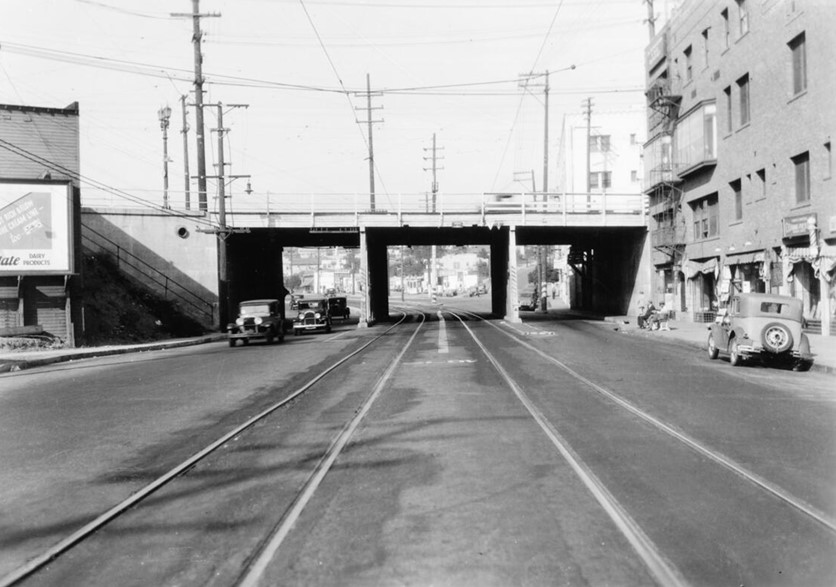 |
|
| (1934)* - View of the Sunset Boulevard overpass on Glendale Boulevard before reconstruction, with a paved road and streetcar tracks extending from the foreground into the background, April 7, 1934. Two walls support the center of the overpass, forming three small tunnels for automobiles to pass through. |
Historical Notes In the 1930s, the Sunset Boulevard Viaduct over Glendale Boulevard in Echo Park was reconstructed to support increased automobile traffic. The project replaced the original structure with a more durable, reinforced concrete bridge, accommodating both the Red Car line beneath and wider lanes for cars above. This upgrade was part of Los Angeles's shift from streetcar to automobile transportation. |
.jpg) |
|
| (1934)* - View of the Sunset Boulevard overpass on Glendale Boulevard after reconstruction, with a streetcar passing beneath, October 4, 1934. |
Historical Notes A unique feature of Glendale Boulevard PE line was the three-track section beneath the Sunset Boulevard Viaduct, allowing express trains to bypass local ones and improving operational efficiency. The viaduct, also known as the Sunset Boulevard Bridge, spanned Glendale Boulevard, enabling traffic to flow overhead while Red Cars passed underneath. This area, with its scenic route through the Ivanhoe Hills, became an important link for commuters between the city and its suburbs, especially after the downtown terminus moved to the Subway Terminal in 1925 and the introduction of modern PCC streetcars in 1940. |
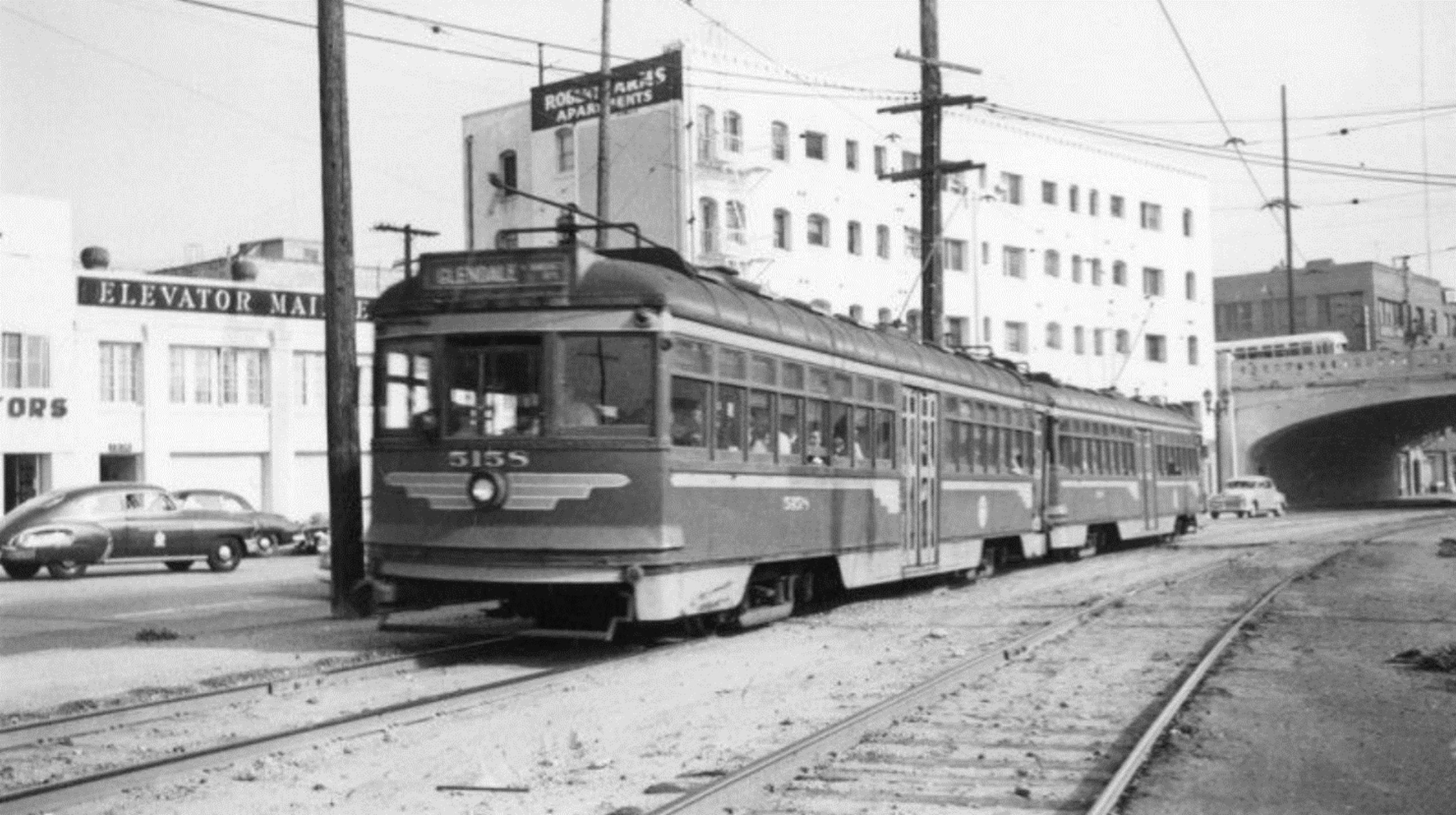 |
|
| (ca. 1950)* – Pacific Electric train on Glendale Boulevard, looking south toward the Sunset Boulevard Bridge. |
Historical Notes Multiple Pacific Electric streetcars connected together are typically called a "Red Car train" or a "Pacific Electric train." The railroad term "consist" is also used to describe this configuration. These cars are joined using couplers, allowing the system to adjust capacity by adding or removing cars as needed. This flexible arrangement enabled Pacific Electric to efficiently manage passenger loads during varying levels of demand. |
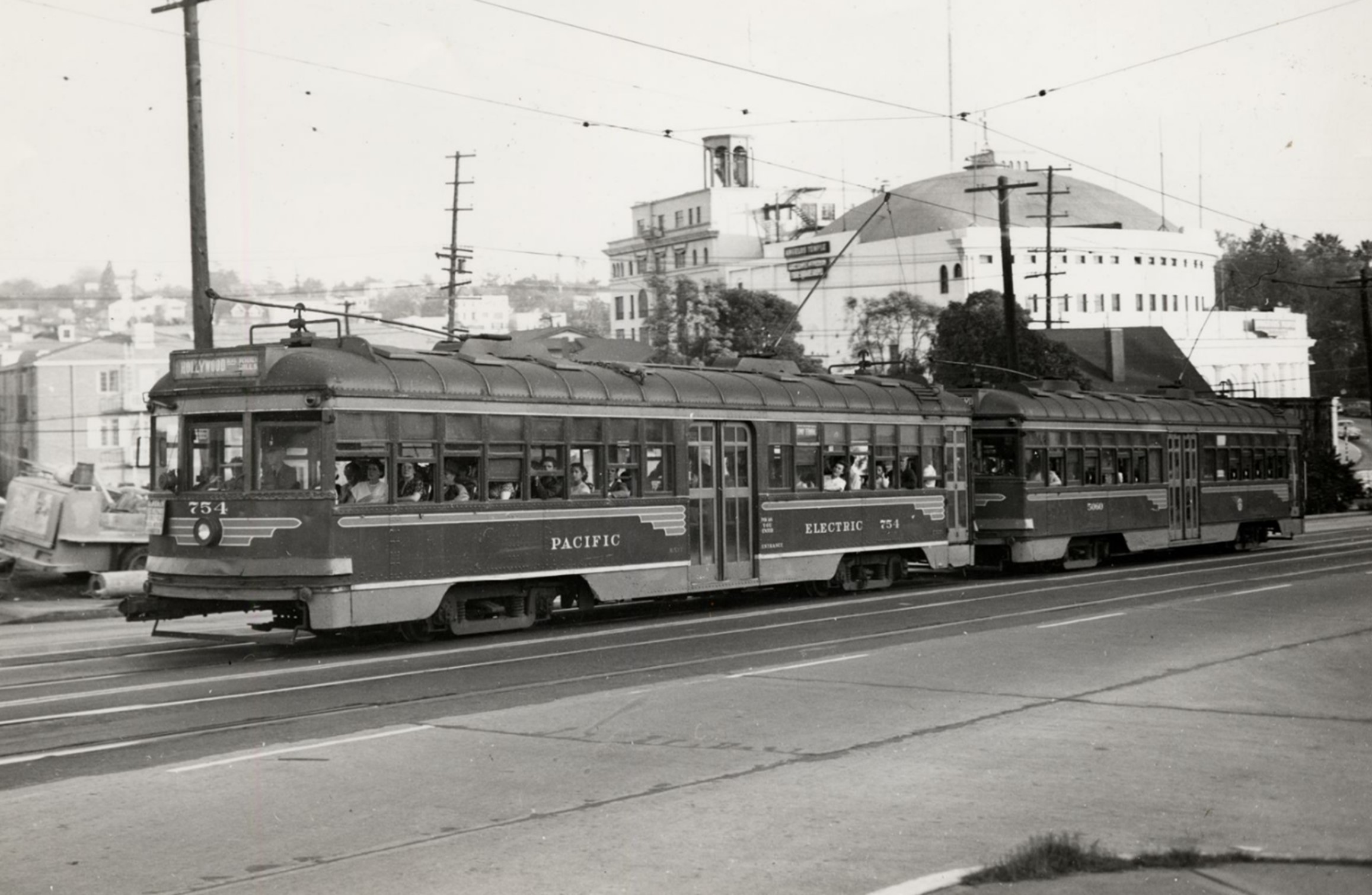 |
|
| (1950)* – Side view of two connected Pacific Electric Railway cars with commuters, including car number 754 displaying 'Hollywood Blvd/Beverly Hills' on the front. The domed building of Angelus Temple at 1100 Glendale Boulevard is visible in the background on the right. |
Historical Notes The Pacific Electric Red Car line along Glendale Boulevard faced challenges during the Great Depression, leading to its eventual closure in 1955. Today, remnants such as bridge pylons, concrete footings, and the Sunset Boulevard Viaduct serve as lasting reminders of Los Angeles’s once-vast streetcar system. Echo Park and the surrounding areas continue to reflect the cultural evolution of the city, with the old Red Car routes still visible in the urban landscape. |
* * * * * |
Fairfax District
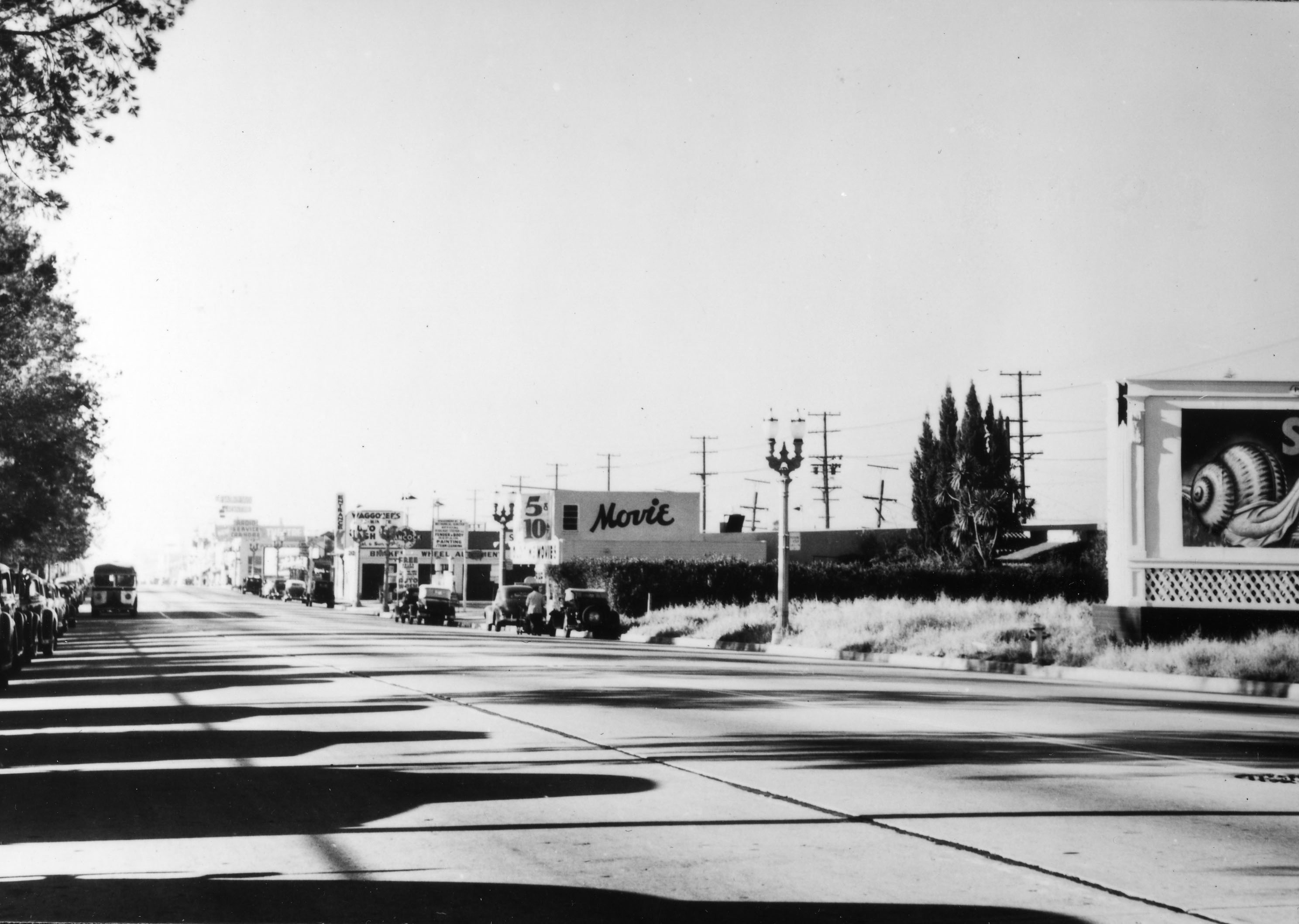 |
|
| (1940s)* - View looking south on Farifax Avenue from Melrose Avenue. The Silent Movie Theatre is one of the few buildings standing on the west side of Fairfax Ave. Fairfax High School is directly across the street from the theater. |
Historical Notes John Hampton and his brother Gilbert began collecting silent films when they were boys in Oklahoma City. Throughout the mid-1920’s, he and his brother held movie nights at their home for family and friends. In 1940, John Hampton and his wife Dorothy moved from Oklahoma to Los Angeles. A year later, they bought an empty lot on Fairfax Ave, near Melrose Ave. On this empty lot, Mr. Hampton built his version of an ideal theater – one with “staggered seating, bowl-shaped floor, acoustical sound, and silent pictures.” |
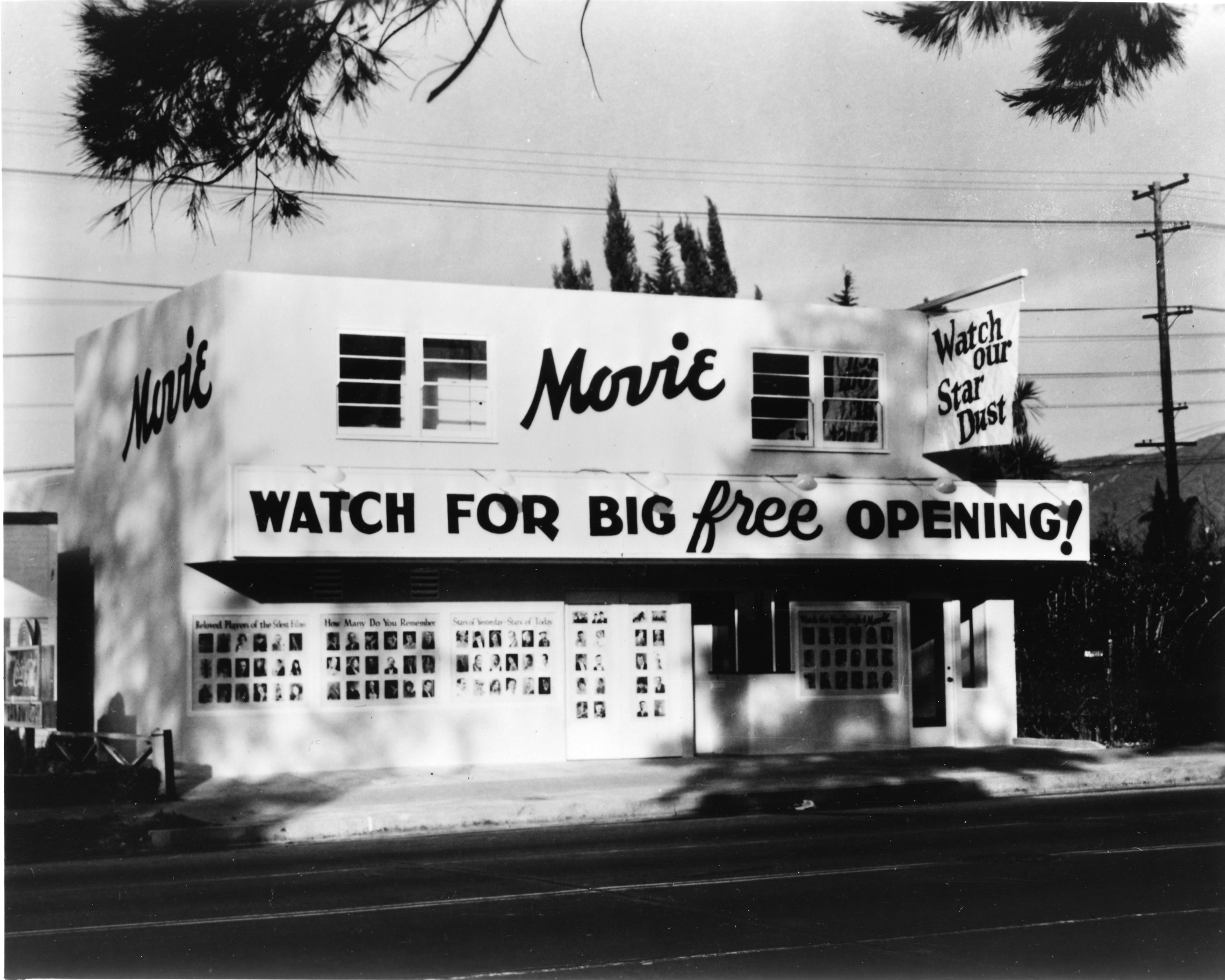 |
|
| (1942)* - View of the "Silent Movie Theatre" located at 611 N. Fairfax Avenue shortly before it opened. |
Historical Notes The theater opened for business in February, 1942. The marquee simply said “Old Time Movies” with “Movie” painted in script between the two windows on the upper floor. The theater had 250 seats. A child’s ticket cost five cents; an adult’s ticket cost ten cents. By the 1950’s, the theater’s audiences grew smaller as television’s popularity grew. Other silent film theaters folded while the Hamptons were able to keep their theater afloat until 1980 when they had to shut it down. The theater was to stay closed for the next ten years until after the death of Mr. Hampton. The theater reopened 1991 under new management and has since seen a sucession of owners. Today, the name of the theater remains “Silent Movie Theatre.” It is run by a non-profit organization aptly called “the Cinefamily” and has become the premier site for vintage and experimental film. |
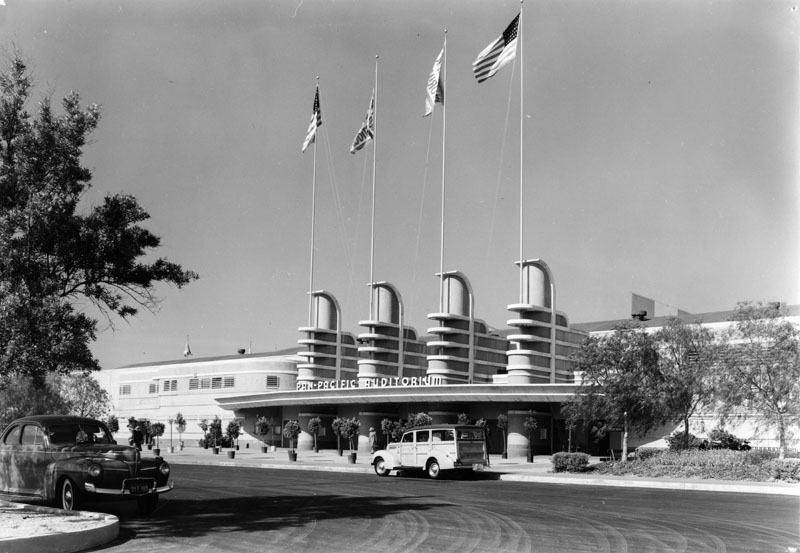 |
|
| (ca. 1937)^ - Exterior view of the Pan-Pacific Auditorium, located at 7600 Beverly Boulevard in the Fairfax district. |
Historical Notes The Pan-Pacific Auditorium opened on May 18, 1935. Its green and white western-facing 228 foot long facade featured four stylized towers and flagpoles meant to represent upswept aircraft fins above the entrance. With all the many Streamline Moderne houses and structures popping up in the 30s, many say the Pan Pacific Auditorium really was the single most famous Streamline Moderne building in Los Angeles. |
.jpg) |
|
| (ca. 1943)^ - Photo of the crowd outside for a Queen for a Day broadcasting, presented by the Mutual Broadcasting System. |
Historical Notes For 35 years, the Pan-Pacific Auditorium was home to a multitude of events, ranging from auto, boat and home shows to sporting events like hockey games, basketball (Harlem Globetrotters included), concerts, and political events like a dinner for Eisenhower and Nixon, and many more.^*^** |
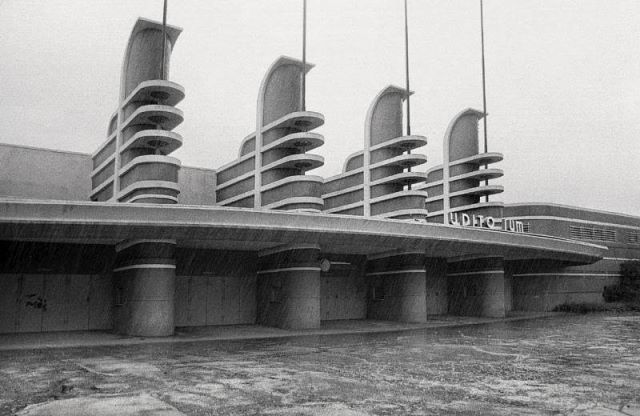 |
|
| (ca. 1970s)**^ - The Pan-Pacific Auditorium in its last days. |
Historical Notes In 1971, the Los Angeles Convention Center opened and essentially rendered the Pan-Pacific Auditorium utterly useless. By 1972, the Pan-Pacific Auditorium dwindled in use, and, after some small expos in the spring, finally shut its doors for good. It sat empty for many years until it burned down in 1989.^*^** Today, you can see a re-creation of the Pan-Pacific as the ticket office at Disney's California Adventures. Click HERE to see more early views of the Pan-Pacific Auditorium. |
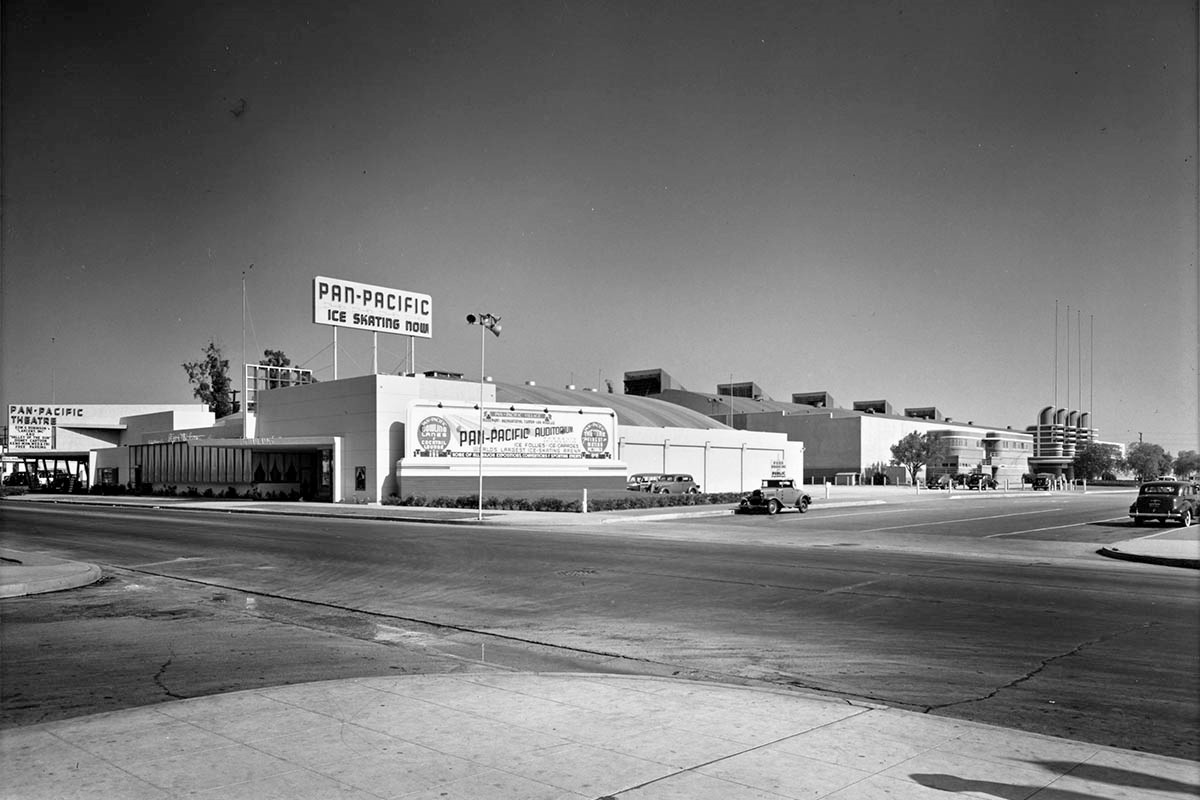 |
|
| (1942)*++ – View looking southeast as seen from the northwest corner of Beverly Boulevard and Sierra Bonita Avenue showing (left to right): the Pan-Pacific Theatre, Pan-Pacific Ice Skating Rink, and the Pan-Pacific Auditorium. |
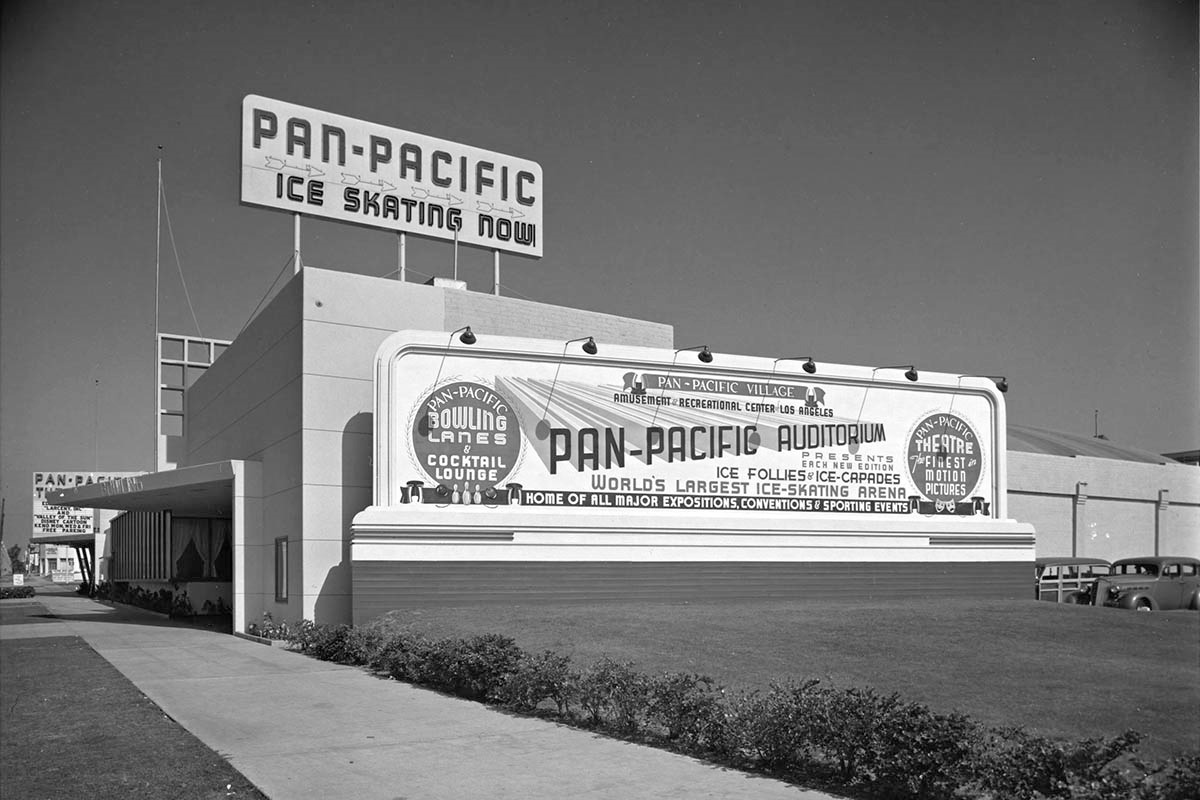 |
|
| (1942)*++ – View showing a large billboard sign located at 7600 Beverly Boulevard (S/E corner of Beverly and Sierra Bonita) advertising all the venues found at the Pan-Pacific Village including the Pan-Pacific Auditorium, Ice Follies & Ice-Capades at the World’s Largest Ice-Skating Arena, Bowling Lanes & Cocktail Lounge, Pan-Pacific Theatre, and Home of All Major Expositions, Conventions, & Sporting Events. |
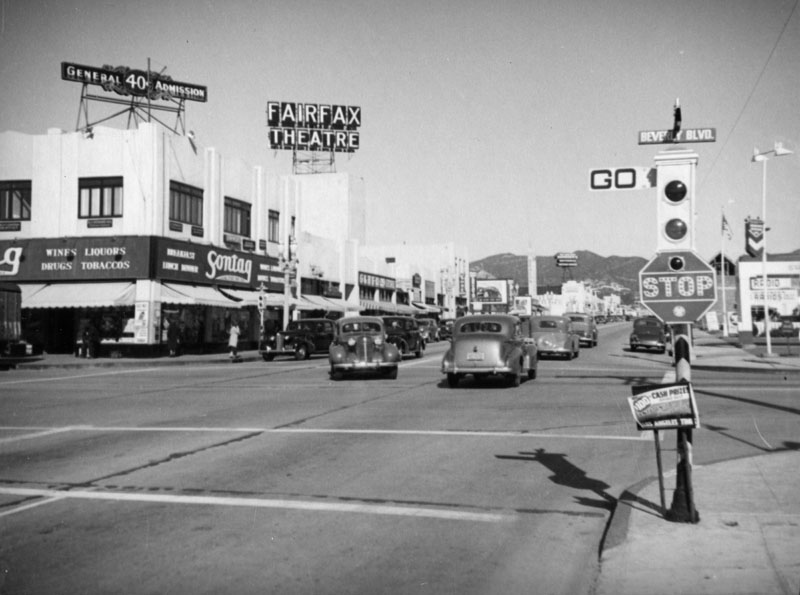 |
|
| (ca. 1945)^ - View of the intersection of Fairfax Avenue and Beverly Blvd. At left is the Sontag Drug Store, next to the Fairfax Theatre. |
Historical Notes Fairfax Avenue was named for Lord Fairfax of Colonial America. Beverly Boulevard was originally named Beverly Farms in 1921 after the Beverly Farms in Massachusetts, 25 miles north of Boston (Farms has since been dropped from its name). This is where President William Howard Taft vacationed in 1900. Burton Green, founder of Beverly Hills, decided that a good way to lure people to his city would be to name it after the resort of Presidents. In 1906 Green had a street named after himself--Burton Way.^*^ |
* * * * * |
Fairfax and Wilshire
 |
|
| (1939)+## – View looking northwest at the intersection of Fairfax and Wilshire. Photo was taken just before work started on the iconic May Company Building on the northeast corner. Across the street is Simon's Drive-in restaurant on the site that now has Johnies 50s diner. |
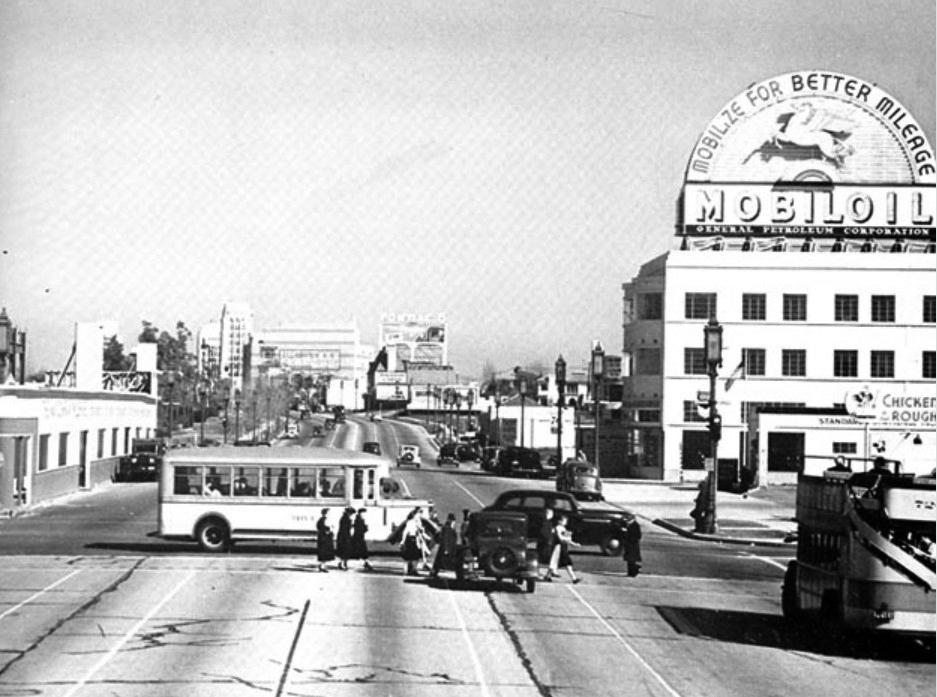 |
|
| (1939)**^ – View looking east on Wilshire Boulevard at Fairfax Avenue. On the left (N/E Corner) can be seen the construction site of the new Wilshire May Company Building. At right is a large rooftop semi-circle billboard reading: "MOBIL OIL - Mobilize for Better Mileage" |
.jpg) |
|
| (1940)+##– Aerial view showing the May Company Department Store shortly after its opening. To the left of it in this photo, we can see the popular Simon's Drive-in restaurant where the Googie-influenced Johnie's Coffee Shop now stands. |
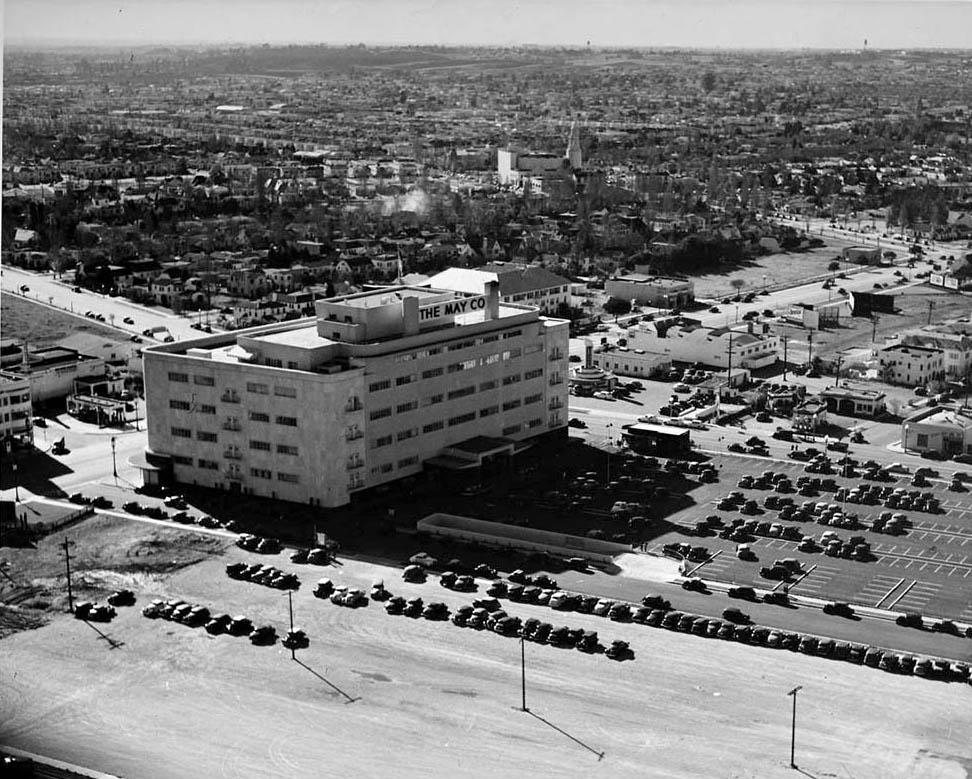 |
|
| (1940)+## – View looking southwest showing the newly constructed May Company Building on the northeast corner of Fairfax and Wilshire. |
Historical Notes The above photo was taken in 1940, the year the May Company Wilshire opened, and we can see how residential Wilshire still was – almost semi-rural. In the distance, we can see the tower of the iconic Carthay Circle Theater. To the immediate right of the store, we can see the circular Art Deco drive-in restaurant, Simon's.+## |
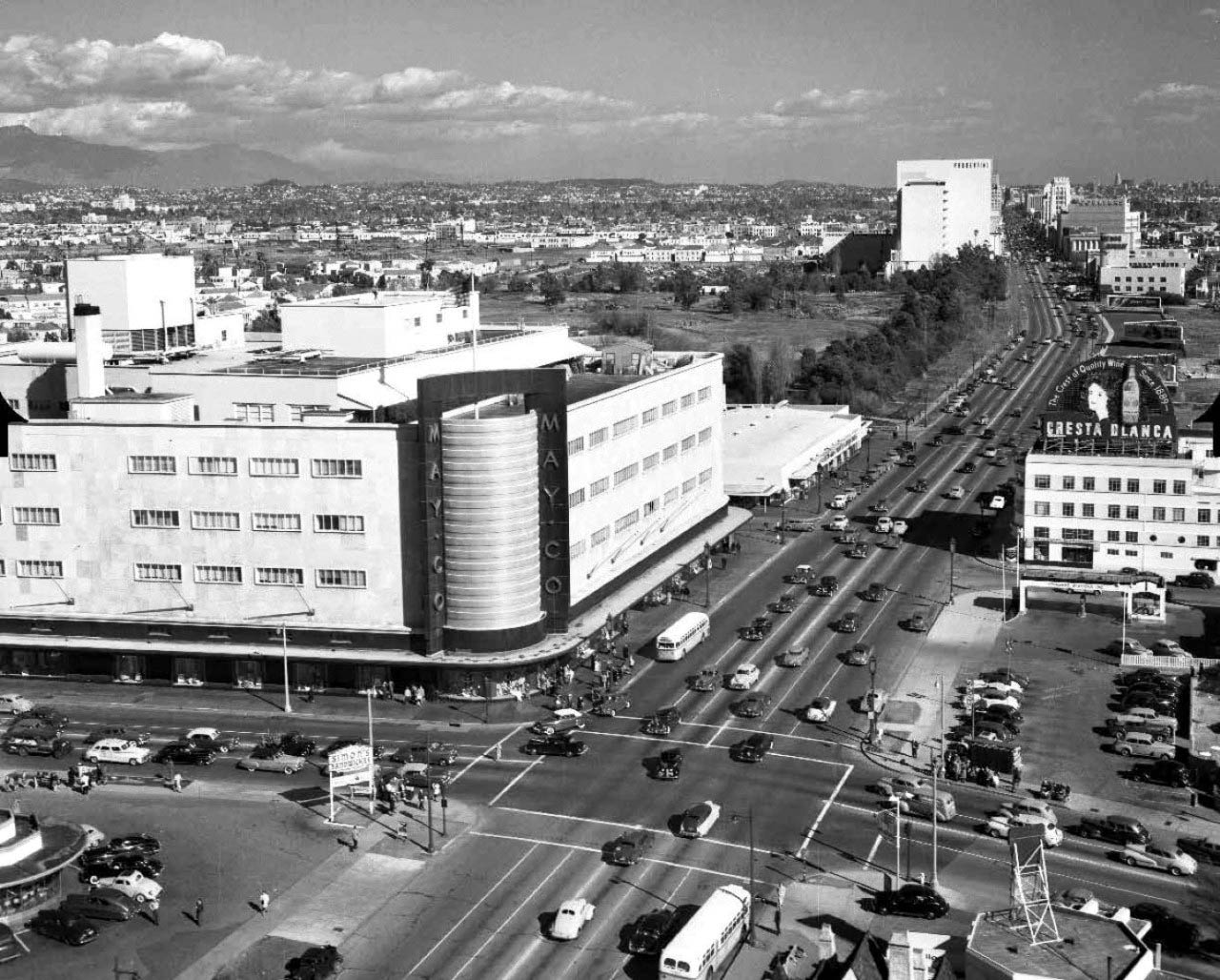 |
|
| (1940s)+## – Aerial view of Wilshire Blvd facing east at the Fairfax Ave corner showing the new May Company Building. This intersection was referred to as the western gateway to the Miracle Mile. |
 |
|
| (ca. 1940)^ - Exterior view of the May Company Building, located on the northeast corner of Wilshire and Fairfax. A man appears to be standing on top of the May Co. sign. A sign across the street reads: Simon'sSandwiches |
Historical Notes The Streamline Moderne department store building with its distinctive corner gold tower was designed by Albert C. Martin and Samuel A. Marx and built in 1939-40.^* |
 |
|
| (1940s)*#^ - View looking toward the northeast corner of Wilshire and Fairfax where the beautiful May Company Building stands. Simon's Drive-in is seen across the street. |
Historical Notes May Company California was established in 1923 when May acquired A. Hamburger & Sons Co.(founded in 1881 by Asher Hamburger). The company operated exclusively in Southern California until 1989 when May Department Stores had dissolved Goldwater's, based in Scottsdale, Arizona and transferred its Las Vegas, Nevada store to May Company California.^* |
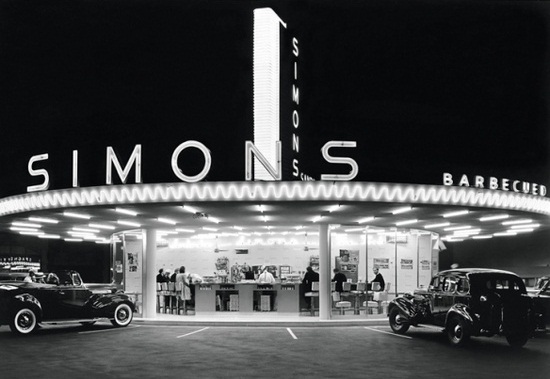 |
|
| (1939)#^#^ - Nighttime view of Simon’s Drive-in, northwest corner of Wilshire Boulevard and Fairfax. |
Historical Notes Simon's Drive-In Restaurant was built in 1935 on the northwest corner of Wilshire Blvd. and Fairfax Avenue. In the 1930s, Wayne McAllister, the originator of the circular drive-in, designed circular Simon's Drive-in Restaurants in the Streamline Moderne style with a three-layer roof and neon advertising pylon; this style was copied throughout the country.^ The DeMille Airfield No.2 (later Rogers Airport) was located at this same Fairfax/Wilshire Simon's Drive-In site in the early 1920s. Today the site is occupied by Johnie's Coffee Shop. |
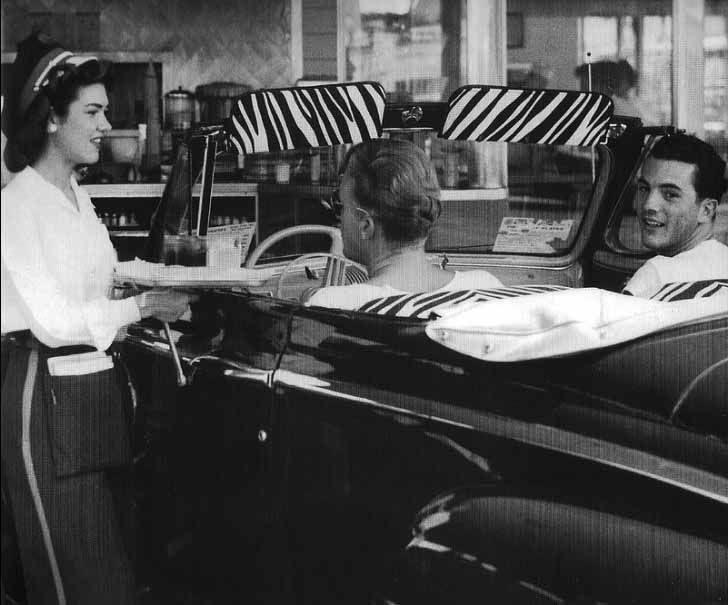 |
|
| (ca. 1948)* - Couple of jitter-bugs down at Simon's Drive-In wowing the waitress with their tiger-stripe upholstery. Ah, those were the days! |
Historical Notes At one time Simon's Drive-Ins dominated the Southern California drive-in restaurant craze. The Simon brothers had operated a chain of successful dairy lunch counters in downtown Los Angeles, and in 1935 decided to capitalize on the growing car culture of Los Angeles by opening auto friendly locations in the emerging commercial centers of Wilshire Boulevard, Sunset and Ventura Boulevards. #^* |
* * * * * |
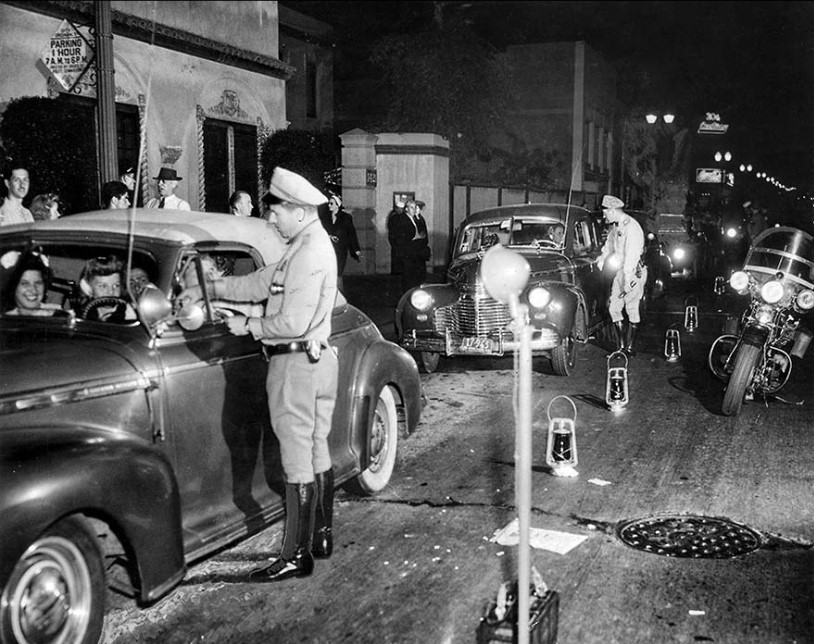 |
|
| (1944)^^ - California Highway Patrol officers check cars funneled into a “stationary” traffic block on Western Avenue south of Sunset Boulevard. |
Historical Notes The Southern California wide law enforcement crackdown was explained in the Sept. 11, 1944, Los Angeles Times: In an effort to halt the toll of death and injury in auto accidents, united law enforcement agencies gave citations to 4,545 motorists for motor vehicle law violations in a swift five-hour campaign through 11 Southern California counties which ended early yesterday. Traffic and safety officials said it was the most extensive traffic check ever attempted in the United States. Almost every type of law enforcement agency took part in the drive. More than 600 officers, including California Highway Patrol, civil police, military police, sheriff’s deputies, police auxiliaries and Navy’s shore patrol operated under the chairmanship of a traffic checks committee headed by Ralph W. Robinson, manager, Greater Los Angeles Safety Council. inspection points on strategic streets, while at the same time roving squadrons of civil police blanketed prearranged areas. The drive enveloped both military and navel personnel as well as civilians. Netted in the traffic drive were: 757 motorists operating cars without driver’s licenses. 1,300 cited for driving with improper lighting. 25 booked as drunk drivers. 15 arrested as “plain drunks” riding with sober drivers. 300 drivers had no proper evidence of car registration. Among servicemen cited were an Army lieutenant and a sergeant arrested in Pasadena as being AWOL from their posts. Another Army officer was arrested on a charge of drunk driving. Many were snagged for failing to have proper liberty and leave passes… This photo by former staff photographer Al Humphreys was published in the Sept. 11, 1944 Los Angeles Times. |
Hollywood
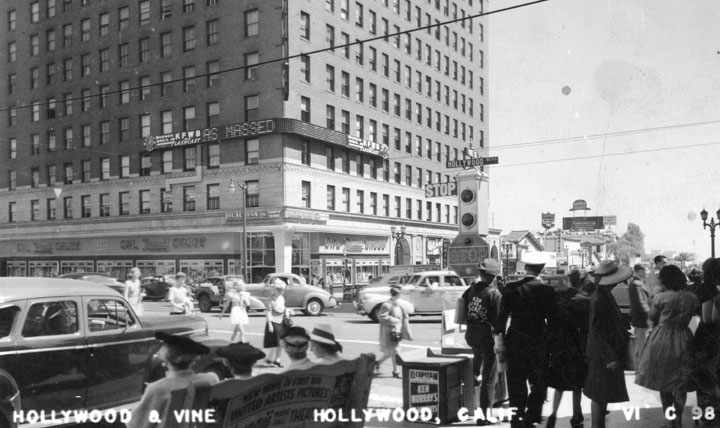 |
|
| (1945)^ - Postcard of a crowd looking at the electric billboard on the Taft Building. The view is from the north-west corner of Hollywood and Vine looking south-east. An early traffic sign is in the foreground and in the background the distinctive "hat" of the Brown Derby sign is visible. |
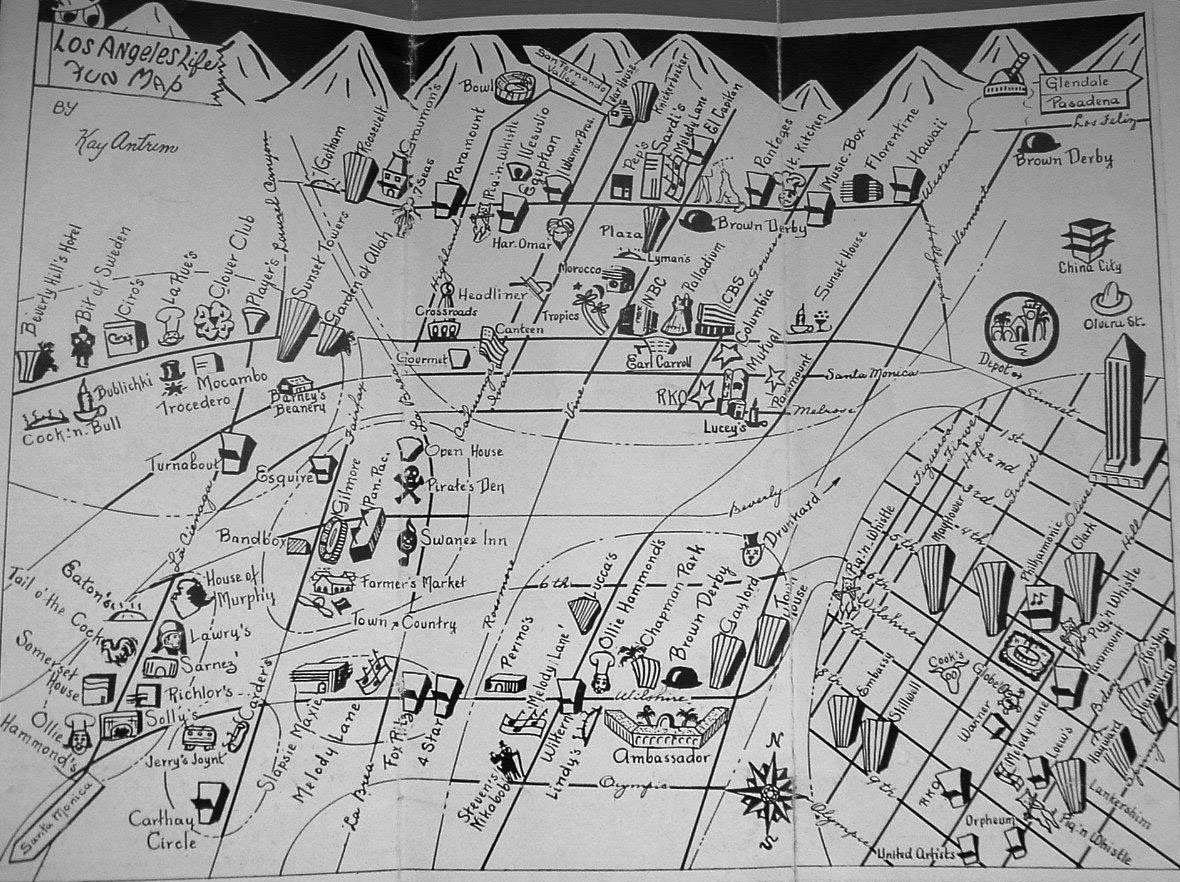 |
|
| (1945)**^ - "Los Angeles Life Fun Map" distributed by Santa Fe Bus Lines and the Glass House Restaurant. Map highlights all the must see places in Los Angeles during the 1940s (i.e. Brown Derby at upper right-center of photo and the Hollywood Bowl at very top). |
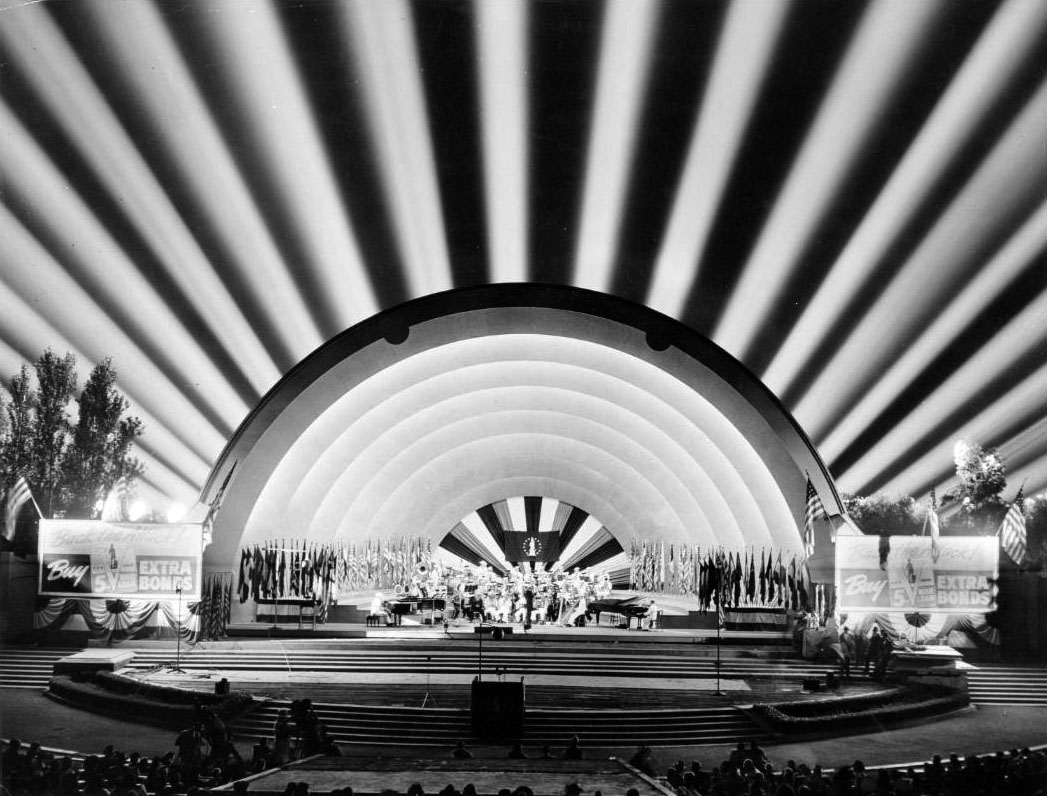 |
|
| (1944)**^ - A War Bonds event at the Hollywood Bowl. |
Historical Notes On June 14th, 1944, radio actors and actresses performed at the Hollywood Bowl during a war bond program. CBS broadcast the event.^ Click HERE to see more in Early Views of the Hollywood Bowl. |
* * * * * |
Broadway and 7th Street
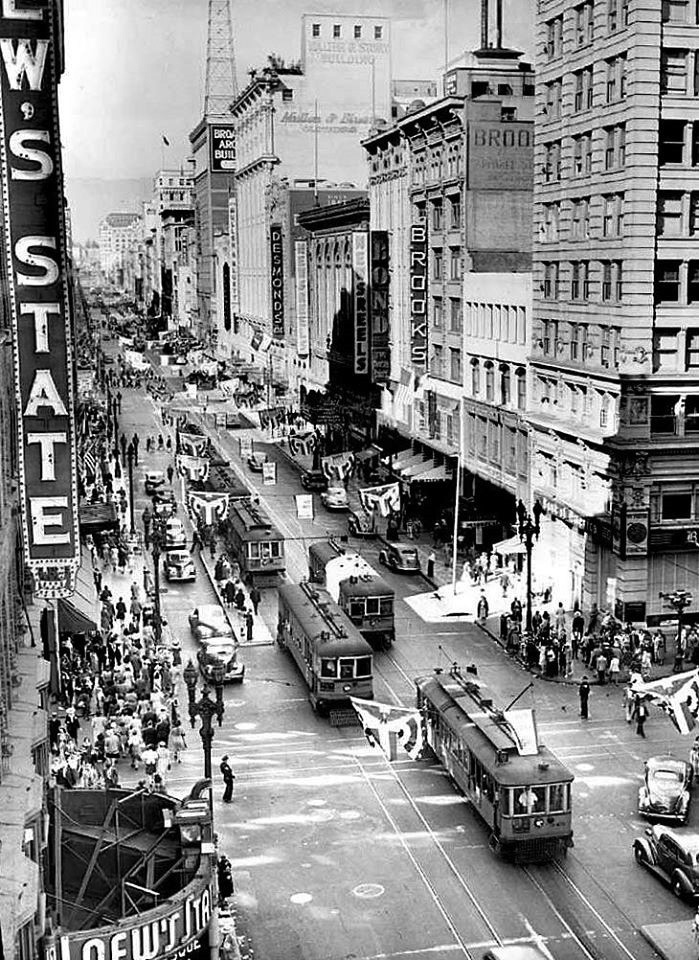 |
|
| (1943)* – View looking north on Broadway at 7th Street with the Loew's State Theatre seen on the left (SW corner). There seems to be quite a log jam of streetcars at this busy intersection. The tallest building in the distance seems to be the Walter P. Story Building (SE corner of Broadway and 6th). |
Historical Notes When the above photo was taken in 1943, America was in the depth of WWII. Gasoline was strictly rationed and so people were more reliant on public transport. With LA being flooded with war workers and servicemen, there was a lot of bodies to be moved around. Also Broadway and 7th Street was known as the intersection in LA for many years. |
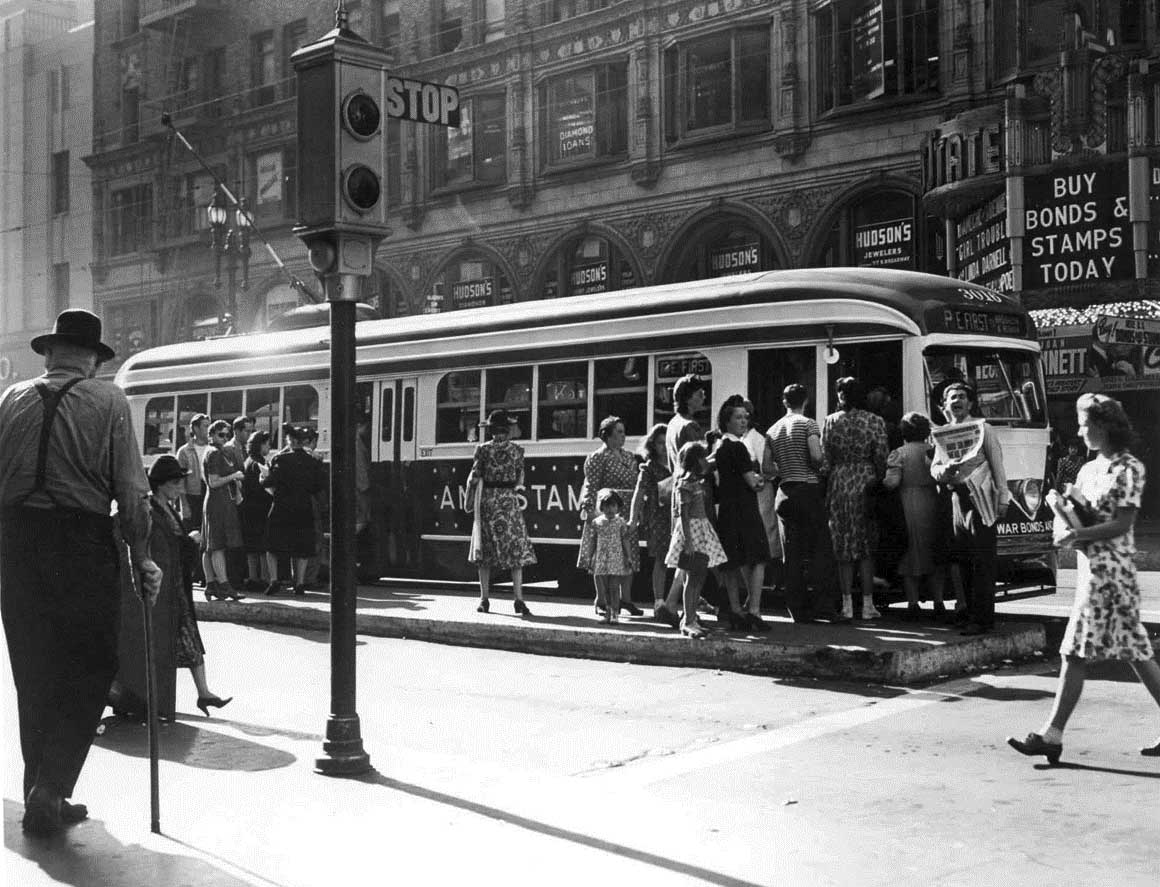 |
|
| (1942)* - A streetcar stops in front of Lowe's State Theatre at Broadway and 7th Street in downtown L.A. A semaphore traffic signal is seen on the corner in the foreground. |
Historical Notes The only protection those streetcar riders have from the traffic is that raised platform, which is more than they usually got, if other photos of the era are anything to go by. The State Theatre was a Loew’s house showing mostly MGM movies, but at this time it was playing Joan Bennett picture, and none of her 1942 releases was from MGM. Like most theaters, the State pushed the purchase of war bonds and stamps. During WWII, it also played movies 24 hours a day to accommodate shift workers at the war factories who worked around the clock. |
Parades
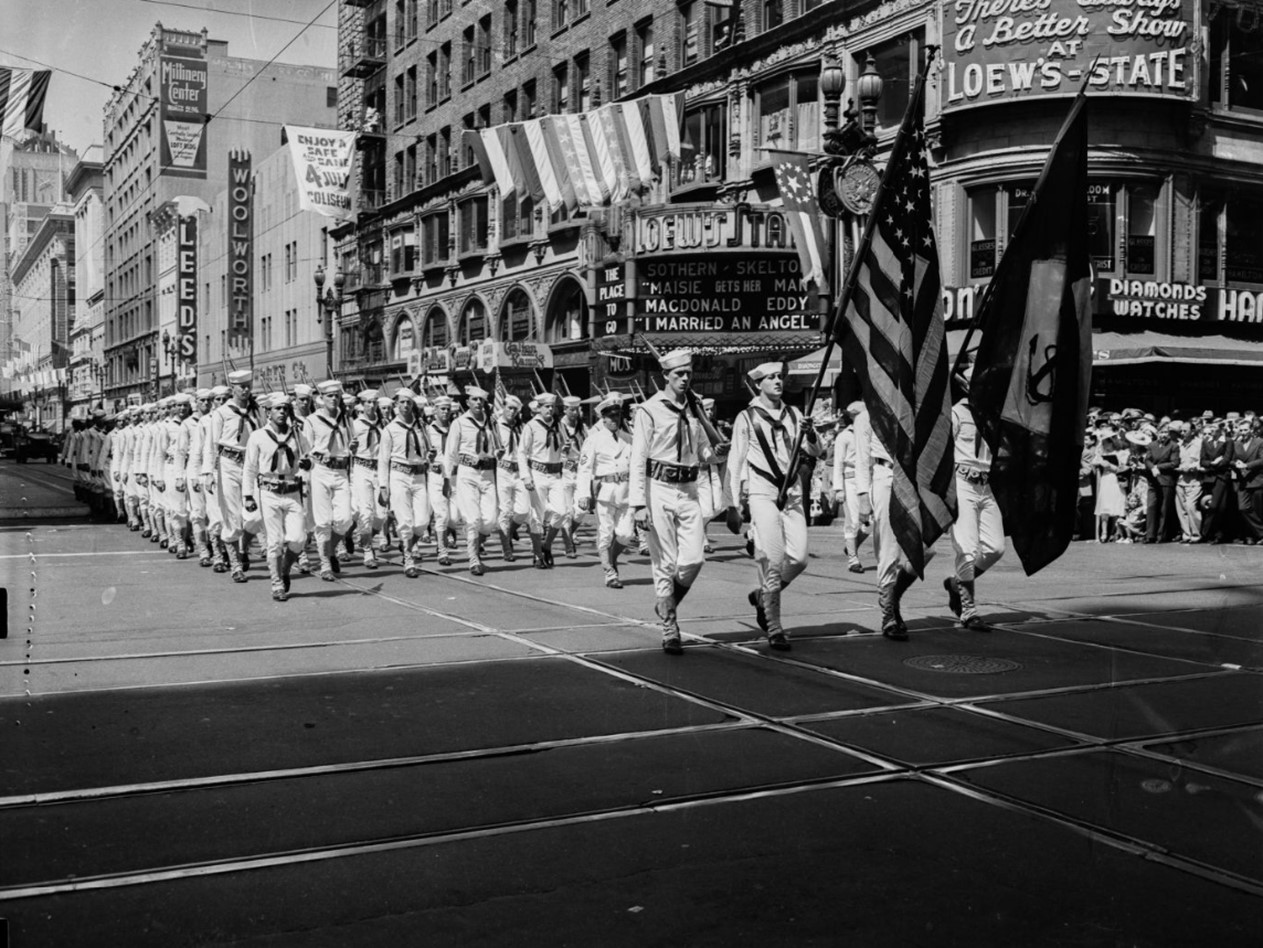 |
|
| (1942)* - Men in navy uniforms with rifles in formation crossing 7th Street while marching north on Broadway during a parade of military and civilian defense units on July 4th in downtown Los Angeles. Loew’s State Theatre can be seen on the southwest corner. |
Historical Notes Broadway has a storied history of parades, from the grand Fiesta de Los Angeles in the late 19th and early 20th centuries to political, sports, and military parades throughout the years. |
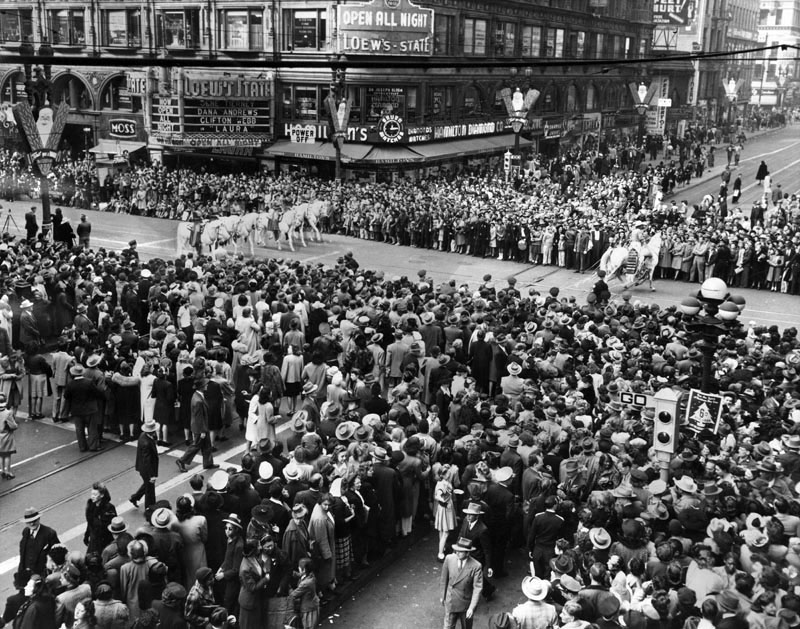 |
|
| (1944)^ - View of the War Loan Drive Parade at the busy intersection of Seventh and Broadway. Note how the streetlight in the lower right of the photo is blacked-out on top due to the war. Loew's State Theatre is seen across the street on the SW corner. |
Historical Notes On November 18, 1944, a throng estimated at 350,000 crowded downtown streets to witness the gala spectacle, "Calvacade of the West," which ushered in the 6th War Loan drive. |
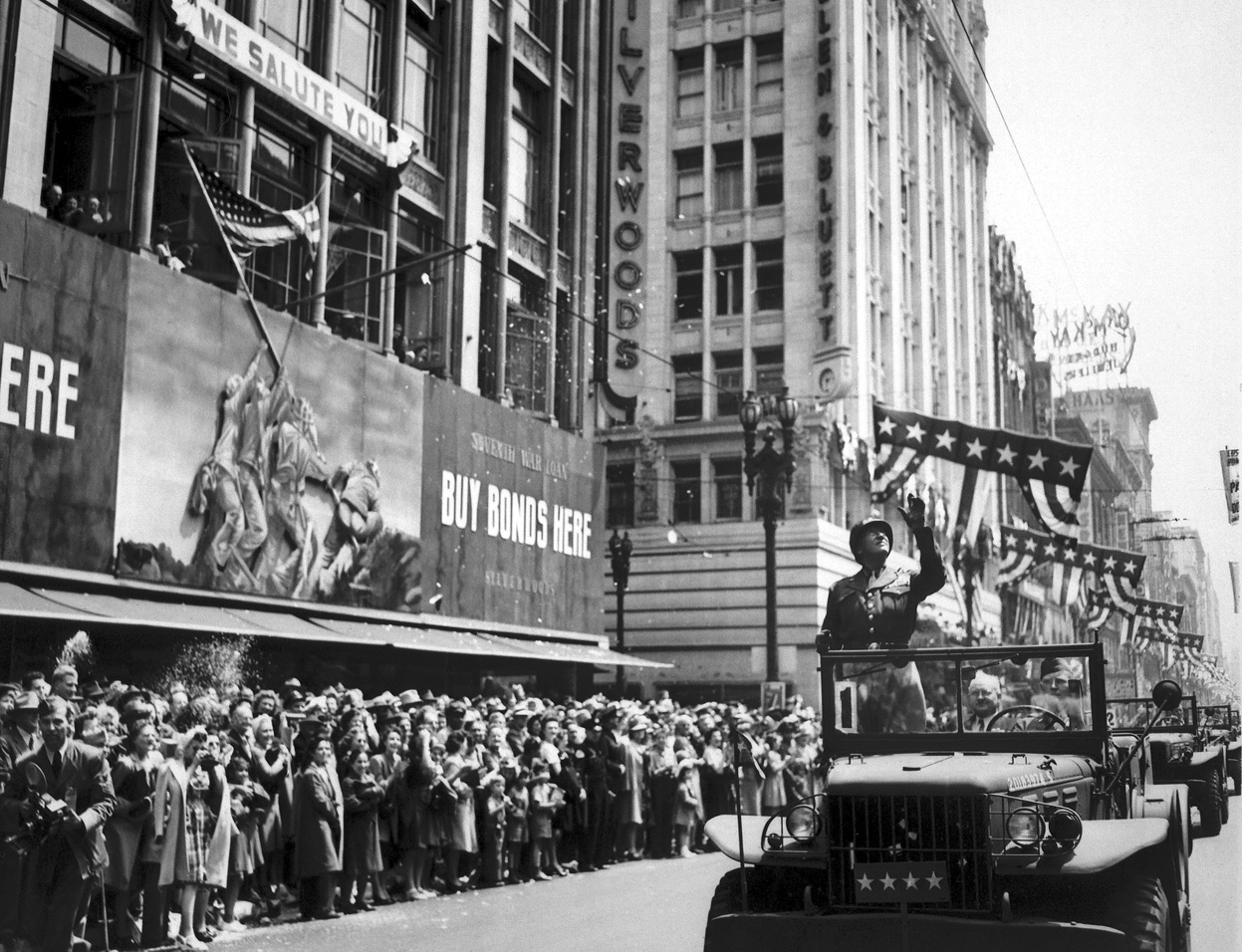 |
|
| (1945)* - U.S. General George S. Patton acknowledges the cheers of thousands during a parade down Broadway in downtown L.A., on June 9, 1945. |
Historical Notes Shortly after his visit to Los Angeles, Patton returned to Germany and controversy, as he advocated the employment of ex-Nazis in administrative positions in Bavaria; he was relieved of command of the 3rd Army and died of injuries from a traffic accident in December, after his return home. Joe Rosenthal's famous Iwo Jima flag-raising photograph is visible on the war bonds billboard. |
V-J Day
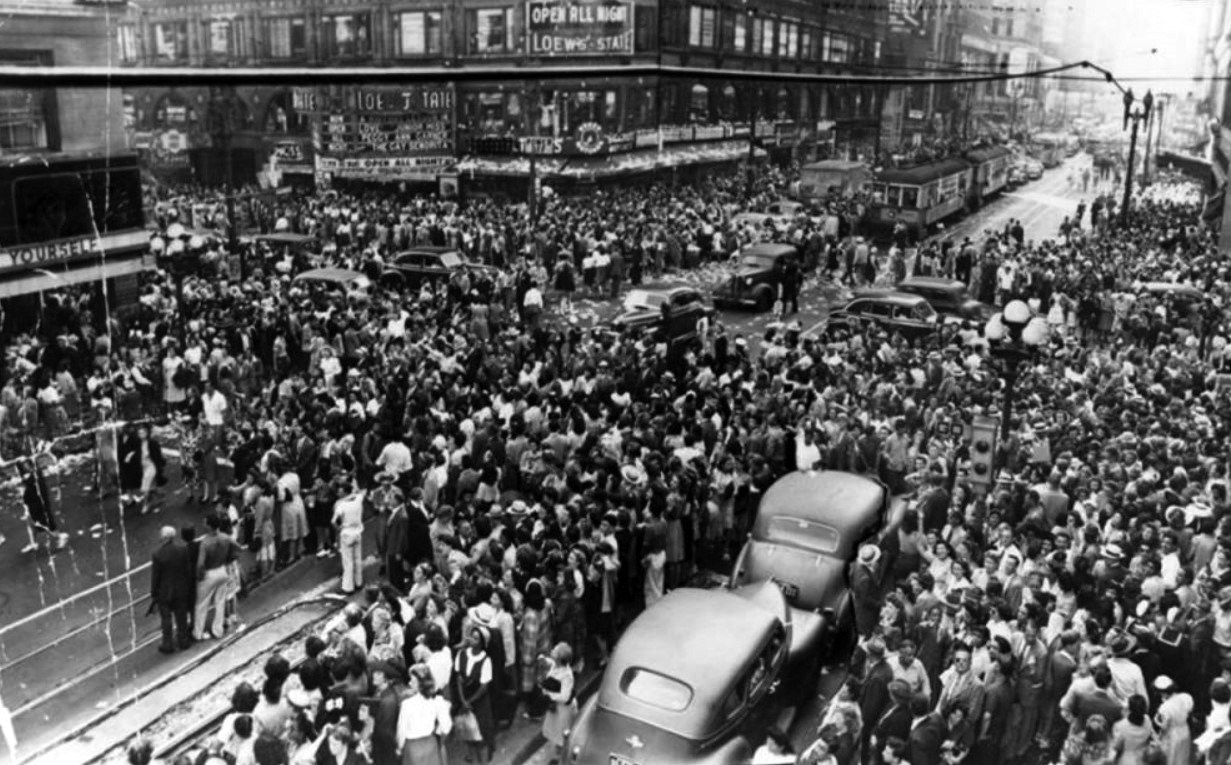 |
|
| (1945)* – Photo caption reads: "Riotous celebration spread through downtown Los Angeles as soon as the announcement of Japan's surrender came. Here, at Seventh and Broadway, thousands have poured out into the streets and cars are unable to break through the walls of rejoicing humanity. Emotions kept pent up through nearly four years of war were released as Angelenos cheered and wept in their happiness." The huge crowd, shown from overhead is gathered on the sidewalks and in the streets, blocking several automobiles and streetcars. In the background is the Loew's State movie theater at 703 S. Broadway. Herald Examiner Collection |
Historical Notes On August 6, 1945 the United States dropped an atomic bomb on the Japanese city of Hiroshima and on August 9, 1945 on the city of Nagasaki. These actions shocked the country and prompted Emperor Hirohito to order the Supreme Council for the Direction of the War to accept the terms the Allies had set down in the Potsdam Declaration for ending the war. On August 14, 1945, it was announced that Japan had surrendered unconditionally. Both August 14 and 15 have been known as "V-J Day" or "Victory over Japan Day." The term has also been used for September 2, 1945, when Japan formally surrendered aboard the U.S.S. Missouri, anchored in Tokyo Bay. |
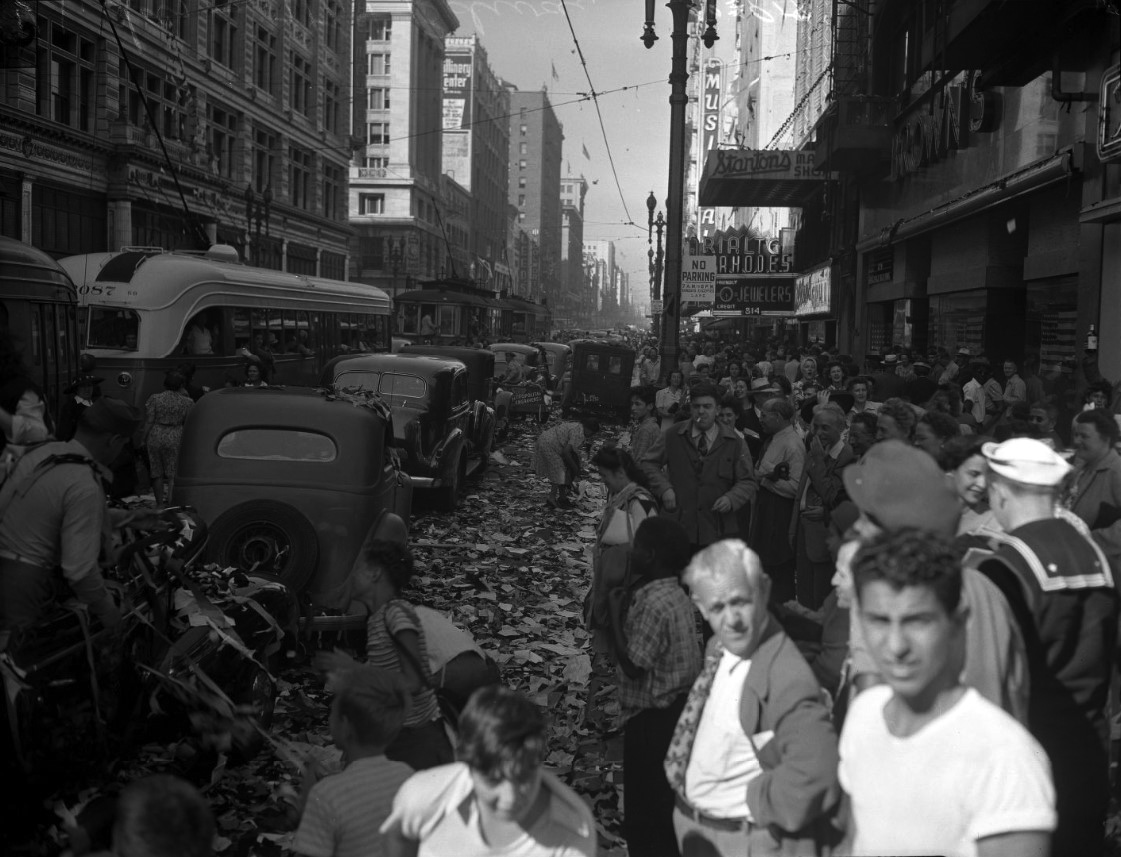 |
|
| (1945)* - Victory over Japan Day celebration at Broadway and 7th in Downtown Los Angeles. LA Daily News Collection |
Historical Notes The exact date of the war's end is not universally agreed upon. It has been suggested that the war ended at the armistice of August 14, 1945 (V-J Day), rather than the formal surrender of Japan (September 2, 1945); in some European histories, it ended on V-E Day (May 8, 1945). However, the Treaty of Peace with Japan was not signed until 1951, and that with Germany not until 1990. |
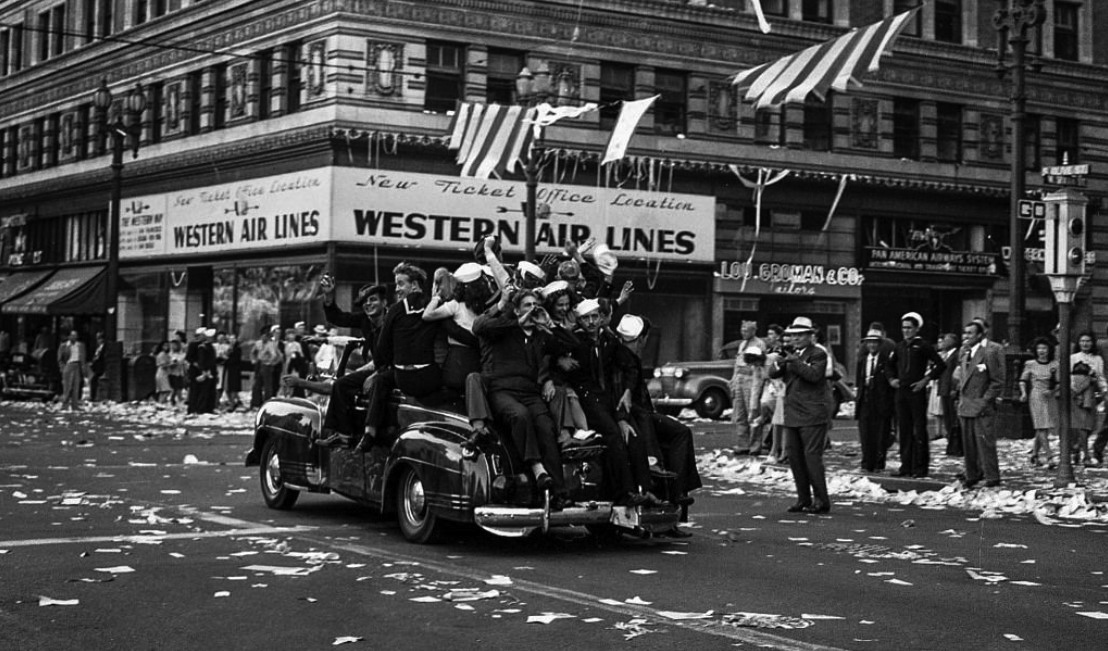 |
|
| (1945)* - Headed south on Olive just crossing 6th Street, August 14, 1945. Having defeated Japan, a group of renegade sailors turn their attention to a hapless Plymouth convertible. LA Times Photo Archive |
* * * * * |
5th Street (between Grand and Figueroa)
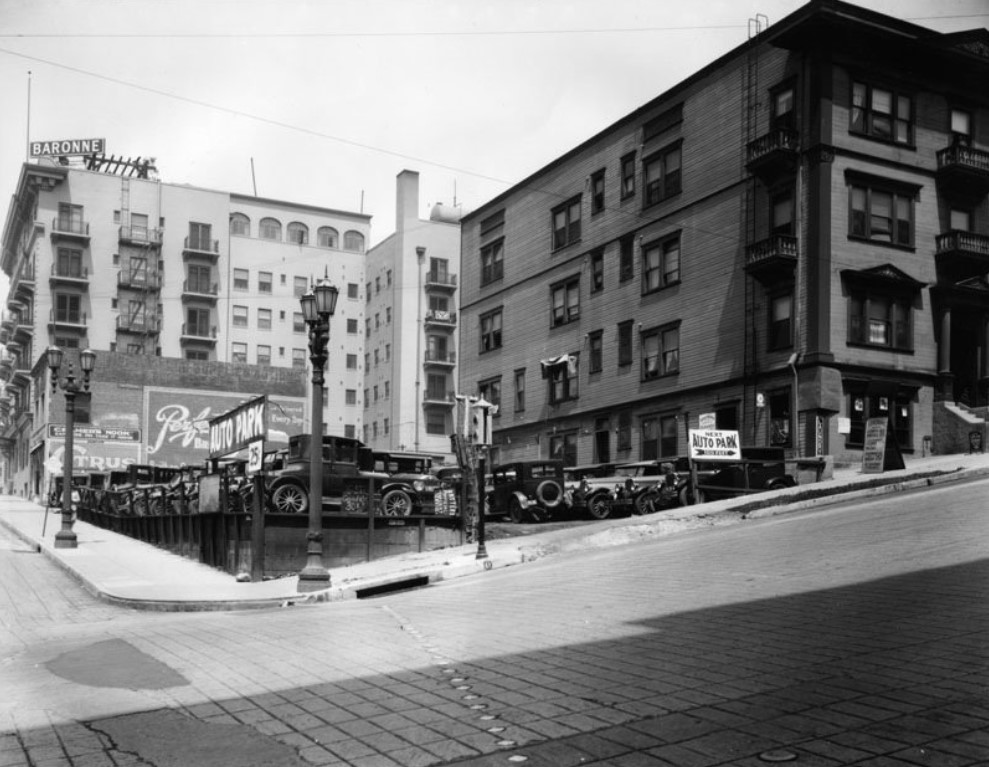 |
|
| (1927)^ – View looking at the northwest corner of 5th Street and Grand Avenue with the Ayers Apartments on the right and the Barrone (later Engstrum Apartments) background left. This corner lot would become the future site of the Edison Building. |
Historical Notes The Ayers Apartments will be demolished with the construction of the Edison Building in 1930-31 and the Baronne, originally the Westonia, will change it's name one last time and become the Engstrum Hotel Apartments. |
 |
|
| (1930)^ - View shows the Southern California Edison Company Building in the final stages of constrution. |
Historical Notes Located on the corner of Fifth Street and Grand Avenue the building opened on March 20, 1931 as the Southern California Edison Company corporate headquarters. The Edison Company Building was one of the first all-electrically heated and cooled buildings constructed in the western United States. Now known as One Bunker Hill, the Art Deco building located at 601 W. 5th Street was designed by James and David Allison. |
Then and Now
 |
|
| Then and Now, Fifth and Grand, DTLA. |
Then and Now
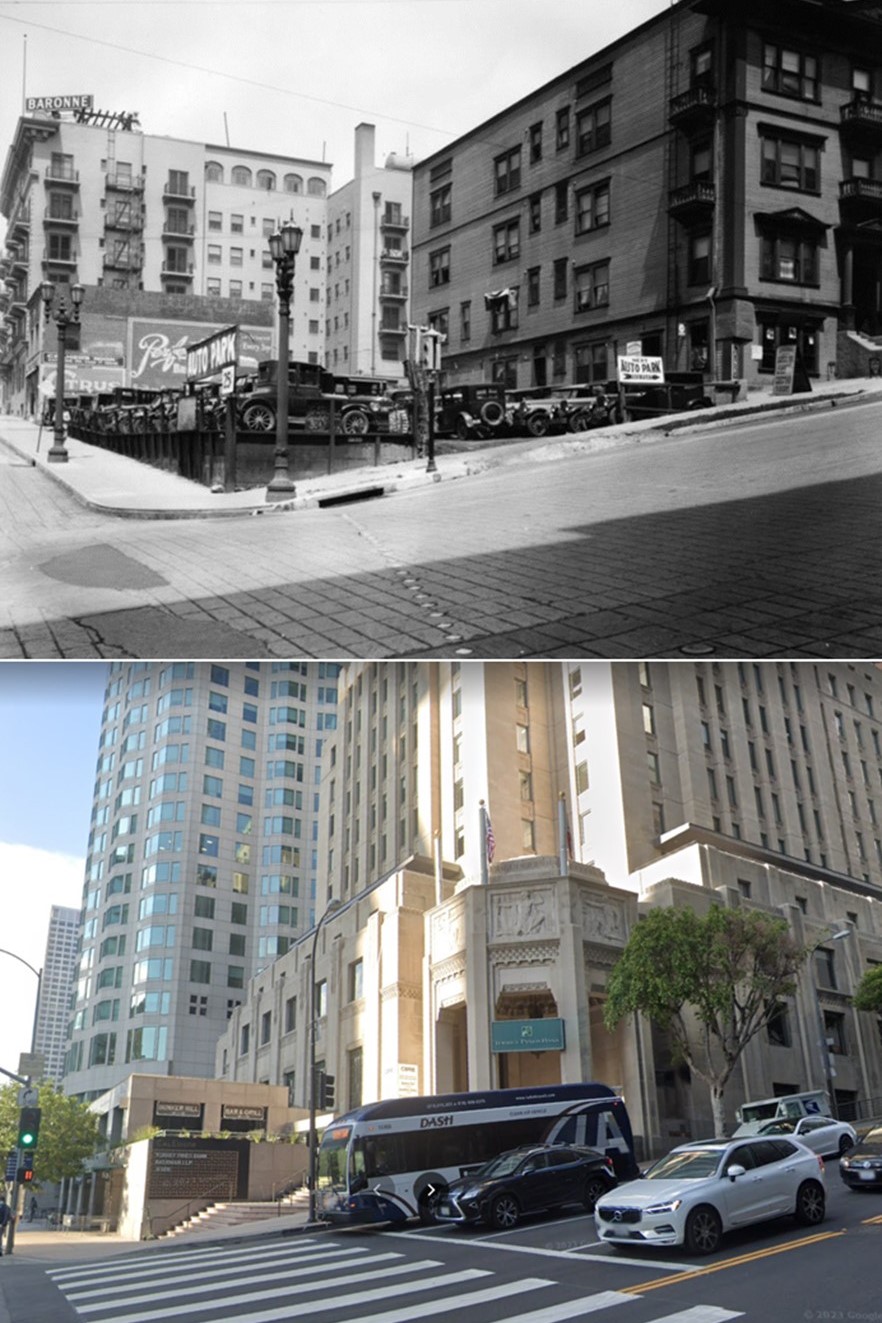 |
|
| (1927 vs 2021)* - Looking at the NW corner of Fifth and Grand, DTLA. |
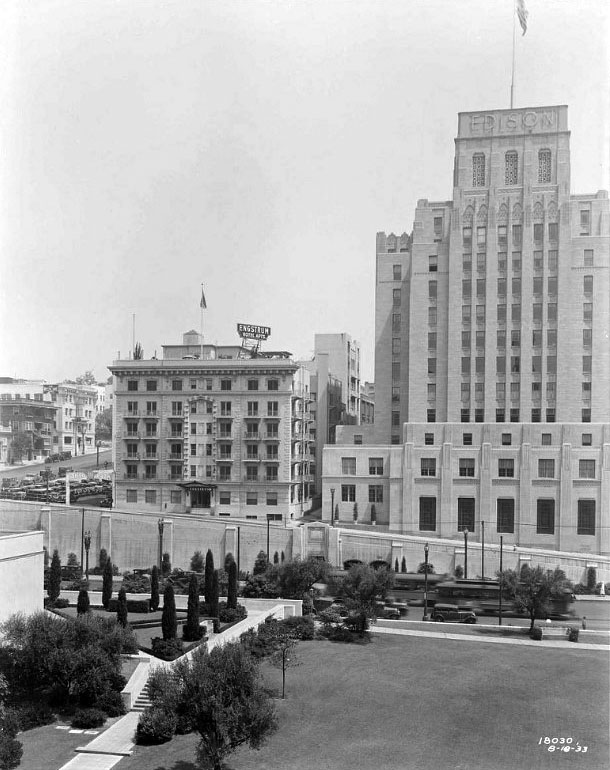 |
|
| (1933)*^#^ - Slightly elevated view, probably from the Mayflower Hotel, looking north across the east library park to the Edison Building, the Engstrum Hotel Apartments, a small slice of the Barbara Worth Apartments, the Wickland Apartments (Rubaiyat), the Santa Barbara Apartments and part of the front of the Sons of the Revolution library. #* |
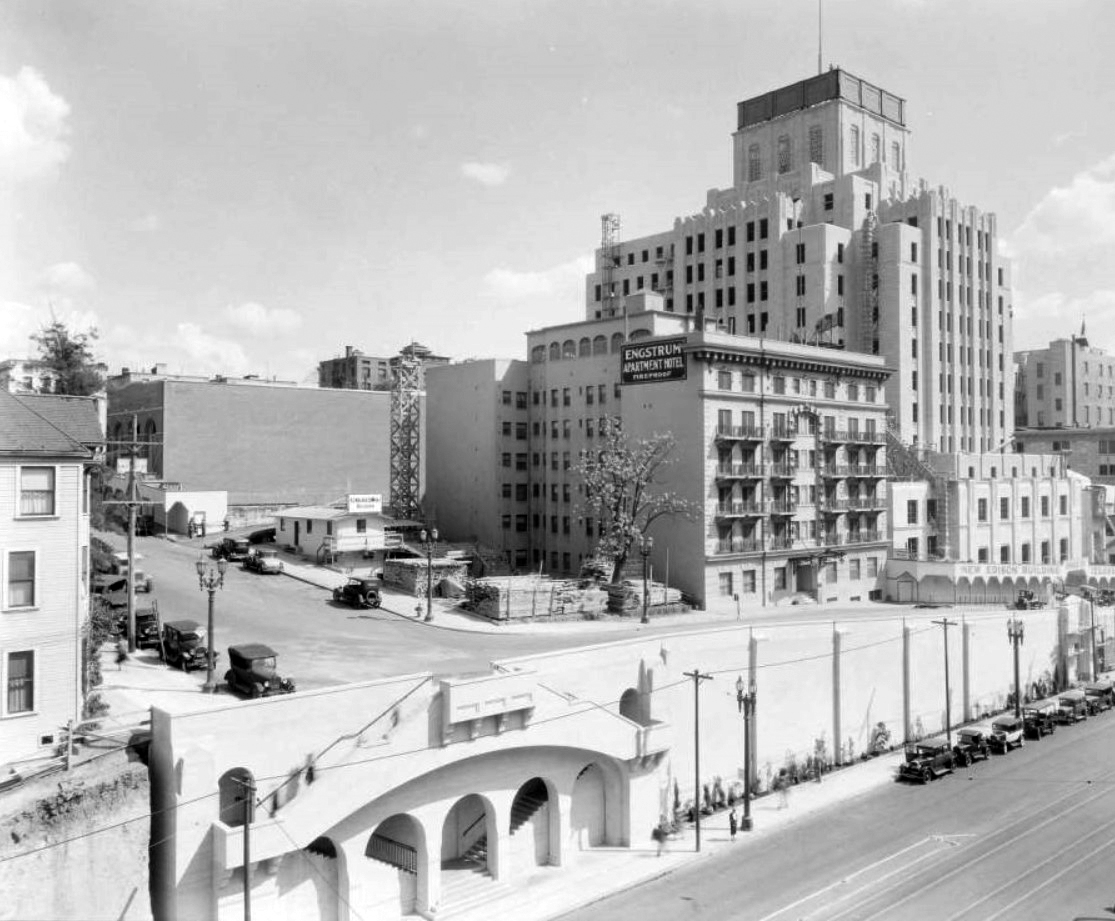 |
|
| (1931)* – View looking northeast from the Central Library showing the 6-story Engstrum Hotel Apartments perched high above 5th Street (lower-right) with Hope Street seen at center-left. The newly completed Edison Building is also seen on the right, NW corner of 5th and Grand. The three-story building on the left is the Mountview Apartments. |
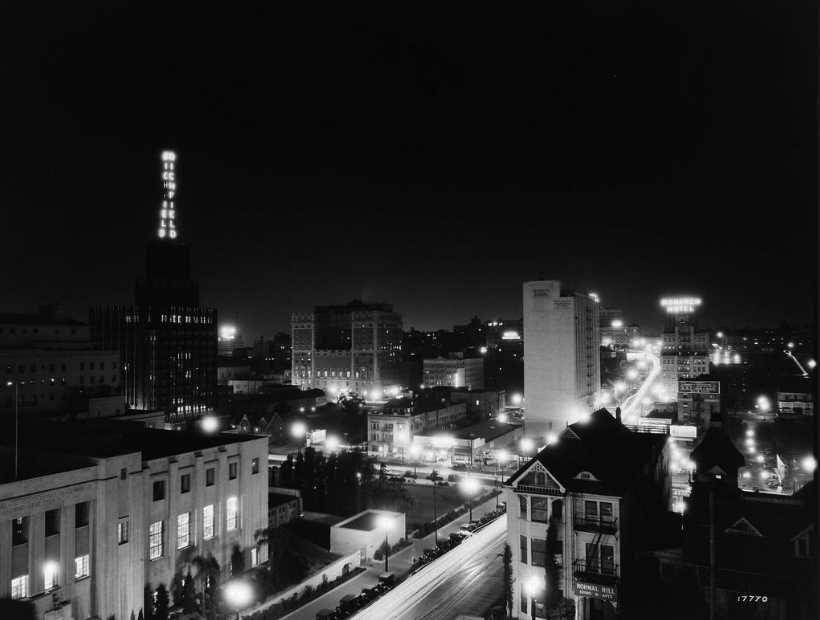 |
|
| (ca. 1932)* – Night view looking southwest from the Engstrum Apartments at upper 5th Street and Hope. The distinctive little multi-story apartment building at lower-right is the Mountview Apartments. It will be torn down in favor of the Sunkist Building in three or four years. Lower left is the back wall of the Goodhue Central Library open for business about four years in 1932. Richfield Tower, left background, was completed in 1929, squarish, Jonathan Club with the two main towers (just to the right of the Richfield) and then the tall, white Architects Building on the SE corner of 5th and Figueroa Streets. Brightly lit neon sign of the Monarch Hotel, background right, on the NW corner of 5th and Figueroa. |
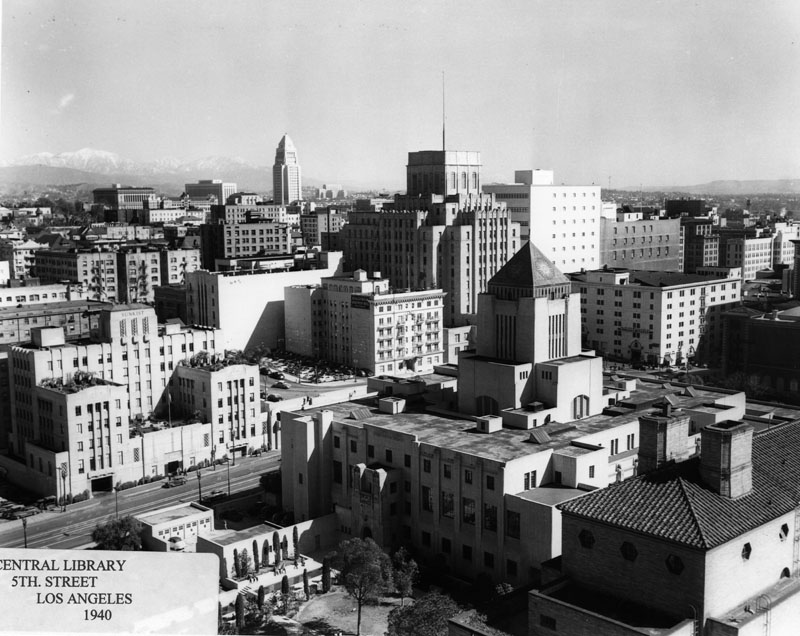 |
|
| (1940)^ - View looking across Flower Street at the west side of the Central Library. 5th Street is seen at lower-left. |
Historical Notes The above view shows a corner of the California Club in the lower right corner and then on the left-center the white Sunkist Building facing the back of the library across 5th Street. The Edison Building (later One Bunker Hill Building) dominates the center of the frame with the Engstrum Hotel Apartments below it nearer the camera (looking all the world like three separate buildings), then just to the left the white, slab-sided Edison Annex which faces Hope Street, with the Zelda seemingly perched atop it, the dark, flat-roofed Santa Barbara Apartments peeking out from behind the Sunkist and the white Rubaiyat (now called the Wickland Apartments) behind it. And lastly, the three peas-in-a-pod apartment buildings going left to right from the Rubaiyat to the Zelda, starting with the LaBelle, then the Bronx and finally the Gordon immediately to the left of the Zelda. |
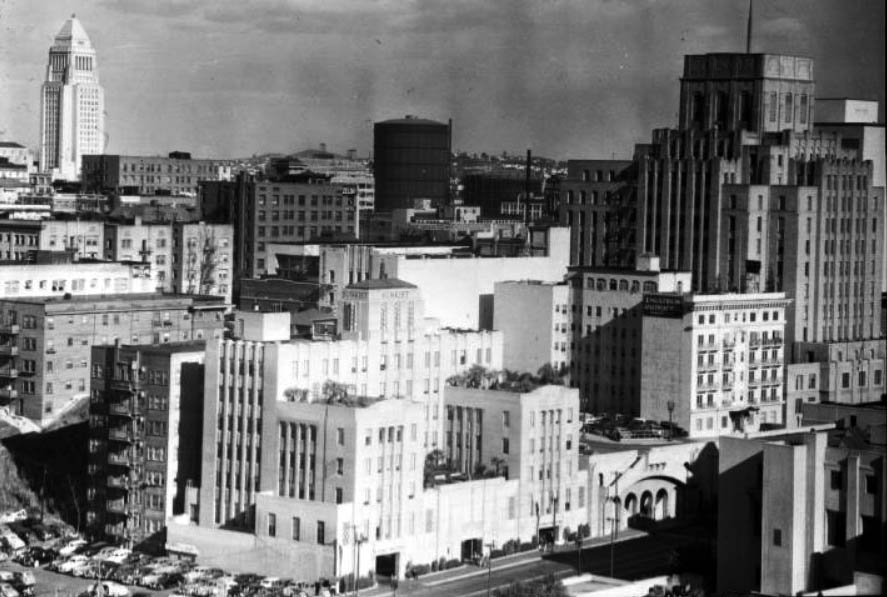 |
|
| (ca. 1945)* - Panoramic view of downtown Los Angeles looking northeast. In the foreground a building labeled "Sunkist" is visible, while the "Engstrum Apartments" can be seen at right. Further to the right, an American flag on a large flagpole can be seen atop a large rectangular structure, the Edison Building (later One Bunker Hill Building). In the background at center, a cylindrical construction which appears to be a large gas holder (aka "gasometer") rises above the other structures. In the far background at left, City Hall stands high above its surrounding structures. |
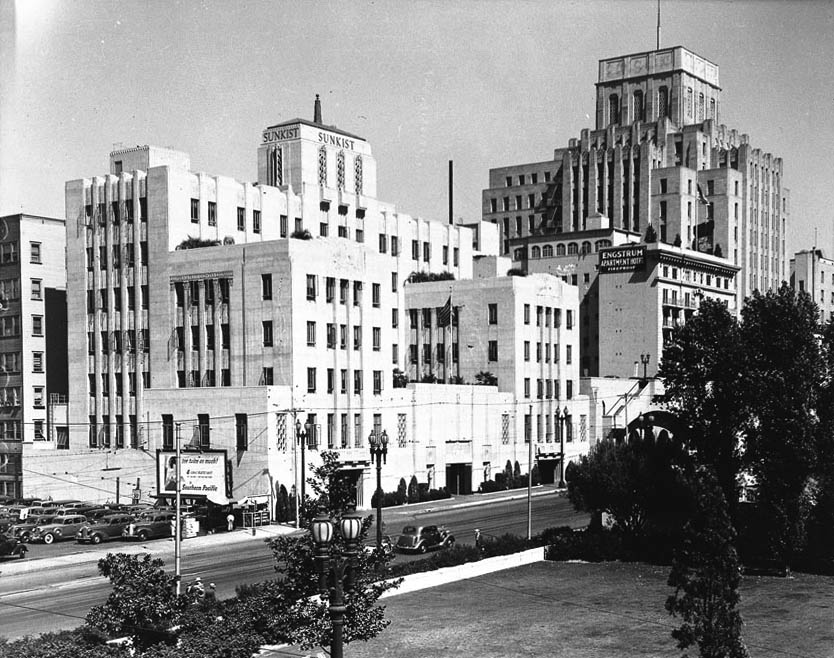 |
|
| (ca. 1940s)*# - View of the Sunkist Building on the corner of Fifth Street and Hope Street in Los Angeles. The Sunkist Building is at right and is a large building made up of many connected rectangular sections. Large rectangular windows can be seen on the sides of the building, and a tower in the middle bears the name of the company. In the background at right are the Engstrum Hotel Apartments and the Edison Building (later One Bunker Hill Building). In the foreground at right is the front lawn of the Los Angeles Central Library. |
Historical Notes In 1970, Sunkist traded its downtown land and building for a larger property in Sherman Oaks in a deal valued at about $1.6 million. Before the Sunkist building was demolished in 1972, it sat empty for two years on the approaches to Bunker Hill. In 1981, Wells Fargo Bank was built on the empty land. Five years later, Wells Fargo bought Crocker Bank and moved to South Grand Avenue. Today, the old Wells Fargo Building has become the 48-story Four Forty-Four Plaza, housing about 80 firms. |
Grand and 5th (SW Corner)
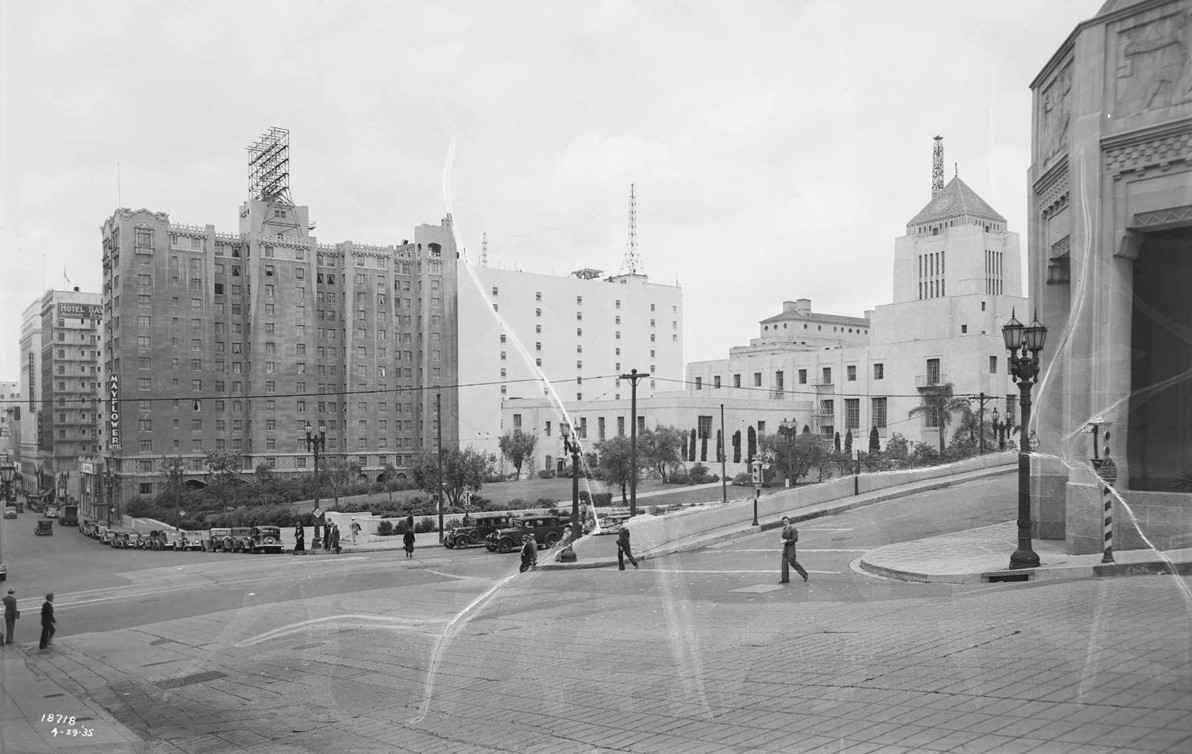 |
|
| (1935)* - Southwest view at 5th & Grand showing the Los Angeles Public Library across the street from the Edison on Building on the right. Also seen here is the Mayflower Hotel on the left. |
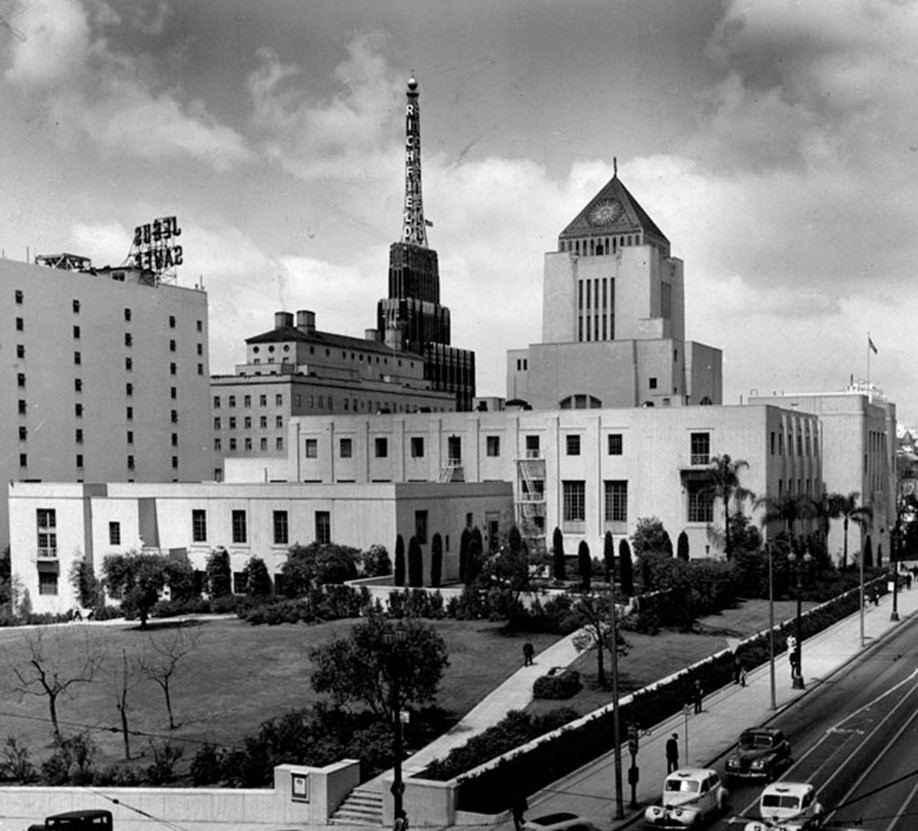 |
|
| (1949)* - View looking southwest showing the Central Library as seen from the corner of 5th and Grand streets. Behind the library stands a tall tower with the name Richfield on it and to the left another sign which reads "Jesus Saves." The California Club can also be seen on the left. |
Historical Notes The original compact Goodhue structure (Central Libary) was surrounded by lawns and gardens extending as far as Grand Avenue until the Tom Bradley Wing, completed in 1993, filled in that footprint. |
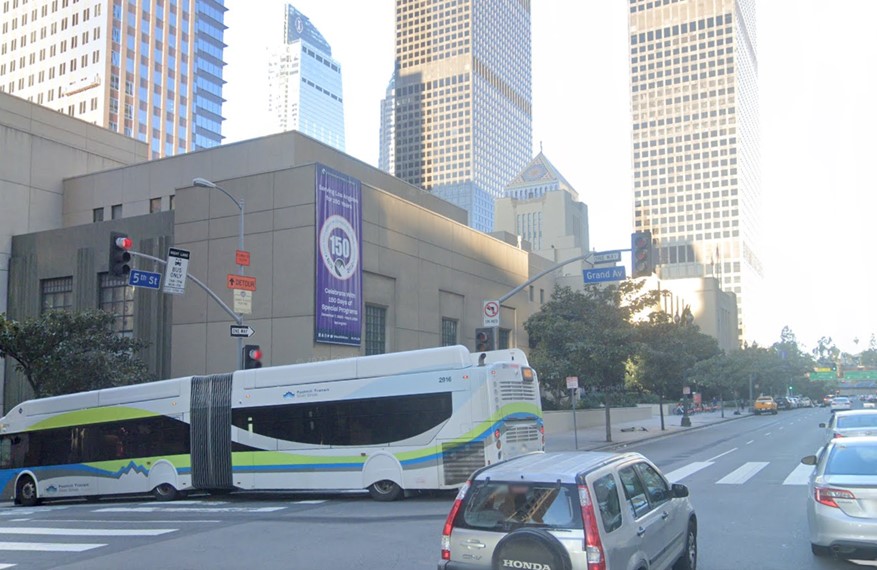 |
|
| (2023)* - Looking at the southwest corner of Grand Ave and 5th Street. |
Then and Now
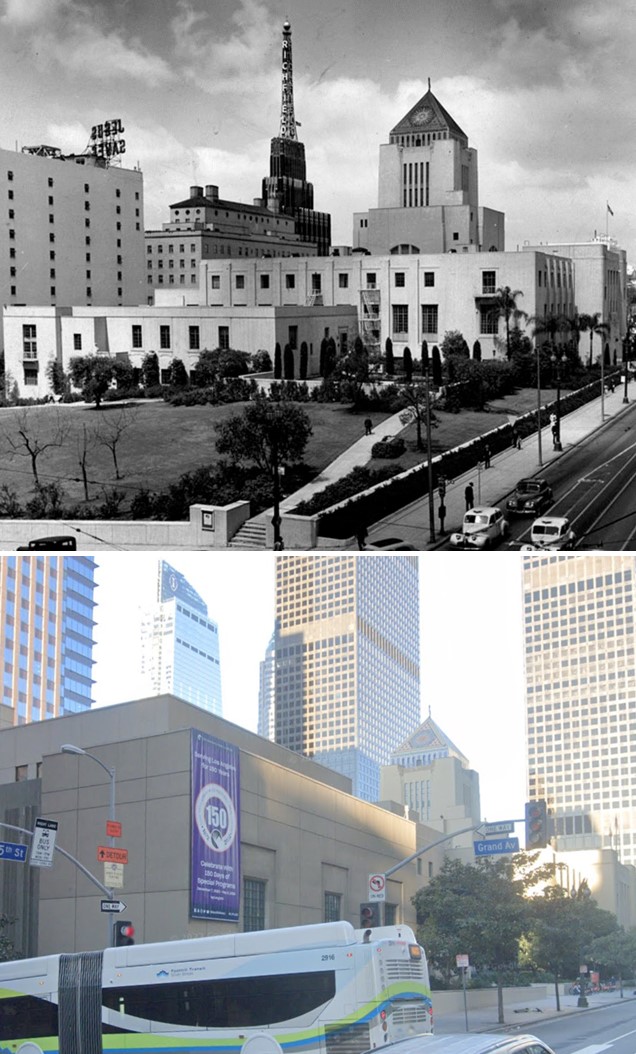 |
|
| (1949 vs. 2023)* - Looking at the southwest corner of Grand Ave and 5th Street. |
* * * * * |
Hill Street
 |
|
| (1940s)^*^# – View looking north on the 700 block of South Hill Street showing mid-day pedestrian traffic. The large building with high flying flag seen in the distance is the Title Guarantee Building on 5th Street. |
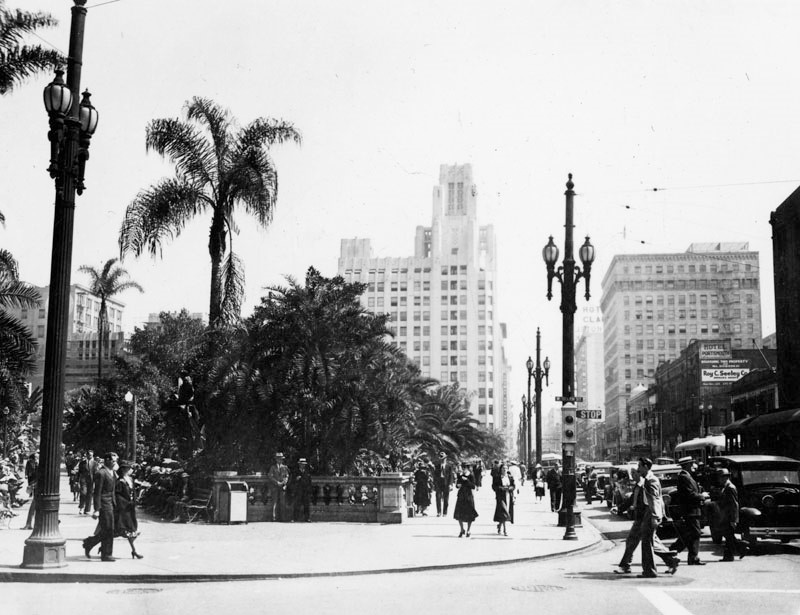 |
|
| (ca. 1940)^ – View looking north on Hill Street at 6th Street with Pershing Square seen at left. The tall Art Deco building in the distance (N/W corner of 5th and Hill) is the Title Guarantee Building. Note the ornate streetlights running up Hill Street. |
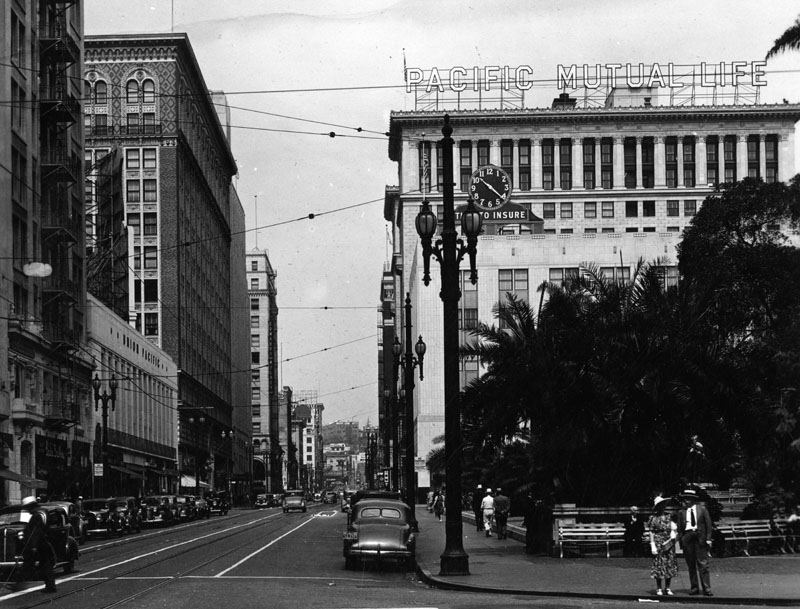 |
|
| (ca. 1945)^ - Postcard view of 6th Street looking west from Hill Street. Pershing Square is at right, behind which is the Pacific Mutual Life Building, with its clock and motto, "Time to Insure." On the left is the Union Pacific Building. In the distance is the hillside west of downtown, the future location of the Harbor Freeway. |
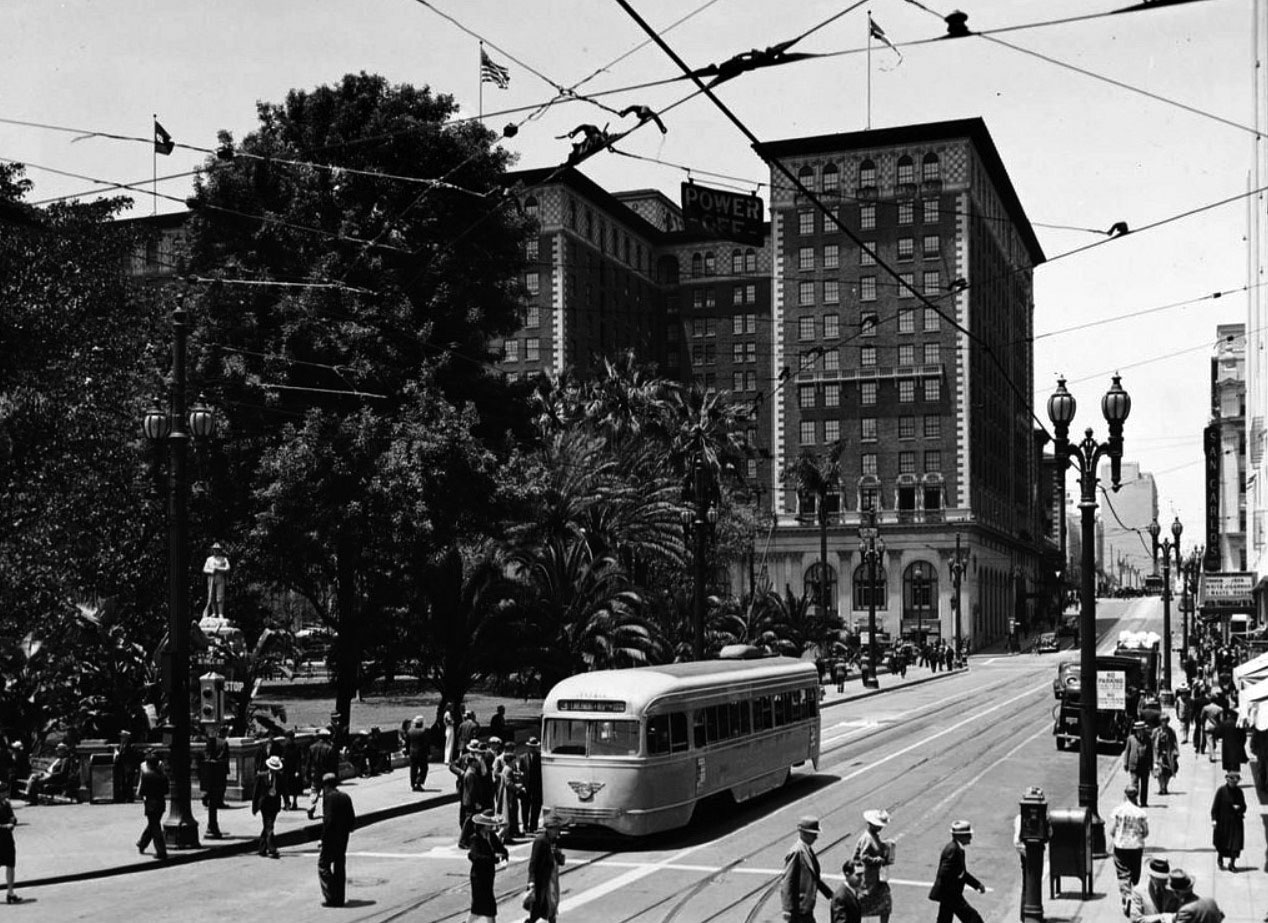 |
|
| (1940)* – View looking west on 5th Street from Hill Street showing the Biltmore Hotel and Pershing Square. That tall light colored building up there in the distance is the Architects' Building at Figueroa and 5th (SE corner). Click HERE for contemporary view. |
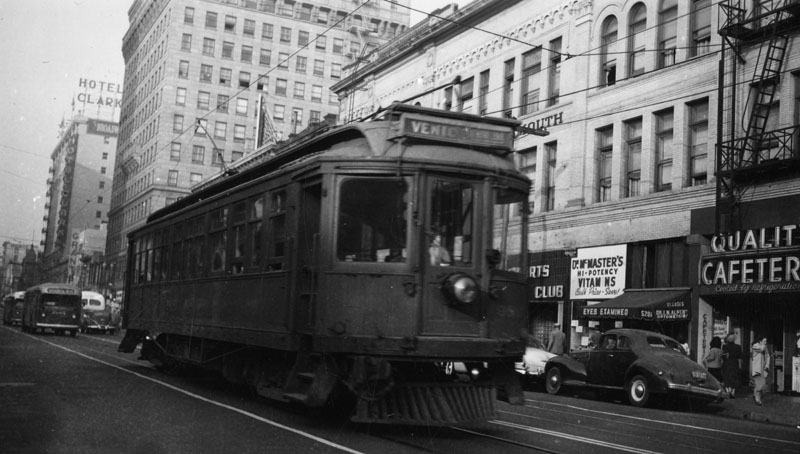 |
|
| (ca. 1945)^ - Venice is the destination for this Pacific Electric car as it passes in front of the Hotel Portsmouth on Hill St. In the background is Hotel Clark. |
Historical Notes Pacific Electric carried increased passenger loads during World War II, when Los Angeles County's population nearly doubled as war industries concentrated in the region attracting millions of workers. There were several years when the company's income statement showed a profit, most notably during World War II, when gasoline was rationed and much of the populace depended on mass transit. At peak operation toward the end of World War II, the PE dispatched over 1000 trains daily and was a major employer in Southern California.^* |
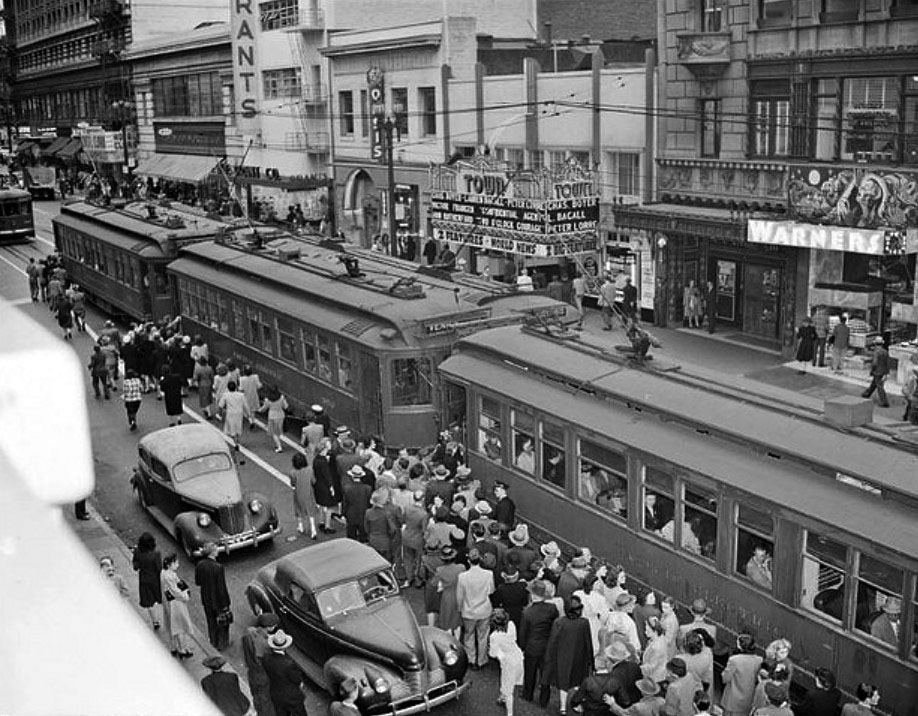 |
|
| (1946)#* - View showing packed Pacific Electric Venice-bound streetcars at 5th & Hill streets. The line stopped running just 4 years later. |
Historical Notes The Venice-bound line has a complex history dating back to 1897, when the portion between Hill & 4th Street to Vineyard (near Pico & San Vicente Boulevards) were constructed as part of the Pasadena & Pacific Railway Company. The line was practically level, and with few curves, it served as a much more direct route to the beaches than did the line through Beverly Hills. When the resort town of Venice was founded in 1904, the Venice Short Line served as the most popular way for Angelenos to get to the ocean until heavy street traffic, years of deferred maintenance and the rise of competing bus line gradually caused patronage to drop. In 1911, it took 50-52 minutes to take the line from downtown to Venice. #* |
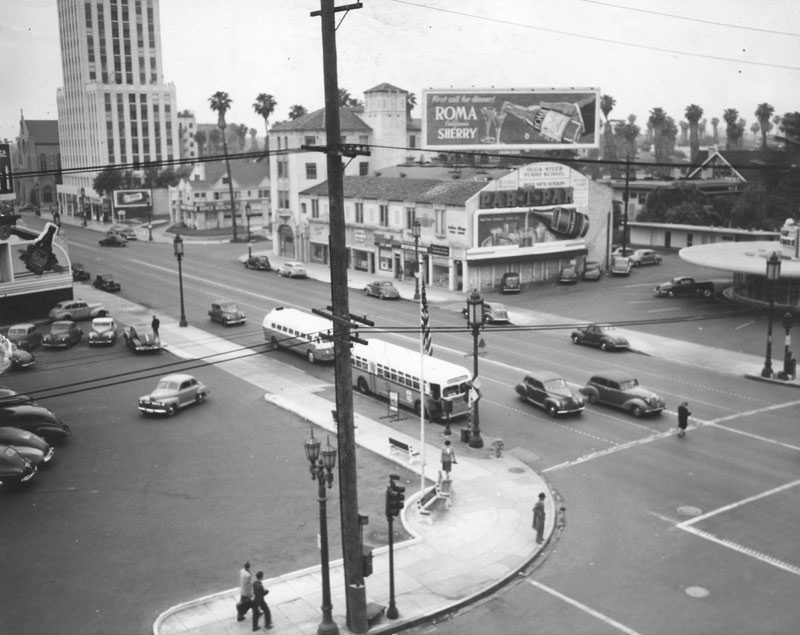 |
|
| (1946)^ - View of the intersection of Wilshire Boulevard and Western Avenue in 1946. |
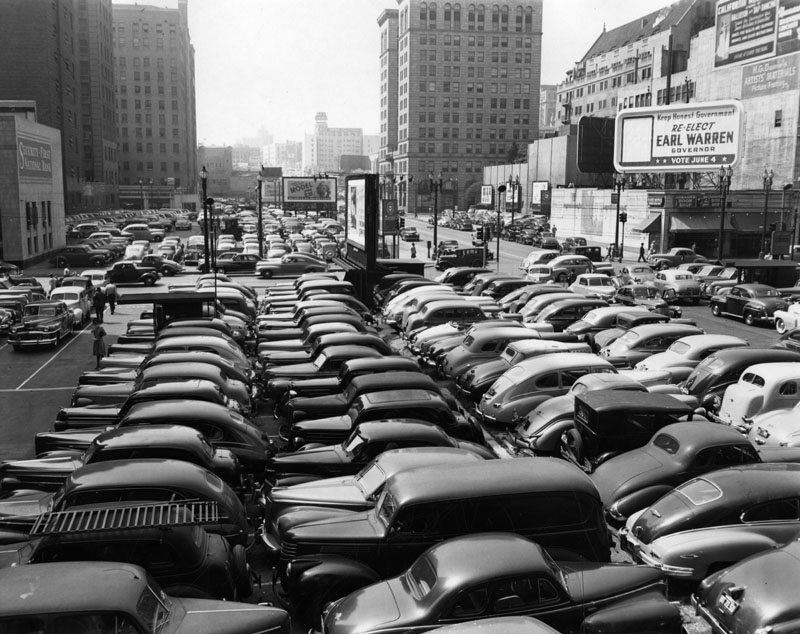 |
|
| (1946)^ - View of full parking lots located on Grand Avenue at Wilshire Blvd. A few businesses, such as Dawson's Book Shop (right) and Security First National Bank (left), are visible on Grand Avenue. A billboard asking for the re-election of Republican governor Earl Warren is seen above Dawson's and in the background is the Rex Arms. |
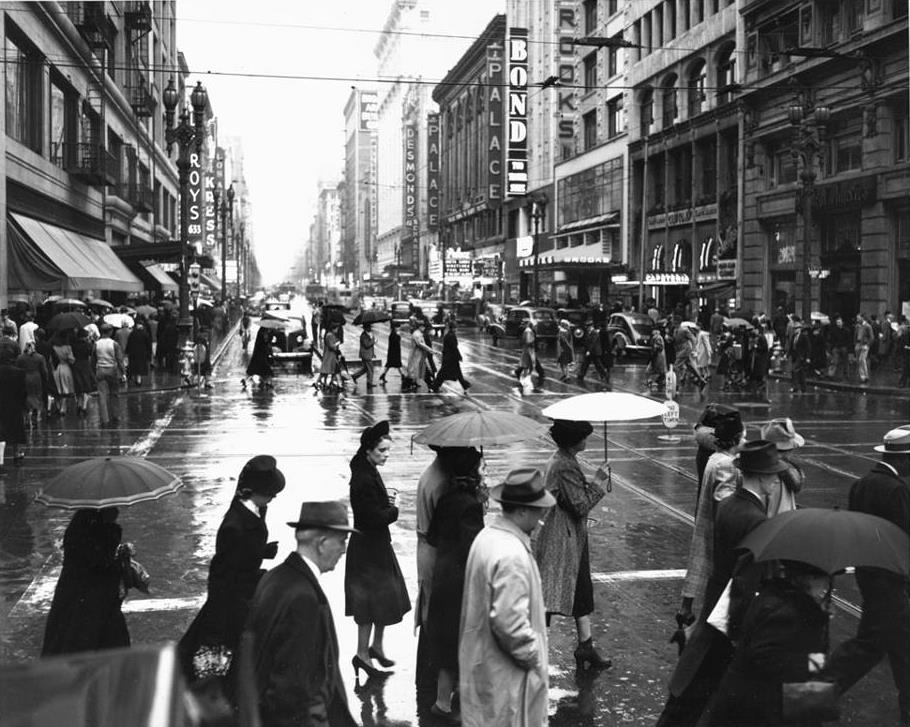 |
|
| (1940s)*# - View looking north on Broadway at 7th Street on a rainy day. Numerous signs can be seen including: Palace; Desmond's; Los Angeles Theatre; Kress; and Roys. Photo by Dick Whittington |
Civic Center
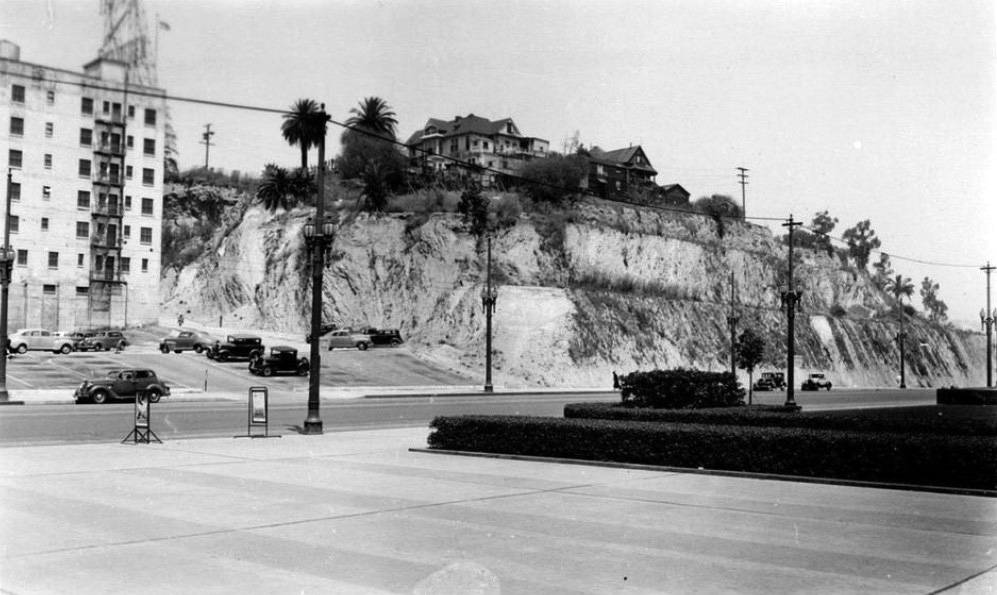 |
|
| (ca. 1940)^ – View looking northwest showing Fort Moore Hill as seen from the driveway of the recently opened Federal Courthouse and U.S. Post Office Building located at Temple and Spring streets. |
Historical Notes In the above image the back of the Alhambra Apartments is on the left (the Hall of Justice is just out-of-frame to the left) with the back of the Banning Residence, which numbers at 416 N Broadway, sitting on top of the hill pretty much dead center. To the right of the Banning house is the back of the Milo Baker house. Behind the Alhambra Apartments we can just make out the looming framework of the huge 'It's in the Examiner' sign which was mounted above the Broadway Tunnel. The adjacent flagpole was also mounted above the tunnel entrance. |
 |
|
| (1946)^*# - Panoramic view of the Los Angeles Civic Center, as seen from Broadway, March 11, 1946. |
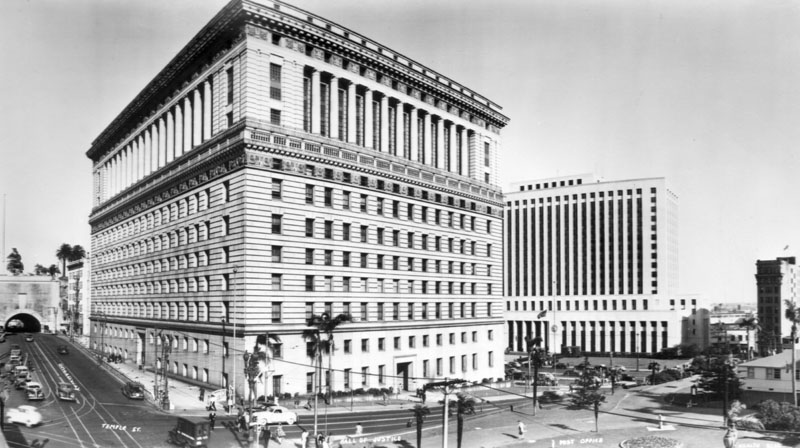 |
|
| (1946)^ - The Hall of Justice, with the U. S. Post Office behind. On the left is the old Broadway Tunnel. |
Historical Notes The Hall of Justice is the oldest structure in the civic center. It was the centerpiece of the Los Angeles County justice system until it was damaged in the Northridge earthquake. The historic 1925 building was featured on television shows including Dragnet, Perry Mason and Get Smart. More significantly, it was the home of Los Angeles County courts, the Los Angeles County Coroner, the Los Angeles County Sheriff's Office, and the Los Angeles County District Attorney, and was for many years the primary Los Angeles County jail. The Hall of Justice was closed shortly after the 1994 Northridge earthquake and is currently being restored. It is scheduled to re-open as the Sheriff's and District Attorney's Headquarters in 2014. |
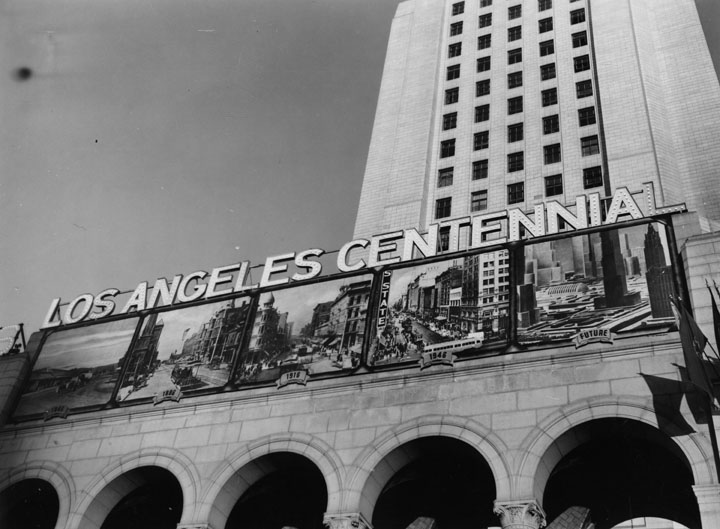 |
|
| (1946)^ - Exterior of Los Angeles City Hall decorated for the centennial ceremony commemorating the first raising of the American flag in Los Angeles in 1846. The display includes enlarged historic depictions of downtown Los Angeles at 1846, 1886, 1916, and 1946; the last one shows what the city may look like in the future. Twenty-five thousand people attended the event. Photograph dated August 13, 1946. |
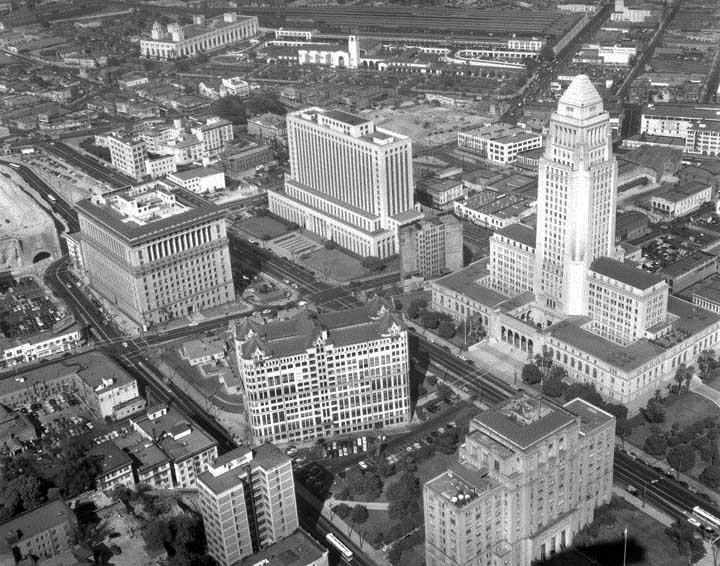 |
|
| (1947)* - Photo of the Los Angeles Civic Center taken from the Goodyear blimp. Shown are the State Building, Hall of Records, Hall of Justice, Federal Building, International Bank Building, and City Hall. |
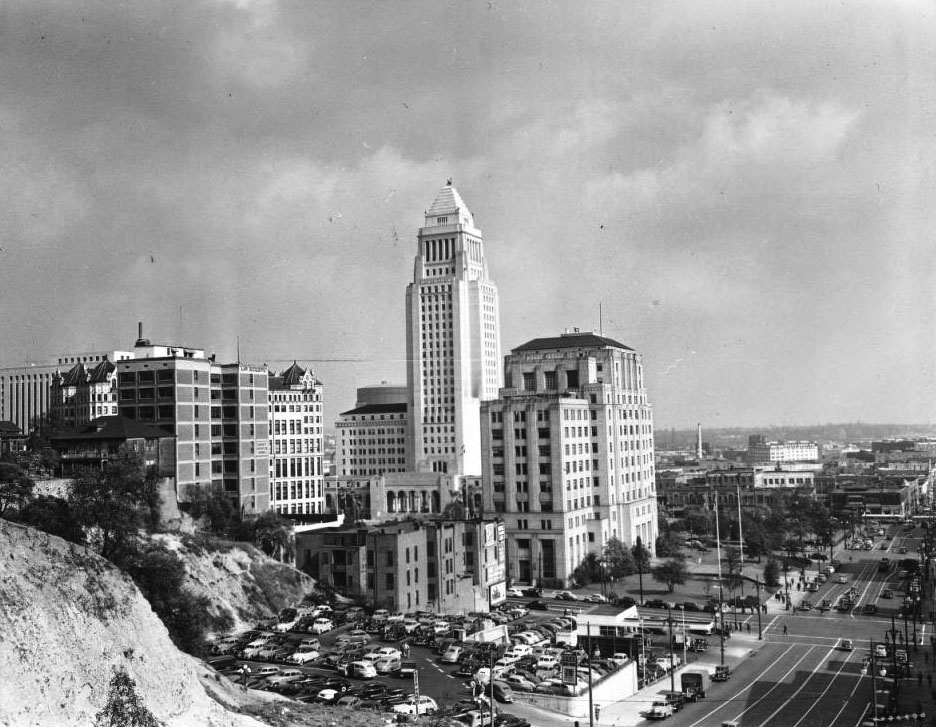 |
|
| (ca. 1940s)*# - View looking northeast from Bunker Hill showing City Hall and the State Building. To the lower right can be seen 1st Street. |
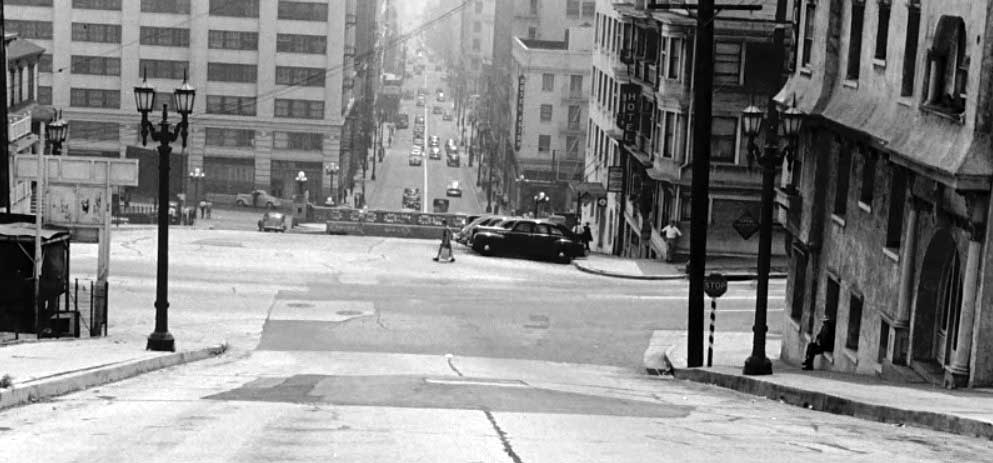 |
|
| (ca. 1945)* - Panoramic view looking east down 2nd Street from west of Olive. |
* * * * * |
Third Street Tunnel (Western Portal)
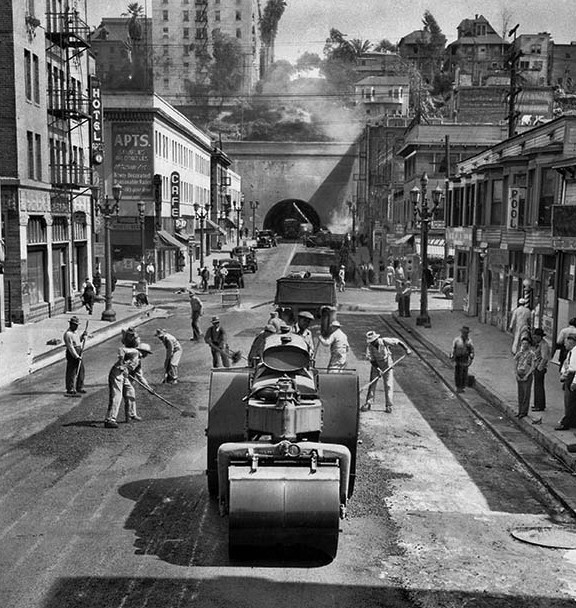 |
|
| (1944)* - View looking east showing a construction crew repaving Third Street. In the background is the western portal of the Third Street Tunnel (43 years after it originally opened). Above the tunnel sit multi-story buildings, the largest being the Alta Vista Apartments. |
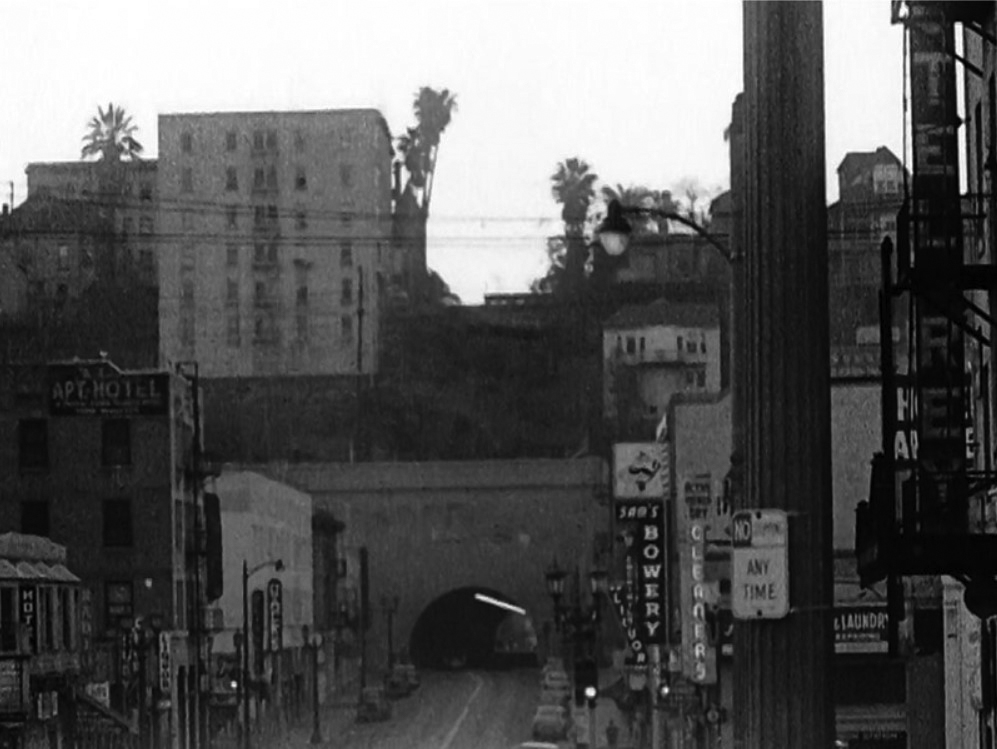 |
|
| (1956)* – View looking east toward Bunker Hill’s Third Street Tunnel. The white Alta Vista Apartments at 255 S. Bunker Hill Avenue looms above the western end of the tunnel. |
Historical Notes John Fante lived in the Alta Vista Apartments during the Depression in a room on the bottom left, and later wrote about the place (calling it the Alta Loma) in his 1939 novel, Ask the Dust: "It was built on a hillside in reverse, there on the crest of Bunker Hill, built against the decline of the hill, so that the main floor was on the level with the street but the tenth floor was downstairs ten levels." In 1950 director Joseph Losey shot several scenes inside and outside the Alta Vista for his film noir classic, M. To the right of the building are the park benches at the top of Third Street, which appeared in several movies, including M, Angel's Flight, This Rebel Breed, and Little Shop of Horrors. |
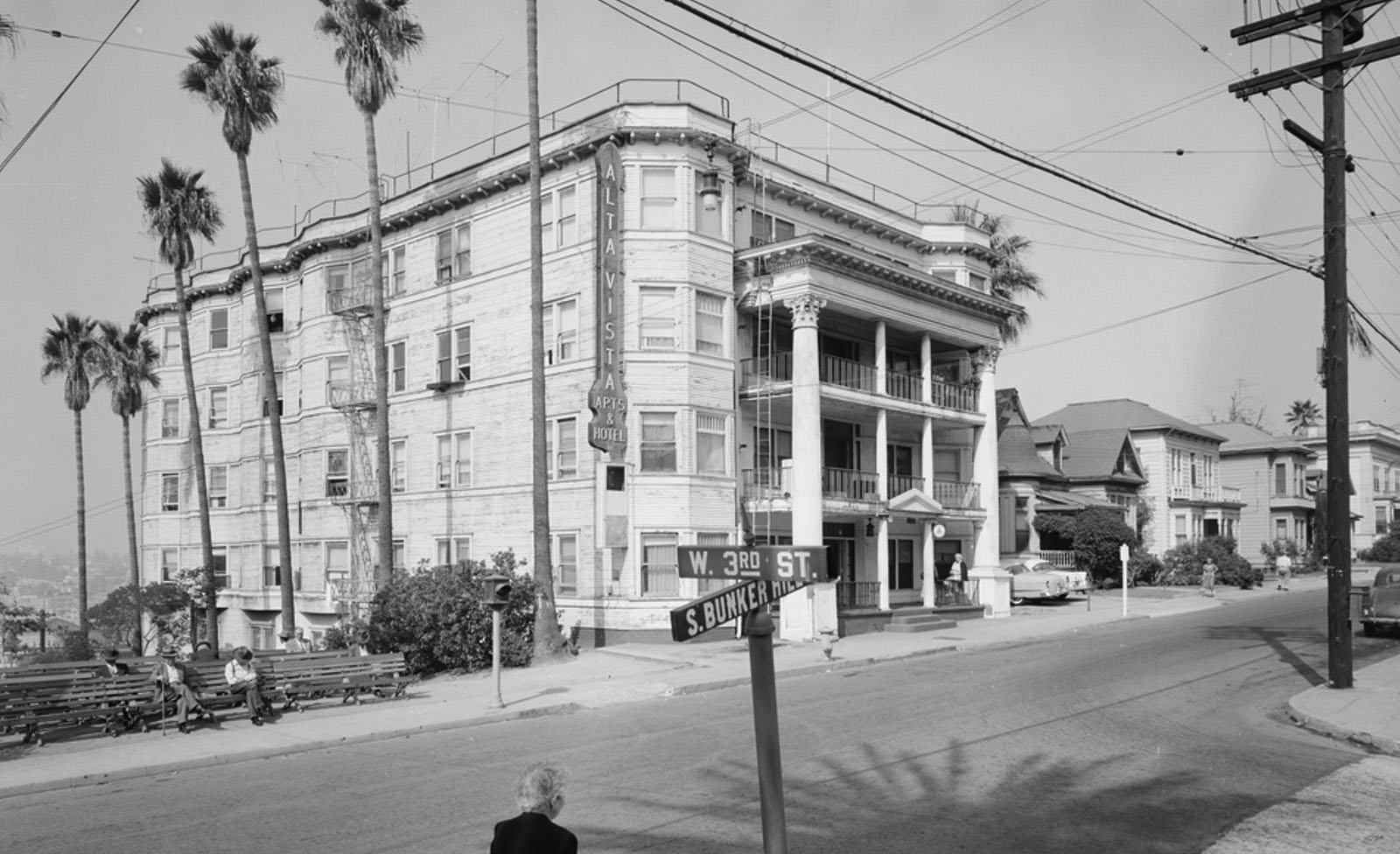 |
|
| (1955)* – View looking northwest directly above the 3rd Street Tunnel showing the Alta Vista Apartments with palm trees lining the south side of the building. Several men are seen sitting on benches at the edge of the hill on top of the tunnel's western portal. Photo by Leonard Nadel |
Historical Notes The Alta Vista Apartment building was demolished in the mid-1960s as the CRA slowly cleared the hill for commercial development. |
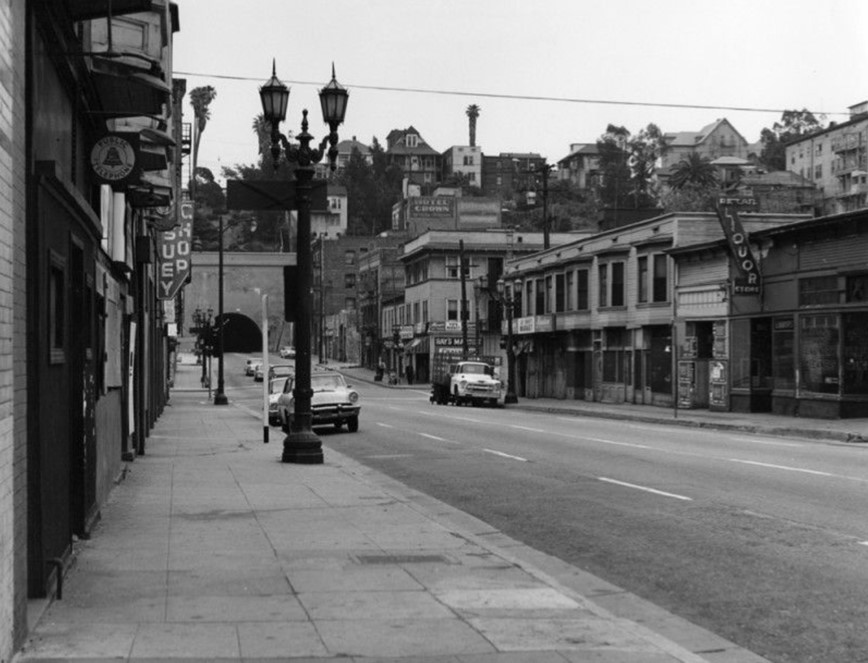 |
|
| (1963)* – Looking east on 3rd Street toward Flower Street with the western portal ot the 3rd Street Tunnel seen in the distance. Photo by William Reagh |
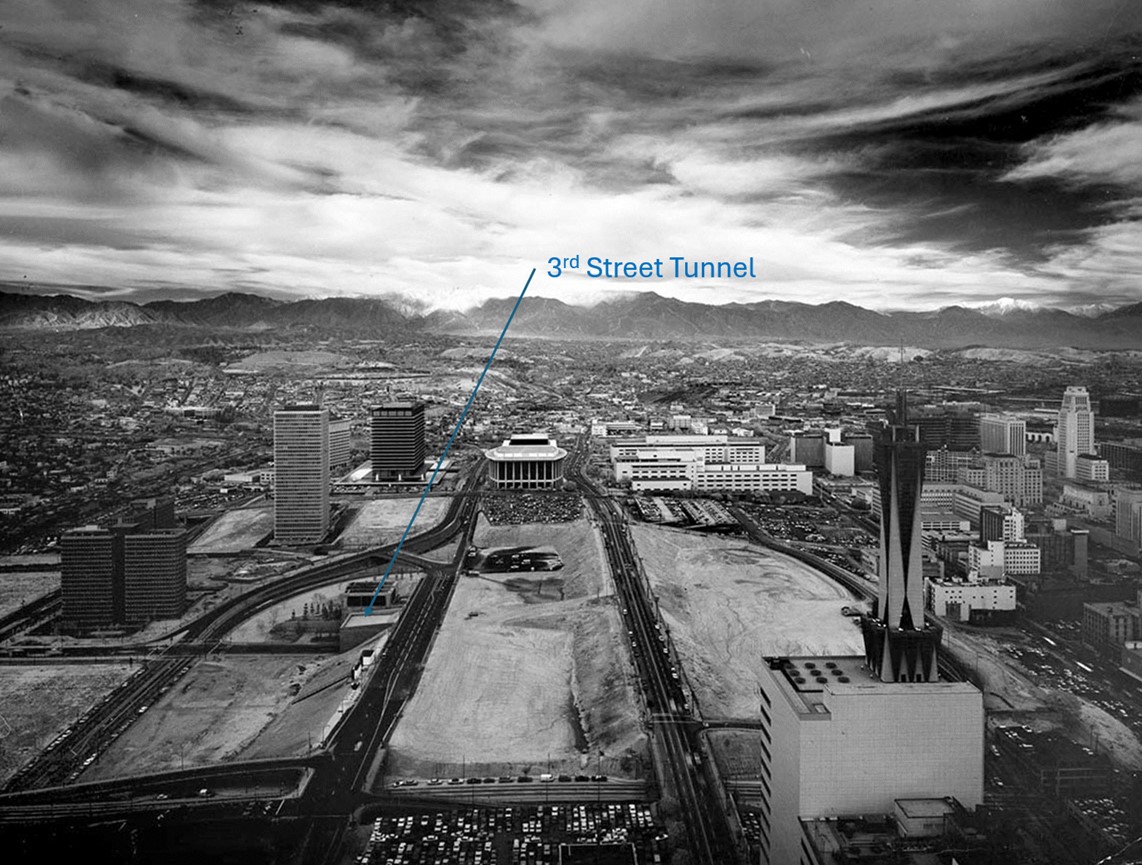 |
|
| (1971)* – Aerial view looking north over the Bunker Hill Redevelopment area on a stormy-looking day with the west portal of the 3rd Street Tunnel seen at lower center-left. Photo by Julius Shulman |
Historical Notes In 1955, Los Angeles city planners decided that Bunker Hill required a massive "slum clearance" redevelopment project. This was enabled by the California Community Redevelopment Law of 1945 and federal housing acts. The redevelopment project, which lasted decades, involved demolishing over 400 Victorian mansions and displacing around 6,000 mostly low-income residents to make way for modern high-rise developments. The project was highly controversial, with fierce opposition from residents and critics who saw it as an "anti-human" and "inhuman" destruction of a historic neighborhood in favor of profit-driven development. Despite the criticism, the redevelopment went forward, lowering the elevation of Bunker Hill and replacing the old buildings with skyscrapers, residences, commercial spaces, and other structures starting in the 1980s. |
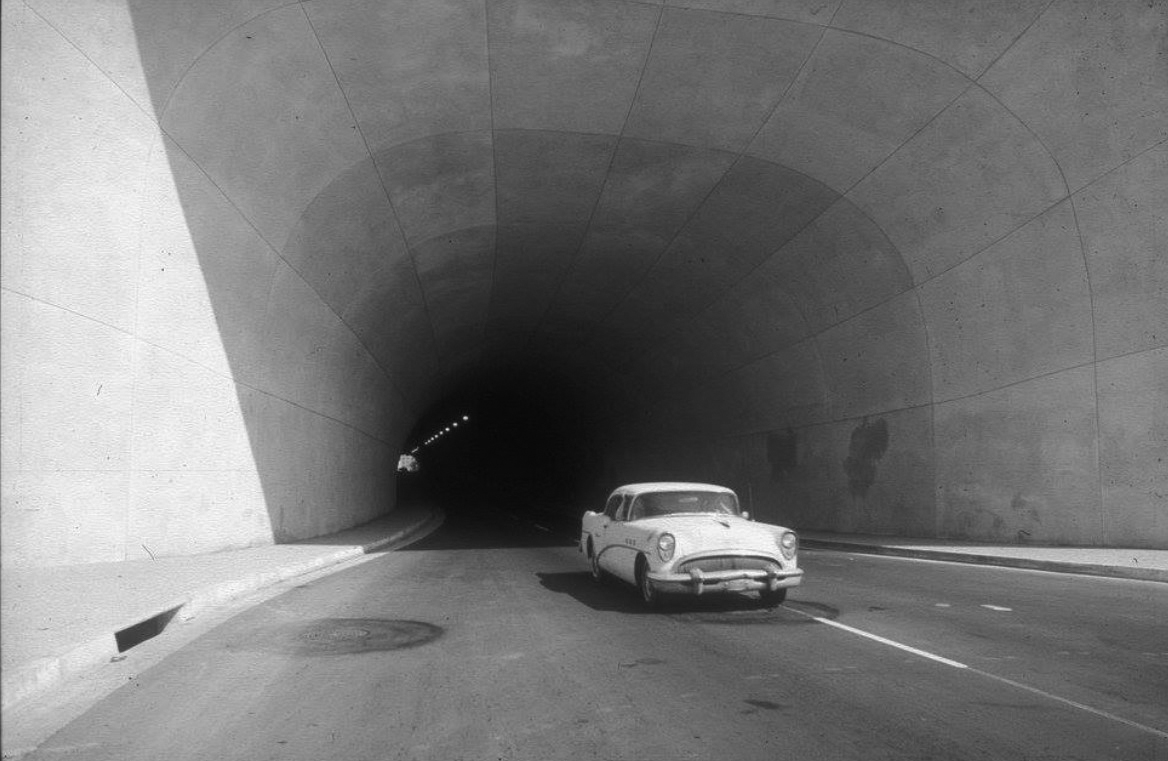 |
|
| (ca. 1968)* - A 1954 Special 2-door Buick Riviera hardtop through Bunker Hill’s Third Street Tunnel “like a small white baleen sea creature venturing out of its lair for some grub and adventure!” |
Historical Notes On June 18th, 1968, the 3rd street tunnel reopened to traffic after a nine month closure in which the tunnel was extended 118 feet. The work was part of $22.8 million in public works projects done for Bunker Hill redevelopment. |
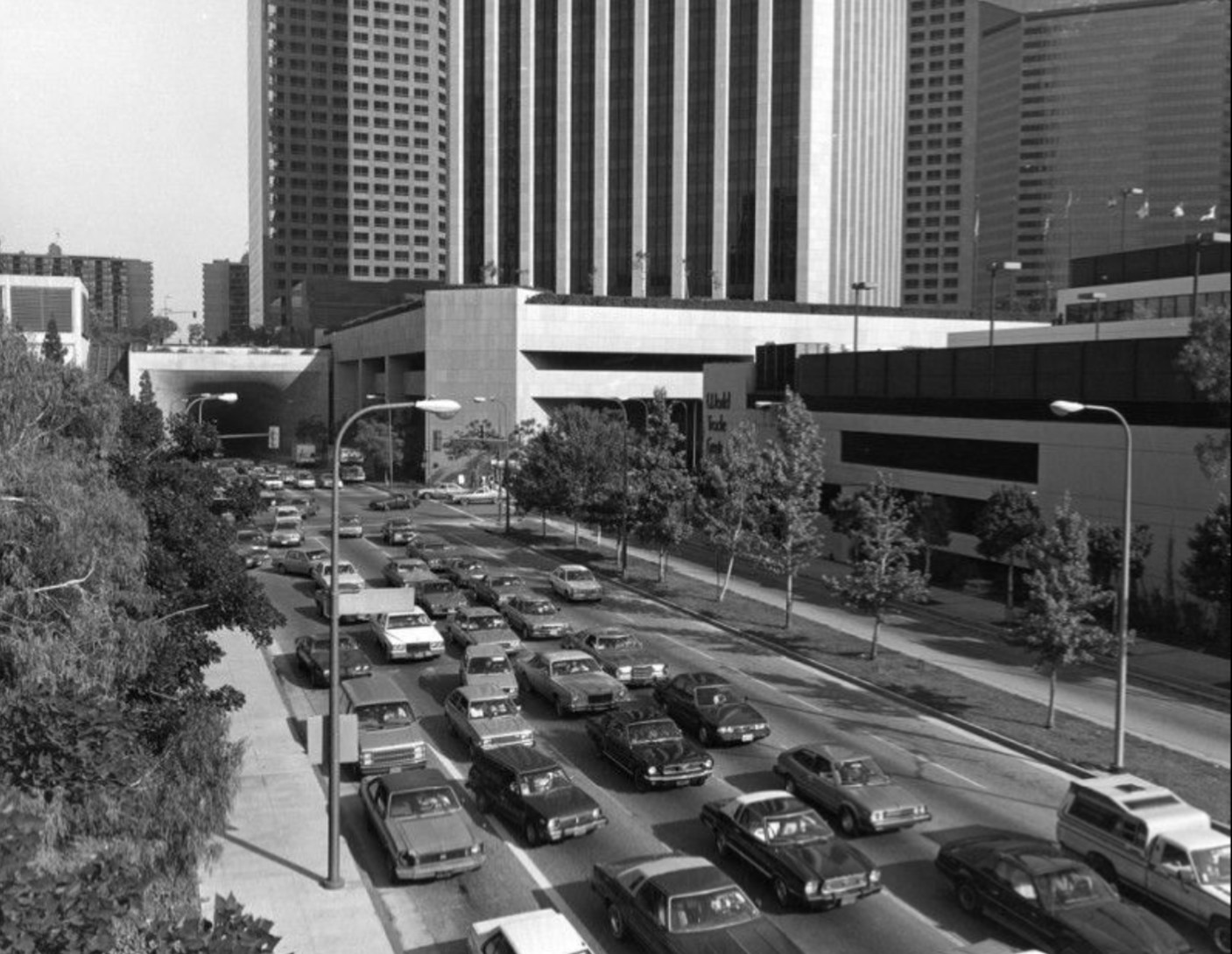 |
|
| (1985)* - Loking east on 3rd Street toward Flower Street and the 3rd Street Tunnel. Office towers are now seen on Bunker Hill. Photo by William Reagh |
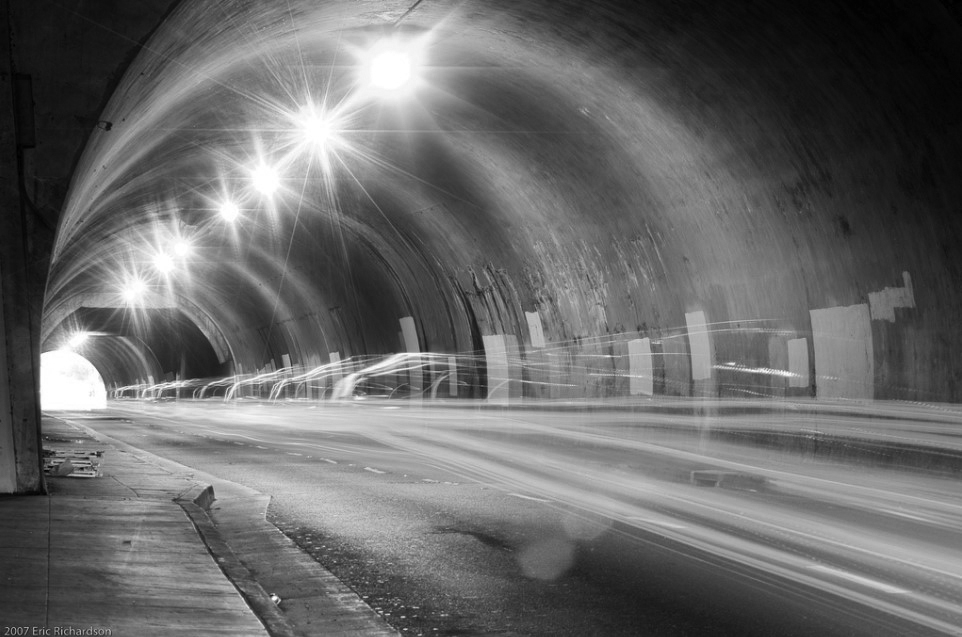 |
|
| (2007)* – View of the Third Street Tunnel from the Hill Street side (looking west). Photo by Eric Richardson |
Historical Notes In 1983 the tunnel again saw a lengthy closure, this time for eight months as work was done to replace the tunnel's center section as part of the construction of California Plaza above. |
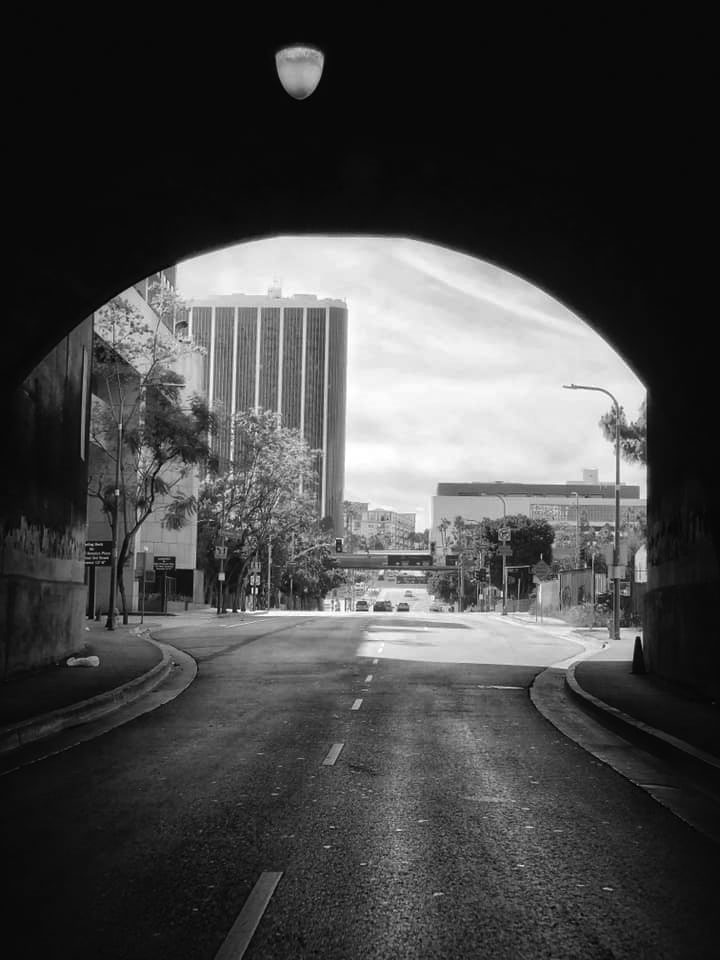 |
|
| (2021)^ - Looking out the western portal of the Third Street Tunnel. Photo by Carlos G. Lucero |
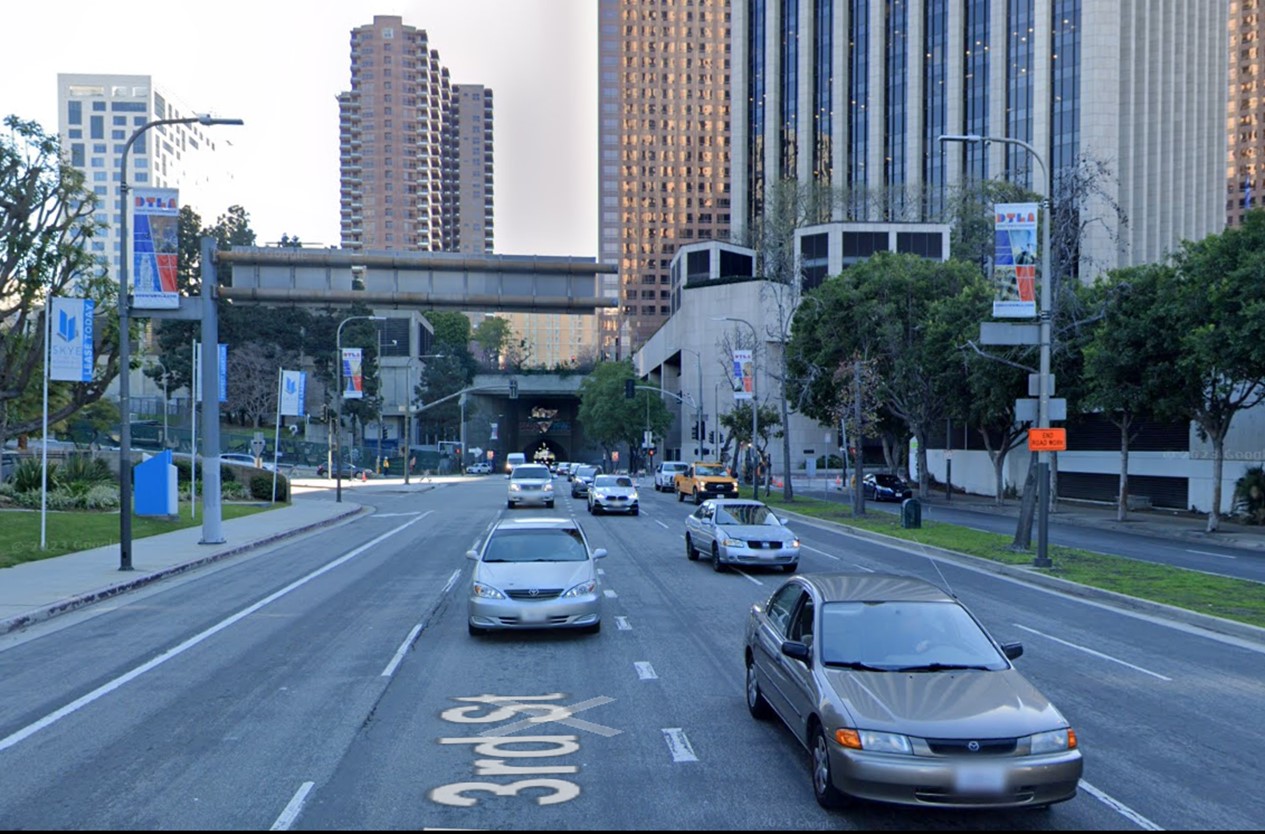 |
|
| (2023)* – Looking east on 3rd Street toward Flower Street with the western portal of the 3rd Street Tunnel seen in the distance. |
Then and Now
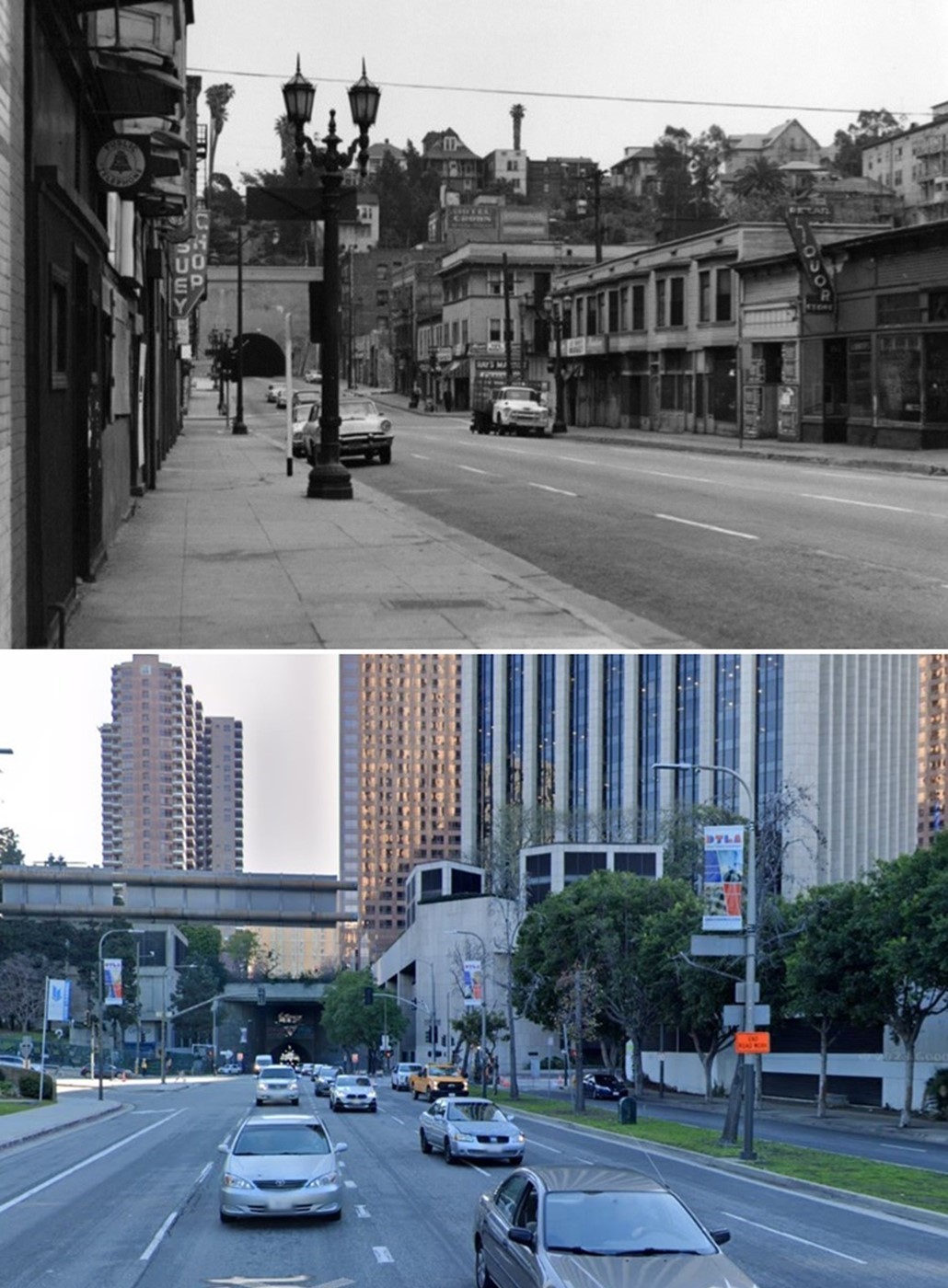 |
|
| (1963 vs 2023)* – Looking east on 3rd Street toward Flower Street with the western portal of the 3rd Street Tunnel seen in the distance. |
Then and Now
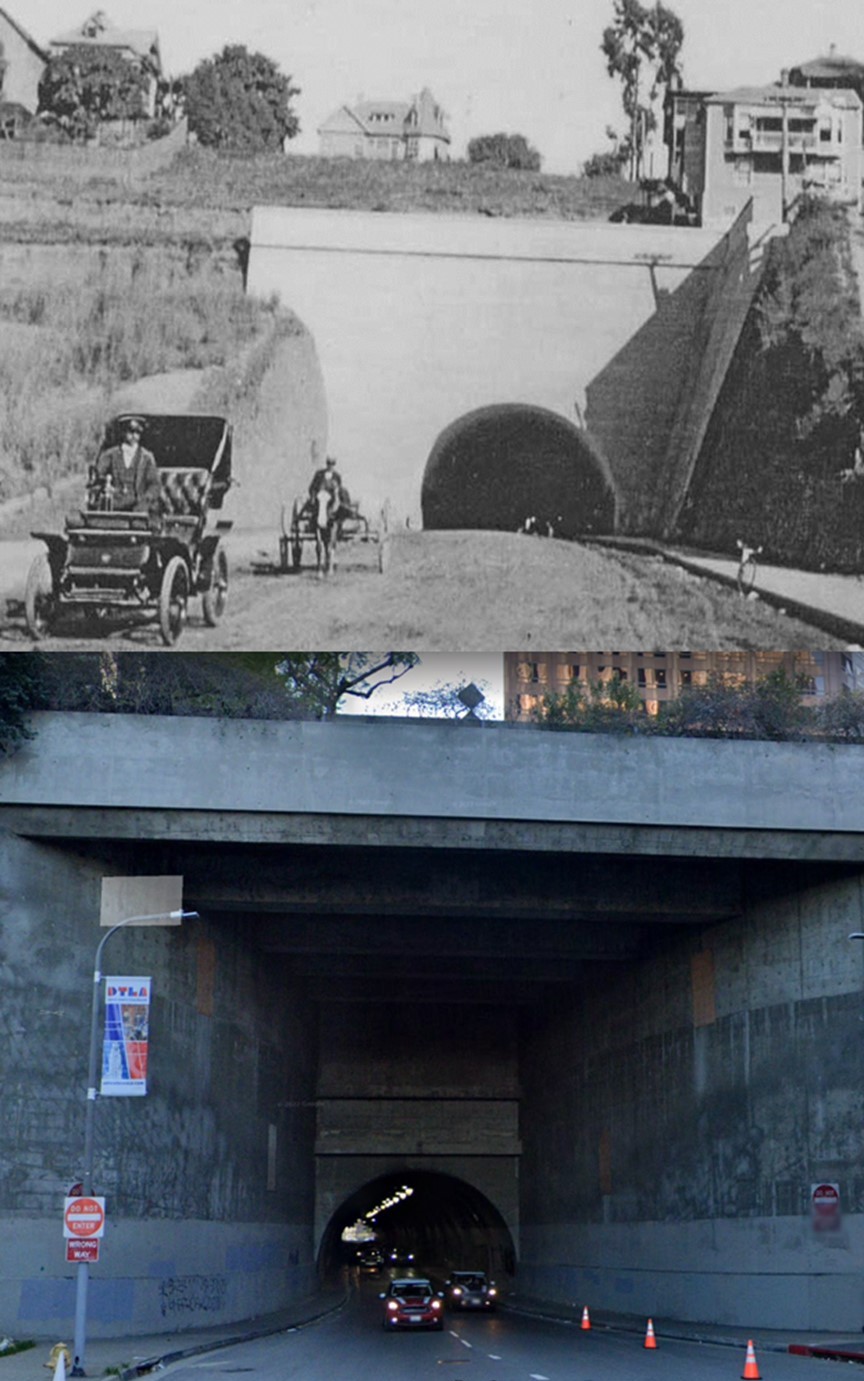 |
|
| (1903 vs. 2022)*- Looking east toward the western portal of the Third Street Tunnel. |
Historical Notes Click HERE to see more Early Views of the Third Street Tunnel (Early 1900s). |
Third Street Tunnel (Eastern Portal)
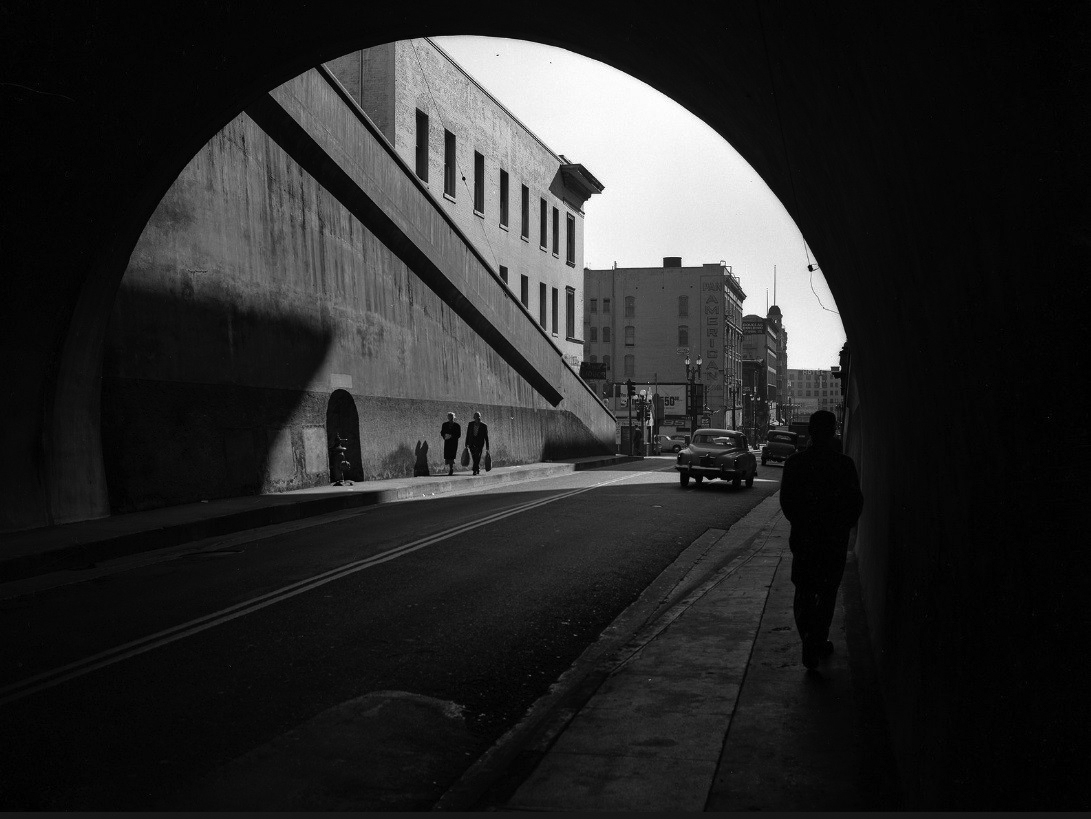 |
|
| (ca. 1950)^ – View looking east toward Hill Street from the 3rd Street Tunnel. |
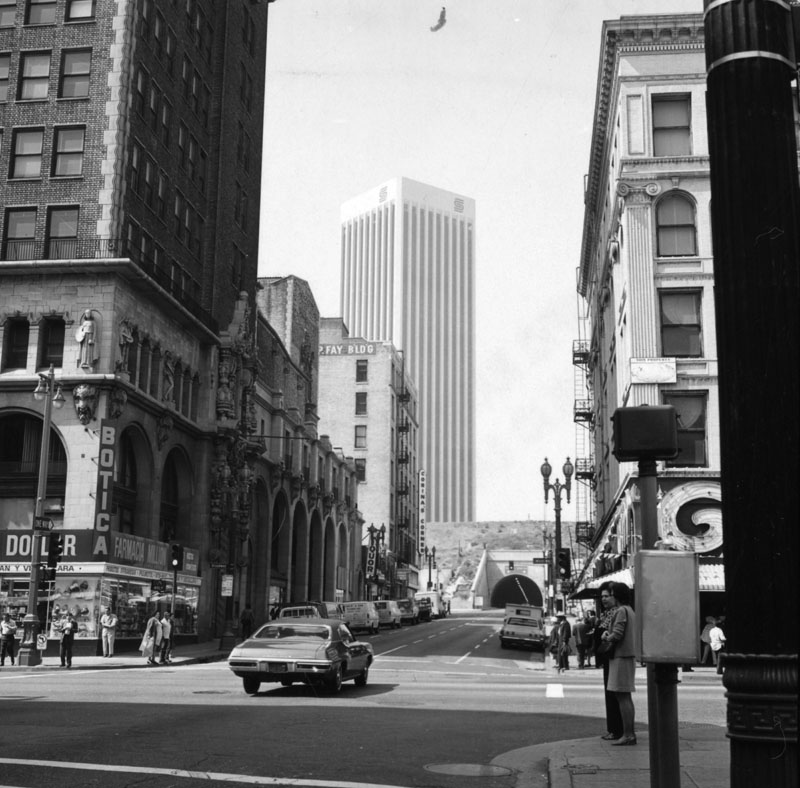 |
|
| (ca. 1975)^ - A view of 3rd Street as it crosses Broadway, looking west towards the 3rd St. Tunnel (built in 1901) showing Bunker HIll with all of its old buildings now gone. The recently completed 55-story Security Pacific Plaza Building stands in the background. |
 |
|
| (1978)^ - View showing the Third Street Tunnel at Hill Street during excavation of Bunker Hill. |
Historical Notes Click HERE to see more Early Views of the Third Street Tunnel (Early 1900s). |
* * * * * |
Long Beach-Los Angeles Harbor
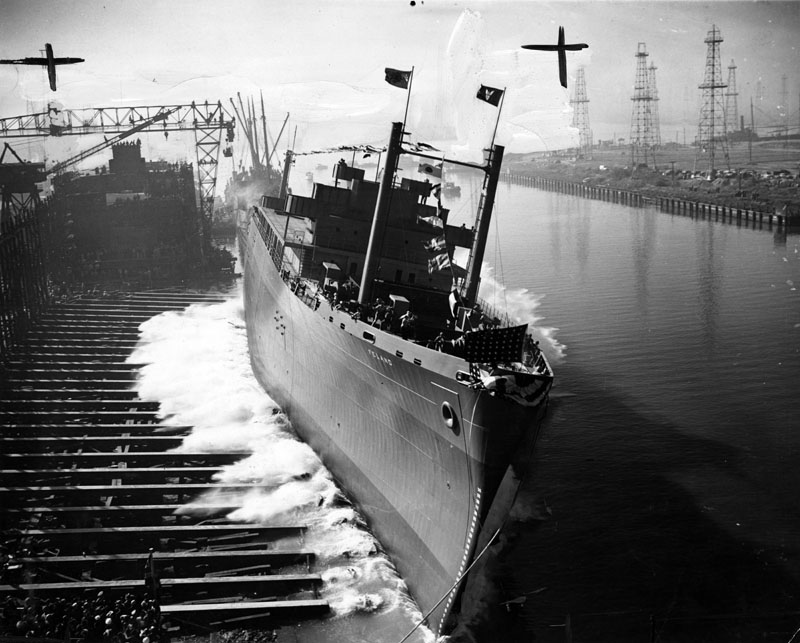 |
|
| (1946)^ - View of a troop transport, built and launched at Consolidated Steel Corporation's Long Beach Shipbuilding Division. |
Historical Notes Consolidated Steel Corporation was formed in 1929 from the amalgamation of Llewellyn Iron Works, Baker Iron Works and Union Iron Works. It started its shipbuilding operation at a leased shipyard in Long Beach, which was the former Craig Shipbuilding, but built a wholly new shipyard in Wilmington in 1941, with four ways, in the second wave of shipbuilding expansion, with $13mm invested by the USMC. Four more ways were added in the third wave of shipbuilding expansion and, at its peak, the Wilmington shipyard employed 12,000 people. After the war the two shipyards were liquidated. The Long Beach yard was on the west side of Channel Three of the Inner Harbor, although its full extent is not clear. The Wilmington yard was where the Port of Los Angeles' TraPac container terminal is now.*### Click HERE to see more Early Views of San Pedro and Wilmington. |
 |
|
| (1947)+++# – With Howard Hughes at the controls, the 'Spruce Goose' begins its first series of taxi tests. The Long Beach skyline is seen in the background. |
Historical Notes The Hughes H-4 Hercules was originally contracted by the U.S. government for use during World War II to transport troops and equipment across the Atlantic as an alternative to sea-going troop transport ships that were vulnerable to German U-boats. However the aircraft was not completed until after the end of World War II. The concept for the Hercules was originally conceived by industrialist Henry J. Kaiser, who teamed with Hughes to build the aircraft.^* |
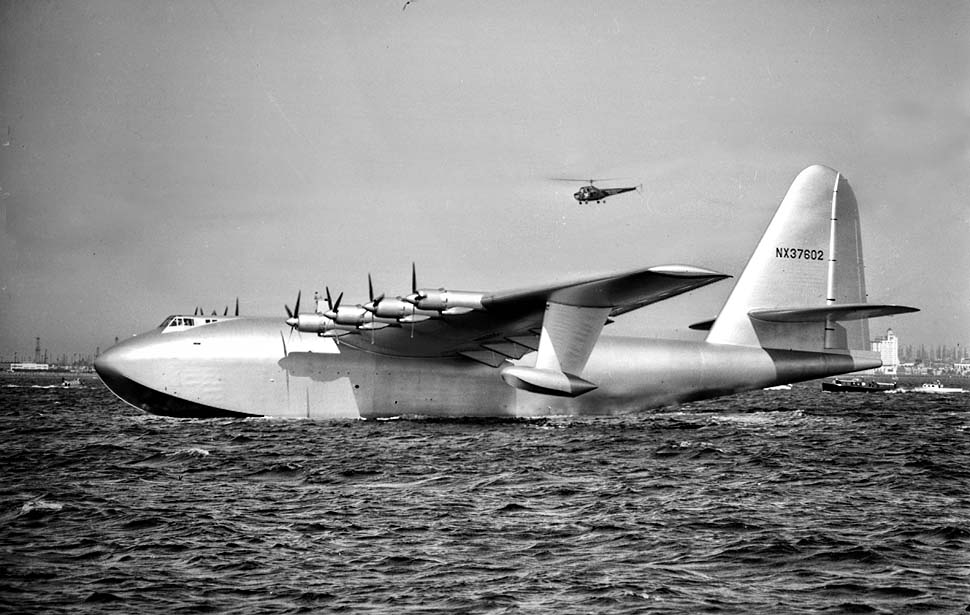 |
|
| (1947)^^ - The Hughes Aircraft H-4 Hercules "Spruce Goose" during taxi tests in the Long Beach-Los Angeles Harbor. Howard Hughes is at the controls. |
Historical Notes The aircraft made its first and only flight on November 2, 1947, and the project never advanced beyond the single example produced. Built from wood because of wartime restrictions on the use of aluminum and concerns about weight, its critics nicknamed it the "Spruce Goose", despite its being made almost entirely of birch rather than spruce. The Hercules is the largest flying boat ever built and has the largest wingspan of any aircraft in history. It survives in good condition at the Evergreen Aviation Museum in McMinnville, Oregon.^* |
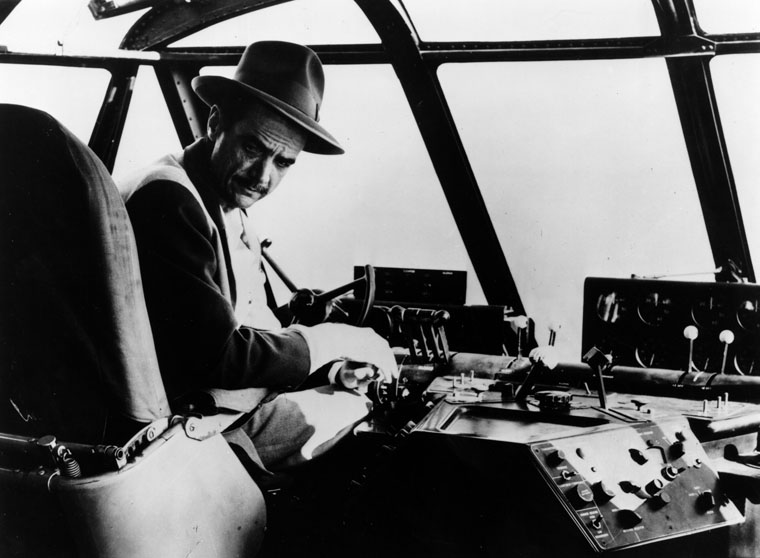 |
|
| (ca. 1947)^ - Howard Hughes getting the feel of the cockpit in his famous "Spruce Goose" seaplane. |
Historical Notes Howard Robard Hughes, Jr. (December 24, 1905 – April 5, 1976) was a business magnate, investor, aviator, aerospace engineer, film maker and philanthropist. He was one of the wealthiest people in the world. As a maverick film producer, Hughes gained prominence in Hollywood from the late 1920s, making big-budget and often controversial films like The Racket (1928), Hell's Angels (1930), Scarface (1932) and The Outlaw (1943). Hughes was one of the most influential aviators in history: he set multiple world air speed records, built the Hughes H-1 Racer and H-4 "Hercules" (better known to history as the "Spruce Goose" aircraft), and acquired and expanded Trans World Airlines, which would later on merge with American Airlines. Hughes is also remembered for his eccentric behavior and reclusive lifestyle in later life, caused in part by a worsening obsessive–compulsive disorder and chronic pain. His legacy is maintained through the Howard Hughes Medical Institute.^* |
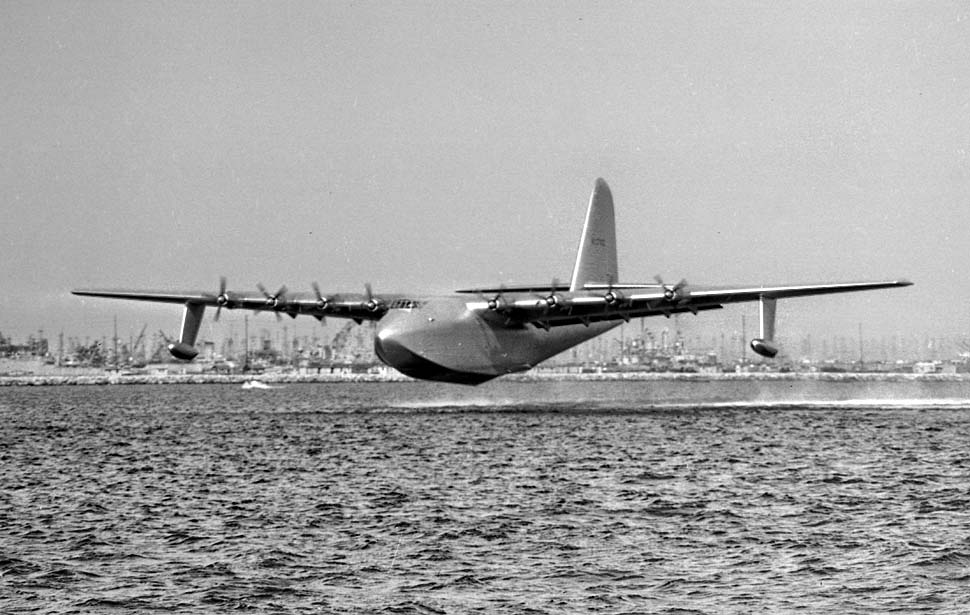 |
|
| (1947)^^ - The Hughes Aircraft H-4 Hercules "Spruce Goose" during short flight in the Long Beach-Los Angeles Harbor. |
Historical Notes The Hercules flew only once for one mile, and 70 feet above the water, with Hughes at the controls.^* Hughes piloted the boat on a course roughly paralleling the shoreline from Terminal Island Navy Base to offshore from Pier A in Long Beach. In addition to the multimillionaire plane-maker, 30 engineers, technicians and observers were aboard the plywood giant for its first movement under its own power.^^ |
Click HERE to see more in Aviation in Early L.A. |
Union Station
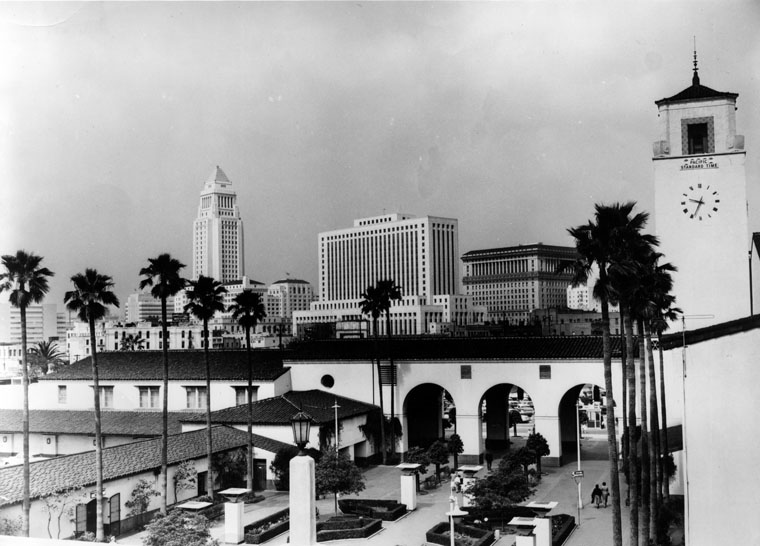 |
|
| (ca. 1947)^ - Los Angeles Civic Center skyline is seen from Union Station. |
Historical Notes In 1926, a measure was placed on the ballot giving Los Angeles voters the choice between the construction of a vast network of elevated railways or the construction of a much smaller Union Station to consolidate different railroad terminals. The election would take on racial connotations and become a defining moment in the development of Los Angeles. The proposed Union Station was located in the heart of what was Los Angeles' original Chinatown. Reflecting the prejudice of the era, the conservative Los Angeles Times, a lead opponent of elevated railways, argued in editorials that Union Station would not be built in the “midst of Chinatown” but rather would “forever do away with Chinatown and its environs.” Voters approved demolishing much of Chinatown to build Union Station by a narrow 51 to 48 percent. When Union Station was opened in May 1939, it consolidated remaining service from its predecessors La Grande Station and Central Station. It was built on a grand scale and became known as "Last of the Great Railway Stations" built in the United States.^* |
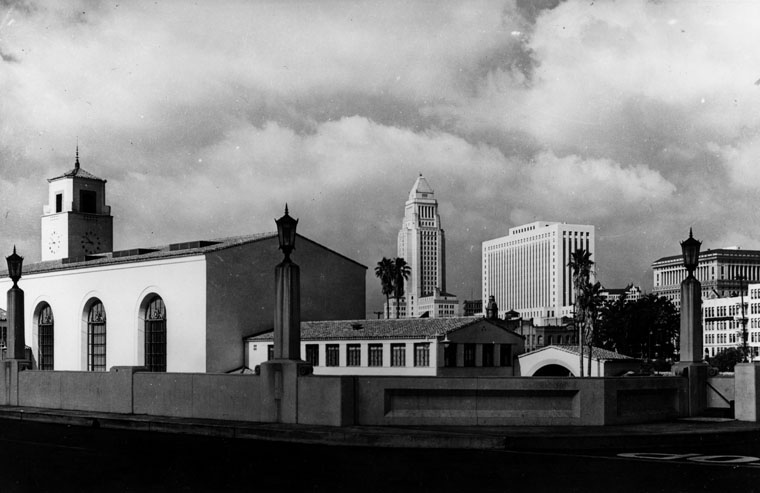 |
|
| (1947)^ - Exterior view of L.A. Union Station. View is looking southwest from Union depot. City Hall is in the background. |
Historical Notes Union Station was placed on the National Register of Historic Places in 1980. It also is listed as Los Angeles Historic-Cultural Monument No. 101. Click HERE to see the LA Historic-Cultural Monuments list. |
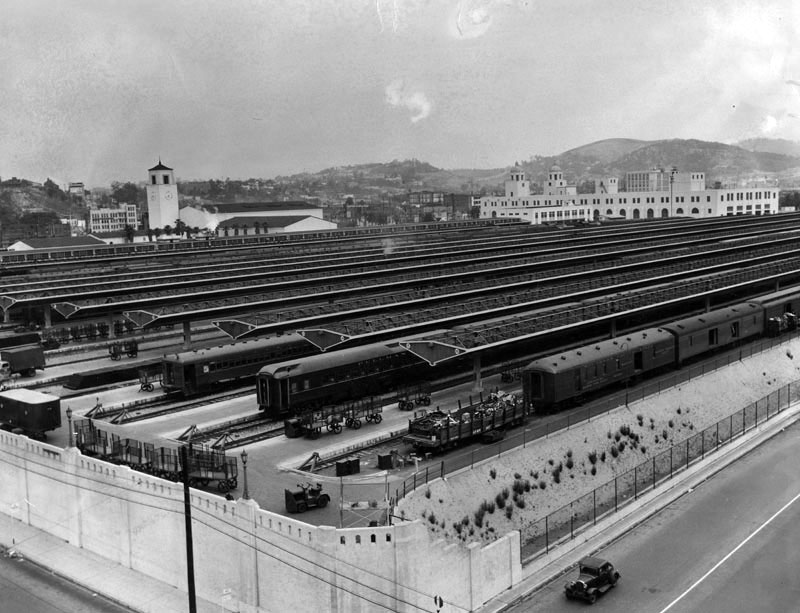 |
|
| (1946)^ - Trains stranded in Los Angeles Union Station during a rail labor strike on May 24, 1946, include a former electric interurban car on the left in Track 12, now lettered ATSF and used for troop movement. Hundreds of coaches were parked at the station with no engines to move them. |
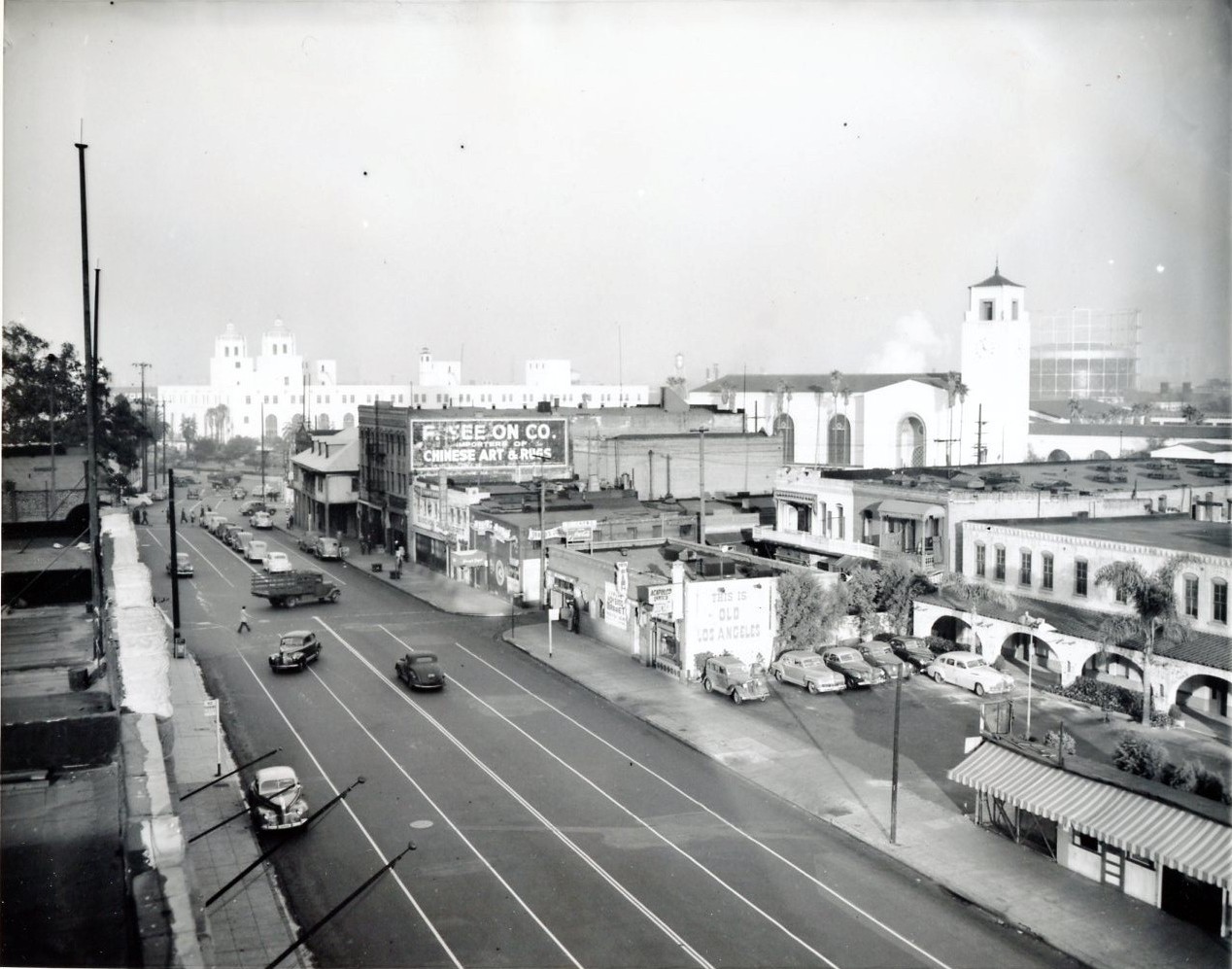 |
|
| (1947)*#^ - View of Los Angeles Street looking north. The large trees in the upper left are in the LA Plaza and across the street is the Vincent Lugo Adobe house with its distinctive hipped roof and dormer windows. In the background can be seen both the Terminal Annex Post Office and Union Station. |
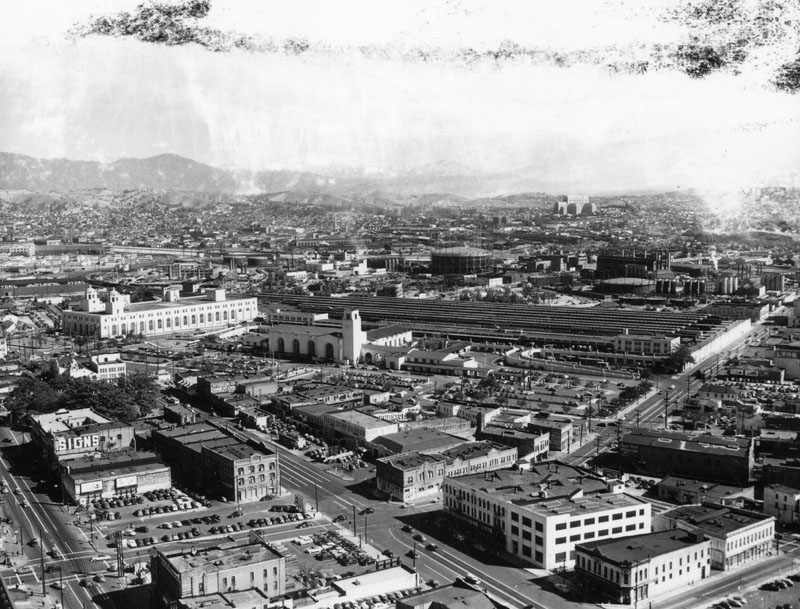 |
|
| (ca. 1940s)^ - Aerial view of Los Angeles near the Plaza before construction of the Hollywood Freeway with Union Station in the background. The Plaza is seen to the left. |
Historical Notes Union Station opened in May, 1939. The Hollywood Freeway would not be constructed until 1950. |
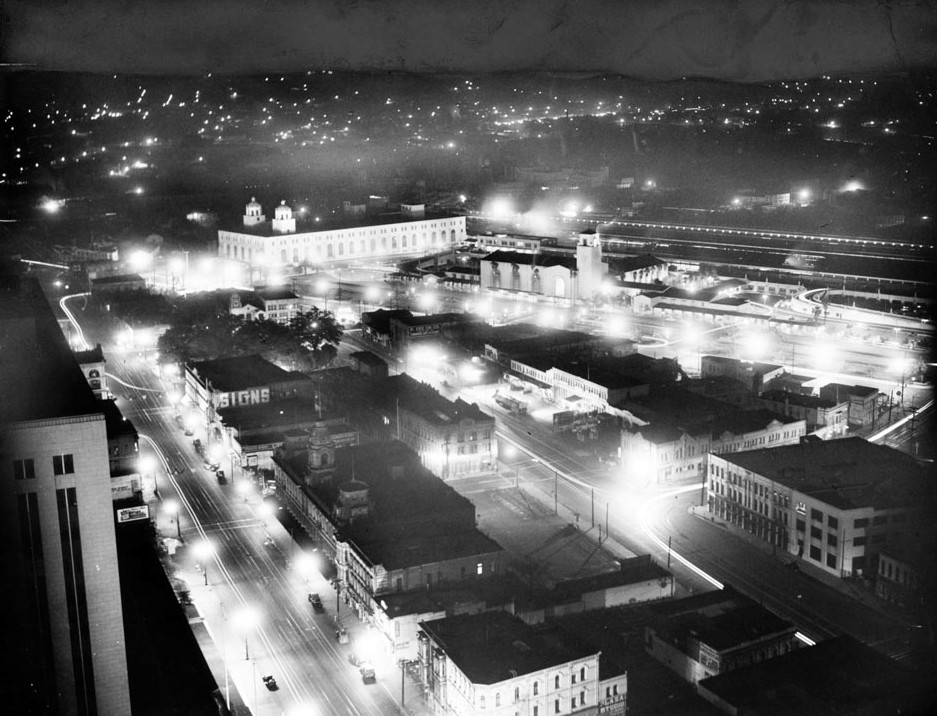 |
|
| (ca. 1940s)*# - Night view of the L.A. Plaza, Union Station, and Terminal Annex Post Office. |
* * * * * |
Los Angeles Streetcars
.jpg) |
|
| (1939)* - Main Street looking north at Ninth Street. A streetcar is seen at the stop located at the apex of the intersdction. Overhead streetcar cable is seen throughout. |
Historical Notes In downtown Los Angeles, the primary streetcar operator was the Pacific Electric Railway, commonly known as the "Red Cars." The Pacific Electric system served various neighborhoods, including downtown Los Angeles, connecting the city to its suburbs and contributing significantly to the region's transportation network. While Pacific Electric was the major player, there were also other smaller streetcar companies that operated in specific downtown areas. These included companies like the Los Angeles Railway (also known as the "Yellow Cars") and the Metropolitan Coach Lines. These companies often had their own routes and served specific neighborhoods within downtown Los Angeles. It's worth noting that the Red Cars of the Pacific Electric Railway were the most extensive and well-known streetcar network in the region, covering a large part of Los Angeles County and connecting the city with its surrounding communities. |
 |
|
| (1939)* – View looking north on Main Street at 9th and Spring Streets. The 810 South Spring Building is straight ahead with the Hotel Cecil on the right. In the foreground can be seen a car closely following a streetcar as several pedestrians are in the middle of the intersection. |
Historical Notes Note how crowded the sky is with wires here. |
 |
|
| (1948)* - Intersection of Main, Spring, and 9th streets looking north in downtown Los Angeles. A traffic officer can be seen standing in the middle of the busy intersection. |
Historical Notes This intersection had so much potential to become an iconic public space in LA, just as Latham Square is in Oakland, or Times Square is in Manhattan. But….that never materialized. |
Then and Now
 |
|
| (1948 vs. 2022)* - View looking north from 9th Street at the Main & Spring Street intersection. |
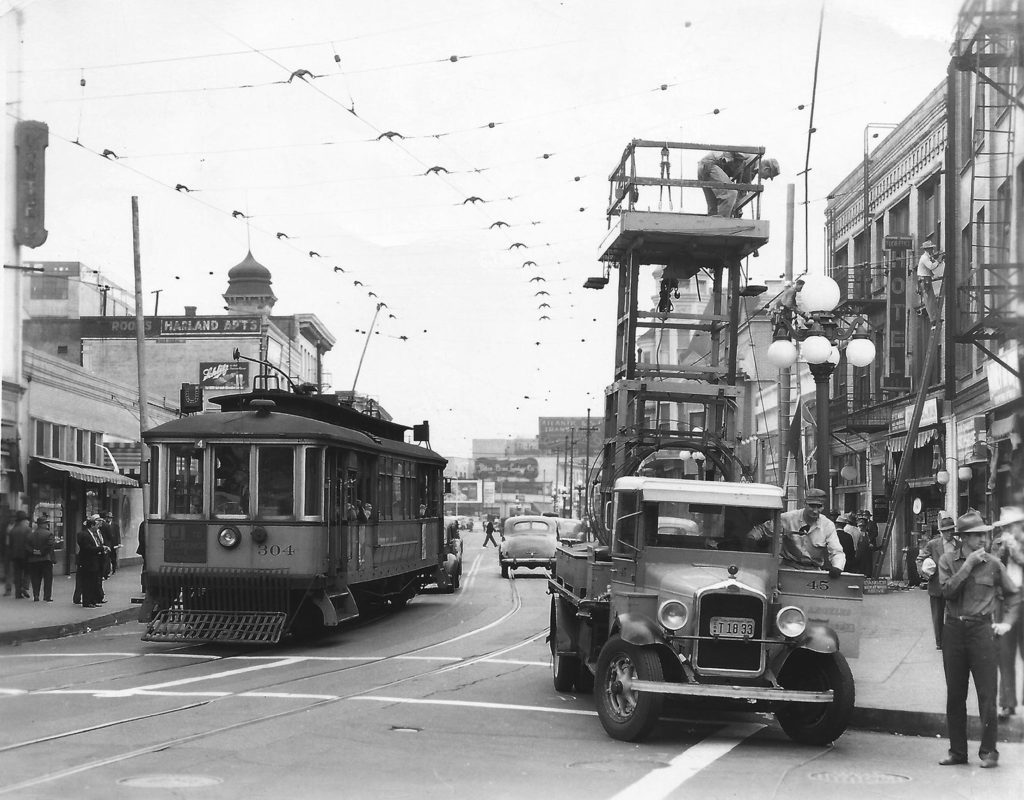 |
|
| (1947)* - Los Angeles Transit Lines (ex-Los Angeles Railway) U Line car no. 304 is captured at 5th and Wall Streets as an LATL crew installs new overhead for the trackless bus systems that will soon be deployed. Courtesy of PERHYS, Alan Weeks Collection |
Historical Notes The Los Angeles Railway (Yellow Cars, LARy) system was sold in 1945 by Huntington's estate to National City Lines, a company that was purchasing transit systems across the country. The company was renamed as Los Angeles Transit Lines and many of the lines were converted to buses in the late 1940s and early 1950s. National City Lines, along with its investors that included Firestone Tire, Standard Oil of California (now Chevron Corporation) and General Motors, were later convicted of conspiring to monopolize the sale of buses and related products to local transit companies controlled by National City Lines and other companies in what became known as the General Motors streetcar conspiracy. |
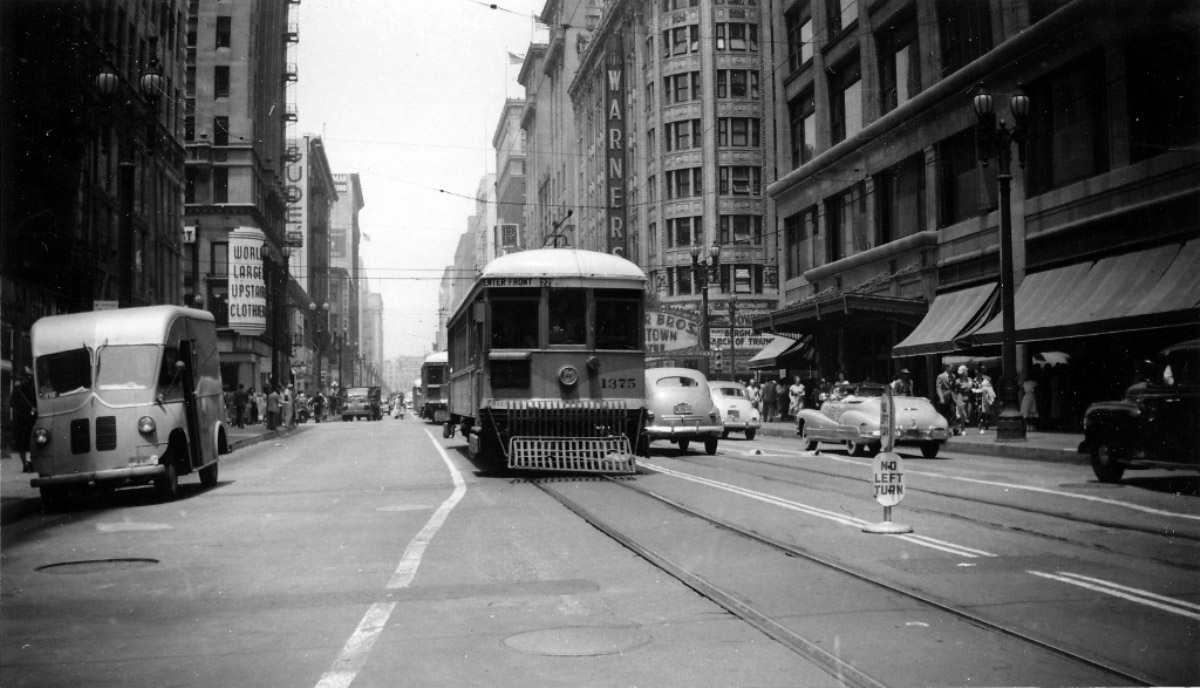 |
|
| (1948)* - Los Angeles Transit Lines R Line car no. 1375 as seen at 7th and Broadway, looking west. Courtesy of PERHYS, Alan Weeks Collection |
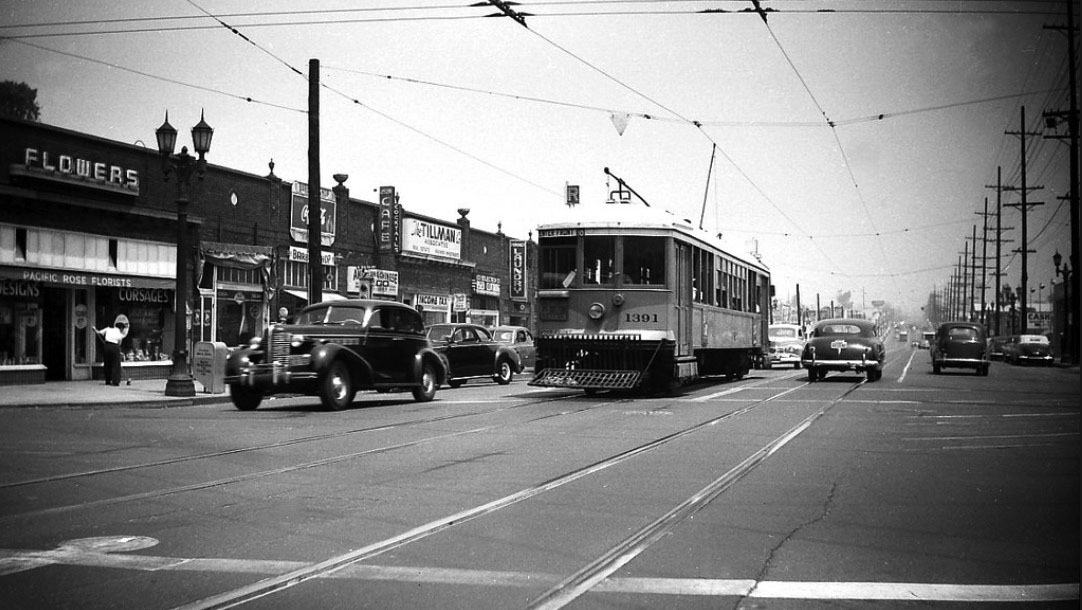 |
|
| (1948)* - View showing Los Angeles Transit R Line car no. 1391 heading south on Vermont Avenue at 6th Street. Courtesy of PERHYS, Alan Weeks Collection |
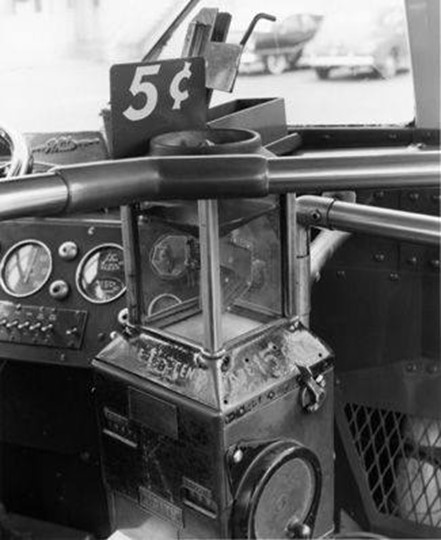 |
|
| (1940s)* – Bus coin box. Shown here is the Johnson "D" box. |
Historical Notes The one big thing that finished off the D boxes was the movement in the late 1960’s where street car and bus operators carried no change. This was done to curb the rash of robberies of transit personnel. When this policy was put into effect, transit systems were required to have fare boxes with vaults. In 1970 when Los Angeles went to an exact fare policy, all D boxes were withdrawn from service. Prior to the 1940s, base fares on local transit lines had remained at 5 cents for an astounding 51 years. The 7-cent fare that was in place during the 1940s represented one of the few increases that had occurred up to that point. |
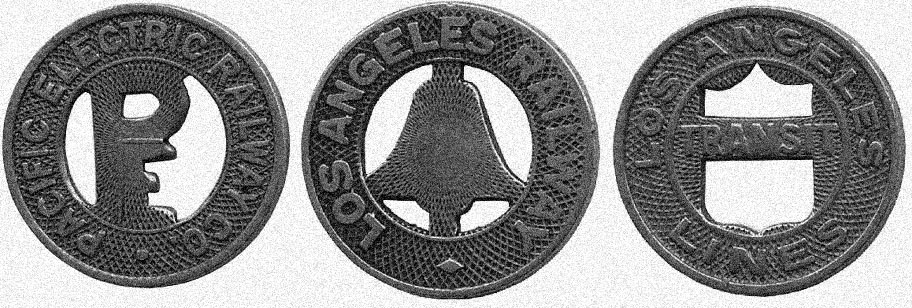 |
|
| Three types of tokens used by electric rail cars in early Los Angeles, Pacific Electric Railway, Los Angeles Railway, and Los Angeles Transit Lines.* |
Historical Notes The electric rail systems in early Los Angeles utilized various tokens for fare payment, each designed to represent the specific company and its services. The Pacific Electric Railway, known for its "Red Cars," issued tokens featuring the company name and "ONE TOKEN FARE" or "ONE FARE ZONE 1-2" with distinctive cut-out "PE" letters. The Los Angeles Railway, which operated the "Yellow Cars" for local service, had tokens displaying "LOS ANGELES RAILWAY" and "GOOD FOR ONE FARE" with a cut-out bell design. Los Angeles Transit Lines, the successor to the Los Angeles Railway, continued this tradition with similar tokens. These metal tokens were an integral part of the fare collection system, providing a convenient method for passengers to pay for rides and streamlining the boarding process. The use of these tokens spanned a significant period in Los Angeles' transportation history, from the early 1900s until the late 1950s, when the systems transitioned from private to public ownership. |
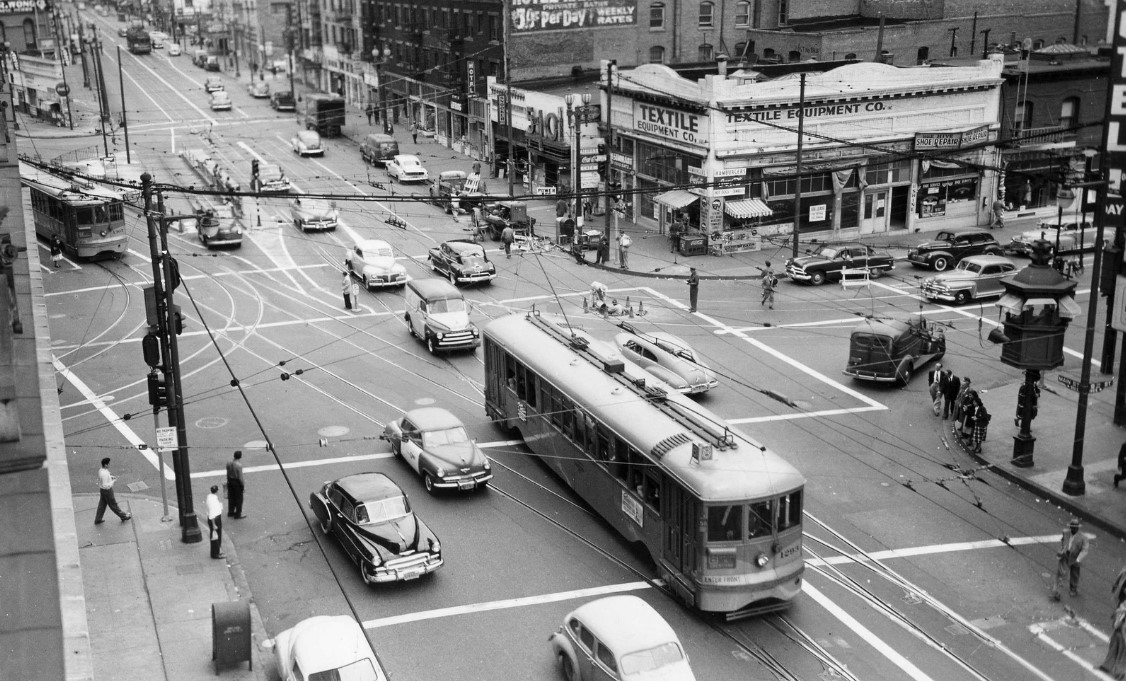 |
|
| (1950)* - View of a very busy intersection of Main - Spring - & 9th Streets. An old Los Angeles Railway manned pole tower (right) kept streetcar switch movements running smoothly. |
Historical Notes TIn the shot taken on May 23, 1950, Los Angeles Transit Lines car no. 1293 heads south on Main Street working the 8 line. Waiting to make to right turn from Spring St, onto 9th is LATL car no. 1307 working the N line. In the distance, a PE car on the Watts-Sierra Vista line can be seen heading north on Main St. Soon, the N and Sierra Vista lines would be no more. Andy Payne Photo, Ralph Cantos Collection. |
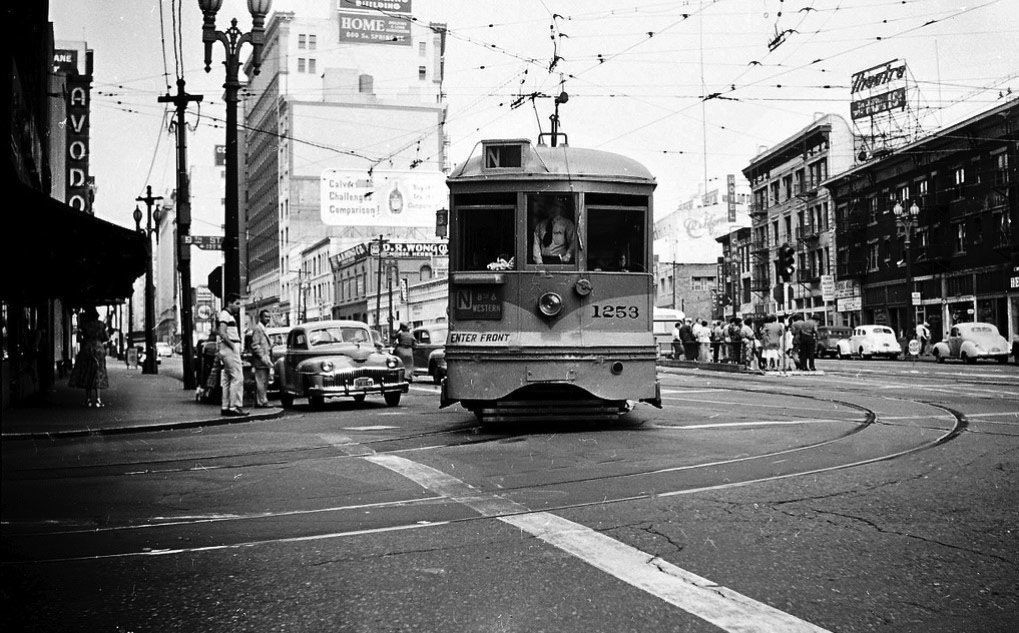 |
|
| (1950)* – View showing the Los Angeles Transit Lines’ “N” Line, at 9th & Spring Streets on last full day of run before closing down: September 9, 1950 |
Historical Notes Once considered the "Times Square" of Los Angeles, the junction of Main, Spring, and 9th streets was one of the most photographed intersections in Downtown LA. Click HERE to see more Early Views of the Main, Spring, and 9th Streets Intersection. |
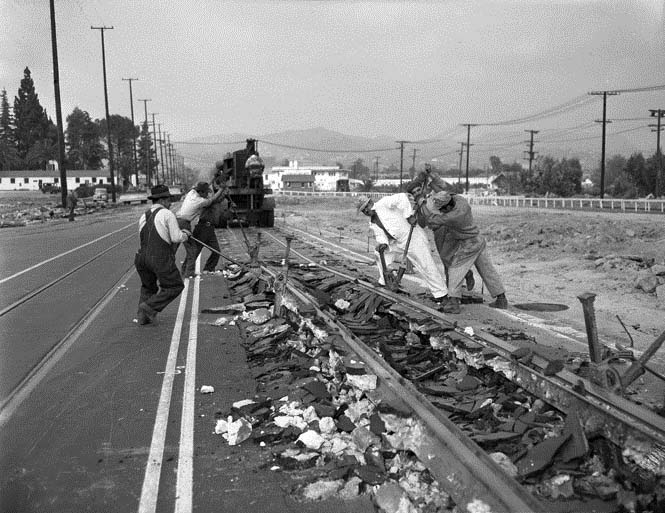 |
|
| (1948)* - Wrecking crew tearing out streetcar tracks on Vermont Avenue in Los Angeles. |
Historical Notes After World War II, the Pacific Electric Railway system was slowly dismantled — replaced by buses and freeways. |
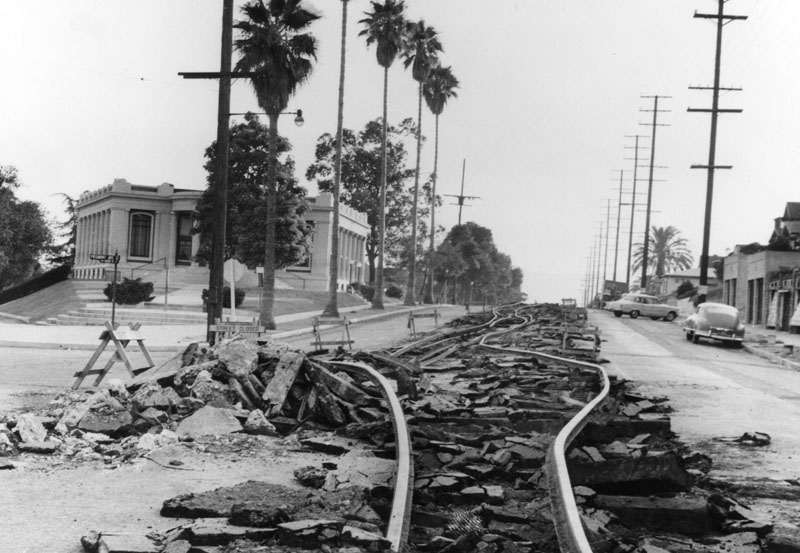 |
|
| (1958)* - View showing the old streetcar tracks being torn up on Piedmont Street. The Arroyo Seco Library can be seen in the background. |
Historical Notes Los Angeles' first municipal power pole is seen here on the corner of Piedmont and N. Figueroa streets (center-left). The pole remains standing today in its original location. Click HERE to see more in L.A.'s First Municipal Power Pole. |
 |
|
| (1960)* - A No.1522 Pacific Electric Red Car leaves the Pacific Electric Building at 6th and Main streets heading to Long Beach in Dec. 1960 shortly before service ended in 1961. |
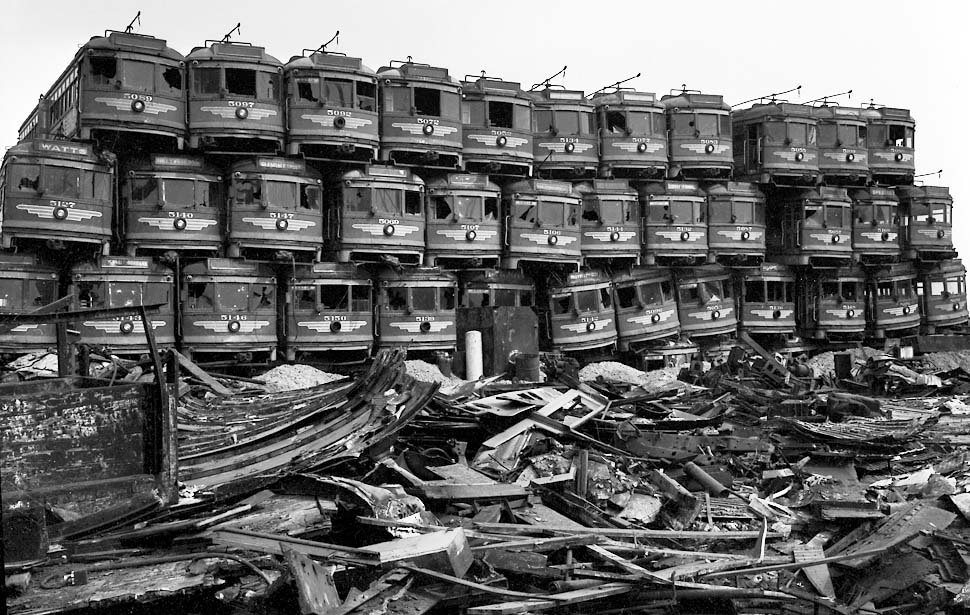 |
|
| (ca. 1961)* - Old Pacific Electric red cars sit at Terminal Island junkyard, awaiting dismantling to become scrap metal. |
Historical Notes Los Angeles’ Pacific Electric Red Cars were taken out of service in 1961. At their peak, they crisscrossed four counties on more than 1,000 miles of track. |
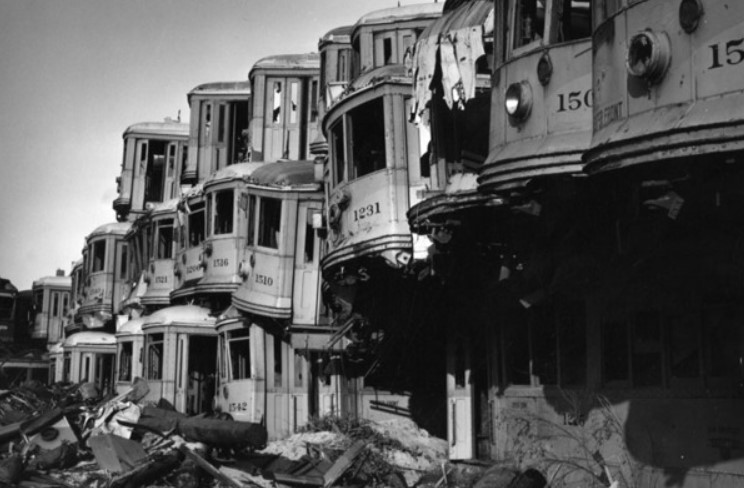 |
|
| (1966)* - Decommissioned street cars, "Yellow Cars," awaiting salvage on Terminal Island. |
Historical Notes The few remaining trolley-coach routes and narrow gauge streetcar routes of the former Los Angeles Railway "Yellow Cars" were removed in early 1963. |
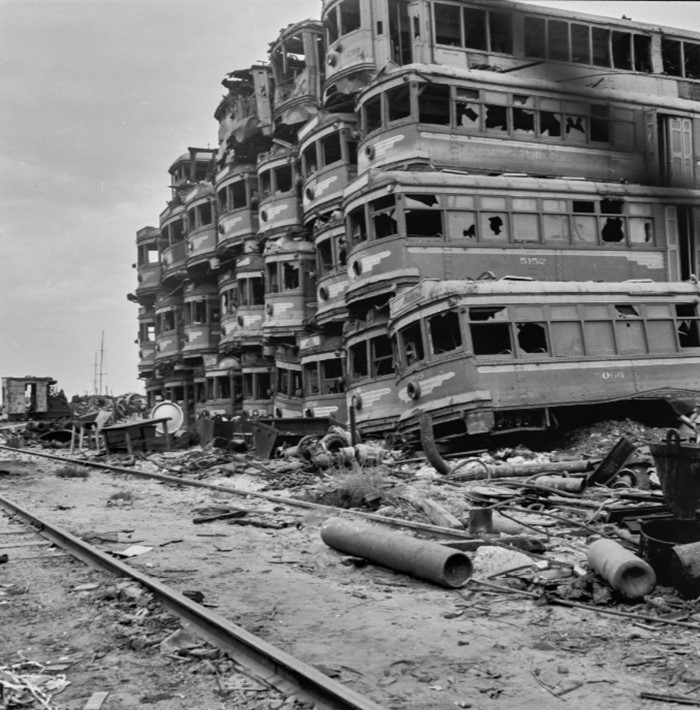 |
|
| (1957)* - Pacific Electric Railway cars in junkyard, Terminal Island. |
* * * * * |
Figueroa and 5th Street
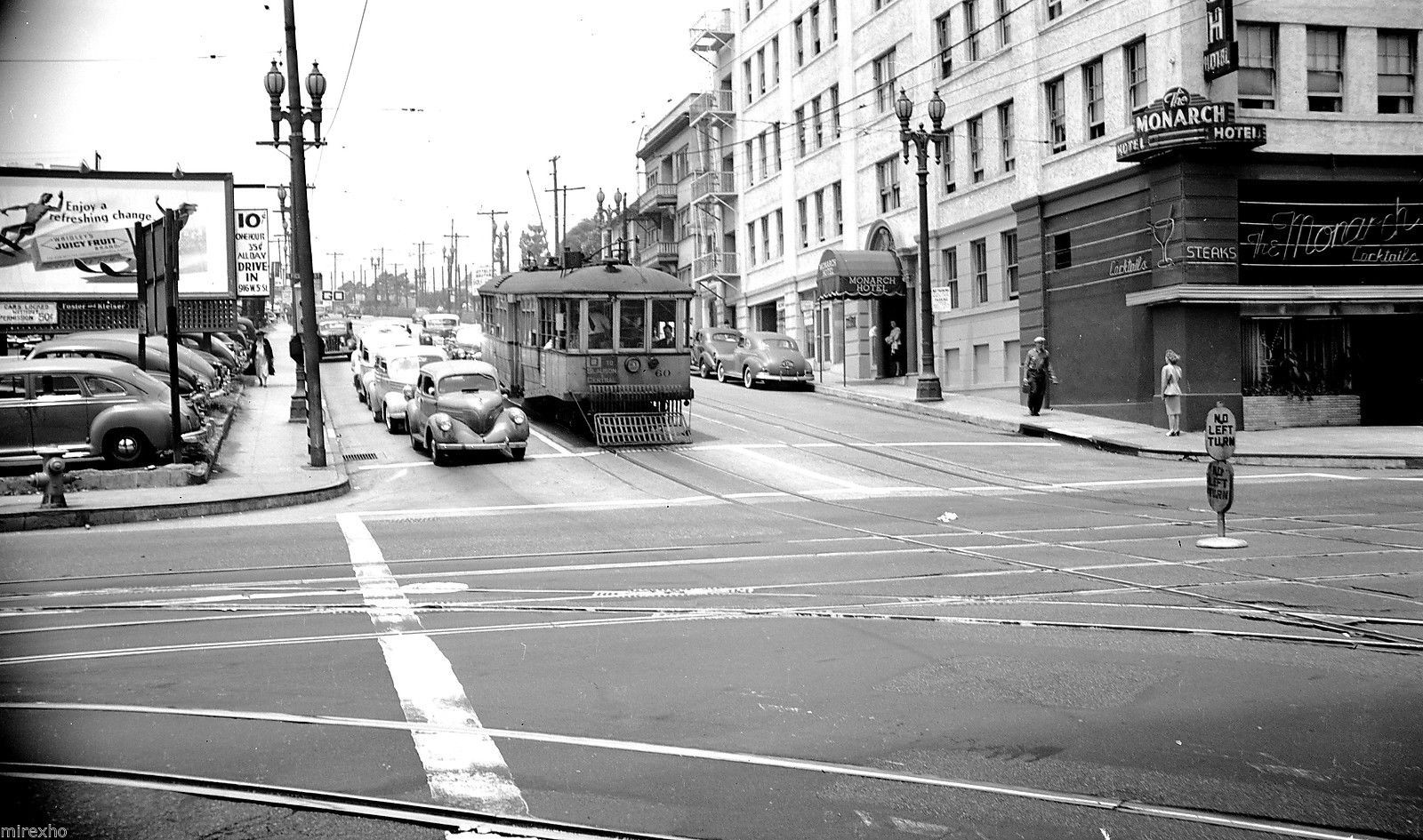 |
|
| (ca. 1945)* – Looking west on 5th Street at Figueroa Street with the Monarch Hotel seen on the NW corner. Parking sign on the left reads: 10¢ ONE HOUR - 35¢ FULL DAY. Beautiful dual-lamp streetlights run down both sides of the street. Photo courtesy of the Pacific Electric Railway Historical Society. |
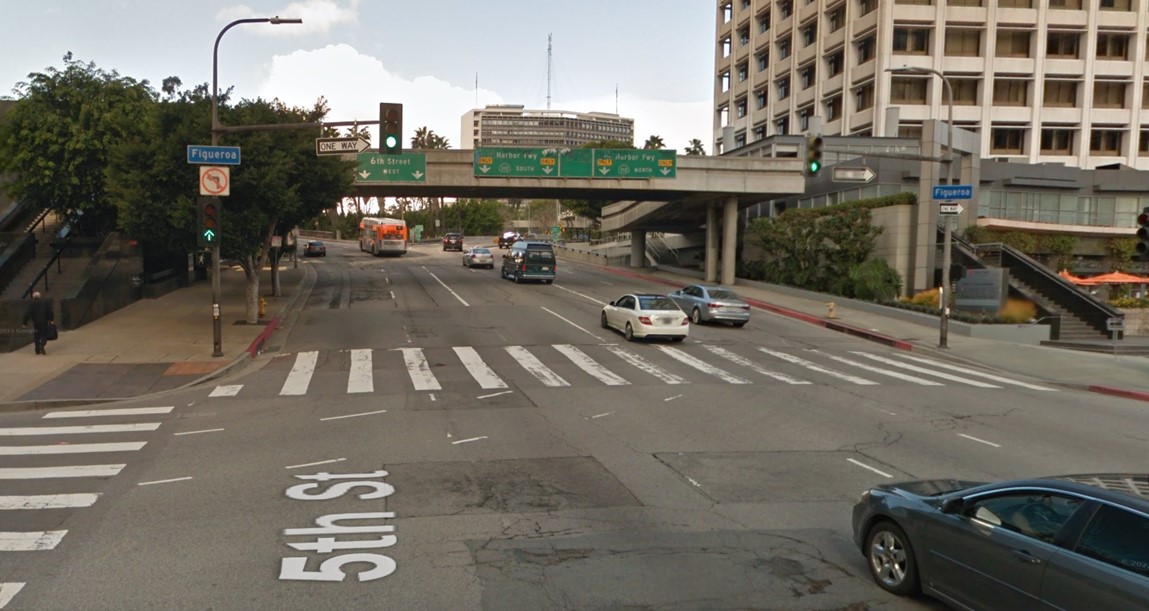 |
|
| (2017)* – Looking west on 5th Street at Figueroa Street. |
Then and Now
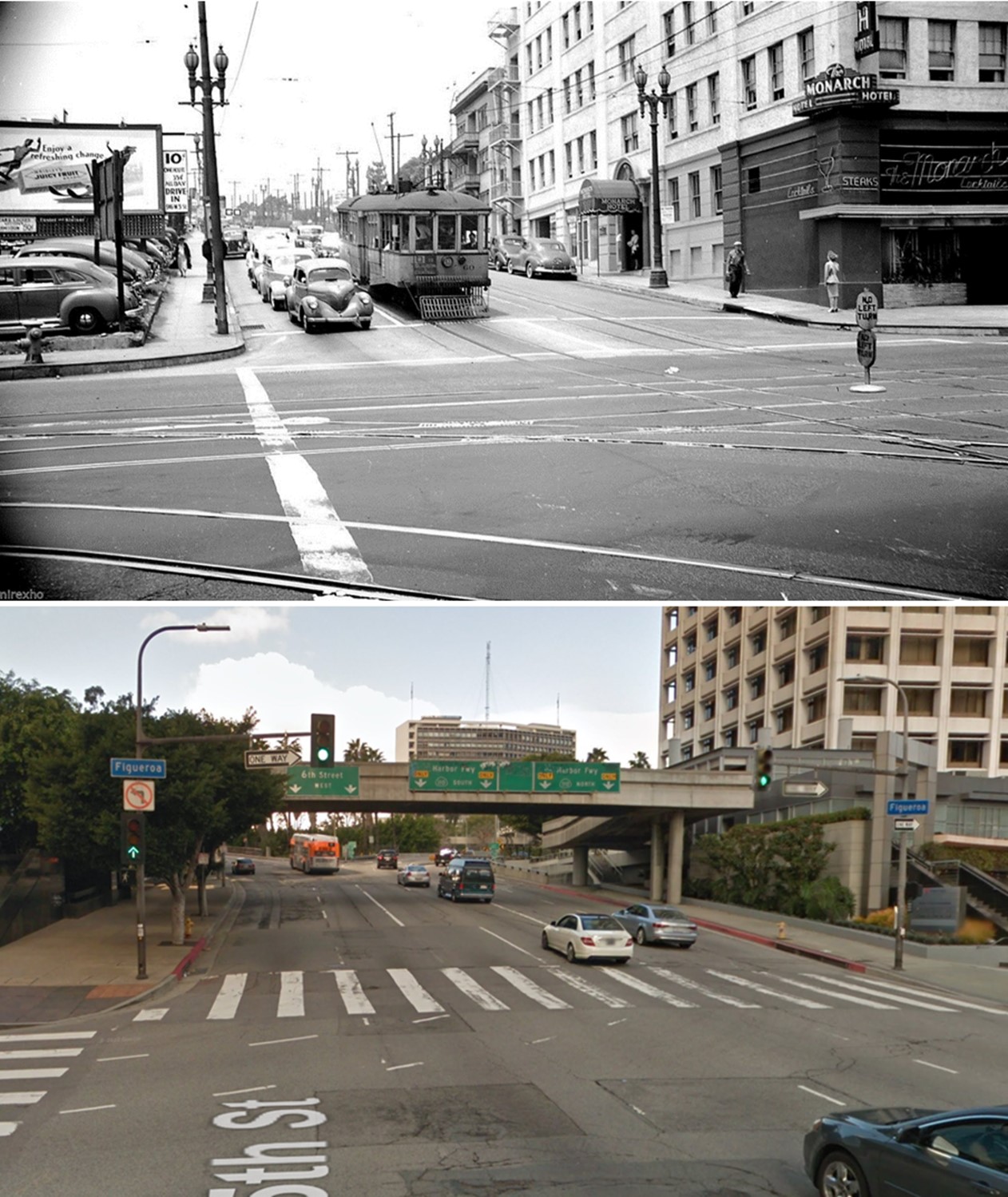 |
|
| (1945 vs 2017)* – Looking west on 5th Street at Figueroa Street. |
Flower and 5th Street
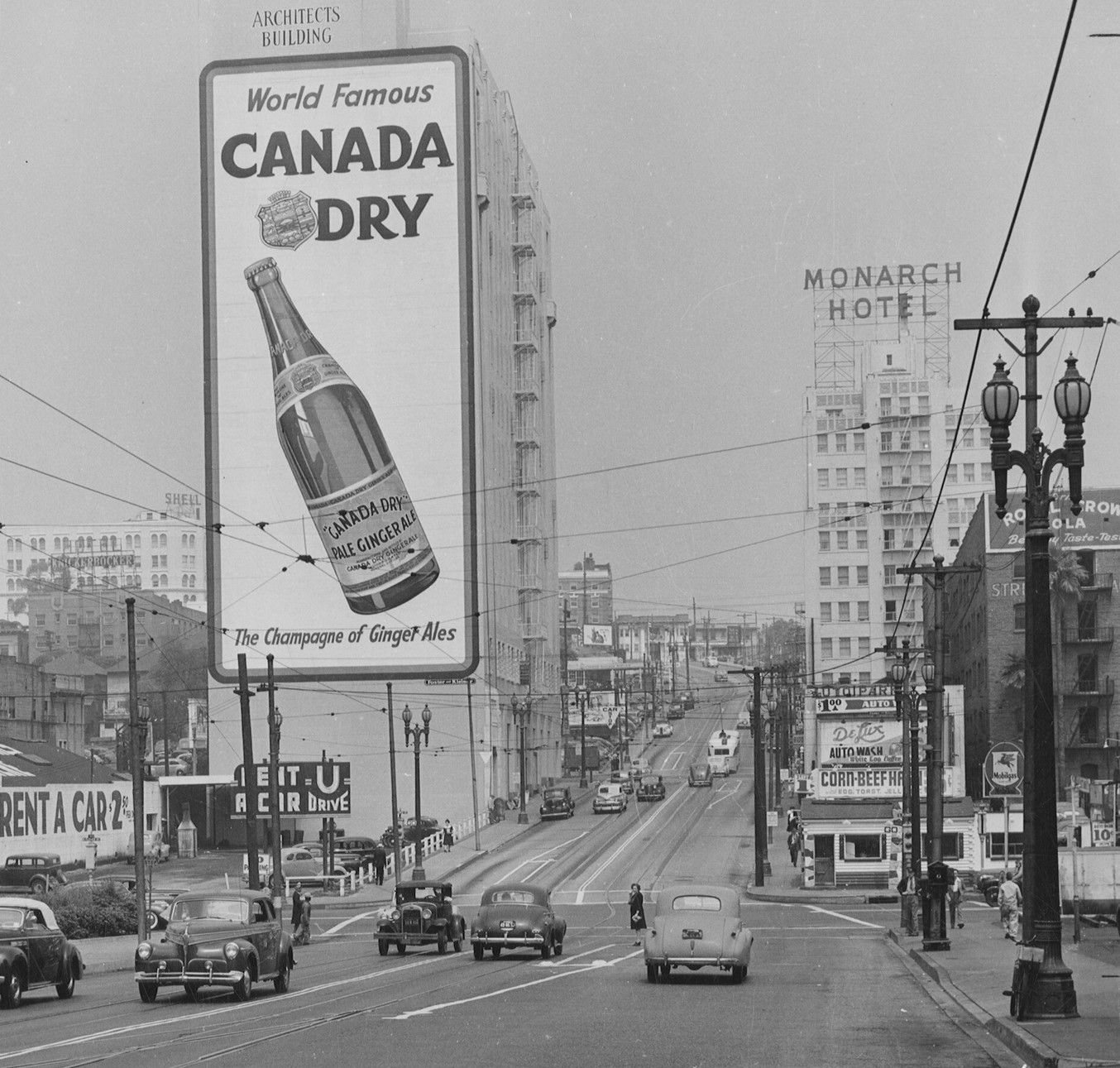 |
|
| (ca. 1944)* – Looking west on 5th Street toward Flower Street showing adverrtizing for 'CANADA DRY GINGER ALE' on the east face of the Architects Building, SE corner of 5th & Figueroa. Also seen here is the Monorach Hotel located on the NW corner of 5th and Figueroa. |
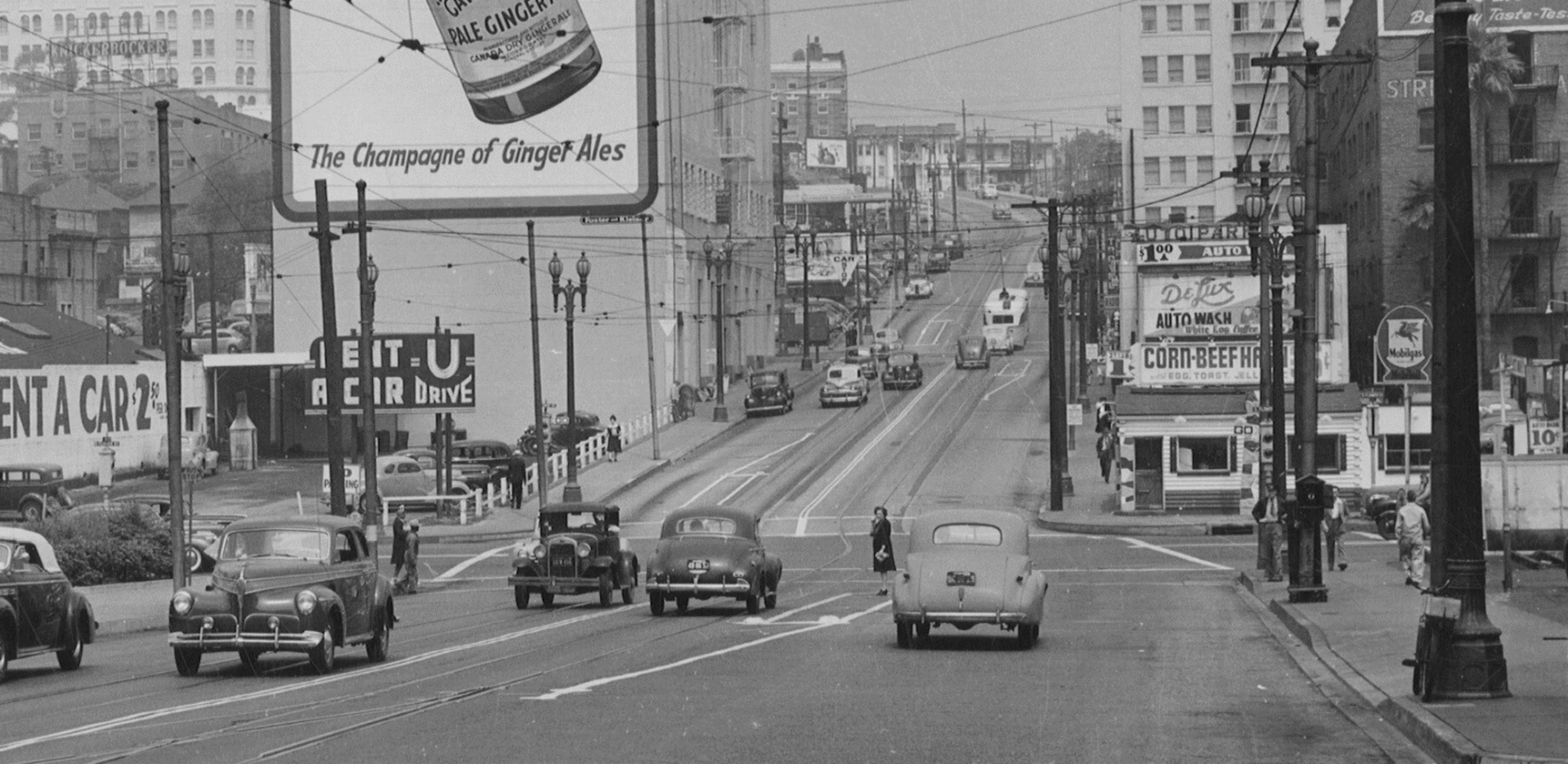 |
|
| (ca. 1944)* – Looking west on 5th Street toward Flower Street. |
Then and Now
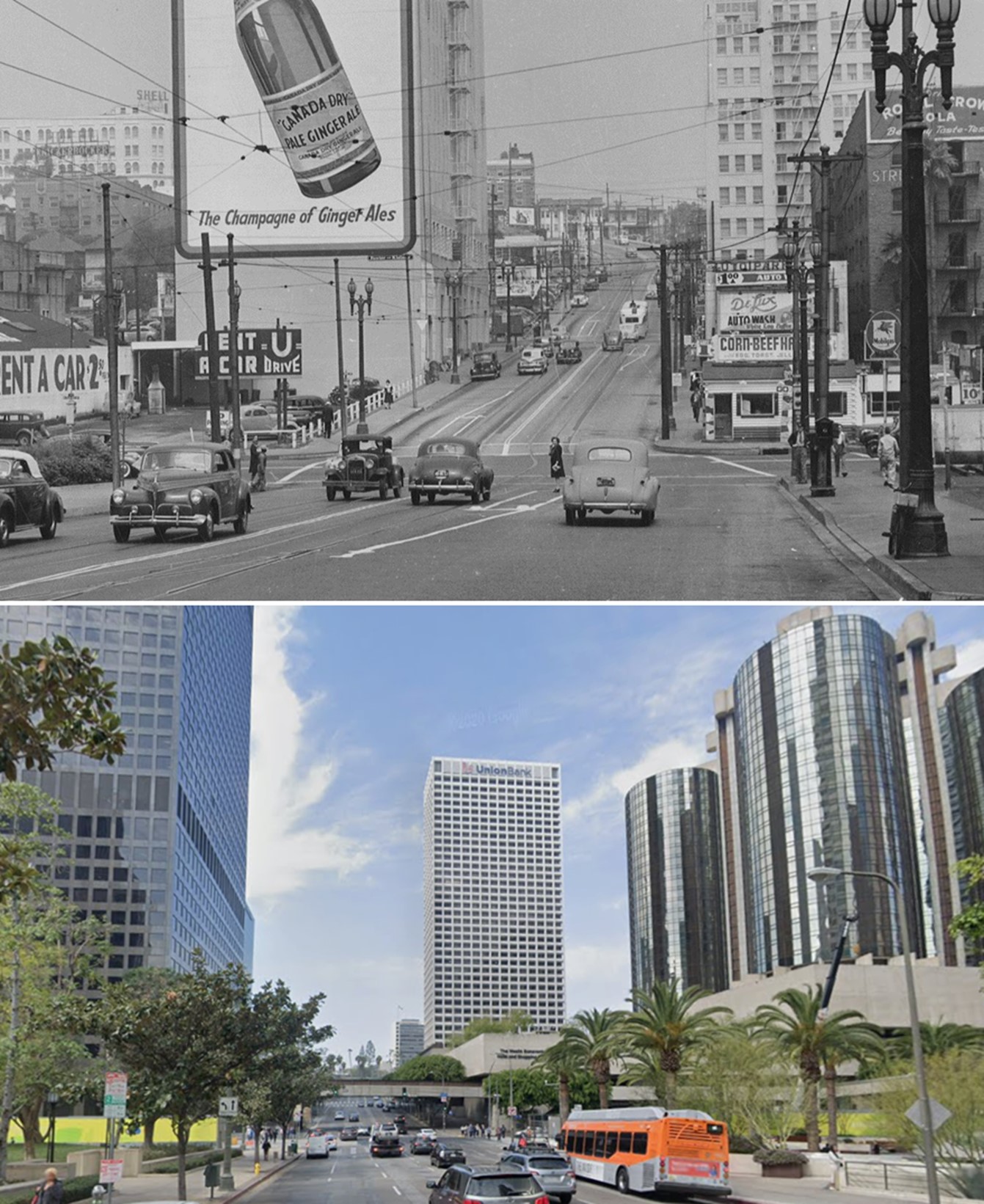 |
|
| (1944 vs. 2020)* – Looking west on 5th Street toward Flower Street. |
Flower and 5th Street
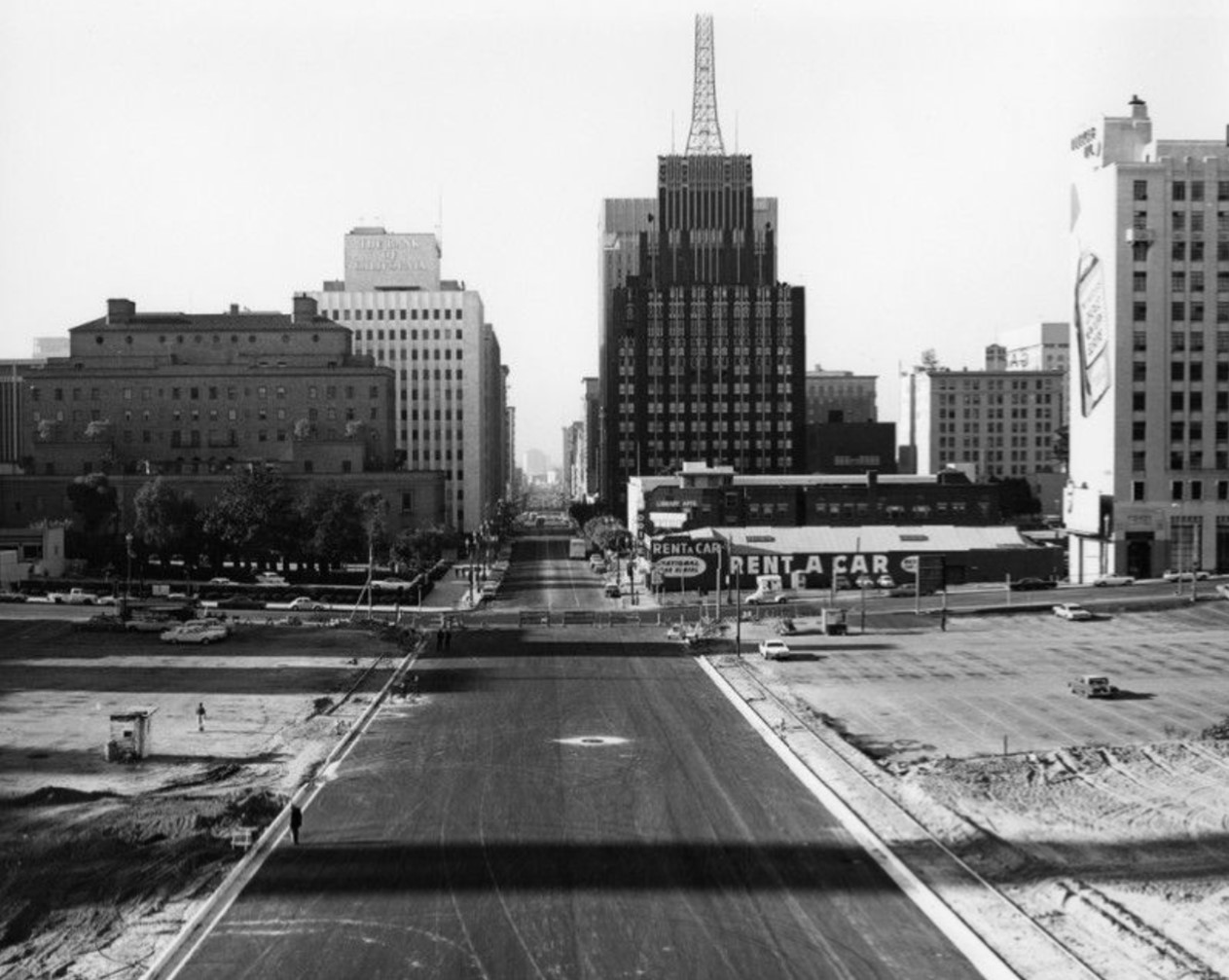 |
|
| (1968)* - View looking south on Flower Street toward 5th Street in downtown Los Angeles. Two prominent buildings stand out: the 1930-built California Club Building on the left, the club’s third location, and the Richfield Oil Company Building, the tallest at center. Photo by William Reagh. |
Historical Notes Completed in 1929, this 12-story Art Deco building stood 372 feet tall, including its 130-foot tower. The Richfield Tower featured a distinctive black and gold color scheme, symbolizing "black gold" or oil, the core business of Richfield Oil. The name "Richfield" was emblazoned vertically on the tower, with lighting designed to simulate an oil well gusher. The building served as the headquarters for the Richfield Oil Corporation until it was demolished in 1968 (the year of the above photo). Click HERE to see more early views of the California Club Building. Click HERE to see more early views of the Richfield Oil Company Building. |
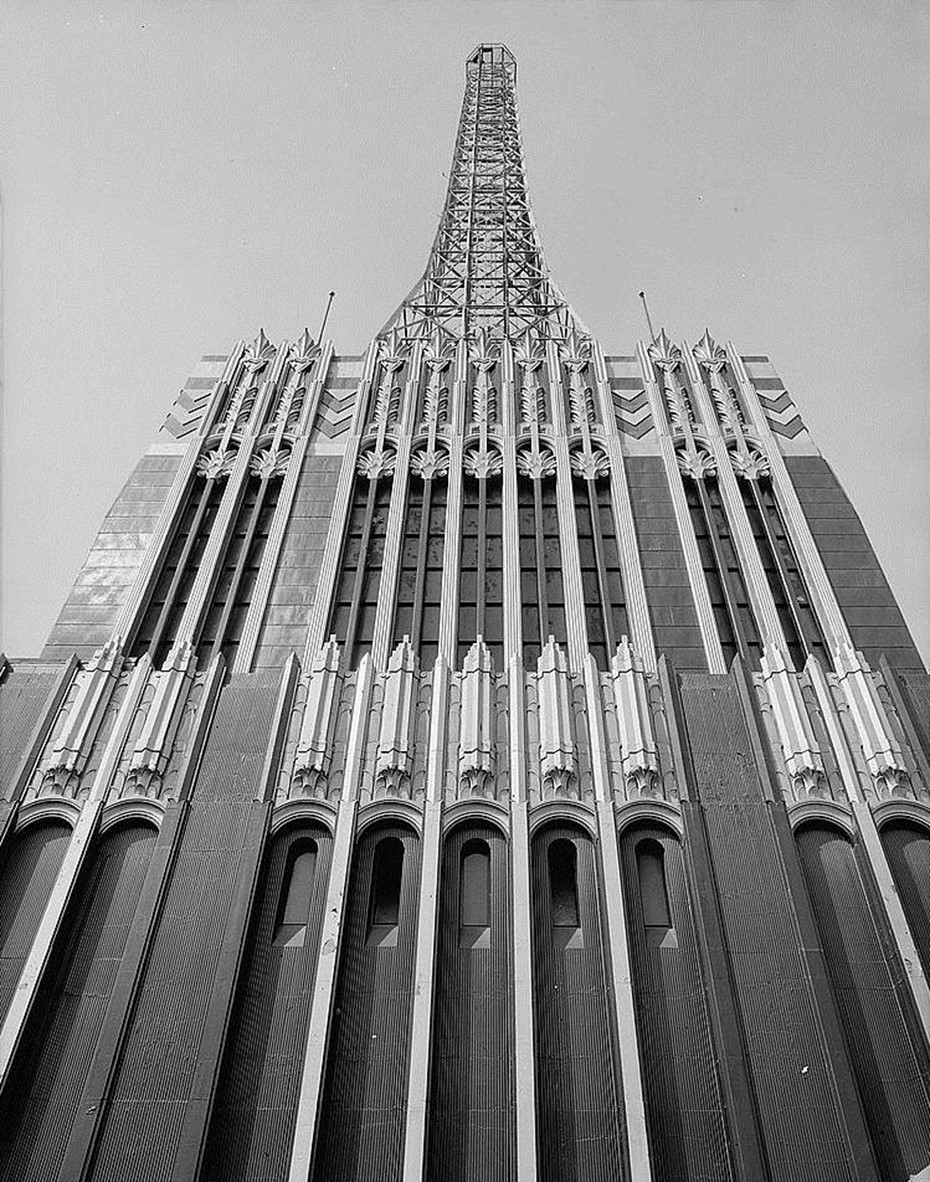 |
|
| (n.d.)* - Looking up to the top of the Richfield Oil Building located at 555 South Flower Street, Los Angeles. Built in 1929; demolished in 1968. Photo Source: Library of Congress. |
Historical Notes The Richfield Oil Building, located at 555 South Flower Street in Los Angeles, was a notable Art Deco skyscraper completed in 1929. Designed by Stiles O. Clements of Morgan, Walls & Clements, the building stood 372 feet tall, including a 130-foot tower adorned with the name "Richfield" and illuminated to mimic an oil well gusher, reflecting the company's oil industry focus. Its striking black and gold facade, along with intricate Art Deco details, made it a prominent feature of the city’s skyline. Serving as the headquarters for the Richfield Oil Corporation, the building was a symbol of industrial success and architectural grandeur. However, it was demolished in 1968 to make way for the Arco Plaza (now City National Plaza), which features two 52-story office towers. Click HERE to see more early views of the Richfield Oil Company Building. |
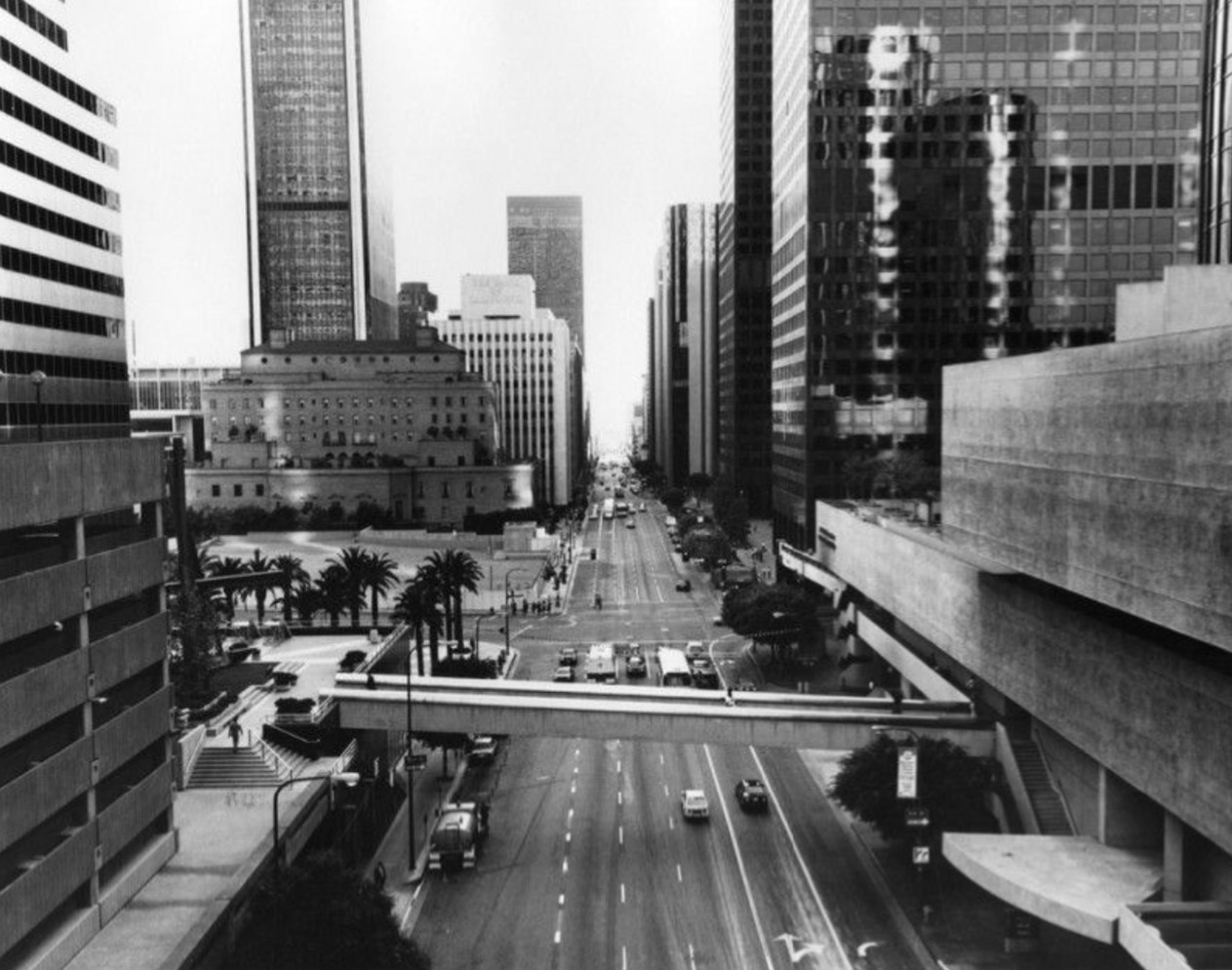 |
|
| (1990)* - Flower Street looking south toward 5th Street. On the right are the Bonaventure Hotel and Arco Towers. On the left is the California Club with the First Interstate building behind it. Just south of 5th Street on the left is the future site of Maguire Gardens at the Los Angeles Central Library, above the newly-constructed parking garage. Photo by William Reagh |
Historical Notes The site of the old Richfield Oil Building at 555 South Flower Street in Los Angeles became the location for the Arco Plaza (now known as City National Plaza). This complex consists of two 52-story office towers, which were completed in 1972. The towers were originally named after the Atlantic Richfield Company (ARCO), the successor to the Richfield Oil Corporation. |
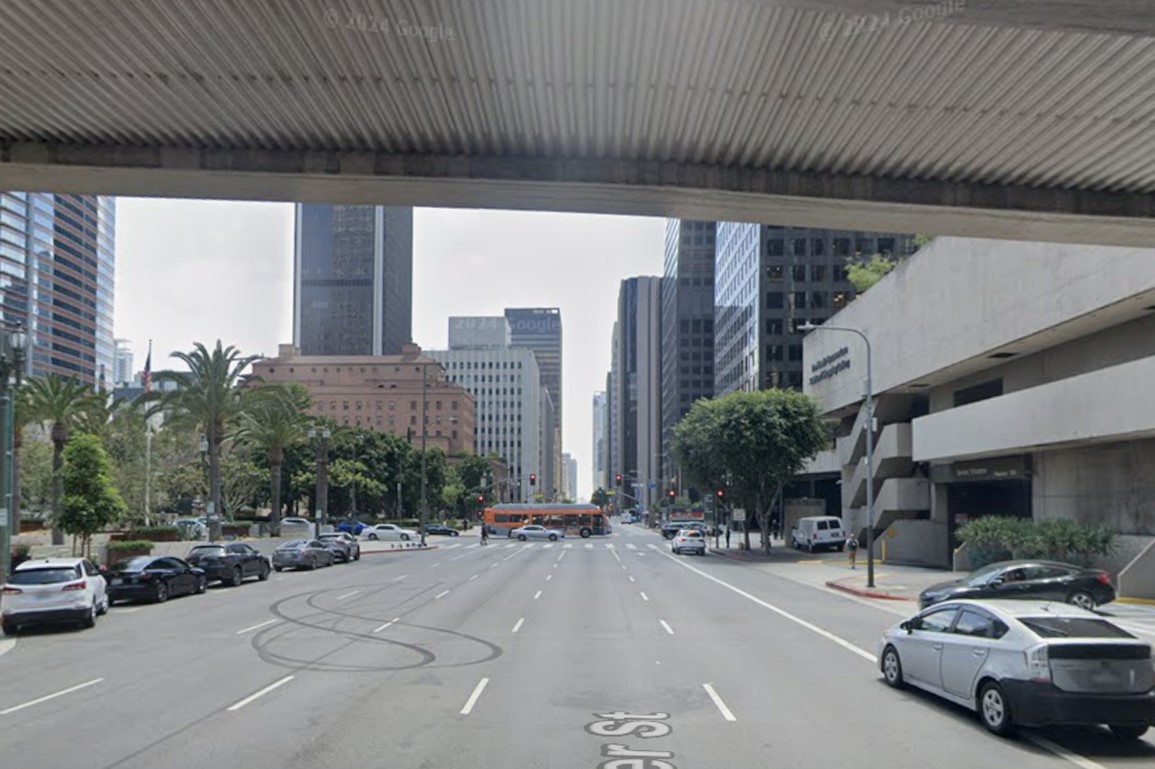 |
|
| (2024)* – Street view looking south on Flower Street toward 5th Street from underneath the pedestrian crossing near the Bonaventure Hotel (on the right). |
Then and Now
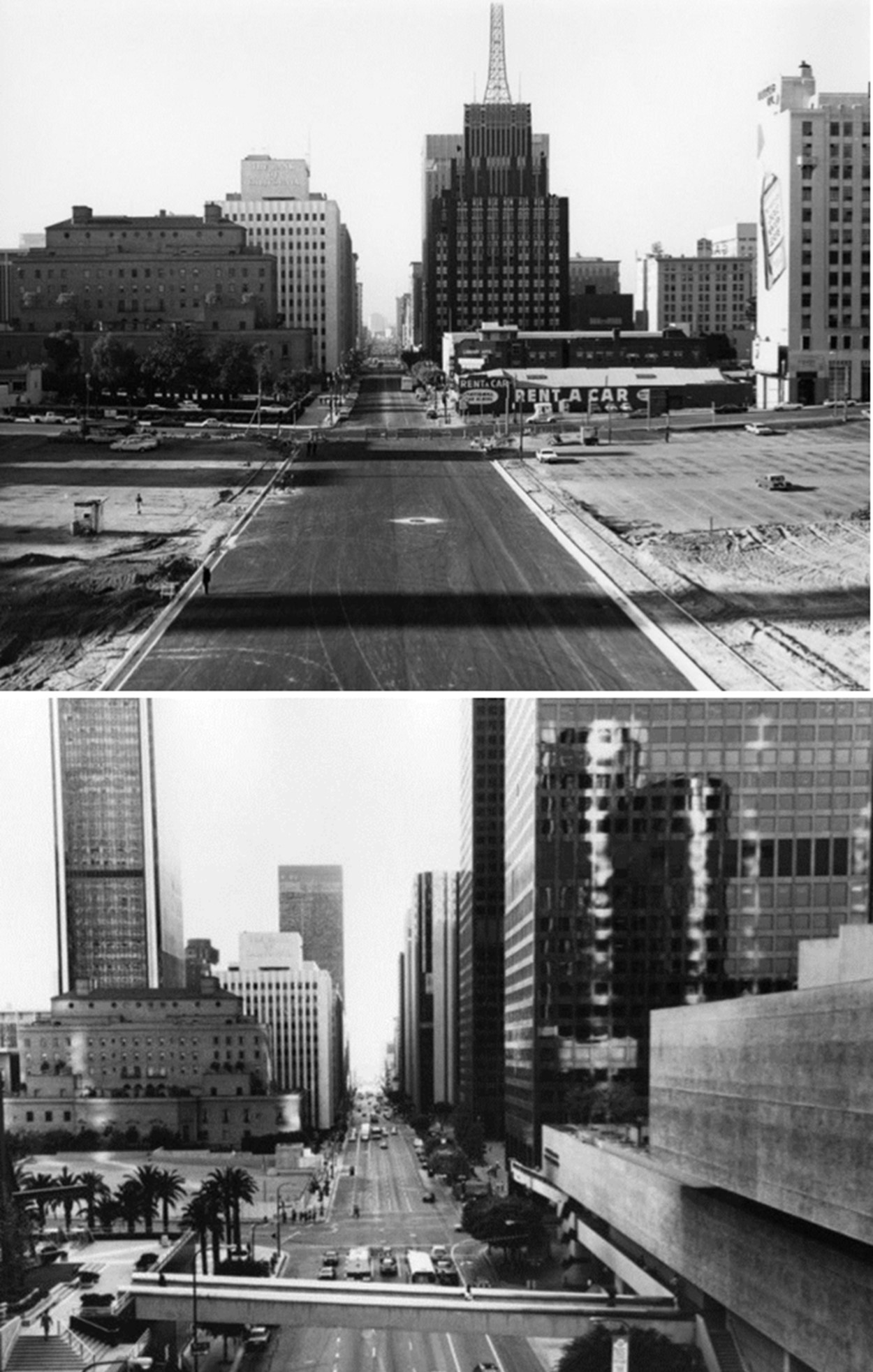 |
|
| (1968 vs. 1990)* – Looking south on Flower Street toward 5th Street in downtown Los Angeles. |
Then and Now
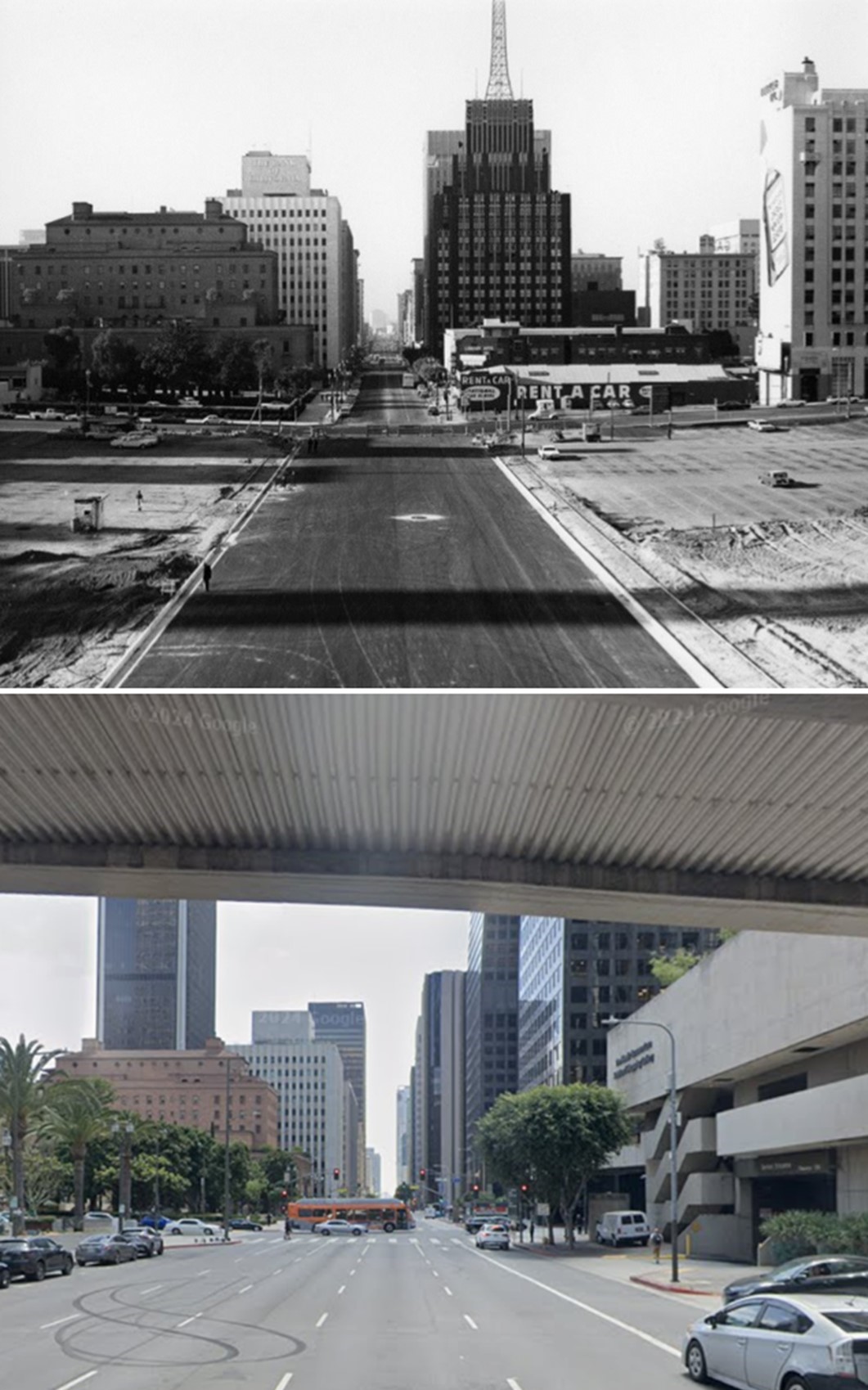 |
|
| (1968 vs. 2024)* – Looking south on Flower Street toward 5th Street in downtown Los Angeles. |
Spring and 6th Street
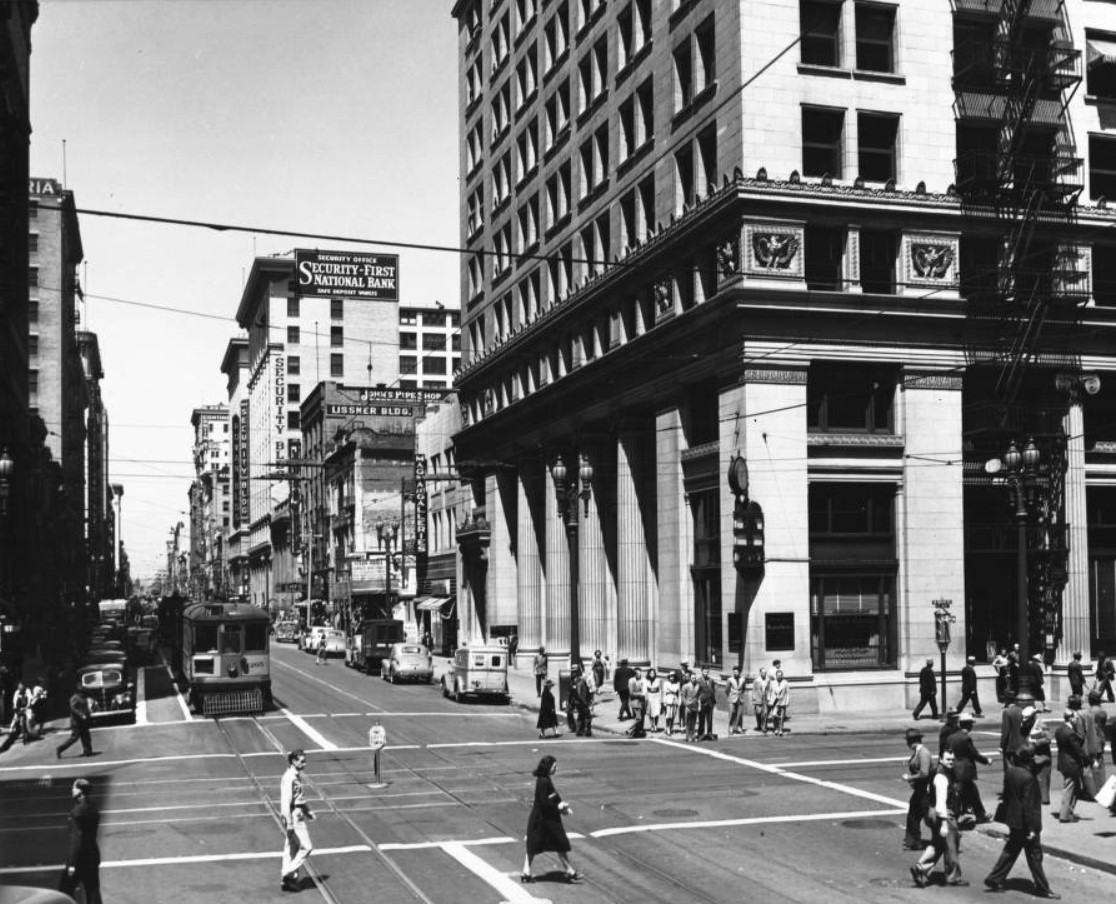 |
|
| (1939)*# - Spring Street looking north from Sixth Street, Bank of America at 650 South Spring Street, Security First National Bank Building at 510 South Spring Street, Rowan Building, art galleries. |
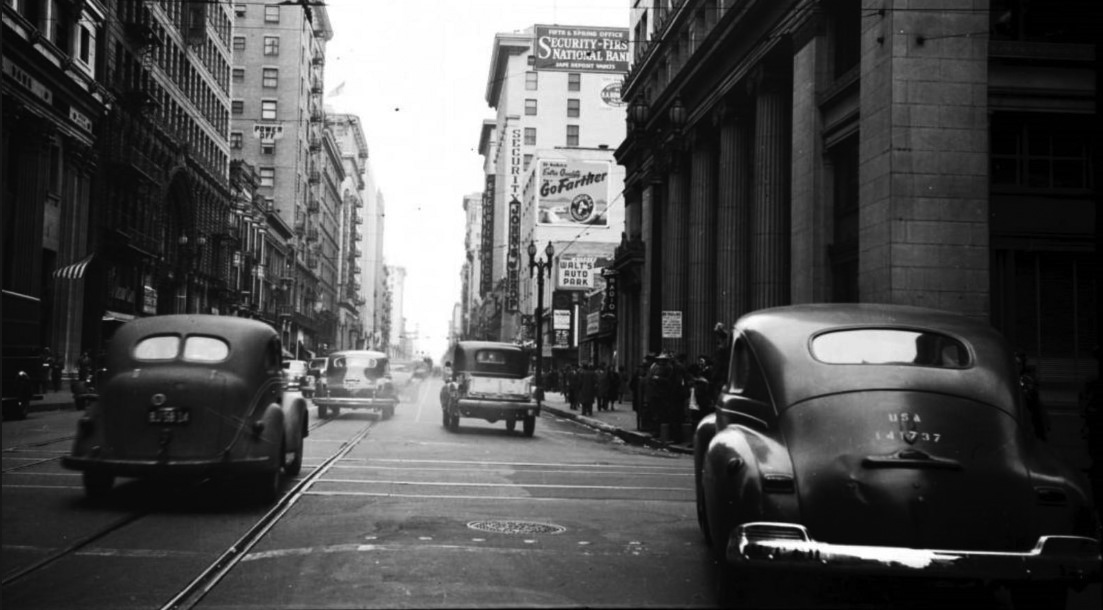 |
|
| (ca. 1949)*#– View looking north on Spring Street from 6th Street. The Arcade Building can be seen on the left and the Merchants National Bank Building on the right (N/E corner). |
Then and Now
 |
|
| (1949 vs. 2017 - View looking north on Spring Street at 6th Street. |
Spring and 7th Street
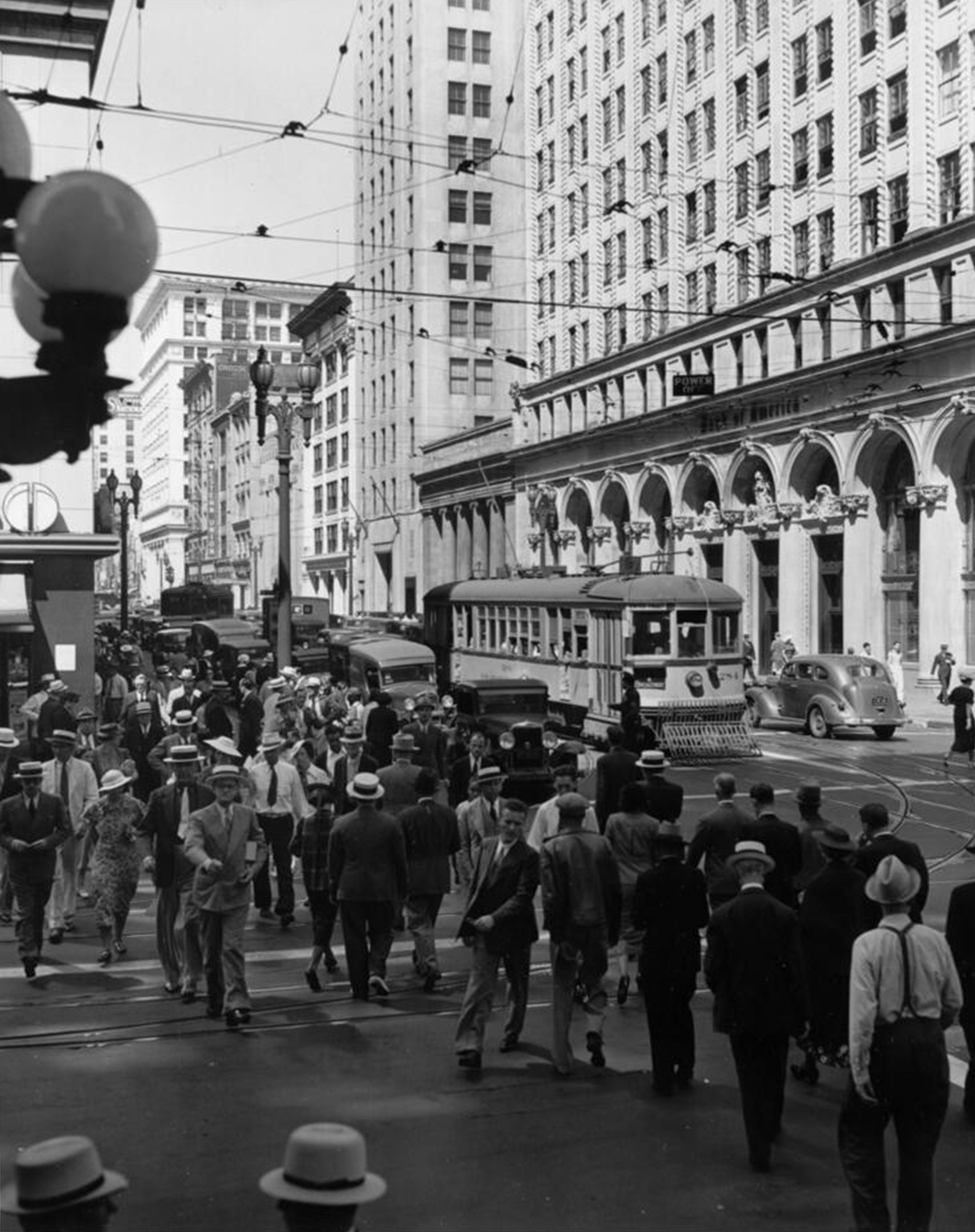 |
|
| (1937)* - Looking northwest along Spring Street from the corner of Seventh Street as pedestrians crowd the crosswalks and sidewalks. |
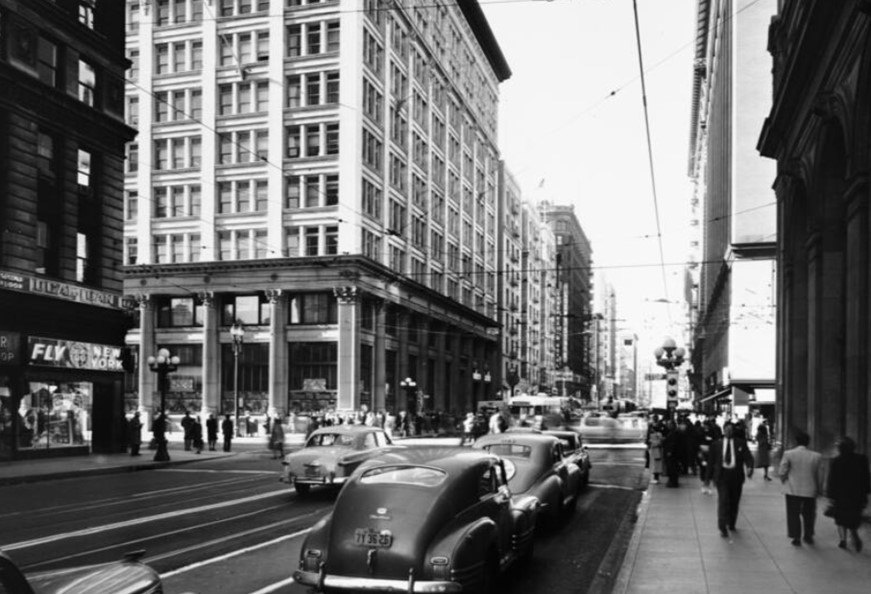 |
|
| (1949)* - Looking west on 7th Street toward Spring Street. |
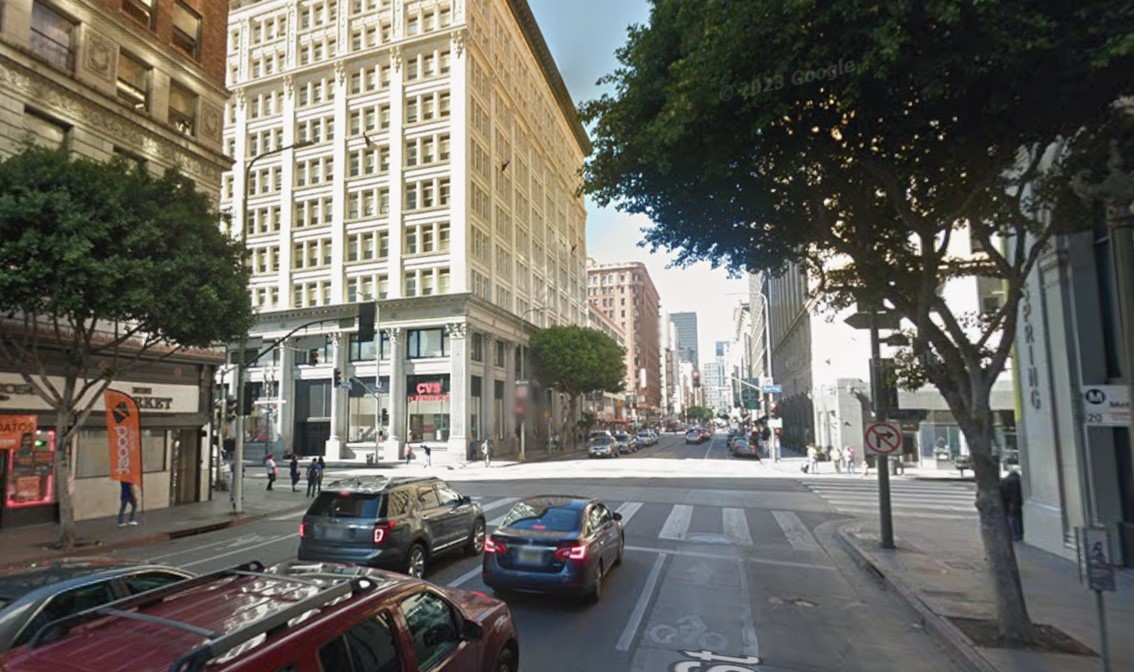 |
|
| (2014)* - Looking west on 7th Street toward Spring Street. |
Then and Now
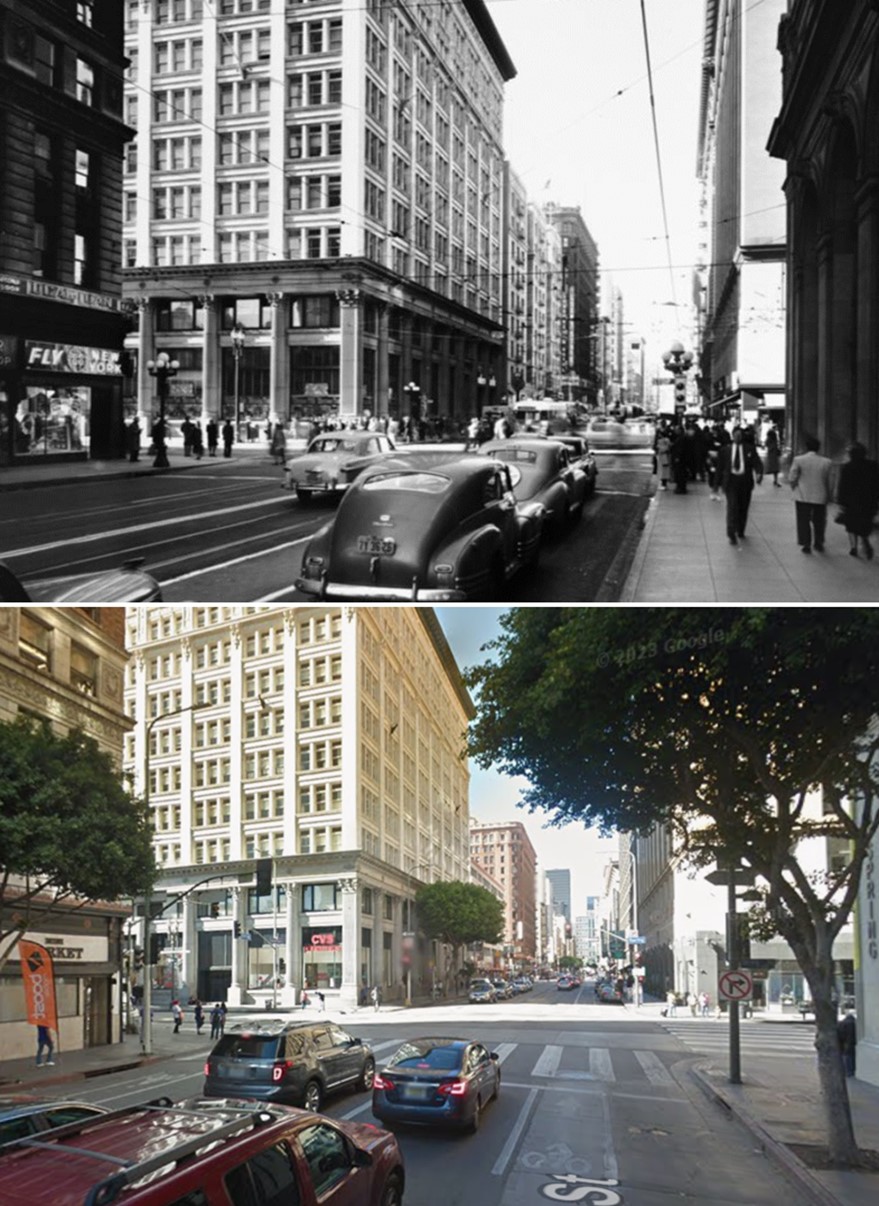 |
|
| (1949 vs 2014)* - Looking west on 7th Street toward Spring Street. |
Los Angeles and the Automobile
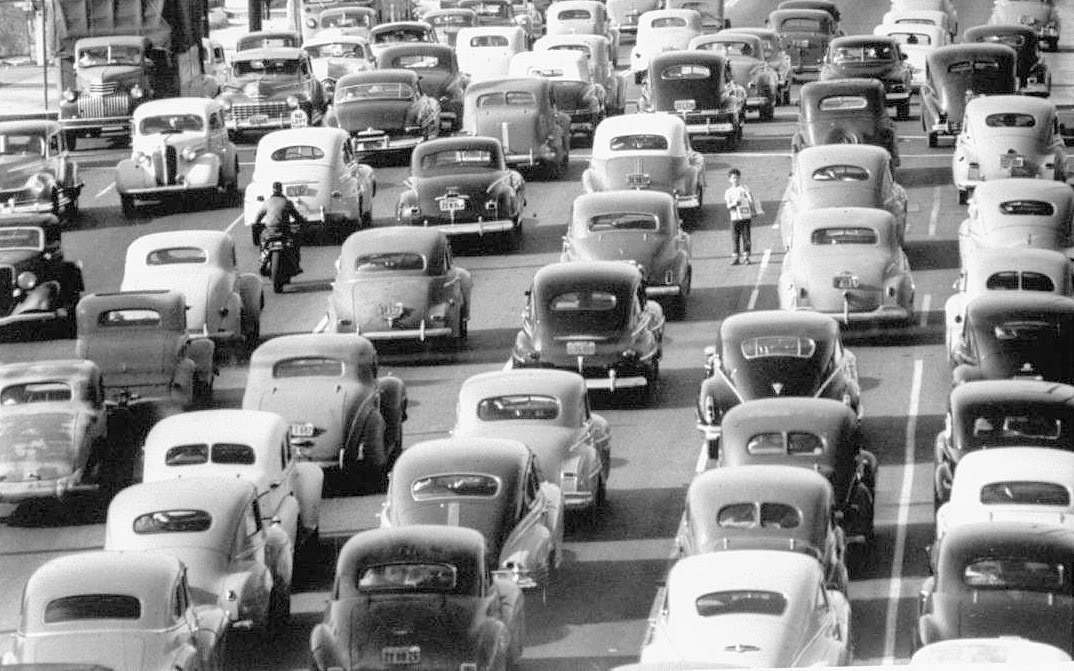 |
|
| (1949)**^ - Selling papers on Olive (May, 1949). Loomis Dean/LIFE |
Historical Notes After World War II, the American manufacturing economy switched from producing war-related items to consumer goods. The United States became the world's largest manufacturer of automobiles, and Henry Ford's goal of 40 years earlier—that any man with a good job should be able to afford an automobile—was achieved.^* |
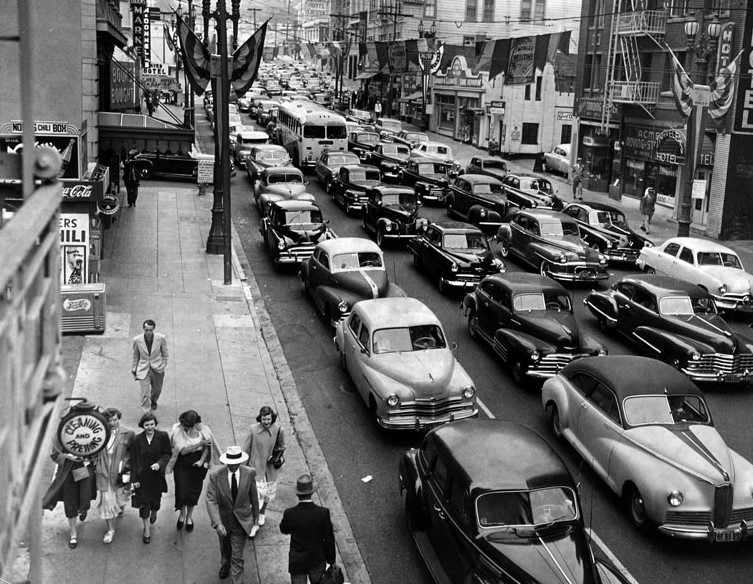 |
|
| (1950)* - Traffic jam on 6th Street during a transit strike, Los Angeles. |
Historical Notes More people joined the middle-class in the 1950s, with more money to spend, and the availability of consumer goods expanded along with the economy, including the automobile. Americans were spending more time in their automobiles and viewing them as an extension of their identity, which helped to fuel a boom in automobile sales. Most businesses directly or indirectly related to the auto industry saw tremendous growth during the decade. New designs and innovations appealed to a generation tuned into fashion and glamour, and the new-found freedom and way of life in the suburbs had several unforeseen consequences for the inner cities. The 1950s saw the beginning of white flight and urban sprawl, driven by increasing automobile ownership.^* |
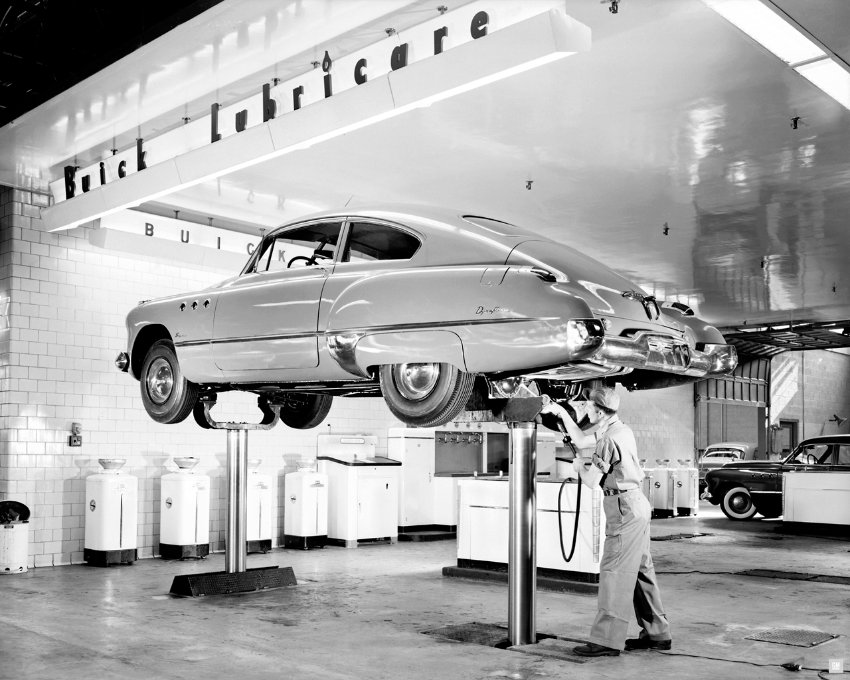 |
|
| (ca. 1949)*##* - Buick Super Sedanette 1949 at the garage - Southern California's car culture. |
Historical Notes In just a decade after the end of WWII, one in six working Americans were employed either directly or indirectly in the automotive industry.^* |
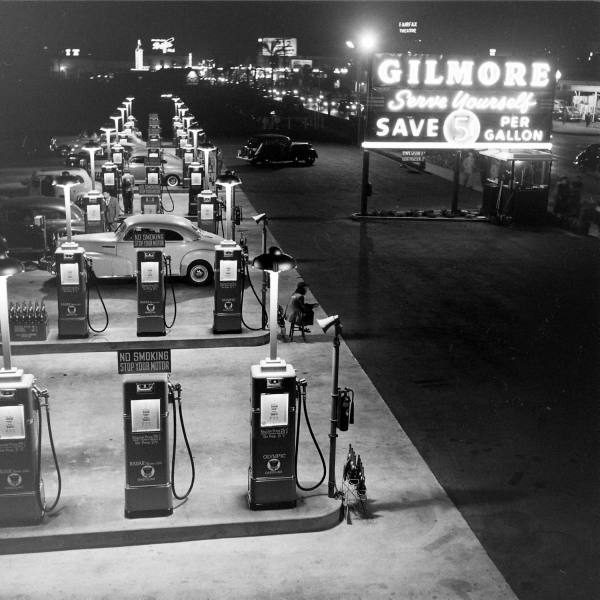 |
|
| (1948)*^^* - Gilmore Self-Service Station located on the south side of Beverly Boulevard east of Fairfax Avenue. View is looking west toward Fairfax. The Fairfax Theatre sign (northwest corner of Fairfax and Beverly) is seen above and behind the Gilmore sign. The tower sign for Herbert's Drive-In Restaurant (southeast corner of Fairfax and Beverly) can barely be made out in the upper left of photo. CBS Television City would be built at this corner in 1952. |
Historical Notes E. B. Gilmore appears to have invented the self-serve gas station. He created a “gas-a-teria” not far from Farmers Market where customers saved 5 cents per gallon by filling their own tanks. Those who preferred to have their gas pumped by “professionals” at the gas-a-teria got unusual service for a period of time when young ladies on roller skates would glide to the pumps to gas the cars up.^**^ |
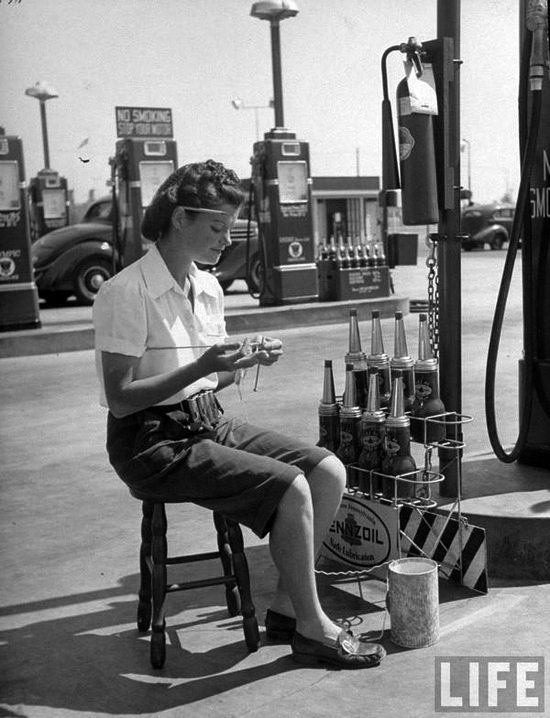 |
|
| (1948)^^** - Gilmore 'Self-Service' Gas Station at the southeast corner of Genesee Avenue and Beverly Boulevard. The self-service concept created a new dynamic for gas attendants. |
Historical Notes A.F. Gilmore and his son, Earl Bell (E.B.) turned their Gilmore Oil Company into the largest distributor of petroleum products in the Western U.S. Through the 1940s and early 50s Gilmore Oil Company evolved into Mobil Oil Corporation.^* |
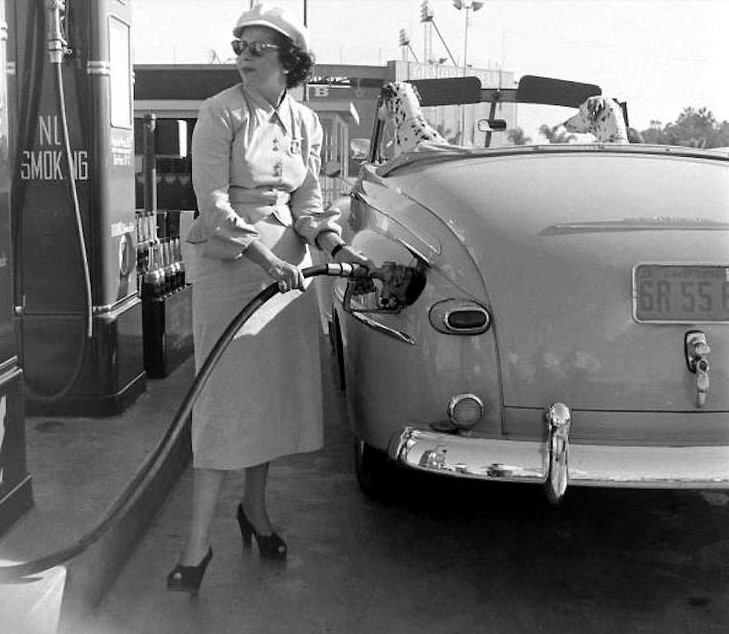 |
|
| (ca. 1948)**** - A woman pumping fuel at the Gilmore ‘Self-Service’ Gas Station (one of the nation's first) near Fairfax and Beverly. Gilmore Field, the home of the Los Angeles Stars minor league team, is visible in the background. Note also the woman's two Dalmations at attention in the car. |
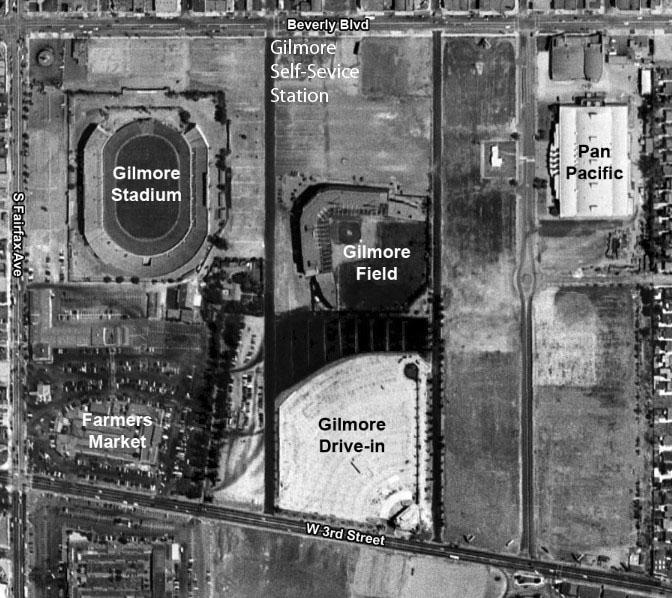 |
|
| (1948)**^ – Aerial view of the area bounded by Beverly, Fairfax, 3rd Street, and Gardner Avenue. The photo has been annotated and shows the location of Gilmore "Self-Service" Gas Station, Gilmore Stadium, Gilmore Field, Farmers Market, Gilmore Drive-In and the Pan-Pacific Auditorium. |
Historical Notes In 1870, when they moved west from Illinois, Arthur Fremont (A.F.) Gilmore and his partner bought two sizable farms, one of which was the 256-acre dairy farm at the corner of 3rd Street and Fairfax Ave. Gilmore gained control when the partnership dissolved later. Gilmore Oil Company replaced the dairy farm when oil was discovered under the land during drilling for water in 1905. Earl Bell (E.B.) Gilmore, son of A.F. Gilmore, took over the family business. The younger Gilmore started midget car racing and brought professional football to Los Angeles. He built Gilmore Field for the Hollywood Stars baseball team, which was owned by Bing Crosby, Barbara Stanwyck, and Cecil B. DeMille. Farmers Market started when a dozen nearby farmers would park their trucks on a field to sell their fresh produce to local residents. The cost to rent the space was fifty cents per day.^* |
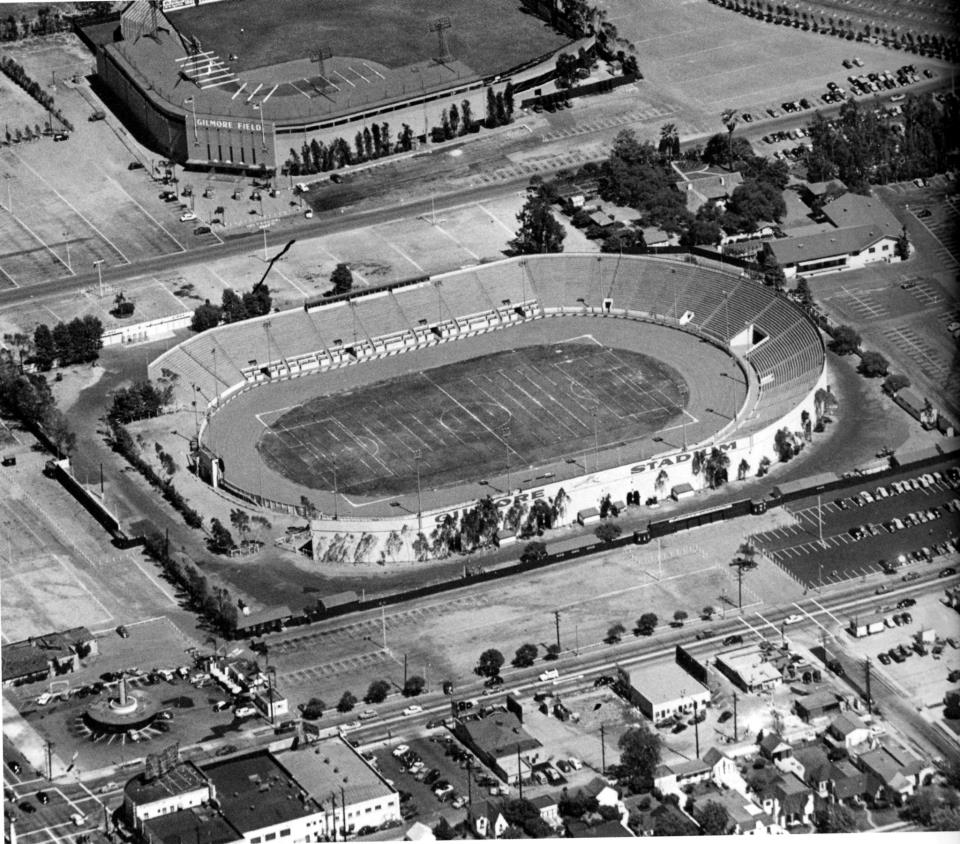 |
|
| (1949)* - View looking southeast of Gilmore Field and Gilmore Stadium. The intersection of Fairfax Avenue and Beverly Boulevard is in the lower left of the photo. Herbert's Drive-In Restaurant stands on on the southeast corner. A portion of Farmers Market can be seen in the upper right and the Gilmore Self-Service Gas Station is out of view in the upper left. Photo: Vintage Los Angeles. |
Historical Notes In 1951, CBS Television City was built facing Beverly Boulevard on the site of Gilmore Stadium. In 1958 Gilmore Field was also demolished and the studio expanded on the grounds where baseball was once played. |
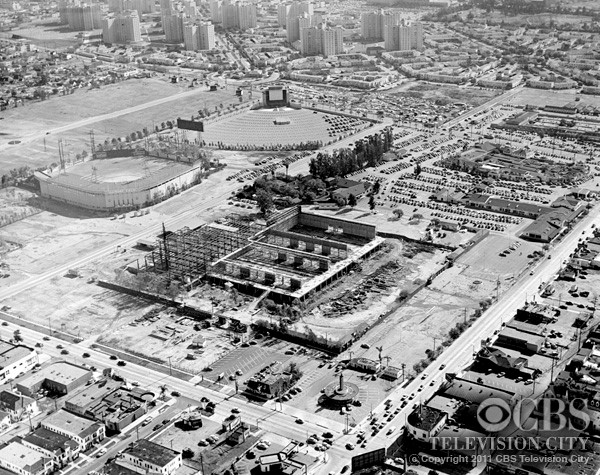 |
|
| (1951)**^ – Aerial view looking southeast showing construction of the new CBS Television City at center. In the foreground on the southeast corner of Beverly and Fairfax is Herbert's Drive-In Restaurant. Further in the distance can be seen (L to R): Gilmore Field, Gilmore Drive-In, Park La Brea Towers, and Farmers Market. Credit: CBS Photo Archive. |
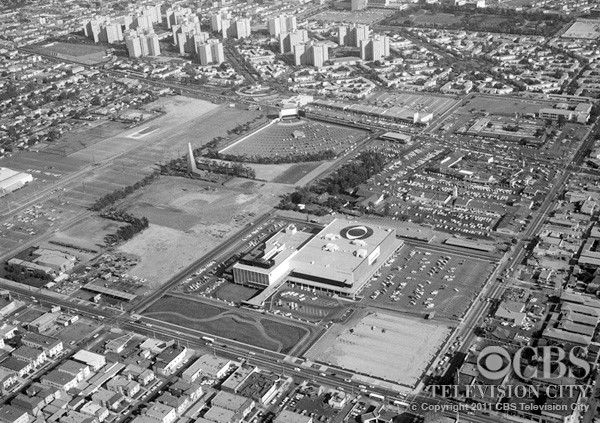 |
|
| (1960)**^ – Aerial view showing a completed CBS Television City. Note that Gilmore Field is now also demolished but you can still make out the diamond. Credit: CBS Photo Archive. |
* * * * * |
Kiddieland
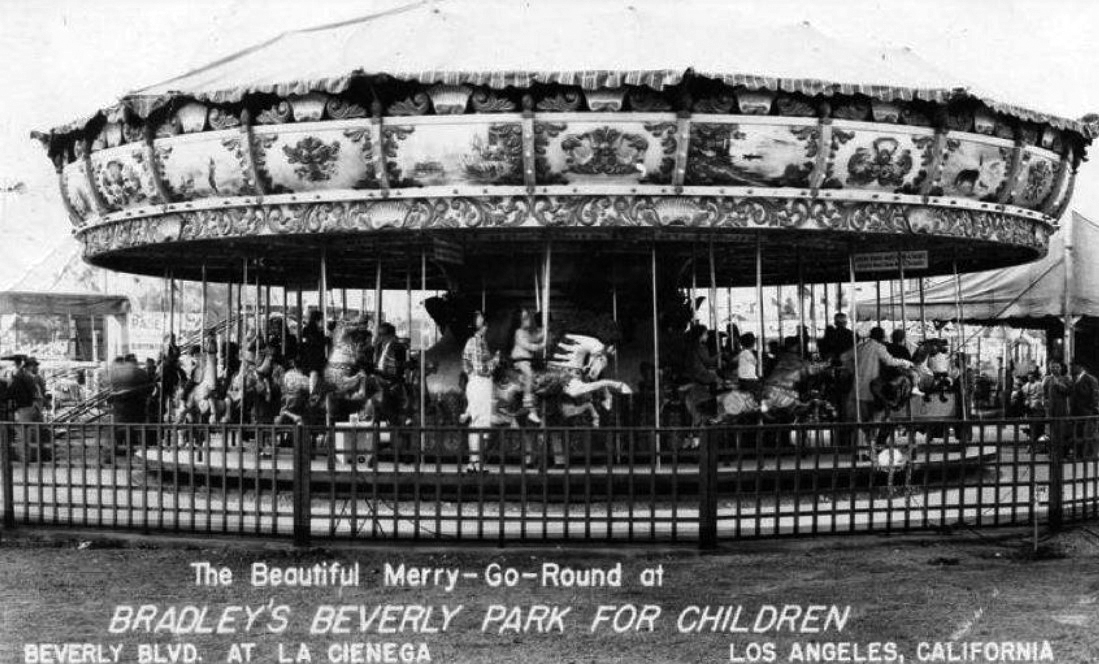 |
|
| (1947)* - Postcard view showing a Merry-Go-Round at Beverly Park (a.k.a Kiddieland) located near the southwest corner of La Cienega and Beverly boulevards. Photo: Vintage Los Angeles. |
Historical Notes Kiddieland was a whimsical amusement park located on less than an acre on the corner of La Cienega and Beverly Boulevard, at the present home of the Beverly Center Mall. Originally, the land parcel was part of an oil field, which was leased for development. From 1945-1974, children growing up in Los Angeles had their own mini-fair year round. There were usually about twelve kid-sized rides, as well as animals, hot dogs and cotton candy. Parents and Grandparents sat on benches watching their children ride the merry-go-round, and birthday parties were celebrated at picnic tables.^^^* Beverly Park was a perfect place to have a Birthday Party. It had a picinic area set aside for such occasions. But most important, it had enough fun rides to keep the kids busy for hours. They could even top off the day with pony rides at Ponyland, which was located just west of Kiddieland on Beverly Blvd. |
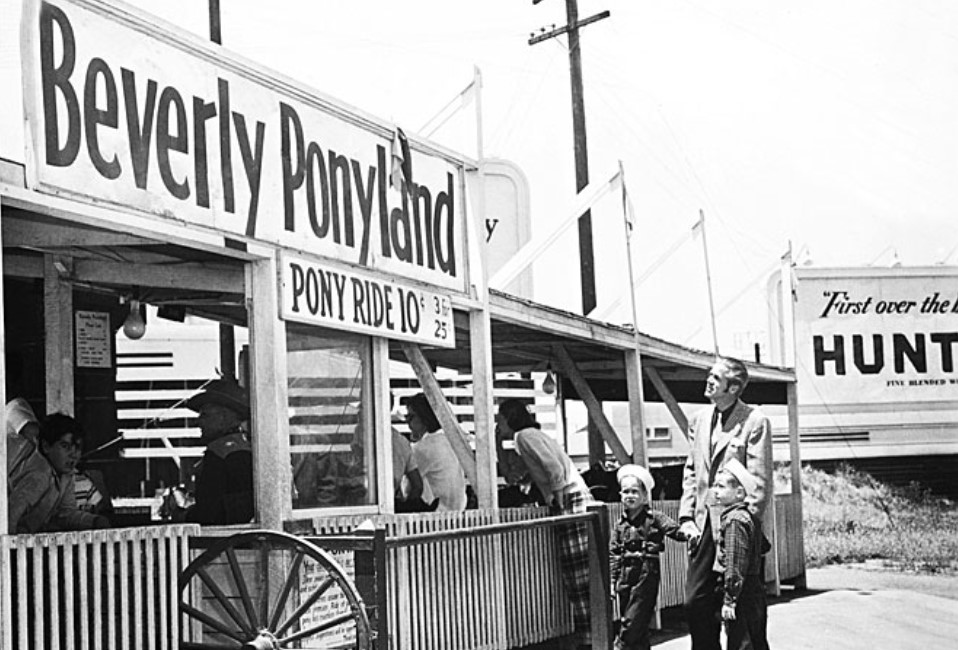 |
|
| (ca. 1947)#*#** - A man and two boys with sailor hats stand in front of the Pony Rides at Beverly Park Poneyland, adjacent to Kiddieland. |
Historical Notes Next door to Kiddieland, there was another mom and pop operation which offered a different kind of fantasy to youngsters. This was Ponyland, which opened at 8536 Beverly Blvd, around where the Hard Rock Café is today.^^^* |
Click HERE to see more in Early Southern California Amusement Parks |
Early Home Furnishings& Appliances
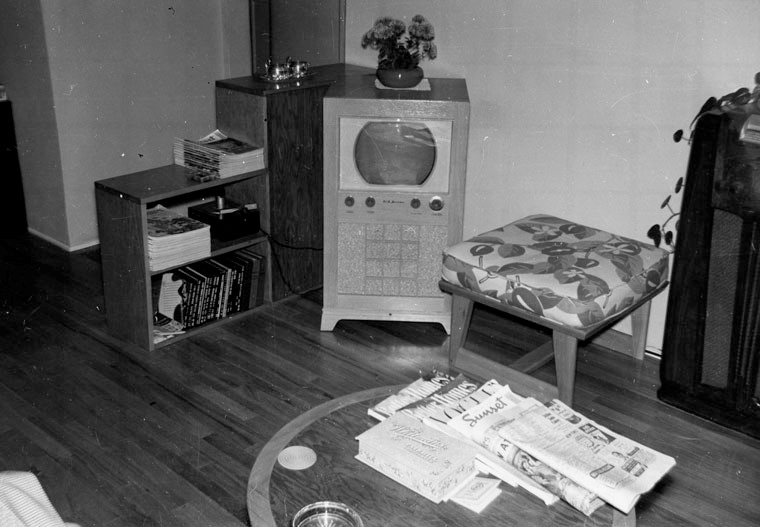 |
|
| (ca. 1947)^ - Interior view of a San Fernando Valley home, showing a television set in the living room corner. Better Homes, Vogue, and Sunset magazines, along with two newspapers, are neatly stacked on the coffee table next to a box of Whitman’s Chocolates. A phonograph player is seen at left sitting on the shelf of a bookcase. |
Historical Notes Television usage in the United States skyrocketed after World War II with the lifting of the manufacturing freeze, war-related technological advances, the gradual expansion of the television networks westward, the drop in television prices caused by mass production, increased leisure time, and additional disposable income. While only 0.5% of U.S. households had a television in 1946, 55.7% had one in 1954, and 90% by 1962. By the late 1960s and early 1970s, color television had come into wide use.*^ |
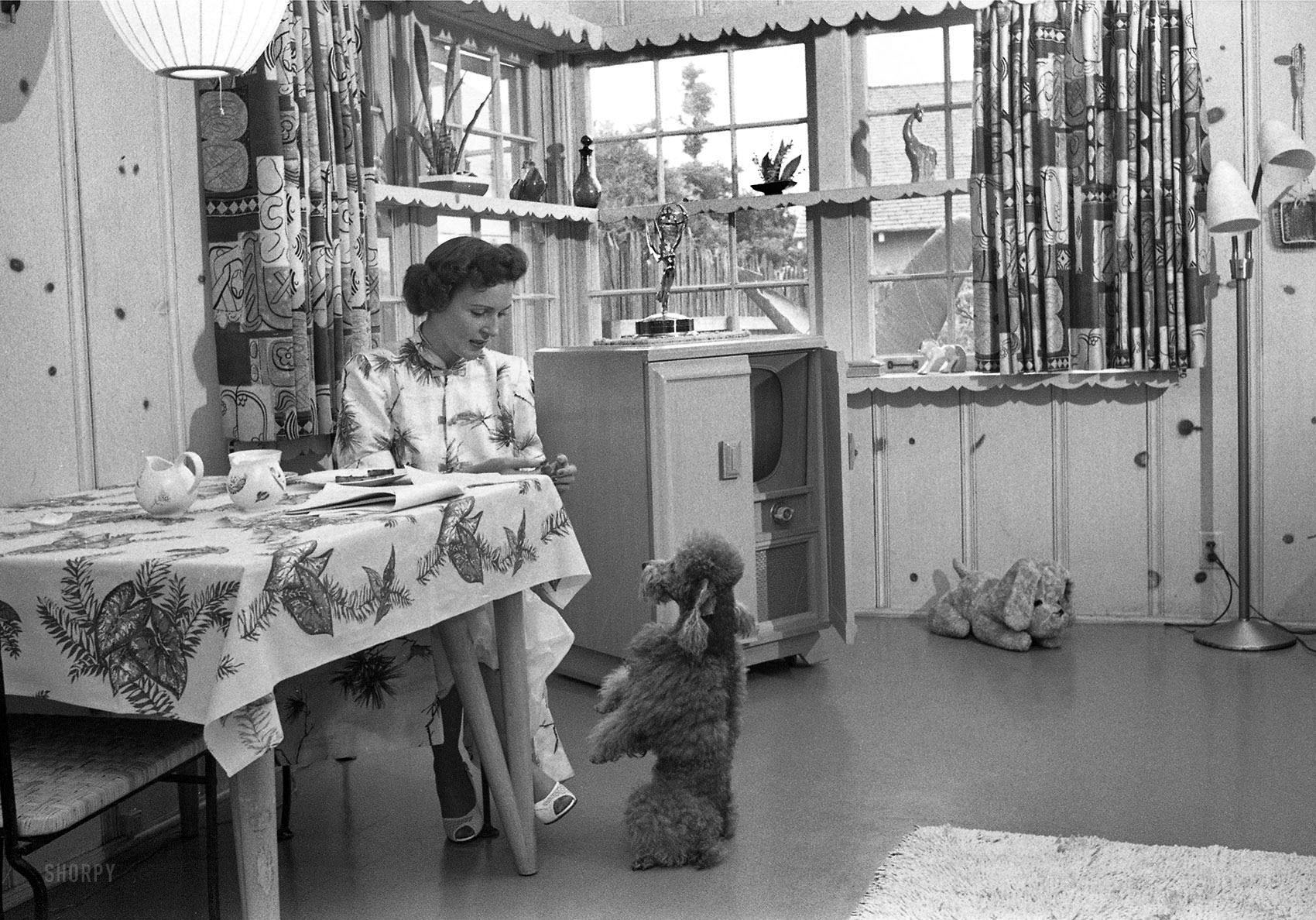 |
|
| (ca. 1952)^.^ - Actress Betty White at her Los Angeles home with her dog. Photos by Maurice Terrell and Earl Theisen for Look Magazine. Love those curtains... |
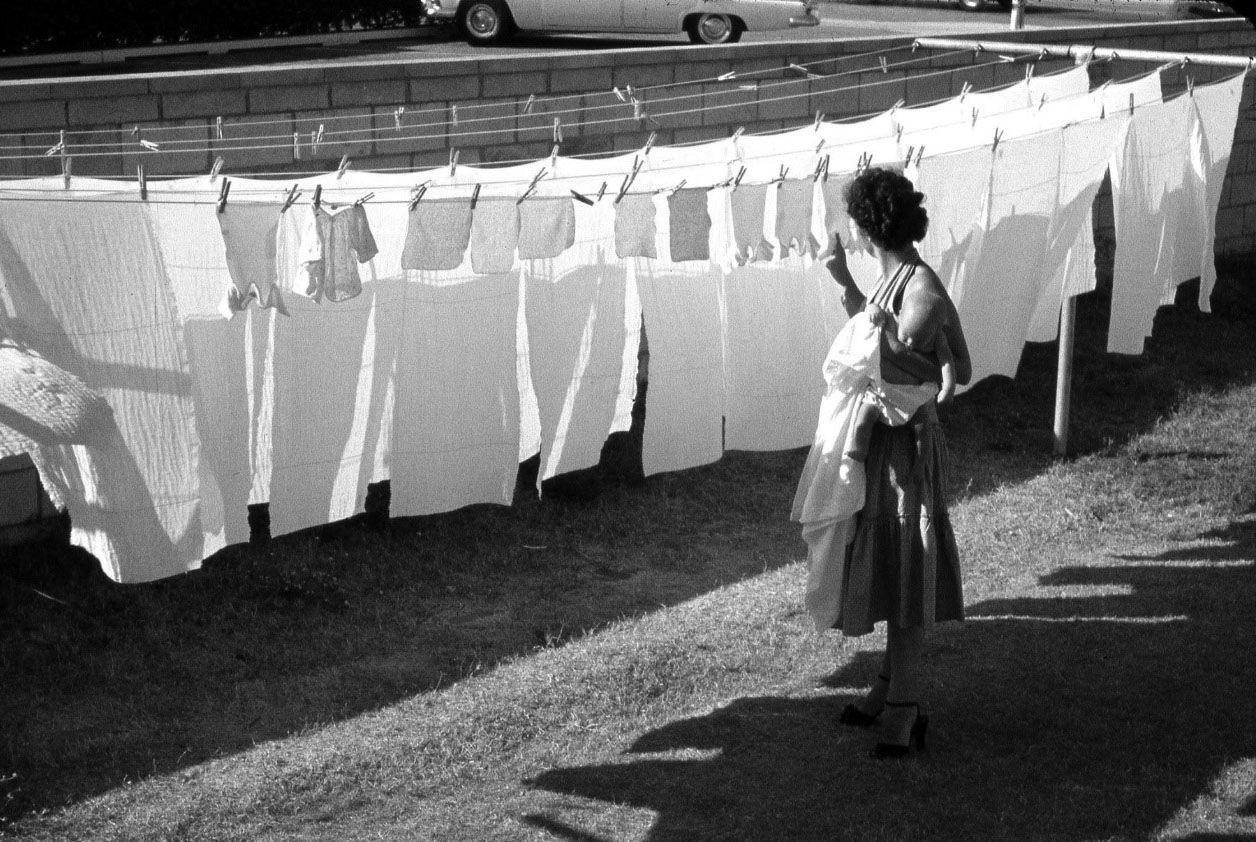 |
|
| (1956)^.^ - A woman hangs clothes on a clothesline while carrying a baby. Not often seen today. |
Historical Notes In 1955, only 10 percent of U.S. households had a clothes dryer, probably because they were expensive. Back then, the average price for a dryer was $230. Adjusted to today’s dollars, that lowly laundry appliance would have cost between $2,000 to $3,000.^ |
Hollywood
 |
|
| (1947)**^ - View looking west on Hollywod Boulevard at the intersection with Vine Street. The Melody Lane Cafe is on the northwest corner. |
Historical Notes In 1940, restaurateur Sidney Hoedemaker of the Pig 'n' Whistle - Melody Lane chain, leased the northwest corner of Hollywood and Vine and transformed it into a Melody Lane restaurant. He hired coffee shop modern architect Wayne McAllister and S. Charles Lee to do the design. #^** Click HERE for more history of the N/W Corner of Hollywood and Vine |
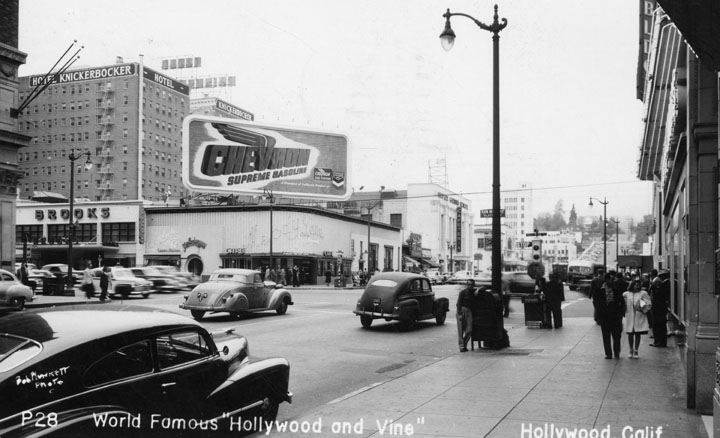 |
|
| (1949)^ - Postcard showing the intersection of Hollywood and Vine. The view is north on Vine Street. On the northwest corner is the Melody Lane Cafe and the rear of the Hotel Knickerbocker is also visible behind it. |
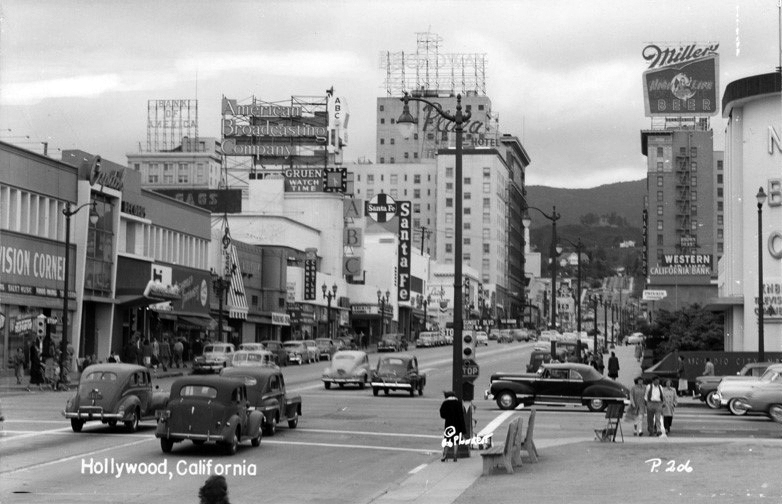 |
|
| (1940s)**^* - Postcard view looking north on Vine Street from Sunset Boulevard. A multitude of signs and signboards can be seen throughout. |
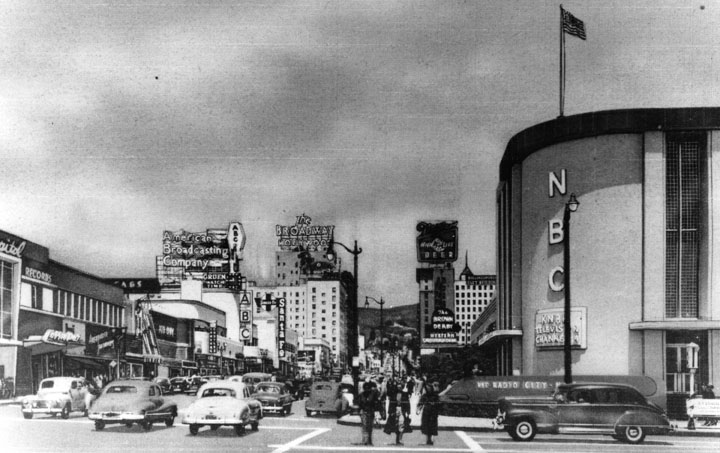 |
|
| (ca. 1949)^ - Looking north on Vine Street from Sunset Boulevard. Lots of automobile and pedestrian traffic. Signage on various buildings include American Broadcasting Company, Broadway-Hollywood, Brown Derby, and NBC Radio City. |
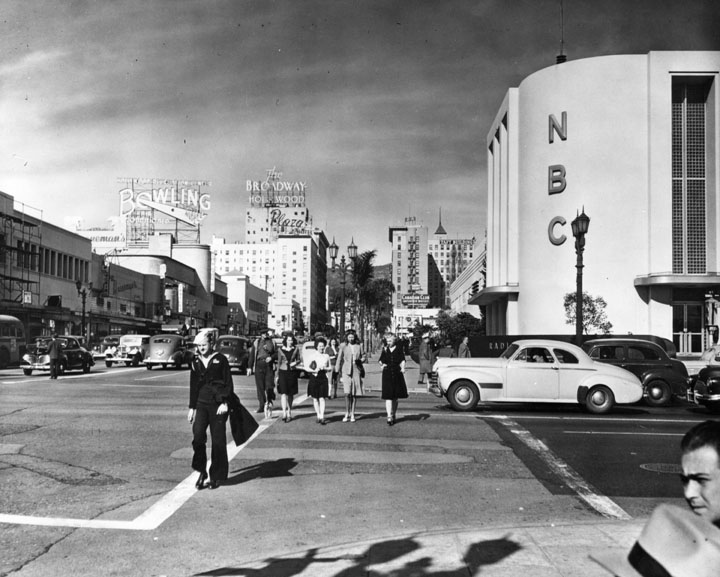 |
|
| (1940s)^ - View of the NBC studio complex located at the northeast corner of Sunset and Vine. The Broadway-Hollywood, Hollywood Plaza Hotel, and the Taft Building can be seen in the background. |
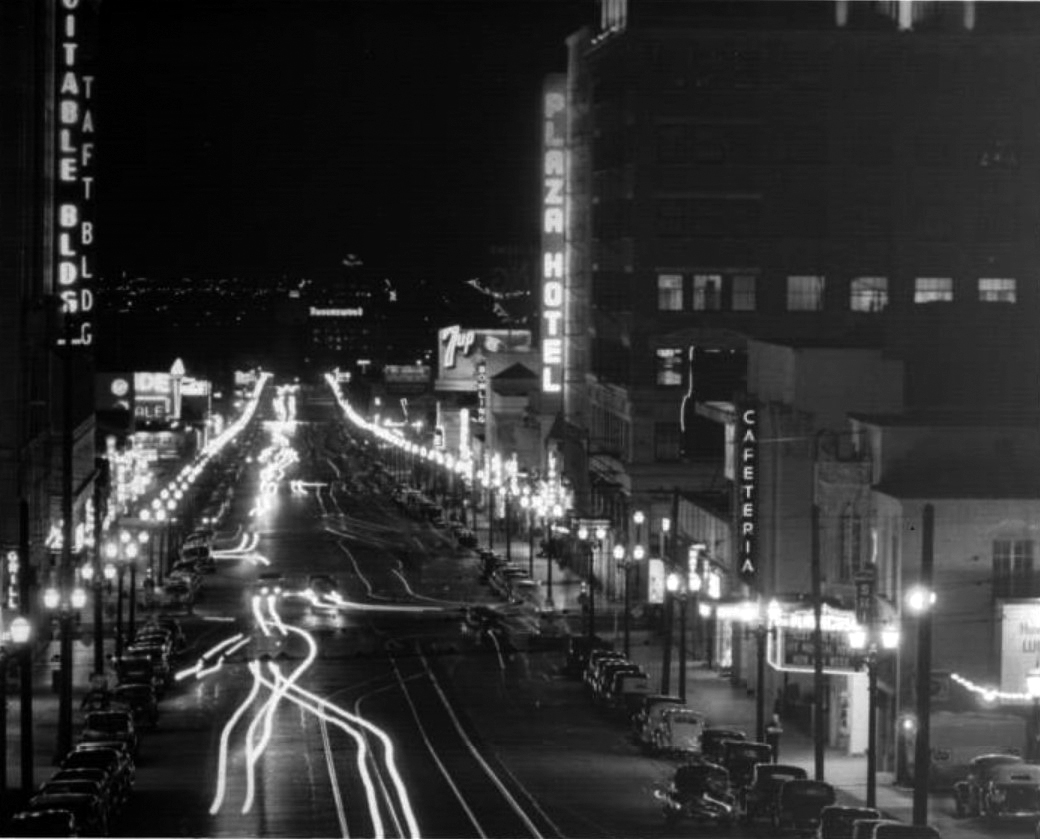 |
|
| (1942)*# - Hollywood night scene looking south on Vine Street past the Hollywood Plaza Hotel. Included are: Taft Building, Bowling, Equitable Building. Photo by Dick Whittington |
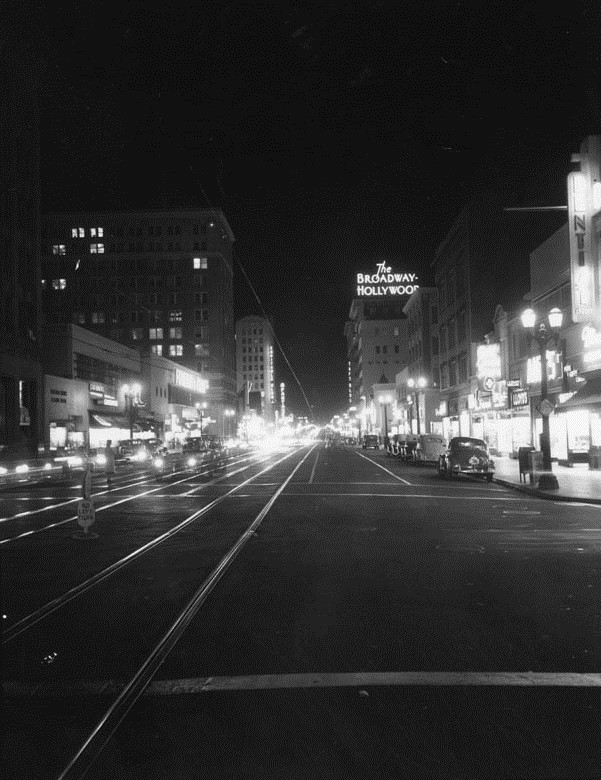 |
|
| (1940s)*^^ - Looking east down Hollywood Boulevard towards Vine Street and the Broadway-Hollywood Building. |
Click HERE to see more in Early Views of Hollywood (1920 +) |
* * * * * |
Drag Racing Under the 6th Street Bridge
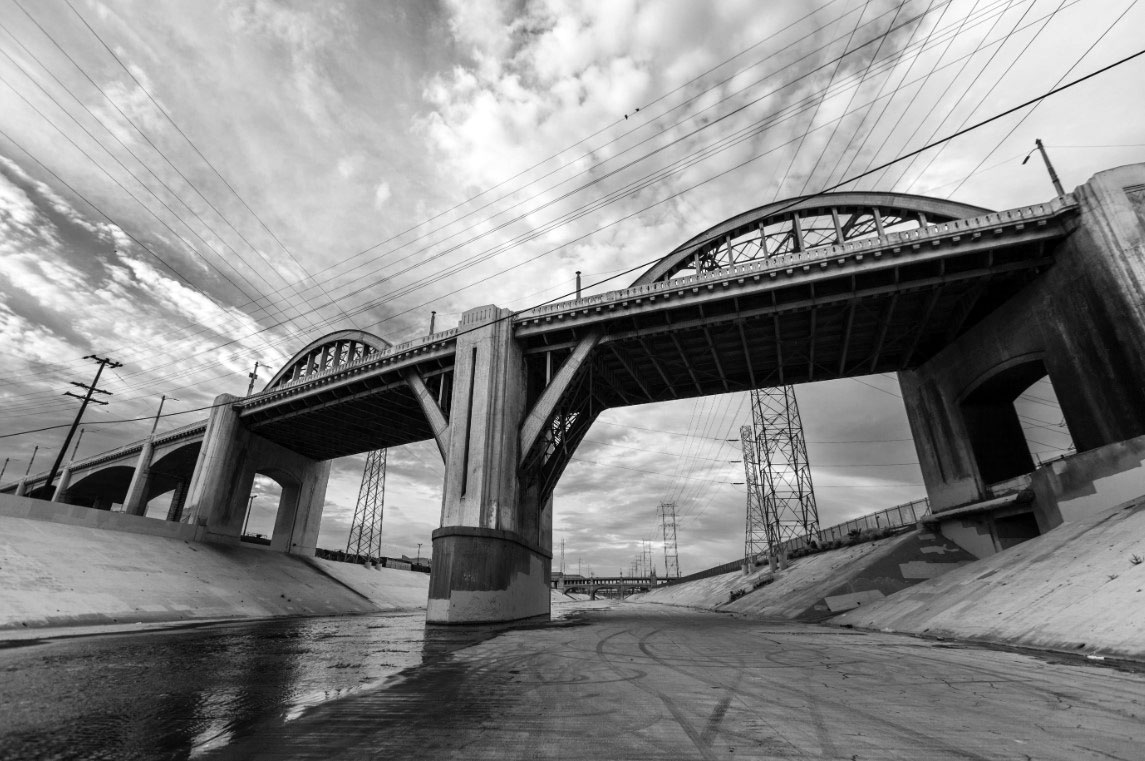 |
|
| (n.d.)* – Ground level view showing the Sixth Street Bridge over the Los Angeles River. The 1950s saw rebellious teens illegally drag racing at this very location. |
Historical Notes The L.A. River Bed system was still growing back in the 1950s. As it progressed, many sections started growing concrete making it an ideal spot for a semi-secluded meeting point with long straight-aways. Teenagers from all around met up and pitted their best hot rod against rivals and friends alike.^ |
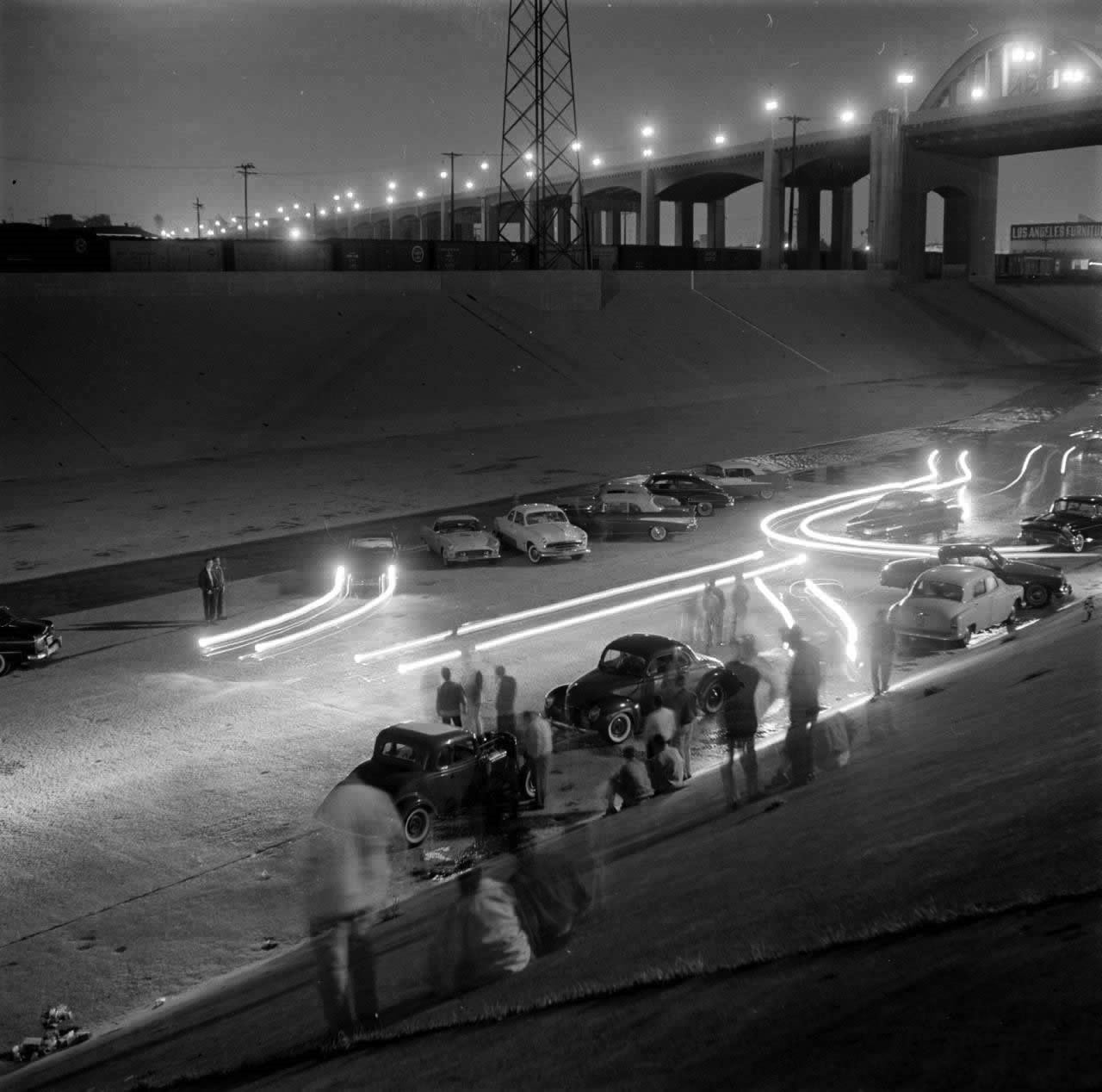 |
|
| (1957)^# – Drag racing under the Sixth Street Bridge. Long exposure shot by Allan Grant for Life Magazine. |
Historical Notes It was the mid-fifties and not unlike the streets today when it came to drag racing, the allure of going fast and getting away with it, you and your friends, was hard to resist. And, what could be better than night racing.* |
.jpg) |
|
| (1957)*^ - Drag racing start under the Sixth Street Bridge. Long exposure shot by Allan Grant for Life Magazine. |
Historical Notes The law was trying to crack down on drag racing any way they could. They were cruising along side the kids on the street trying to nab them, so the kids came up with the idea to take it off the streets down into the L.A. River Basin. It was called, "The River Road," a wide concrete channel with a trickle of water running down the middle during the summer. It was smoothed out from water running over it for years during the winter, long, wide, and straight, with banked sides, perfect to sit and watch the action below.* |
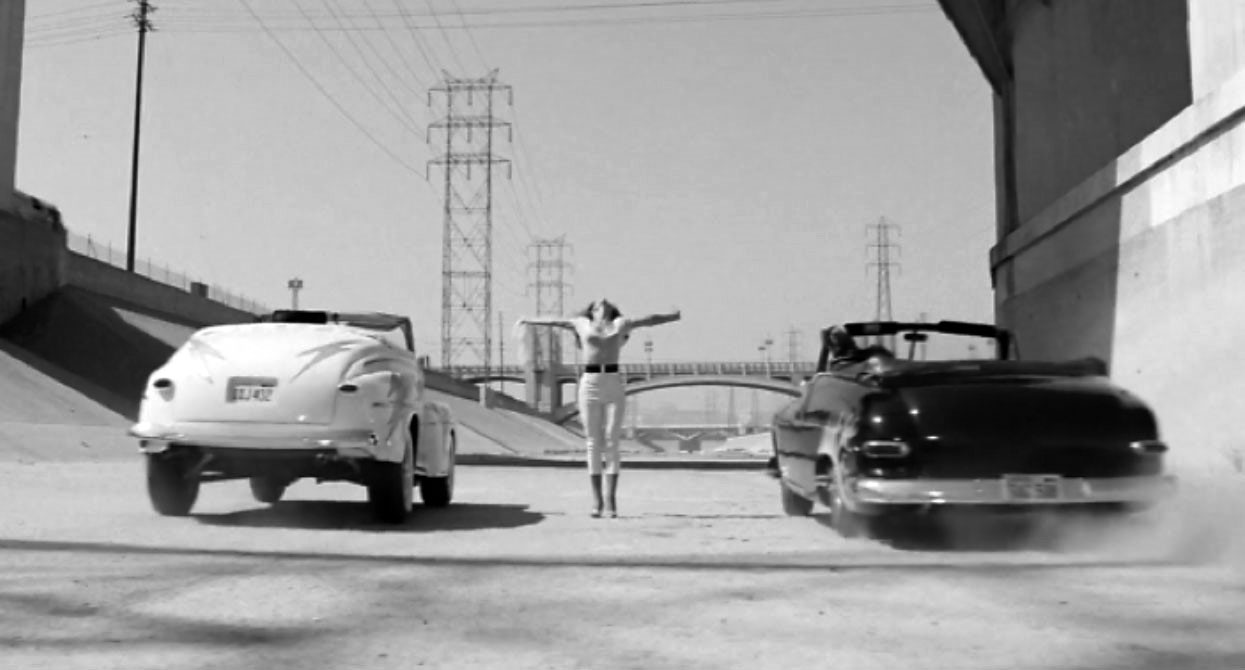 |
|
| (1977)** - Grease Lightning: John Travolta, as Danny Zuko, raced underneath the Sixth Street Viaduct. The most famous scene shot under the Sixth Street Bridge is probably the race in Grease, and that’s shot in 1977 but set in 1959. |
Historical Notes The Sixth Street Viaduct is instantly recognizable from the movie, as the legendary setting for Danny Zuko's race against a rival gang for his group of friends the T-Birds. The boys turn up at the scene in LA and Kenickie, who is the driver, bangs his head, forcing best friend Danny (John Travolta) to take the wheel. There is an action packed race with some dirty tricks, but Danny edges in front and finishes at the same place the race starts - underneath the viaduct. |
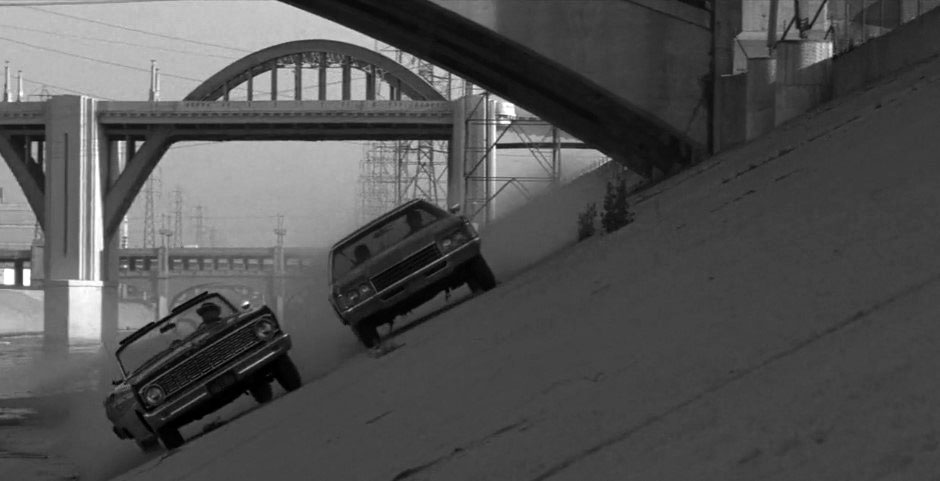 |
|
| (1984)^^ – The Sixth Street Bridge (viaduct) was featured in the race scene in Repo Man, the 1984 American comedy classic Repo Man, directed by Alex Cox and starring Harry Dean Stanton and Emilio Estevez. |
Historical Notes The Sixth Street Bridge has appeared in numerous films since it was built in 1932.
Despite its historical status, the bridge was closed for demolition and replacement in January 2016 due to concerns over seismic instability. Click HERE to see more Early Views of the Sixth Street Bridge. |
* * * * * |
Please Support Our CauseWater and Power Associates, Inc. is a non-profit, public service organization dedicated to preserving historical records and photos. Your generosity allows us to continue to disseminate knowledge of the rich and diverse multicultural history of the greater Los Angeles area; to serve as a resource of historical information; and to assist in the preservation of the city's historic records.
|
For more Historical Los Angeles Views click one of the following:
For Other Historical Views click one of the following:
See Our Newest Sections:
To see how Water and Electricity shaped the history of Los Angeles click one of the following:
Water:
Power:
* * * * * |
References and Credits
* DWP - LA Public Library Image Archive
^ LA Public Library Image Archive
*^Oviatt Library Digital Archives
#*MTA Transportation and Research Library Archives
#^California Historical Society Digital Archive
+#Facebook.com: Garden of Allah Novels
+++Photobucket
+^^The Eastsider: Riverside-Figueroa Bridge
+#+Pinterest - California and DailyBreeze.com; Mid Century Hollywood
#^^Picturetrail.com: KCET - Angels Flight
*^#Los Angeles Conservancy: LA Stock Exchange Building; Park La Brea; Warner Bros.Theatre; Downtown Jewelry Exchange/Warner Bros. Theatre
^#^Pacific Electric Railway Historical Society - Alan Weeks Collection
*#*Westland.net: Venice History
^#*Metro.net: Mulholland Drive Bridge
**#The California History Room, California State Library: William Reagh
^*#Library of Congress: Panoramic View of Civic Center; Macy Street Viaduct; 4th Street Bridge
^^#The George A. Eslinger Street Lighting Photo Gallery
*##LA Weekly - Warner Bros. Theatre; The Wiltern Theatre
^## Facebook.com: Photos of Time Travelers
+##MartinTurnbull.com: Fairfax and Wilshire
+#*LA Curbed
+**Los Angeles' Bunker Hill - Alta Visa Apartments
^^+How Stuff Works: Chevrolet Impala
++^Mentalfloss.com: 12 Postcard Locations Then and Now
++#Facebook.com: Photos of Los Angeles
#**Pinterest - California and DailyBreeze.com
#*^Theatlantic.com: AP Photo - George Patton
#^*This Moderne Life: Simon's Drive-In
##*Boston Public Library: Flickr.com
^^*Early Downtown Los Angeles - Cory Stargel, Sarah Stargel
^^^Los Angeles Orthopaedic Hospital
***Los Angeles Historic - Cultural Monuments Listing
*^*California Historical Landmarks Listing (Los Angeles)
*#^Forum.Skyscraperpage.com: Arroyo Seco Library; Westwood-Life Magazine; Japanese Internment; 8th and Francisisco; Bob's Airmail Service Station; 1932 Downtown Aerial; North Los Angeles Street; May Co. Building; Cahunega and Highland Intersection ca1937
*#^^LAPL-El Pueblo de Los Angeles Historical Monument Photo Archive
**** Pinterest.com: Los Angeles Dodgers; Vintage Los Angeles: Aerial Westwood - Rancho Park; Los Angeles and Hollywood; MacArthur Park w/Downtown Skyline; Gilmore Self-Service Gas Station; Sawtelle and National; Bullock's Delivery Truck
^^^^Depaul.edu: Night Train 55
**^^Aerofiles - US Aviation Firsts
**#^Vincent Thomas Bridge - Facts and Figures
*^*^Big Orange Landmarks: Los Angeles City Hall
***^Pomona Public Library Digital Archive: Bob's Airmail Service Station
^*^*HollywoodHeritage.com: The Muller Family Foundation
*^^*Pinterest.com: Bertrand Lacheze
^^**Pinterest.com: Vintage California
^^*^Restaurantwarecollectors.com: Angelus Hotel
*##*Pinterest.com: Trucks, Pick-Ups, and Gas Stations
***#I Love Los Angeles But...: Sontag Drug Store
*#*#Abandoned & Little-Known Airfields – Paul Freeman
#*#*Fairfax High School Home Page
#*^*GenDisaster.com: Long-Beach Double Pier Collapse
^***UCLA Library Digital Archive
*^^^Art Deco in Mono
*^^Nuestra Señora la Reina de los Ángeles: losangelespast.com
*^^#Los Angeles Past: Temple and Main Streets, Los Angeles - Then and Now
**^*California State Library Image Archive
*^#*Westcoastfireescapes.com: Fire Escape History
^*#*History of Los Angeles Group
^*^#Facebook.com - Bizarre Los Angeles
^*#^Studiotour.com
*^#^Huntington Digital Library Archive
^#^*Noirish Los Angeles - forum.skyscraperpage.com; Broadway Tunnel
**^#Vintage Los Angeles: Facebook.com; Wilshire Blvd - Westlake Theater; Intersection of Main, Spring, and 9th Street; Gilmore Stadium and Field; Town House; Cruising Hollywood Blvd; Attractions and Amusement Parks
^#^#S.S. Avalon and S.S. Catalina
^^*#Historical LA Theatres: Loew's State Theatre; Warner Bros.Theatre; Lyceum Theatre; Broadway Downtown Theatres; College Theatre; Liberty Theatre
^##^Online Archive of California (OAC): Bullock's Department Store Building
*^*#The Los Angeles River: Historic Bridges
^^##Pacific Electric Railway Historical Society
^^#*LA Observed: Dedication of theSepulveda Tunnel; Decommissioned Street Cars; Bunker HIll, 1964
**##Blogdownton: State Building
*^##OAC - Online Archive of California
^*##Flickr- Old Los Angeles Postcards: LA Coliseum
*#^#Life.time.com: Stoked-Life Goes Surfing
^##*Pinterest: Bygone Los Angeles
^#**Facebook.com - City of Angels Brown Derby; Cyclone Racer; Los Feliz Bridge
*###Consolidated Steel, Long Beach and Wilmington
*#*^Historic Hotels of Los Angeles and Hollywood (USC - California Historic Society); U.S. Hotel
*#**Flickr-Los Angeles in Good Light - Ron Reiring
^###The Historical Marker Database: Stephen M. White Statue
*##^LAist.com: The Knott's Berry Farm You May Not Know; Harbor Freeway, 1969; Century Plaza Hotel
^#*#LA Magazine: When Knott’s Berry Farm Was Actually a Farm; Beverly Park Ponyland
**#*Santa Monica via Beverly Hills Line - uncanny.net
#**#California State University Northridge History: csun.edu
#^^#The Museum of the San Fernando Valley: Northridge Train Depot
#^*#Flickr.com: Paul Bajerczak
#^#^Los Angeles: Portrait of a City
#^#*San Diego Air & Space Museum Archive
#*#^Facebook.com - Los Angeles Theatres: Warner Bros. Downtown
##**Franklin HIlls Residents Association
##++Facebook.com - Beverly Hills Heritage
##^*Calisphere: University of California Image Archive
##^^Cinema Treasures: Warner Bros.Theatre; Olympic Drive-In
##*^Fourth Street Bridge Over Lorena Street
##*^Port of Los Angeles: portoflosangeles.corg
##^#Facebook.com: Classic Hollywood-Los Angeles-SFV
###^Flickr.com: Metro Library and Archive
#^^*Blogdowntown.com: Gas Holders; Third Street Tunnel
#^**Water and Power Associates
#^*^Los Angeles River Railroads: Taylor Yard
#*^^Parks.ca.gov: Rio de Los Angeles State Park
^#^^Flickr.com: Michael Ryerson
****^Facebook.com: West San Fernando Valley Then And Now
*^*^*Wehadfacesthen.tumblr.com
*^^^^Los Angeles Maritime Museum
**^^^Facebook.com - San Pedro's Original Website, San Pedro.com
^^^**tumblr.com: John Ferraro Office Building; DWP Office Building
**^**Los Angeles City Historical Society
**#**LMU Digital Archive
#*#**Facebook.com: Beverly Park - L.A.'s Kiddieland
^*^**LAistory: The Pan-Pacific Auditorium
^*^*^Alumni.ucla.edu: UCLA History - A Bridge to the Future
^^***Facebook.com: L.A. as Subject
^^^^#A History of the Los Angeles City Market
^^^*KCET.org: Three Forgotten Incline Railways; Welcome to L.A. River; How Oil Wells Once Dominated Southern California's Landscape; Four Level Interchange; Rainbow Pier; Construction of 5 Southern California Freeways; History of Baseball Stadiums; Beverly Park and Ponyland: 6th Street Bridge; Edendale Red Car Line; Lost Tunnels of Downtown LA; Before the 'Carmageddon': A Photographic Look at the Construction of 5 SoCal Freeways; Seventh and Broadway; L.A.'s First Freeways
^^ LA Times: Photo Archive; An Oil Well on La Cienega; Mulholland Bridge; A Mountain of Red Cars; Spruce Goose; New Viaduct for Red Car Line; Demolition of Old Times Bldg; Flooding 1938; Huntington Beach Oil Derricks; Sepulveda Tunnel; Sunkist Bldg.; The Vincent Thomas Bridge; Hill Street Tunnels; Harbor-Santa Monica Freeway Interchange
**^ Noirish Los Angeles - forum.skyscraperpage.com; Westwood-Life Magazine; Selling Papers on Olive; Little Tokyo; La Cienega Oil Well; Hall of Justice; Bob's Airmail Service Station; California Federal Plaza Building; LA Fun Map; Downtown Aerial 1958; 1949 Construction of 101 Freeway; 1953 Harbor Freeway Construction; Wilshire Blvd, 1949; Muller Bros. Service Station; Pan-Pacific Auditorium; Gilmore Aerial; Zephyr Room and Brown Derby Postcard View; Shakespeare Bridge; Prospect Studios; Aliso Before and After 101 Frwy; Gilmore Tanker Truck; Gilmore Station; North Figueroa Tunnels; Vincent Thomas Bridge; Hollywood Frwy Traffic Jam; 2012 Downtown Skyline; View from GOB; LA Times Building; Fairfax Ave 1937; Bonaventure Hotel Aerial; Fairfax and Wilshire 1939; CBS Television City
^* Wikipedia: Hollywood Sign; Carthay Circle; Carthay Circle Theatre; Fairfax High School; Park La Brea; San Vicente Boulevard; Etymologies of place names in Los Angeles; Los Angeles Central Library; Broadway Tunnel; Pershing Square; Pacific Electric Railway; Gilmore Field; GilmoreStadium; Union Station; Westwood; 6th Street Viaduct Bridge; Figueroa Street Tunnels; Chavez Ravine; 2nd Street Tunnel; Hollywood Freeway; Los Angeles International Airport; Los Angeles City Hall; Wilshire Boulevard Temple; Egyptian Theatre; The Pig 'N Whistle; Sunland-Tujunga; Van de Kamp Bakery Building; Los Angeles County Art Museum; Los Angeles City Oil Field; Los Angeles Railway; Warner Bros. Downtown Theatre; Miracle Mile; Glendale-Hyperion Bridge; Zeppelin; Los Angeles City Hall; Los Angeles Biltmore Hotel; Farmers Market; Interstate 405; Lafayette Park; US Courthouse - Los Angeles; Los Angeles County General Hospital; Long Beach; Chevrolet Impala; Cord Automobile; Playa Vista; Signal Hill; University of Southern California; Harbor Frwy (Interstate 110); See's Candies; Hughes H-4 Hercules; Howard Hughes; History of Los Angeles Population Growth; Jonathan Temple; Olvera St.; Bullocks Wilshire; Los Angeles City Hall Lindbergh Beacon; Bullock's; Broadway Theater District: Lowe's State Theater; Obadiah J. Barker; May Company California; Dominguez-Wilshire Building; Little Tokyo; Ellison Shoji Onizuka; Japanese American Internment; Sepulveda House; Four Level Interchange; Los Angeles Plaza Historic District; Knott's Berry Farm; Hall of Justice; California Federal Bank; Century City; Harbor Freeway; Brown Derby; Bank of Italy; Silverwoods; Woodland Hills; Northridge; KFWB; Rose Bowl Stadium; Westwood; Westwood Village; UCLA; Maddux Air Lines; Olympic Boulevard; World War II; Thomas Fairfax; First National; Arroyo Seco Parkway; Zeppelin; Charles Lindbergh; Spirit of St. Louis; Hollywood Presbyterian Medical Center; Hollywood; Sheraton Town House; 2004 Los Angeles Skyline; LA's Oldest Palm Trees; Shakespeare Bridge; Franklin HIlls; John Marshall High School; Prospect Studios; Rio de Los Angeles State Park; History of Los Angeles; 1926 World Series; San Vicente Boulevard; Vincent Thomas Bridge; World Cruise Center; CSUN; Westwood; Westwood Village; UCLA; History of UCLA; Precious Blood Catholic Church; 1950s Americal Automotove Culture; Pershing Square; Salt Lake Oil Field; Century Plaza Hotel; Elysian Valley; Universal Studios; Huntington Park; Broadway Tunnel; Patriotic Hall; California Incline
< Back
Menu
- Home
- Mission
- Museum
- Major Efforts
- Recent Newsletters
- Historical Op Ed Pieces
- Board Officers and Directors
- Mulholland/McCarthy Service Awards
- Positions on Owens Valley and the City of Los Angeles Issues
- Legislative Positions on
Water Issues
- Legislative Positions on
Energy Issues
- Membership
- Contact Us
- Search Index